

The Perfect Bulgaria Itinerary: 5 to 10 Days (or More!)
Last Updated on February 14, 2024
by Maggie Turansky
Disclaimer: This article contains affiliate links. That means if you click a link and make a purchase, we may make a small commission. As an Amazon Associate we earn from qualifying purchases. For more information, see our privacy policy.
The Balkan country of Bulgaria has long been overlooked on standard European travel routes, where traditional tourists rarely travel farther east than Hungary or Croatia. However, for those more intrepid visitors keen to see the delights that southeastern Europe has to offer, planning a 5 to 10 days in Bulgaria itinerary is a fantastic idea.
Though relatively small in size, Bulgaria has a lot to offer visitors and really can appeal to almost every personality. Bulgaria boasts cosmopolitan cities and ancient metropolises, rugged mountains and pristine beaches, world-class skiing and incredible wine country — it can seem that wherever your interests may lie, Bulgaria will have it.
Table of Contents
When to Visit Bulgaria
You are likely going to want to know when is the best time of year to visit this European nation. Well, luckily for travellers, Bulgaria has its merits no matter what time of year you choose to visit so it all depends on what you’re after on your trip.
While it is located in southeastern Europe, don’t expect Bulgaria to have the same kind of climate as other southern European countries like Croatia , Portugal, Italy or Spain. Contrary to these countries, Bulgaria experiences a much more continental climate with very cold and snowy winters and hot, muggy summers. With this kind of climate, you can best bet to enjoy all of the seasonal activities that come throughout the year.
Winter in Bulgaria sees high temperatures averaging around freezing throughout most of the country, though it can certainly be colder high in the mountains or warmer in the coastal areas along the Black Sea.
With the winter freezes come a lot of skiing opportunities at some of the most affordable prices in all of Europe. Destinations like Bansko are incredibly popular in the wintertime, however, you can also easily combine a skiing holiday with a cosmopolitan city break without leaving Sofia by visiting Vitosha Mountain.
Summers, on the other hand, can get incredibly hot, with average temperatures soaring to well over 30°C (86°F) and humidity can be quite high, as well. The inland cities in the summer can be sweltering, however, the coast becomes a bustling mecca for sun worshippers and party seekers alike.
The mountains can also be a pleasant escape with ample hiking opportunities and mild temperatures in the high altitude. Summer is also, not surprisingly, when tourist crowds are at their peak, as are accommodation prices.
If you’re sensitive to either the cold or heat and want to avoid tourists as much as possible, then probably the best time to visit Bulgaria would be in the shoulder seasons.
The months ranging from March-May and September-October see some of the mildest temperatures, though you should be prepared for the occasional cold snap or frequent rains (especially in Spring). However, in the shoulder seasons, you are just as likely to have beautiful warm temperatures and sunny skies that steadfastly cling to summer.
No matter which time of year you choose to embark on your trip to Bulgaria, you are sure to be met with a beautiful country eager to welcome your exploration!

Getting To & Around Bulgaria
Now that you’ve figured out which season to travel to Bulgaria, we need to discuss how you plan to get around once you’re there.
First things first, it is likely that you will begin your Bulgaria itinerary by flying into Sofia airport, which has frequent connections from budget airlines like Ryanair and Wizzair to a number of cities throughout Europe. The affordability of reaching Bulgaria has made it an attractive option for travellers looking to explore a lesser-visited corner of Europe.
There are other international airports in the country besides Sofia, however, and you can just as easily begin your trip from any of these. The highest-trafficked airports after the capital include Burgas and Varna on the Black Sea and Plovdiv airport, which serves a couple of flights per week from destinations like Tel Aviv, Belfast, Manchester and Dublin.

If you’re visiting Bulgaria as part of a longer Balkans itinerary you will be happy to know that a few of the country’s major cities are fairly well connected with neighbouring countries. Travellers can easily reach Sofia from Thessaloniki in Greece, Belgrade or Nis, Serbia and also from Skopje , North Macedonia and Istanbul , Turkey, the latter of which will transit through Plovdiv.
You can also reach Sofia by overnight bus or train from Bucharest , Romania. It is also possible to find a direct connection to the northern city of Veliko Tarnovo to Bucharest as well.
Once you’ve arrived in Bulgaria, you need to know how you plan to get from point A to point B. Like elsewhere in the Balkans, if you’re relying on public transport for your Bulgaria trip, then your best option is going to be the bus.
While there is a train network in Bulgaria, it largely hasn’t been updated since the 1960s and can be incredibly slow, uncomfortable, and inefficient. The only time I would generally recommend using the train network in Bulgaria is if you have an affinity for communist-era railways.
In contrast, the bus system is quite comfortable and well-developed and they also tend to be much faster than the trains.
If you are only travelling between major cities, you will find that connections between transport hubs tend to be frequent and the system is easy enough to navigate, even if you have a language barrier. It can be helpful to know what the city you’re travelling to looks like spelt in the Cyrillic alphabet so you know which booth to buy your tickets from.
Most smaller city centres are easily navigable by foot, including cities like Plovdiv and Veliko Tarnovo, however, in Sofia, it might be necessary to use the public transportation system. The metro in Sofia is efficient and user-friendly, with everything written in both Bulgarian and English.
If you need to take a taxi in Bulgaria, make sure to practice the general precautions you would with taxis throughout the world as, unfortunately, Bulgaria is not immune to taxi scams. However, there are a number of taxi apps in various cities where you can call a reliable cab.
If you do hail one off the street, make sure to do some research on reliable taxi companies beforehand and ensure that the meter is running. Taxi rides are incredibly affordable in Bulgaria, especially when compared to some Western European countries.

5 to 10-Day Bulgaria Itinerary
Bulgaria has a lot to offer visitors and, therefore, travellers can easily spend a number of weeks or even months within the country and always find something new to explore. However, if you only can spend 5 days in Bulgaria, then the first five days of this itinerary is outlined to be a complete trip.
If you have a week, the same concept applies if you have 7 days in Bulgaria. And if you’re fortunate enough to have 10 full days to spend in this Balkan nation, then you can enjoy the entirety of the outlined route.
Days 1-3: Sofia
It is likely that you will begin your Bulgaria itinerary in the capital city of Sofia. Though Sofia may not have to best reputation among Balkan cities (when we first planned to visit, we were told to skip it by numerous people), we’ve found that it has a lot to offer visitors with great energy and many interesting things to do.
Though you could easily spend a week or more exploring Sofia , we recommend spending 3 of those days in the capital. Start off with a free walking tour of the city to get your bearings, a great way to get some context to the incredible history you’re going to see in the Bulgarian capital.
There are a number of things to occupy yourself during these three days in Sofia including visiting the top monuments like the ancient city of Serdika and the Alexander Nevsky Cathedral.
You can also take the time to visit some of Sofia’s many museums, enjoy its thriving culinary scene, and learn more about its communist history.
Though it may not be the most beautiful of cities, there is a very cool edge that Sofia holds and it can be worth also learning about its burgeoning street art scene.
If you only have three days, we do recommend that you spend all of them in Sofia as it will allow you to really get to know the city. However, if you want to see more of the countryside, it is possible to go on a day trip.
Rila Monastery – a UNESCO World Heritage Site – is one of the most popular day trips from Sofia, as is the nearby Vitosha Mountain, which you can reach by Sofia’s own public transport.
Where to Stay in Sofia
Art ‘Otel – This hotel is a great option if you’re after some luxury. They are well located within easy reach of all the major city sights and have a range of clean and comfortable rooms available. They also have a great breakfast included in the room rate.
Hostel Mostel – This hostel is your best bet if you’re travelling solo or on a tight budget. As one of the most popular and well-rated hostels in Sofia, they have a range of dorm and private rooms available, a friendly staff, and great common areas for you to meet other travellers.
Not quite what you’re looking for? Click here to browse more Sofia hotels!

Days 4-5: Plovdiv
After exploring Sofia, the final step on a 5-day Bulgaria itinerary should be the second-largest city of Plovdiv. As one of the European Capitals of Culture in 2019, Plovdiv is probably the most tourist-friendly city in Bulgaria and it has a lot to offer visitors.
Plovdiv is thought to be the oldest continuously inhabited city in Europe, with a history dating back over 6,000 years. Though Plovdiv is most famous for its incredible ancient amphitheatre. there is a lot more that the city has to offer, which is why we recommend spending two days in Plovdiv to really get to know the city.
Spend your first day in the city exploring its ancient monuments and Roman ruins like the aforementioned amphitheatre and the ancient stadium. Wander through the picturesque old town and enjoy the view of the city from the ruined fortress on Nebet Tepe.

You can also head into the trendy neighbourhood known as Kapana, which means “The Trap” in Bulgarian.
These windy, pedestrian streets have recently been refurbished by a lot of government investment and are now full of great restaurants, cafes, bars, and independent shops and have become a haven for local artists. If you’re interested in hipster culture or street art, this is the neighbourhood to visit.
You can also use Plovdiv as a base to go wine tasting in the Thracian Valley. The nearby town of Brestovitsa is home to several wineries and is only 20 kilometres from the centre of Plovdiv.
Though Bulgaria may not be the first country that comes to mind when it comes to wine tourism, it has one of the oldest viticultures in the world and produces some truly fine vintages.
Where to Stay in Plovdiv
Hotel Evmolpia – Situated in the Old Town, this charming boutique hotel is within easy walking distance of everything to see and do in Plovdiv, including the amphitheatre, Kapana district, and main pedestrian street. They have a number of clean and comfortable rooms available and a good breakfast.
Hostel Old Plovdiv – Located in the heart of the Old Town, this hostel is located in a traditional revival house and is one of the best places to stay in Plovdiv. They have a very welcoming a helpful staff, a range of comfortable dorm and private rooms available, and a great breakfast included in the room rate.
Not quite what you’re looking for? Click here to browse more Plovdiv hotels!

Days 6-7: Black Sea Coast
After spending the first five days in Sofia and Plovdiv, it’s time to head to the coast and enjoy the gorgeous Black Sea.
There are a number of great places to visit on the long coastline of Bulgaria and it really depends on what kind of experience you’re after. If you want a smaller, more sleepy seaside town, then head to lovely Sozopol. This town boasts a couple of fine sand beaches, beautiful cobbled streets, and a laid-back atmosphere.
If you want some more western amenities, a party scene, or a high-end beach resort, the head to Sunny Beach or Nessebar which are significantly more touristy and developed than Sozopol.
If you want a big city vibe but still some great beach time, then head to Varna or Burgas, the biggest cities on Bulgaria’s coast. No matter where you choose, you are sure to enjoy a couple of days enjoying the charms of the Black Sea.
Where to Stay on the Black Sea
Hotel Diamanti – If you’re looking for a more subdued seaside holiday on the Black Sea, then the perfect place to stay in Sozopol would be this hotel. They have a number of affordable rooms available, some with sea views, a restaurant on site, and a great breakfast included in the nightly rate. They are also located within walking distance of everything in Sozopol.
Nomado Hostel – As one of Varna’s highest-rated hostels, this is a great place to visit if you’re looking to see the Black Sea on a backpacker’s budget or as a solo traveller. They are centrally located, have a friendly and helpful staff, an included breakfast, and both dorm and private rooms available.
Not quite what you’re looking for? Click here to browse more Black Sea hotels!

Days 8-10: Veliko Tarnovo
If you’re fortunate enough to have 10 days to spend exploring Bulgaria, then heading to Veliko Tarnovo for the last two days is an excellent ending point.
Veliko Tarnovo, located to the north of Bulgaria, is a lively university town that once acted as the capital of Bulgaria. Today, it is famous for its mountain scenery and impressive fortress that commands spectacular views over the city and mountains surrounding.
Veliko Tarnovo is incredibly picturesque and well worth taking a day or two to explore on foot. It is also located very close to a number of great mountains, so it is possible to use the city as a base to go for a great day hike. As the former capital of Bulgaria and another ancient city, there is also a long and fascinating history here that is worth learning about.
As the home of one of Bulgaria’s best universities, there is also a lively, youthful energy which makes for a lot of good eateries, bars, and cafes along with some trendy shops and things to do.
Where To Stay in Veliko Tarnovo
Augusta Spa Hotel – This boutique hotel is centrally located and is a great option if you have a bit of a higher budget when visiting Veliko Tarnovo. They have a range of clean, comfortable, and air-conditioned rooms available, some commanding great views of the medieval fortress, and a great breakfast included in the nightly rate.
Hostel Mostel – This hostel, owned by the same people who run the branch in Sofia, is an excellent option for budget and solo travellers. They have both dorm and private rooms available, breakfast and dinner included, and great common areas to meet other travellers.
Not quite what you’re looking for? Click here to browse more Veliko Tarnovo hotels

Have More Time?
If you have more than ten days to spend in Bulgaria, or fancy getting a bit further off the beaten path, there are a few options you could take.
First, if you like nature, small towns, and wine, then heading to the lovely town of Melnik is a fantastic option. This tiny town is relatively easy to reach by public transport from Sofia and is an excellent stopping off point if you’re heading south to Greece after travelling in Bulgaria.
If you want to experience some of the best and most affordable skiing in Europe in the winter or visit a pristine hiking mecca in the summer, then the town of Bansko is also a great option to add to you Bulgaria itinerary.
Finally, the northwestern town of Belogradchik close to the Serbian border is a great offbeat destination in Bulgaria. Famous for its unique rock formations and imposing fortress, spending a day or two here will show you a different side to the country.
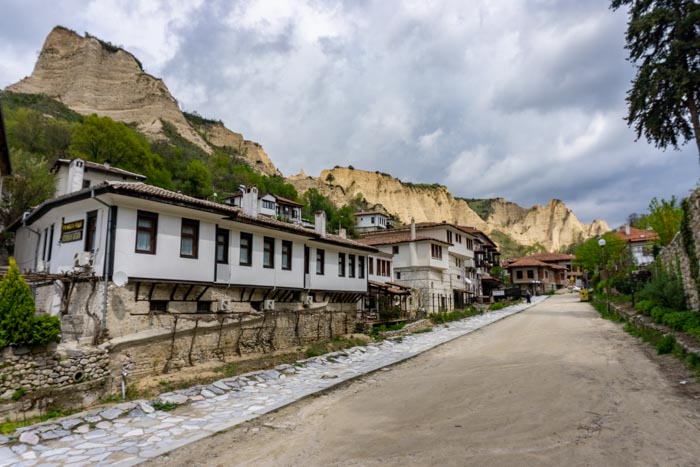
No matter how many days you have to devote to a Bulgaria travel itinerary, there is no denying that there are countless things to see and do in this underrated European nation.
Are you planning to visit Bulgaria? Have any questions? Let us know in the comments!

Related Posts:

12 Things to Do in Veliko Tarnovo: A One-Day Itinerary

The Perfect 1, 2, or 3 Days in Sofia Itinerary

What To Do in Plovdiv: A 1 or 2 Day Itinerary

About Maggie Turansky
Maggie is a co-founder and writer for The World Was Here First. Originally from the US, she has lived in five different countries and has travelled to dozens more, both solo and with her partner, Michael. She particularly loves exploring Spain and spending time in the Caucasus and the Baltics. Read more about Maggie
great itinerary, lots of useful tips too. many thanks. marilyn
Thanks, Marilyn! Hope you have a great trip.
Hi. This looks like a very useful itinerary. Plan to visit next early June after an extended Turkey, Azerbaijan, Armenia trip. Was planning 5 days but I think 10+ will afford a much better flavor of Bulgaria. Thanks!
Hello, What is the best way to travel from Plovdiv to Varna? Bus? Return to Sofia and take a flight to Varna?
Best regards, Oliveira
You can take a bus directly from Plovdiv to Varna 🙂
How affordable and practical would it be to rent a car for places outside Sofia? Or is bus a better option than driving?
Renting a car can be a great option if you want a lot of flexibility and not to be beholden to bus timetables. Prices can vary depending on a number of factors.
How would you recommend getting to Plovdiv from Sofia? Could we take the local bus?
Yes, the bus is the best way if you’re using public transport 🙂
If I want to do a Bulgaria Greece trip. Start in Sofia then to Plovdiv. Can I fly into Greece next from Plovdiv? Or do I need to go back to Sofia to catch a flight?
Hi Dee Dee, Plovdiv airport is quite limited in its routes so I think your best bet would be to go to Sofia if you want to fly to Greece. Alternatively, I would recommend looking at taking the bus and going overland!
Another interesting old town is Koprivshtiza, on the road from Sofia to Black Sea, in high mountains and very picturesque. Also, there are many caves, waterfalls, natural wonders, and spa options to choose from.
Thanks for the tip, Lil!
Thanks a lot for this wonderful guide. I find it quite helpful.
Thanks, Gali! Hope you’re able to plan a great trip 🙂
Leave a Comment Cancel reply

Bulgaria is a destination where rich ancient history blends with charming towns, architectural marvels, serene monasteries, captivating landscapes, and outstanding culinary tradition.
It is a Balkan gem, which offers a tapestry of experiences, from the grandeur of majestic mountains to the pristine allure of coastal landscapes. Whether you are exploring the country’s vibrant cities, idyllic towns, or quaint villages, you will discover hidden treasures and create unforgettable memories.

Veliko Tarnovo

Sunny Beach

Koprivshtitsa

Trip Planner - Bulgaria
Create your perfect trip to sofia, bulgaria.
Easily plan your trip based on your preferences, budget, and style
Plan your trip with RoutePerfect’s AI and optimize it by using RoutePerfect’s crowdsourced database, based on proven and enjoyable, well-crafted itineraries of thousands of travelers.
To get you started with your planning, here are some of Bulgaria’s not-to-be-missed highlights.
Sofia : Sofia, the capital city of Bulgaria, is an excellent place to start your trip. Visit landmarks like the Alexander Nevsky Cathedral, the National Palace of Culture, and the ancient Serdica ruins. Explore the city’s vibrant street art scene and savor local cuisine at one of its many restaurants and cafes. Sofia is also home to several exceptional museums.
Plovdiv : Plovdiv is one of the oldest cities in Europe and was designated the European Capital of Culture in 2019. The well-preserved Old Town features cobblestone streets, colorful houses, and historical sites such as the Roman Theater. Don't miss the Kapana District, known for its artistic atmosphere and trendy shops.
Rila Monastery : Rila Monastery, located in the Rila Mountains, is a UNESCO World Heritage site and one of Bulgaria's most famous monasteries. Its intricate frescoes and stunning architecture dating back to the 10th century make it one of Bulgaria’s must-visit sites.
Bansko : Bansko is a charming town, popular among winter sports enthusiasts, with excellent skiing and snowboarding facilities. In the summer, it serves as an ideal base for hiking trips in the Pirin Mountains.
Veliko Tarnovo : Veliko Tarnovo, known as the "City of Tsars," is famous for the medieval Tsarevets Fortress and its breathtaking location atop a hill overlooking the Yantra River.
Black Sea Coast: Bulgaria's coastline along the Black Sea is a hot spot for beach lovers. Popular seaside resorts include Sunny Beach , Golden Sands, and Albena. The historic town of Nessebar, a UNESCO World Heritage site, is a tourist attraction in this region.
Rila National Park: For nature enthusiasts, Rila National Park offers hiking and trekking opportunities, including the challenging hike to the Seven Rila Lakes.
Bulgarian Festivals: If your visit coincides with one of Bulgaria's festivals, such as Kukeri (a masked ritual) or the Kazanlak Rose Festival, make sure to participate in these unique cultural experiences.
Spa and Health: Bulgaria is known for its numerous mineral springs, and towns like Velingrad and Hisarya are famous for their spa and health facilities.
Bulgarian Rose Valley: Visit the Bulgarian Rose Valley near Kazanlak to see the rose fields and participate in the annual Rose Festival. Bulgaria is renowned for producing high quality rose oil that is used in perfumes and cosmetics.
Bulgaria is home to several outstanding museums, including:
The National Museum of History in Sofia houses an extensive collection of artifacts that reflect the history of Bulgaria from ancient Thracian civilizations to the present day. Highlights include the Thracians' gold collection and the Panagyurishte Treasure.
The National Art Gallery in Sofia, located in the former royal palace, features a wide range of Bulgarian art, spanning from the Middle Ages to the 20th century. It's a wonderful place to explore the country's artistic heritage.
The National Archaeological Museum in Sofia houses an impressive collection of archaeological findings, including Thracian, Roman, and Byzantine artifacts. The treasures of the Thracians and Roman mosaics are particularly noteworthy.
The Museum of Socialist Art in Sofia, situated in the former headquarters of the Bulgarian Communist Party, provides insights into Bulgaria's communist era through art and sculptures.
The Plovdiv Regional Ethnographic Museum, located in the beautiful ancient city of Plovdiv, showcases Bulgarian folk culture and tradition through an extensive collection of textiles, costumes, and jewelry.
The Ruse Regional Historical Museum, situated in the city of Ruse , highlights the history and culture of the region. It includes archaeological artifacts, artwork, and exhibitions on the city's role in Bulgaria's history.
The Kazanlak Thracian Tomb Museum is a great place to learn about Thracian civilization and see replicas of the stunning wall paintings found in the nearby Thracian tomb.
Houses from the Bulgarian Revival Period: Many towns and cities in Bulgaria have well-preserved 19th century houses that now serve as museums. Examples include the historic quarter of Koprivshtitsa and the Balabanov House in Plovdiv.
The Petrich Kale Fortress Museum, located in the town of Petrich, presents the history of the region and includes archaeological discoveries from the nearby Kale Fortress.
The Nessebar Archaeological Museum tells the rich history of the ancient city of Nessebar, a UNESCO World Heritage site, through its archaeological treasures.
Varna Archaeological Museum is located on the Black Sea coast and houses a vast collection of artifacts from ancient cultures, including the world's oldest processed gold, which dates back over 6,000 years.
Bulgarian cuisine is diverse and delicious, combining Mediterranean, Eastern European, and Balkan influences. Here are some tasty Bulgarian dishes and foods you should sample during your visit:
Banitsa: A popular Bulgarian pastry made of layers of phyllo dough filled with a mixture of eggs, yogurt, and feta cheese. It's often served for breakfast or as a snack.
Kavarma: A hearty stew made with pork, chicken, or beef, cooked with onions, peppers, tomatoes, and a variety of spices. It's often enjoyed with a glass of Bulgarian wine.
Kebapche: Grilled minced meat (typically a blend of beef and pork) seasoned with spices like cumin, shaped into elongated sausages. It's usually served with fresh vegetables and flatbread.
Shopska Salad: A refreshing and colorful salad made from diced tomatoes, cucumbers, peppers, onions, and feta cheese, drizzled with olive oil and sprinkled with herbs and spices.
Yogurt Soup: Cold yogurt soup made with cucumbers, garlic, dill, and walnuts. A perfect dish for hot summer days. It's both refreshing and slightly spicy.
Moussaka: The Bulgarian version of this dish typically consists of layers of minced meat (often pork or beef), potatoes, and tomatoes, topped with a mixture of yogurt, eggs, and cream.
Lyutenitsa: A tasty spread made from roasted red peppers, tomatoes, and eggplant, usually seasoned with garlic, chili peppers, and spices. It's a common condiment in Bulgaria, enjoyed with bread or as an accompaniment to meat dishes.
Sarmi: Cabbage rolls or vine leaves stuffed with a mixture of minced meat, rice, and herbs, often served with yogurt.
Bulgarian Yogurt: Known for its distinct flavor and probiotic properties, Bulgarian yogurt is commonly eaten on its own or used in various dishes and desserts.
Bulgarian White Brined Cheese (Sirene): A salty and slightly tangy cheese made from cow or sheep's milk. Similar to feta but with its unique taste and texture, it's used in many Bulgarian dishes.
Baklava: A sweet pastry made of layers of phyllo dough filled with chopped nuts and sweetened with honey or syrup. It's a delightful dessert often served with strong Bulgarian coffee.
Bulgarian Rakia: A strong fruit brandy, this traditional Bulgarian beverage is often offered as a gesture of hospitality to guests. It is typically made from grapes, plums, or apricots.
Bulgarian Kozunak: A sweet braided bread similar to brioche often enjoyed during Easter celebrations.
Bulgarian Ice Cream: Bulgaria is known for its creamy and diverse flavors of ice cream.
Bulgarian Wine
Bulgaria has a long history of winemaking, and it's definitely worth trying some of their wines, which include varieties like Mavrud, Melnik, and Pamid.
Bulgaria is truly a captivating destination, a Balkan gem and a rich tapestry of history and culture, beautiful landscapes and exceptional traditional cuisine, warm hospitality and archeological marvels.
Regions in Bulgaria
Attractions in bulgaria, suggested other itineraries for bulgaria, suggested family itineraries for bulgaria, suggested friends itineraries for bulgaria, suggested romantic itineraries for bulgaria.
RoutePerfect uses cookies to improve our content and provide you with a personalized experience. By clicking "Accept All Cookies", you agree to the storing of cookies on your device to enhance site navigation, analyze site usage and assist in our marketing efforts. Learn more
Nomadic Matt's Travel Site
Travel Better, Cheaper, Longer
Bulgaria Travel Guide
Last Updated: August 30, 2023
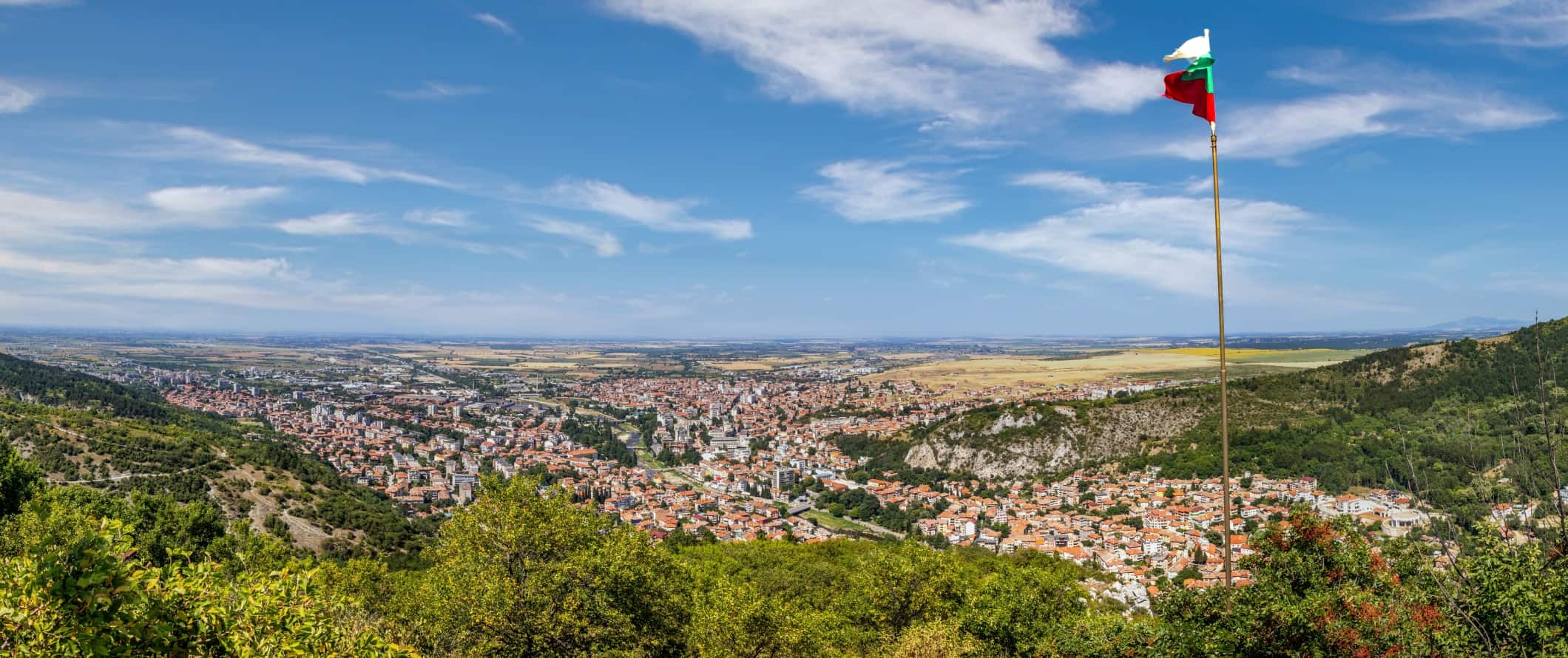
Often overlooked by travelers, Bulgaria is actually one of my favorite countries in Europe .
Because it’s under the radar, here you’ll find few crowds and plenty of affordable activities. I arrived with few expectations and was blown away by the country’s affordability, incredible history, mountainous landscapes, Black Sea beaches, and wild nightlife.
Bulgaria’s long history is evident everywhere, from ancient Neolithic settlements to mysterious Thracian tombs to fortresses left behind by powerful tsars. Even some of the smallest, most nondescript churches have elaborate religious artwork inside, including paintings of saints and vivid murals.
And, if you’re a nature lover, there are several mountain ranges throughout the country offering all kinds of stunning hikes.
In short, Bulgaria is amazing and I can’t speak its praises enough. Don’t speed through the place. There’s a lot to see and do here.
This travel guide to Bulgaria can help you plan your trip, save money, and make the most of your time here.
Table of Contents
- Things to See and Do
- Typical Costs
- Suggested Budget
- Money-Saving Tips
- Where to Stay
- How to Get Around
- How to Stay Safe
- Best Places to Book Your Trip
- Related Blogs on Bulgaria
Click Here for City Guides
Top 5 things to see and do in bulgaria.
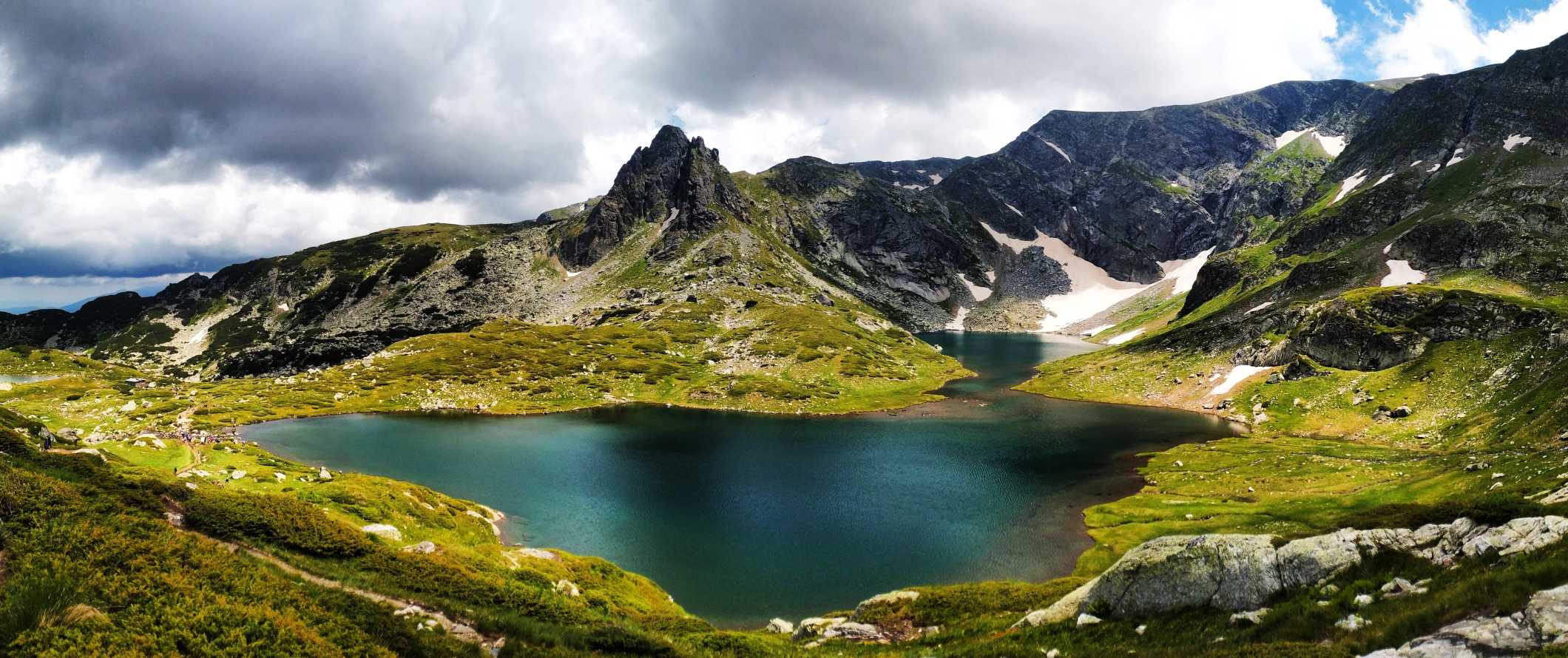
1. Explore Sofia
Sofia is Bulgaria’s dynamic capital city full of museums, Eastern Orthodox churches, communist architecture, and trendy galleries, restaurants, and clubs. The city has thousands of years’ worth of history and dates to the 8th century BCE when it was inhabited by the Serdi tribe. One of the oldest buildings is a brick rotunda that was built in the 4th century by the Romans. It was originally used as a bath but later became a church – and it’s survived almost completely intact. Don’t miss the Alexander Nevski Cathedral, built in the 1880s in the Neo-Byzantine style. It’s massive and has enough room for 10,000 people inside (you can even explore the crypt which is full of unique religious icons). Museums like the National Art Gallery, the National Historical Museum, and the National Institute of Archeology are all worth a visit and feature unique cultural and historical exhibits.
2. Relax in Varna
Varna is a major tourist destination during the summer when its beaches fill up with visitors. Like most of Bulgaria, the area has a rich history. Archeological remains of early settlements have been uncovered at over 30 sites, the oldest of which dates back to the Stone Age. Modern Varna was established in the 6th and 7th centuries when the Slavic people gained power in the Balkans, and the city emerged as an important hub for trade due to its prominent location on the Black Sea. Now it’s known as one of Bulgaria’s most popular seaside resort towns thanks to its beautiful beaches. I had a lot of fun wandering the streets, visiting the Roman Baths, walking through the big central park, and relaxing by the beach. Make sure to check out Aladzha Monastery, which is one of the oldest in Bulgaria (it dates back to the 4th century) and offers stunning views of the city.
3. Visit Plovdiv
Plovdiv is the second-largest city in Bulgaria and is the oldest continuously inhabited city in Europe (archeologists have discovered evidence of settlements dating back to the Neolithic period in 6,000 BCE). Over the years, Plovdiv has been ruled by Greeks, Romans, Celts, Huns, Slavs, Bulgars, Thracians, and Ottomans. You can explore ruins spanning the centuries on a walk-through Old Town with cobblestone streets and architecture from the Middle Ages and the Bulgarian Revival. The city is the cultural hub of Bulgaria and was named the European Capital of Culture and is part of the UNESCO Global Network of Learning Cities. Be sure to visit the Roman Amphitheater, see the Archaeological Museum, and relax under the leafy trees in the Tsar Simeon Central Garden.
4. Go to Veliko Tarnovo
Once the capital of the Bulgarian Empire, Veliko Tarnovo is now a charming university town. Much of the city is perched on the cliffs with white houses and iconic red roofs spanning the hillsides. For excellent photo opportunities visit the Sky Walk which overlooks the city and the river winding through the cliffs. Not much happens here, but I loved the cobblestone streets, the historic castle ruins, the little cafes, and the nearby mountain hikes. Like any university town, there are some eclectic spots to grab a drink like the Hipster Art Bar which has a fun atmosphere and is a great place to meet people.
5. Explore the Rila Mountains
The Rila Mountains are the highest mountain range in the Balkans, with Mount Musala towering over 3,000 meters (10,000 feet). Most of the mountain is protected within Rila National Park and the rest falls within the Rila Monastery Nature preserve, so it’s a hotspot for biodiversity and nature enthusiasts. You can trek to the top on a day hike or take on some of the less challenging hikes in the mountains. During the colder months, the Rila Mountains become packed with skiers, and if you want to treat yourself there are some luxurious spas around the area. Other highlights include the Seven Lakes route, Skakavitsa Waterfall, and the Rila Monastery. The monastery is the largest in Bulgaria and was established in the 10th century by Saint John of Rila. It’s also a UNESCO World Heritage Site.
Other Things to See and Do in Bulgaria
1. check out the museum of socialist art.
This museum in Sofia showcases art from when the country was under Communist rule (1944-1989). A large outdoor sculpture park contains everything from a giant statue of Lenin that once stood in the center of the city to the red star that topped the socialist party headquarters. Inside you’ll find all kinds of propaganda, documentary videos, photos, and more. Admission is 6 BGN.
2. Hike the Balkan Mountains
This mountain chain is at the center of Bulgaria. It’s part of the epic European Long Distance Route (E3) following the chain’s main ridge to the Portuguese seaside, spanning a distance of 6,950 kilometers (4,320 miles). For shorter day hikes, find a base town like Apriltsi and trek from there. The Mount Botev summit and the hike to Vodnite Dupki are two popular hikes.
3. Hit the beaches on the Black Sea
This 402-kilometer (250-mile) stretch of Bulgarian coast lies along the Black Sea. About one-third of this coastline is covered in pristine, sandy beaches. Avoid Sunny Beach (it’s tacky and crowded) and check out some of the quieter beaches instead, like Pomorie Beach or Sinemorets Veleka Beach.
4. Unwind in Balchik
Balchik is a small coastal town on the Black Sea. The area used to serve as the summer residence for Queen Marie of Romania (1875-1938). You can tour her Balchik Palace on the seaside promenade and admire the interesting blend of Gothic and Islamic architecture. There are not very many rooms, but they all contain original furnishings and paintings by Queen Marie herself. There’s also a botanical garden with over 600 species of plants. Admission is 15 BGN.
5 Go skiing
Bansko, Borovets, and Pamporovo are the three biggest resort towns in Bulgaria. Most people prefer Bansko because its resort has the longest ski runs and it’s doable as a day trip from Sofia. There are several hotels and budget accommodations within Bansko (although Bansko isn’t the prettiest of towns). A one-day ski pass is 90 BGN in Bansko and 85 BGN in Borovets and Pamporovo.
6. Stop and smell the roses in Kazanlak
Bulgaria is one of the biggest producers of rose oil in the world and the town of Kazanlak has hosted the Festival of Roses since 1903. During the first weekend of June, the local community organizes this international event that attracts thousands of tourists. There are rose-picking rituals, events to learn about the rose distillation process, a street procession, acapella choirs, folklore concerts, art shows, exhibitions, and even wine-tasting. Best of all, most of the events are free!
7. Visit the Varna Archaeological Museum
The Varna Archaeological Museum is home to the Varna Necropolis, a prehistoric archaeological site that contains the oldest processed gold in the world (it’s 7,000 years old). The gold was extracted from 62 graves (it was custom to bury people with gifts at that time). On display, you’ll also find intricate jewelry and other artifacts, as well as oddities like Roman surgical tools and ancient Hellenistic headstones. Admission is 10 BGN.
8. Explore Stara Zagora
Stara Zagora is a smaller city located in the south of Bulgaria, famous for its annual linden-tree bloom (the whole city smells incredibly floral — like a combination of honeysuckle and jasmine). For me, the main attraction is Stara Zagora’s historical significance. Other than once being an important crossroad for the Romans, Ottomans, and Thracians, Stara Zagora also contains some amazing prehistoric relics, including ancient burial mounds dating back 8,000 years. The Neolithic Dwellings Museum sits on one of these prehistoric mounds, along with the remains of a home. It’s 5 BGN to visit and super informative!
9. Tour the Bachkovo Monastery
Just outside of Plovdiv is the Bachkovo Monastery, dating to 1083 (although most of it was built from the 17th century). The main attraction in the monastery is the Church of Sveta Bogoroditsa, which has an interior completely covered in colorful frescoes painted by Zahari Zograf in 1850. The refectory (dining hall) is also full of murals displaying the building’s history. Pilgrims often come to the church to pray in front of the Madonna, which is encased in gold and silver. It’s free to visit the monastery, but the onsite museum costs 2 BGN and the refectory is 6 BGN.
10. Visit the Etâr Ethnographic Open-Air Museum
The Etâr 19th-century ethno-village in Northern Bulgaria is a recreated Bulgarian town lined with cobblestone streets and dozens of traditional shops and workshops devoted to cobblers, furriers (someone who works with furs), glass workers, jewelers, leatherworkers, potters, bakers, and more. Costumed performers move between buildings, making it feel like you stepped back in time (or at least onto a movie set). You can poke around recreated traditional homes, and some of the workshops are still powered by running water. It’s a bit cheesy, but you can pick up neat handmade souvenirs here. Admission is 5 BGN.
11. Hike at Emen Canyon
If you’re visiting Veliko Târnovo, head west to Emen Canyon. Carved out by the Negovanka River between tall limestone cliffs, the canyon is home to deep creeks (perfect for swimming) and picturesque waterfalls. A two-hour hike on the Negovanka Ecotrail takes you along 90-meter-high (295-foot) bluffs, leading to viewpoints over the canyon and a 10-meter-tall (32-foot) waterfall. It’s a beautiful region to explore on foot!
For more information on specific cities in Bulgaria, check out these guides:
- Plovdiv Travel Guide
- Sofia Travel Guide
- Varna Travel Guide
- Veliko Tarnovo Travel Guide
Bulgaria Travel Costs
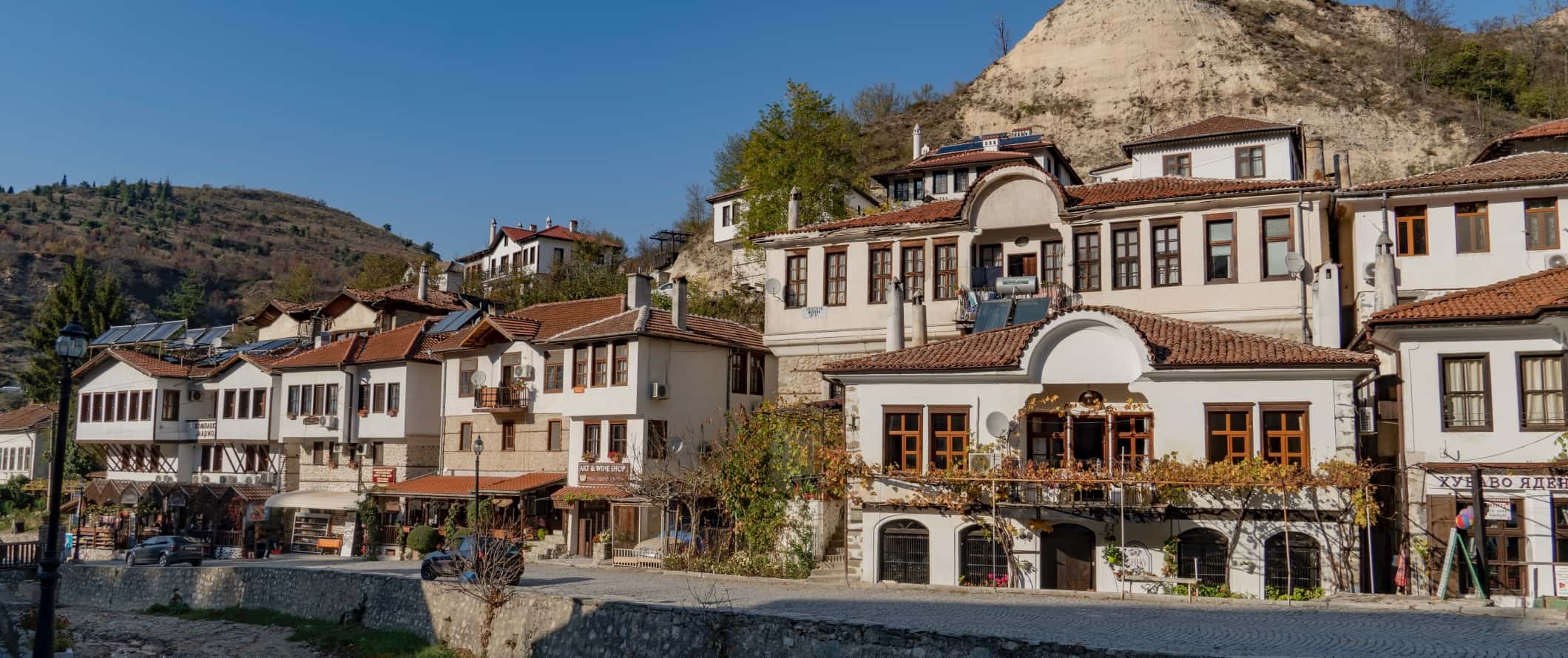
Accommodation – Hostel dorms with 5-8 beds cost between 15-25 BGN per night. Private hostel rooms cost 30-60 BGN per night. Free Wi-Fi is standard and most hostels also include self-catering facilities.
Budget two-star hotels range from 50-100 BGN per night. If you want to stay at one of the resort areas on the Black Sea, expect to pay double that amount during the summer.
Airbnb is available across Bulgaria, with private rooms ranging from 20-55 BGN per night. An entire home/apartment costs around 60-110 BGN.
For those traveling with a tent, there are also well-maintained campgrounds around the country, especially along the coast. Most tent sites start at 5-20 BGN per night for a basic pitch without electricity.
Food – Bulgarian cuisine is hearty and similar to that of its Balkan neighbors. Meaty stews with lamb, goat, or chicken are common, as are sausages and all kinds of yogurts (dairy products are big here). Popular dishes include kebapche (grilled mincemeat), shopska salad (a salad with tomato, cucumber, and cheese; similar to Greek salad), and moussaka.
Overall, food is very affordable throughout Bulgaria. Local street food eats like banica (cheese pastry) are as little as 1.50 BGN. You can pick up a hearty shopska or kebab for about 6 BGN.
For fast food (think McDonald’s), you can get a combo meal for about 12 BGN. A casual meal at a restaurant serving traditional cuisine costs around 14 BGN. A large pizza also costs around 10 BGN.
If you want to splash out, a three-course meal with a drink costs around 30 BGN.
Beer is 4 BGN while a latte/cappuccino is 3.50 BGN. Bottled water is around 1.50 BGN.
Grocery shopping is very cheap here, costing about 45-65 BGN per week for basic staples like rice, pasta, seasonal produce, and some meat.
Backpacking Bulgaria Suggested Budgets
If you’re backpacking Bulgaria, expect to spend about 55 BGN per day. On this budget, you’ll be staying in a hostel dorm, cooking most of your meals, limiting your drinking, taking public transportation to get around, and sticking to mostly free activities like hiking and going to the beaches. If you plan on drinking, add 5-10 BGN to your daily budget.
On a mid-range budget of 135 BGN per day, you can stay in a private Airbnb, eat out for most meals at cheap fast food joints, have a couple of drinks, take the occasional taxi to get around, and do more activities and tours like visiting museums or going skiing.
On a “luxury” budget of 200 BGN per day or more, you can stay in a hotel, eat out for all your meals, drink more, rent a car or take more taxis, and do whatever tours and activities you want. This is just the ground floor for luxury though. The sky is the limit!
You can use the chart below to get some idea of how much you need to budget daily, depending on your travel style. Keep in mind these are daily averages — some days you’ll spend more, some days you’ll spend less (you might spend less every day). We just want to give you a general idea of how to make your budget. Prices are in BGN.
Bulgaria Travel Guide: Money-Saving Tips
Bulgaria is one of the most affordable destinations in Europe. You can do a lot on a tight budget here as most of the country’s attractions (such as museums and historical sites) are cheap. You’ll find it hard to break the bank here unless you’re spending your time on the Black Sea coast during peak season and intentionally trying to splurge. Here are some ways to save money in Bulgaria:
- Avoid Sunny Beach – I don’t understand the appeal of a beach that’s overpriced and crowded with tourists. Hit up one of the other coastal beaches instead.
- Stay at Hostel Mostel – Staying at this hostel chain can lower your costs because they include free breakfast and free dinner. They have locations in Sofia and Veliko Tarnovo .
- Eat at the bakeries – Bakeries in Bulgaria have an inexpensive range of sweet and savory pastries that can fill you up. Two of my favorite snacks there are banica and krenvirshka.
- Stay with a local – If you plan ahead, you can usually find Couchsurfing hosts all throughout the country. This way, you not only have a free place to stay but you’ll connect with a local host that can share their insider tips and advice.
- Take free walking tours – Walking tours are a great way to get familiar with a city and its culture. Sofia, Veliko Tarnovo, and Plovdiv all have free walking tours. Just be sure to tip your tour guide at the end.
- Enjoy free events – Many of Bulgaria’s festivals are free to attend, and during the summer many city parks have free scheduled events and concerts. Ask your hostel or host what’s going on during your visit.
- Bring a water bottle – The tap water here is safe to drink so bring a reusable water bottle to save money and reduce your plastic use. LifeStraw is my go-to brand as their bottles have built-in filters to ensure your water is always clean and safe.
Where to Stay in Bulgaria
Bulgaria has lots of fun, affordable hostels around the country. Here are my favorite and suggested places to stay:
- Hostel Mostel (Sofia)
- Hostel 123 (Sofia)
- Hostel Mostel (Veliko Tarnovo)
- Hostel Old Plovdiv (Plovdiv)
- Yo-Ho-Hostel (Varna)
- Nomado Hostel (Varna)
How to Get Around Bulgaria
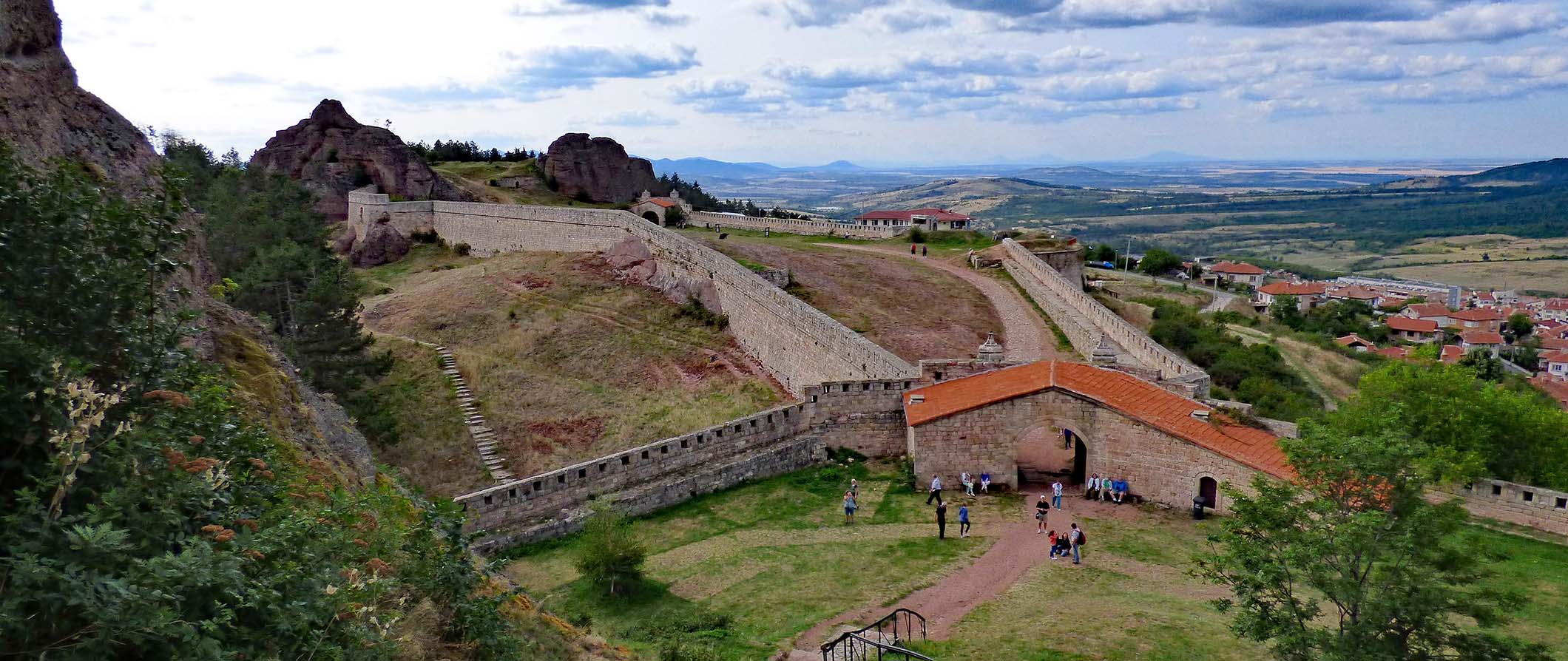
Public transportation – Public transportation in Bulgaria is very affordable. Sofia has a subway with two lines connecting the city center and the airport, as well as the central bus and train stations. Tickets are 1.60 BGN each.
In other cities, public buses are the most common mode of public transportation. Fares are usually between 1-2 BGN. Trolleybuses and trams are also common and generally cost the same.
Some cities, like Sofia, have a daily transportation pass for 4 BGN per day. A three-day pass is 10 BGN.
Taxi – Taxis are readily available everywhere, with rates starting at 2 BGN, costing an additional 1-2 BGN per kilometer. Always make sure your driver uses the meter so you avoid getting ripped off. Ridesharing like Uber is not available here.
Bus – Bulgaria has lots of private and public minibusses and coaches to get you between the smaller towns and cities. A bus from Sofia to Varna costs around 33 BGN and takes seven hours, while Varna to Plovdiv is 27 BGN and also takes seven hours. A three-hour journey from Sofia to Veliko Tarnovo shouldn’t cost more than 30 BGN.
Train – Train travel in Bulgaria is often cheaper than taking the bus, but it’s a lot slower. For example, the same Sofia to Veliko Tarnovo journey costs just 20 BGN but takes a little over four and a half hours by train (instead of three by bus). You can use the Bulgarian State Railways website (bdz.bg) to plan your trip.
Flying – There are limited domestic routes around Bulgaria, making this an inconvenient option for most travelers. That said, flying is affordable here. A one-way trip between Sofia and Varna costs about 160 BGN, while a one-way trip between Sofia and Burgas is about 106 BGN. Unless you’re pressed for time, though, I’d stick to the bus.
Car rental – Car rentals are super affordable here, costing as little as 25 BGN per day. If you have someone to share the ride with, this could be an affordable and flexible way to get around the country. Drivers need to be 21 years old and have an IDP (International Driving Permit).
To find the best car rental prices, use Discover Cars .
When to Go to Bulgaria
If you want hot weather and lots of time on the Black Sea coast, summer (June-August) is the best time to visit. Temperatures average 29-32°C (84-90°F) and the water is ideal for swimming. These temperatures are fairly consistent across the country, although the mountain regions can be cooler.
Spring and fall weather can change from day to day. Temperatures range between 5-21°C (41-70°F) in the spring and the weather can be quite foggy and cloudy, with not a lot of sunshine. But if you want fewer crowds and lower prices, this is the best time to come.
The fall months (September-October) are best for hiking as the autumn foliage is starting to show. Fall temperatures range from 2-21°C (36-71°F).
Winter can be frigid, with temperatures dropping as low as -5°C (23°F). The snow-capped mountains are beautiful during this time, and many people come here to hit the slopes. If you’re not coming here to ski or do winter sports, however, I’d skip a winter visit.
How to Stay Safe in Bulgaria
Bulgaria is a very safe country to visit. Violent crime against visitors is very rare. Scams and petty crime like pick-pocketing are the most common danger you’ll face when you’re traveling the country, but even those are rare.
That said, it’s always a good idea to keep your valuables secure and out of sight when out and about.
Solo female travelers should generally feel safe here, however, the standard precautions apply (never leave your drink unattended at the bar, never walk home alone intoxicated, etc.).
When taking taxis, always make sure the meter is on. A common scam is for taxi drivers to tell you that their meter is broken. Insist that you want a taxi with a working meter or negotiate the cost upfront.
You can read about common travel scams to avoid right here.
If you experience an emergency, dial 112 for assistance.
The most important piece of advice I can offer is to purchase good travel insurance. Travel insurance will protect you against illness, injury, theft, and cancellations. It’s comprehensive protection in case anything goes wrong. I never go on a trip without it as I’ve had to use it many times in the past.
Bulgaria Travel Guide: The Best Booking Resources
These are my favorite companies to use when I travel. They consistently have the best deals, offer world-class customer service and great value, and overall, are better than their competitors. They are the companies I use the most and are always the starting point in my search for travel deals.
- Skyscanner – Skyscanner is my favorite flight search engine. They search small websites and budget airlines that larger search sites tend to miss. They are hands down the number one place to start.
- Hostelworld – This is the best hostel accommodation site out there with the largest inventory, best search interface, and widest availability.
- Booking.com – The best all around booking site that constantly provides the cheapest and lowest rates. They have the widest selection of budget accommodation. In all my tests, they’ve always had the cheapest rates out of all the booking websites.
- HostelPass – This new card gives you up to 20% off hostels throughout Europe. It’s a great way to save money. They’re constantly adding new hostels too. I’ve always wanted something like this and glad it finallt exists.
- Get Your Guide – Get Your Guide is a huge online marketplace for tours and excursions. They have tons of tour options available in cities all around the world, including everything from cooking classes, walking tours, street art lessons, and more!
- The Man in Seat 61 – This website is the ultimate guide to train travel anywhere in the world. They have the most comprehensive information on routes, times, prices, and train conditions. If you are planning a long train journey or some epic train trip, consult this site.
- Rome2Rio – This website allows you to see how to get from point A to point B the best and cheapest way possible. It will give you all the bus, train, plane, or boat routes that can get you there as well as how much they cost.
- FlixBus – Flixbus has routes between 20 European countries with prices starting as low 5 EUR! Their buses include WiFi, electrical outlets, a free checked bag.
- SafetyWing – Safety Wing offers convenient and affordable plans tailored to digital nomads and long-term travelers. They have cheap monthly plans, great customer service, and an easy-to-use claims process that makes it perfect for those on the road.
- LifeStraw – My go-to company for reusable water bottles with built-in filters so you can ensure your drinking water is always clean and safe.
- Unbound Merino – They make lightweight, durable, easy-to-clean travel clothing.
- Top Travel Credit Cards – Points are the best way to cut down travel expenses. Here’s my favorite point earning credit cards so you can get free travel!
Bulgaria Travel Guide: Related Articles
Want more info? Check out all the articles I’ve written on backpacking/traveling Europe and continue planning your trip:

The 6 Best Hotels in Copenhagen

The 6 Best Hotels in Florence

The 7 Best Hotels in Madrid

The 6 Best Hotels in Vienna

The Best Walking Tours in Barcelona

How to Be a Digital Nomad in Europe
Get my best stuff sent straight to you, pin it on pinterest.
- Where To Stay
- Transportation
- Booking Resources
- Related Blogs

The Perfect Bulgaria Travel Itinerary: Sofia, Plovdiv, Black Sea
- Last Updated On: September 8, 2023
Bulgaria is the last of the Balkan countries on my list to visit. Having already been to all of the former Yugoslavian countries , as well as a road trip through Albania and Kosovo , and of course various road trips through Greece, it was time to finally visit Bulgaria.
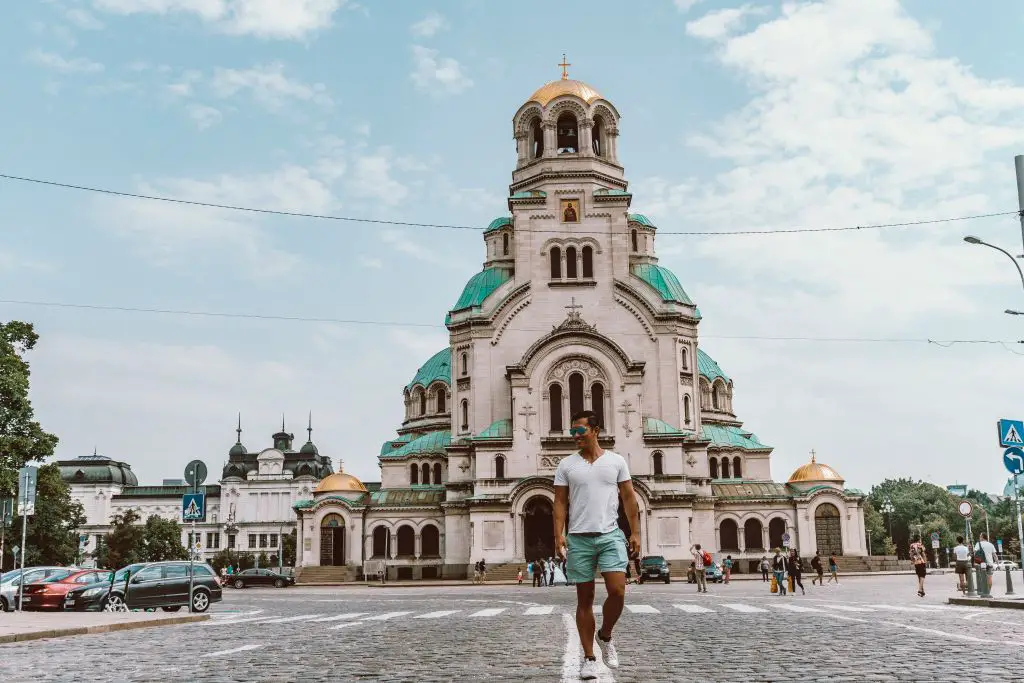
Bulgaria has it all. From Cosmopolitan cities to ancient wonders. From beautiful mountain ranges to idyllic beaches on the Black Sea. The wine is excellent while cheap, and the food is heaven if you are keen for grilled meats. Bulgaria is located at crossroads between Europe and Asia and throughout history it was a place of incredible trade and a cultural melting pot.
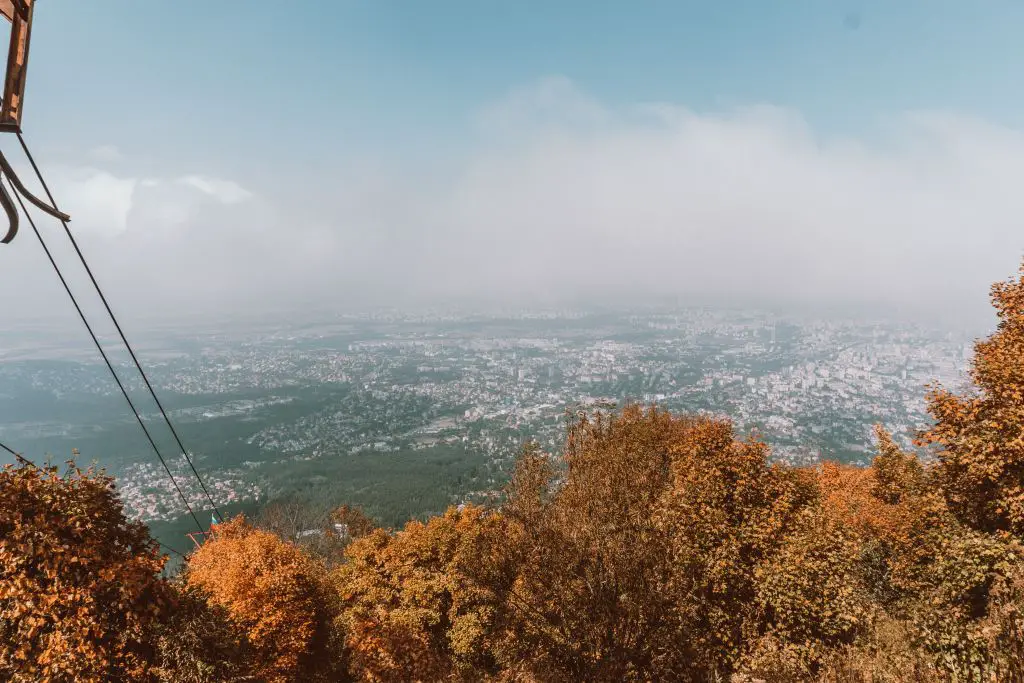
Bulgaria History
I am not sure why but I find Balkan history to be fascinating. Bulgaria is no different. In ancient times, Bulgaria was settled by the Thracians for thousands of years. Greeks and Romans eventually took control of the peninsula. Like the neighboring countries of Macedonia , Serbia, Bosnia , and Croatia, Slavic speaking people settled in the area from the 6th century AD as well as the Bulgars, a nomadic people coming from Central Asia.
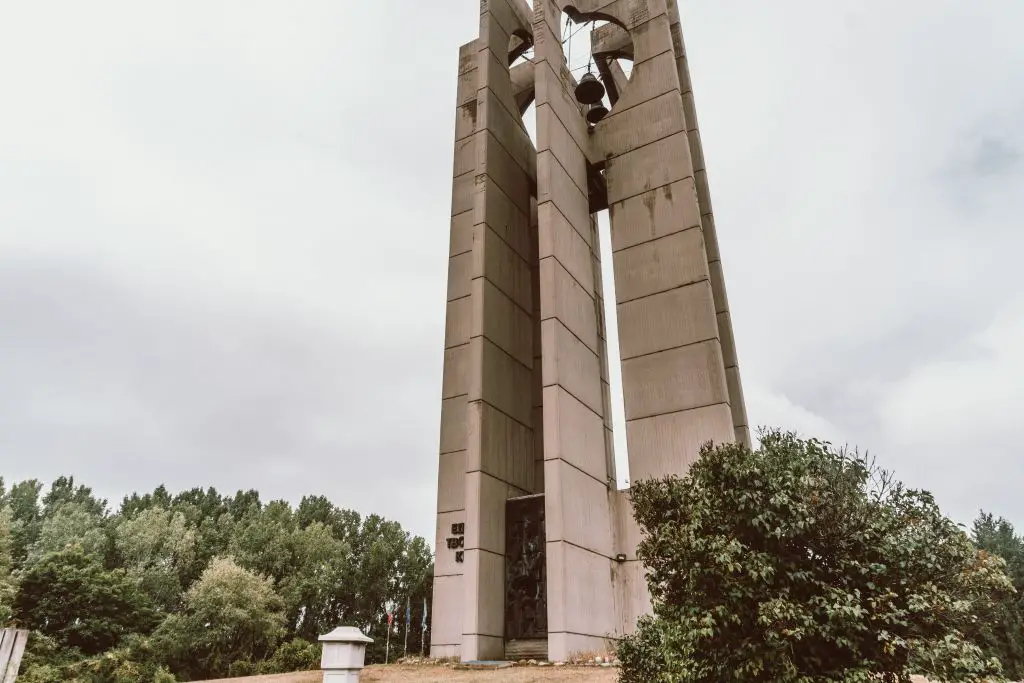
The Bulgars grew strong and conquered neighboring lands forming the first Bulgarian Empire. Eventually, the region came under Byzantine Rule in the middle ages and ultimately fell to the Ottomans like the rest of the Balkan region. Ottomans ruled the area for 500 years with its influences still felt to this day.
As Bulgaria is a Slavic speaking nation, after WW2, the country looked to unite with Tito’s Yugoslavia given how culturally similar the nations were. Stalin refused this union and ultimately Bulgaria came under the influence of the Eastern Bloc’s version of Communism. Bulgarians still feel the most connected with their South Slav neighbors in Serbia, Bosnia, Croatia, Macedonia etc. but they are probably happy to have avoided the Balkan Wars.
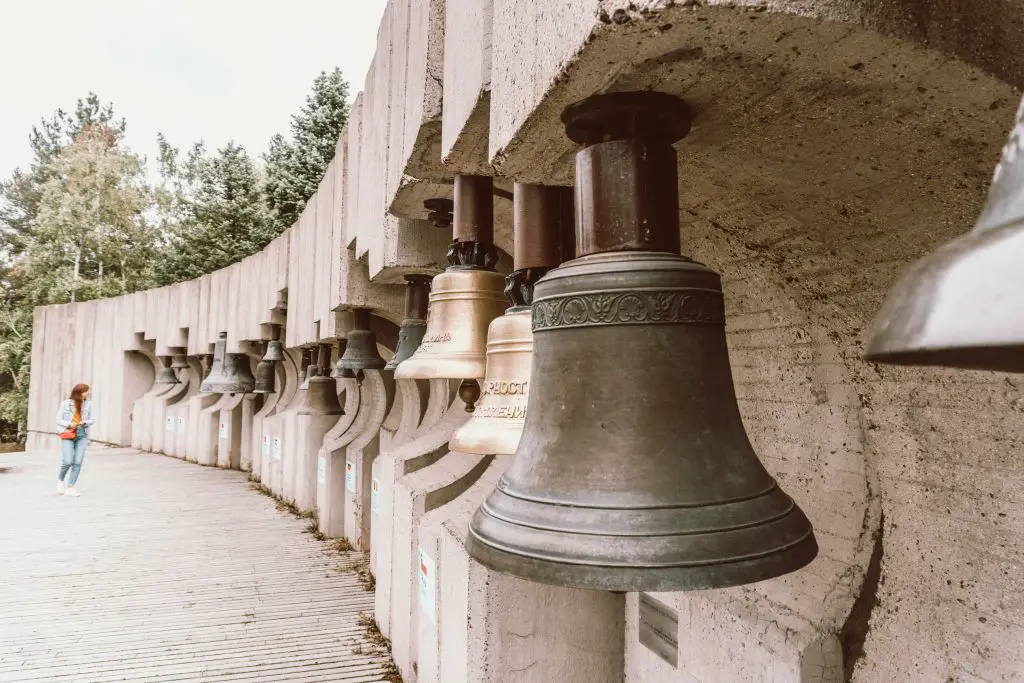
I had visited North Macedonia a few months prior to Bulgaria and noticed that some of the words in Macedonian were very similar to Bulgarian (but different than Serbo-Bosnian-Croatian). Turns out that Macedonia was part of Bulgaria only a century ago and the languages are nearly identical!
Best time to visit Bulgaria
Bulgaria enjoys a continental climate experiencing all seasons. As it is located further south, you will generally find milder winters than other countries in Europe.
Summer months can be extremely hot especially inland around the big cities. Temperatures can easily go above 35c and stay there for long periods of time. Many people flock to the coastal towns of Varna, Burgas and Sozopol during these months to escape the heat. Expect lots of sun with the occasional shower.
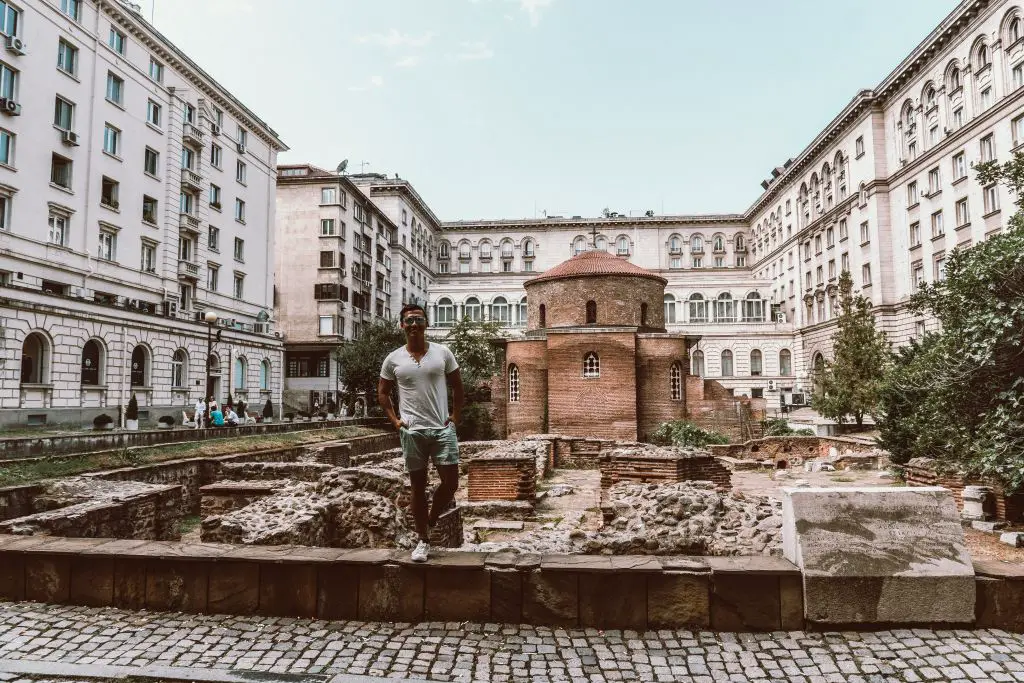
Bulgaria, while beautiful, does not experience the same tourism numbers like neighboring Greece. In the summer months, you’ll see various tourists from around the world but you will never feel overwhelmed like the amusement park conditions in places like Dubrovnik, Croatia . The month of August will see a mass exodus of Bulgarians from the cities to the beach towns. However, outside of that, there is not really a bad time to visit the country.
Whether you visit in the summer, or the shoulder seasons of Spring/Autumn, you will find that there aren’t many tourists which is fantastic.
How to get around Bulgaria
Bulgaria is well connected with the rest of Europe. There are daily flights to Sofia from many European capitals with plenty of discount airlines flying into the city (like Ryanair, Wizzair etc). I flew from Frankfurt to Sofia via Wizzair and paid about €70 round trip.
Sofia is well connected and can easily be reached by bus from neighboring cities like Belgrade, Thessaloniki , Skopje, Bucharest etc.
To get around Bulgaria, I rented a car from Sofia and drove around the country. Car rentals are very cheap in Bulgaria with gas prices generally below the average of the rest of the EU. I always like driving a car as I feel like I have the freedom to explore the little things that I want, when I want.
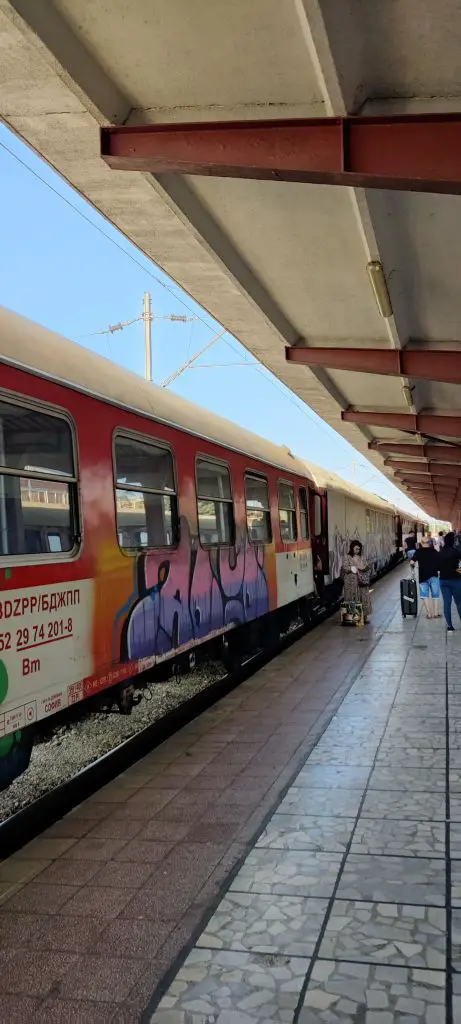
The road conditions in Bulgaria are decent but not great. The main highway is great but you’ll be on many smaller roads with questionable roads.

Alternatively, if you do not want to rent a car, you can also get around quite easily by bus and trains. The country is well connected, albeit with old soviet style trains and not the high speed trains Western Europe enjoys.
Buy the Vignette if you’re coming from another country
If you’re crossing the border into Bulgaria from another country like Northern Greece , or North Macedonia , make sure to absolutely buy the vignette . You can purchase this at the border for €15 for two weeks and this will allow you to drive legally on the roads.
Alternatively, you can purchase this online at their website. This is a great option if you want to pay by credit card as they don’t accept card at the small shops near the borders. Make sure to buy this otherwise you will be caught and fined . I was very impressed with their toll system and how sophisticated it is to catching people.
They have cameras all over the country and toll police will be informed when your plate gets photographed and they will be waiting for you. Do not risk it, otherwise the fine will be €300!
Where I went in Bulgaria
I had a total of just under two weeks for my Bulgaria trip. I think one week to two weeks is probably enough to see the highlights of the country. Of course, the more time in a place is always better but I understand people’s time constraints!
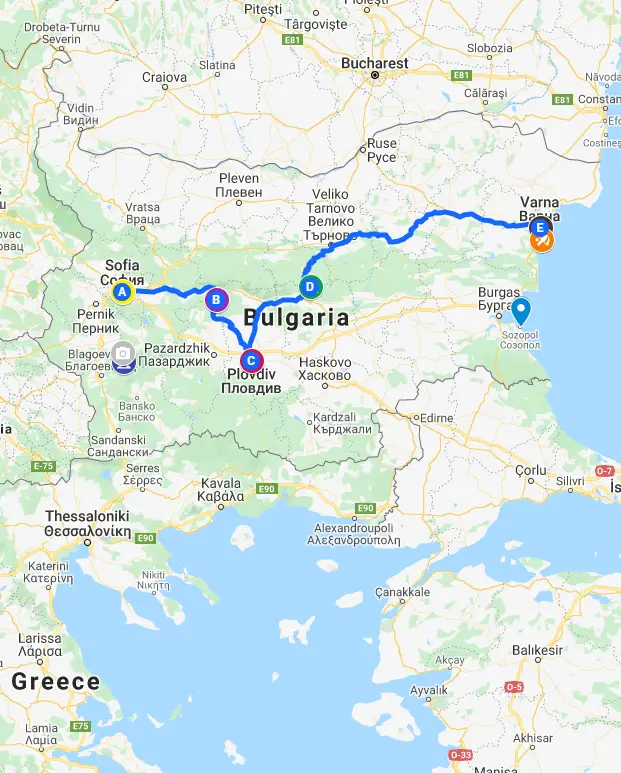
If these places are on your list of place to visit, then this is the itinerary for you. Don’t worry, I will have plenty of itinerary examples depending on the amount of days you have to travel.
- Rila Monastery
- Buzludzha Monument
- Koprivshtitsa Town
- Varna (Black Sea), Sozopol etc.
Full Bulgaria Travel Itinerary
The trip starts in Sofia. I flew here from Frankfurt and spent my first three nights exploring the capital. Although it is not the most beautiful city, I really enjoyed the vibe and energy the capital has to offer.
From Sofia, I did a day trip to the Rila Monastery in the south which is a very popular day trip. Afterwards, I rented a car to go to Plovdiv. Along the way, I stopped in the traditional village of Koprivshtitsa to enjoy the views before arriving in Plovdiv. In Plovdiv, I spent another three nights exploring the city. While in Plovdiv, I also made a day trip to the Buzluzdha communist monument which was just amazing.
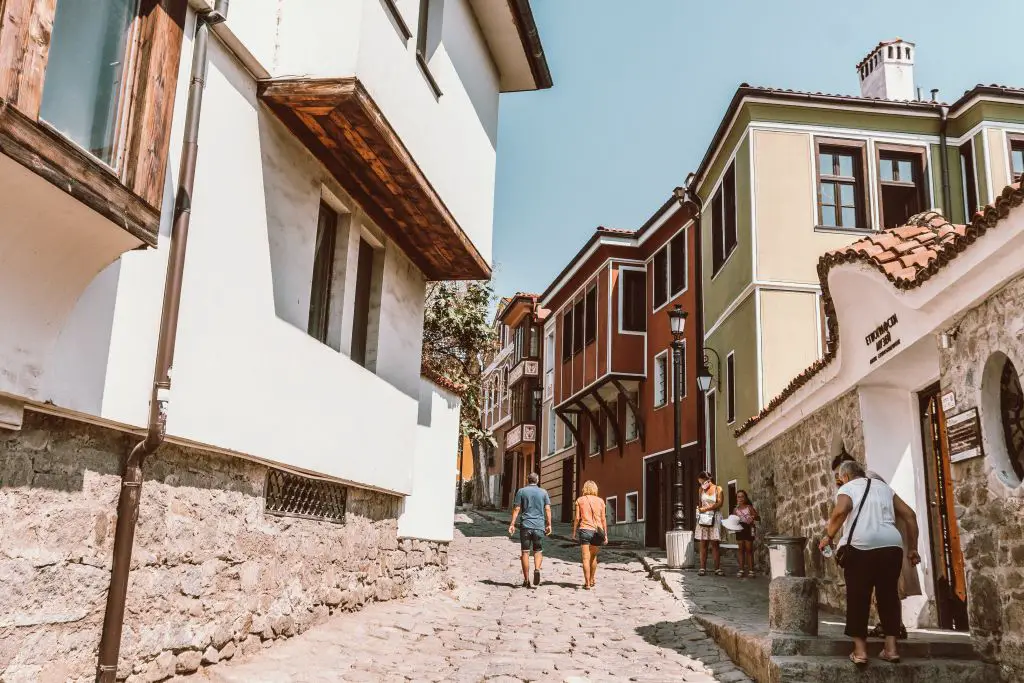
Finally, my last few days were spent along the Black Sea visiting the coastal towns of Bulgaria. I based myself in Varna and used it as a base to explore the neighboring beaches and regions. I recommend 2-3 nights here depending on how much of a beach escape you want. I’m not particularly impressed with the Black Sea as far as beaches go. The Mediterranean is far superior in my opinion but you will generally find cheaper prices here.
Bulgaria’s main airport is its capital of Sofia. However, there are smaller airports in Plovdiv and Varna that service many international airports around Europe. If you’re not renting a car, then you could potentially fly into Sofia, and fly out of let’s say Varna on the Black Sea so you don’t need to backtrack your way to Sofia.
Full map of Bulgaria Itinerary
Day 1-3: Sofia, Capital of Bulgaria
It’s likely that most trips to Bulgaria will start in the capital city of Sofia. Sofia is home to about 1/3 of Bulgaria’s population and is a city with much to offer. It’s not as beautiful as other Balkan cities and I’ve even been told my some people to skip the city entirely but that is a mistake. There is plenty to do in Sofia that’s worthwhile.

Bulgaria, having been under the Eastern Bloc, has much of the Communist style architecture as other Eastern European cities which is a contrast to the Tito controlled Yugoslavia that emphasized preserving and restoring historical buildings. Sofia is not so beautiful in the traditional European sense but it’s a great place to spend a few days enjoying the energy of the city.
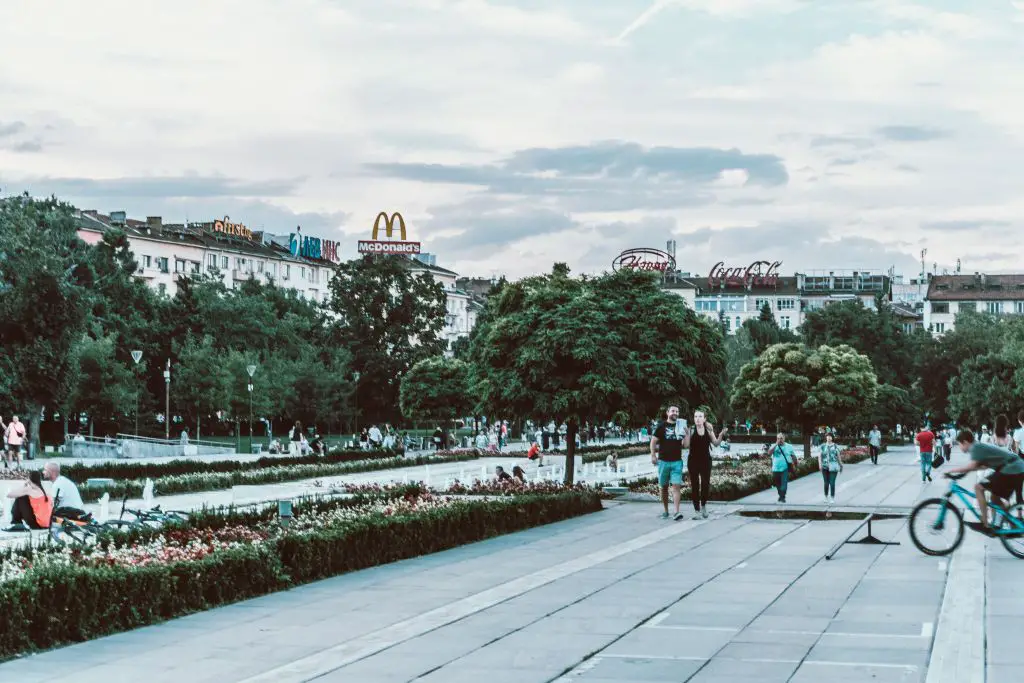
Alexander Nevsky Church
Perhaps the most iconic representation of the city of Sofia is the Aexander Nevsky Orthodox Church. I’m a big fan of Orthodox churches preferring them to Catholic cathedrals. This church in Sofia is one of the largest I’ve seen and is a must visit when coming to Sofia. The green and gold domes of this massive structure guided traders and merchants in the past when they were close to the city of Sofia.
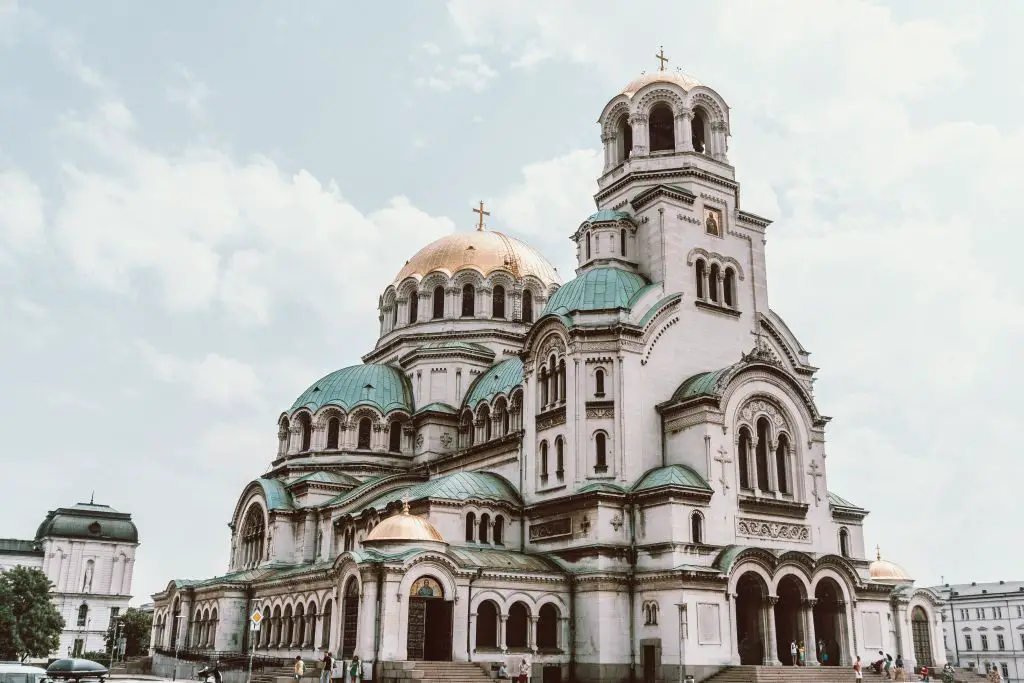
The church is free to enter. I didn’t find the inside of the church particularly impressive but the outside is just beautiful.
In the same area is the Serdica archaeological complex, where the restored remains of the excavated Roman city of Serdika are on public display. Next on your walk are the Ottoman-era Banya Bashi Mosque and (demonstrating the cultural diversity of Bulgaria through history) Sofia Synagogue, one of the biggest synagogues in Europe. Between the two is Sofia’s central market – perfect for grabbing a snack or souvenir.
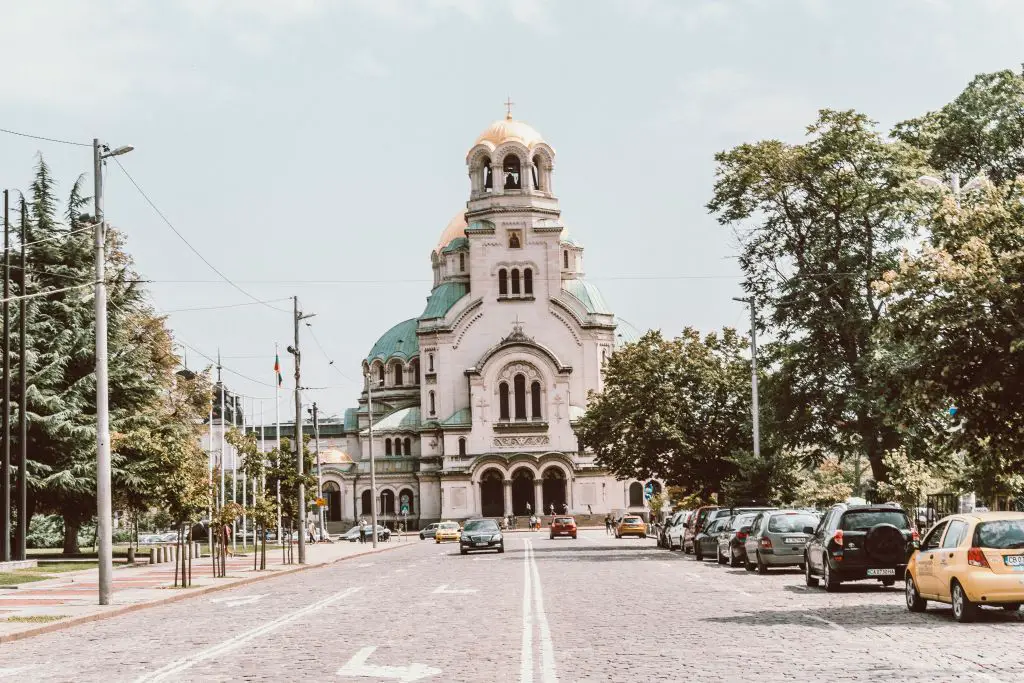
One of Sofia’s most prominent landmarks, the National Palace of Culture is about a 15-minute walk from the sights listed but chances are you will come across it if you explore any of Sofia’s many parks and green spaces. It was opened in 1981 to celebrate 1300 years of the Bulgarian state and is a must for travellers interested in architecture from that era.
Free walking tour of Sofia
Like other European cities, the free walking tour of Sofia is a must do when visiting Sofia. I did this tour upon arrival just to get my bearings of the city. The tour lasts 2.5-3 hours and visits the main highlights of the city.
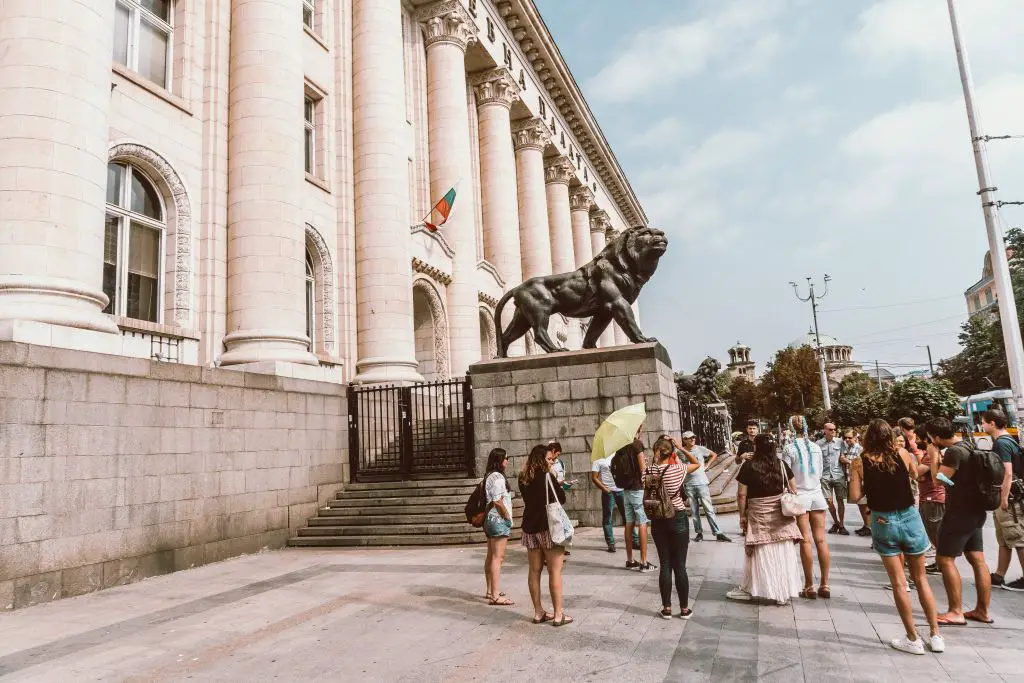
The tour meets every day at 11am at the Palace of Justice in the city center.

Sofia Pub Crawl
I also can recommend the Sofia pub crawl. If you’re a solo traveler, this is the perfect place to meet cool people and have a good night out on the town. The tour meets at 9pm and goes around the town visiting numerous bars and clubs.
The cost is 30 Lev which is a bit steep but you get some free beers and shots with the price.
The Scene or the Sense for Rooftop Drinks
For the best views of the city, I would recommend visiting the Scene rooftop bar at the Hyatt Hotel or the Sense Rooftop at the Sense hotel. Both hotels are near to the Alexander Nevsky Church and features this beautiful building front and center.
The drinks here are quite expensive especially by Bulgarian standards but this just comes with the territory. Come here for a nice glass of wine while enjoying the views of Sofia and the neighboring mountains.
Rakija Bar Restaurant
Without a doubt, Rakija bar is my favorite restaurant in Sofia. It’s known for its extensive Rakija menu with many different Rakija varieties. If you’re new to Rakija, it is the national drink of Bulgaria and all the other Balkan countries. It is a way of life and religion all rolled up into one.
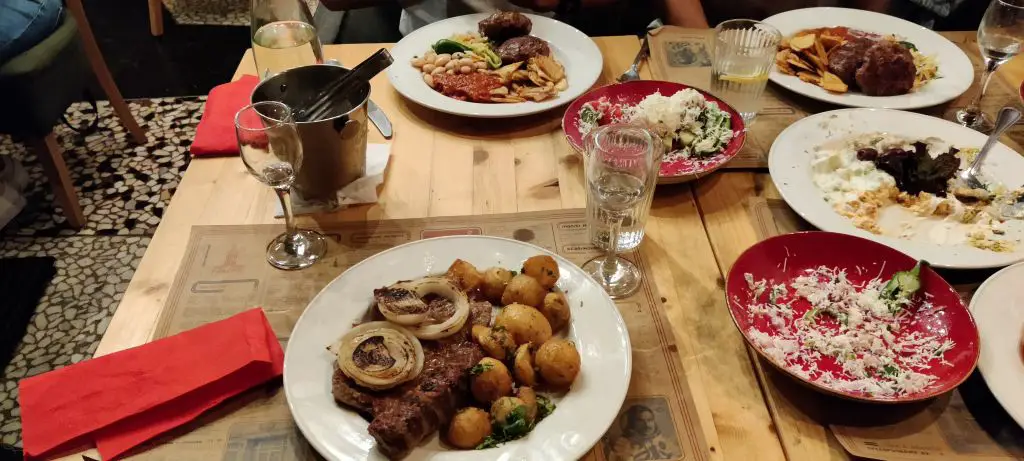
You can sample various styles of Rakija at this restaurant. Rakija can be made from various fruits like grapes, plums, quince, pear, peaches etc. Regardless, you’ll have a good time and feel drunk very quickly.
The food at this restaurant is also delicious. Get the grilled chicken or the traditional Bulgarian kebapche and you’ll be in heaven.
Shtastlivetsa Restaurant
Located in the city center, Shtaslivetsa is one of the top restaurants in Sofia. The inside is immaculately decorated and the traditional Bulgarian food that is served is also delicious. It feels very fancy inside but the prices are quite reasonable.

Rainbow Cafe
For a quick breakfast, look no further than Rainbow Cafe. In additional to a traditional brunch style menu, they also make the most delicious Mekitsi (fried dough) and Banitsa (local pastry similar to Burek). Make sure to get the Mekitsi with jam!
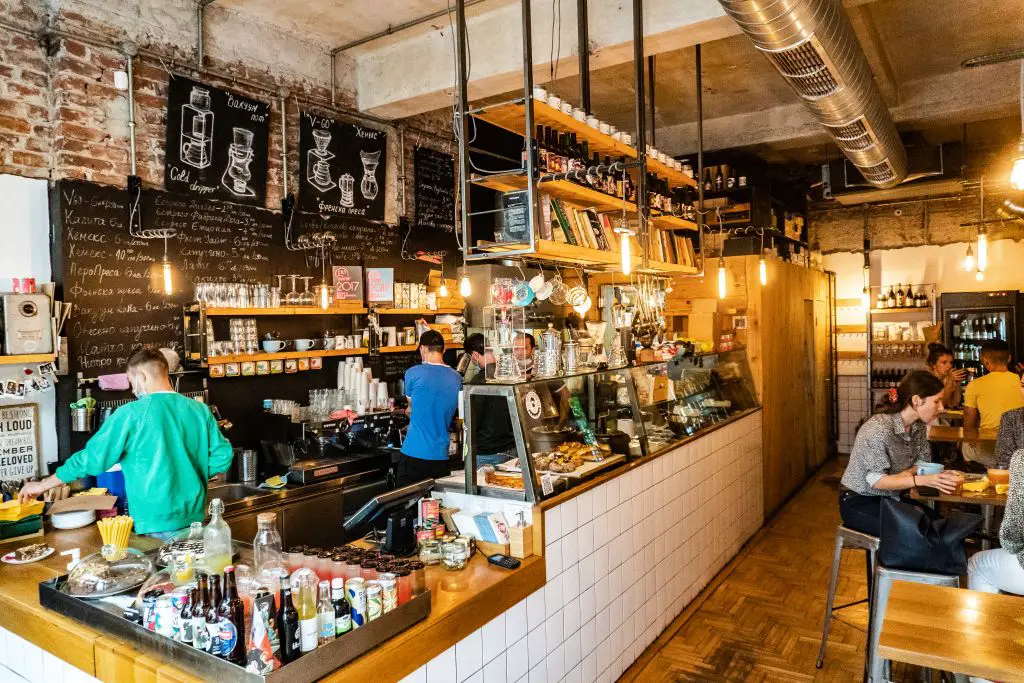
Cocktail bars
5L Speakeasy Bar Soda Bar
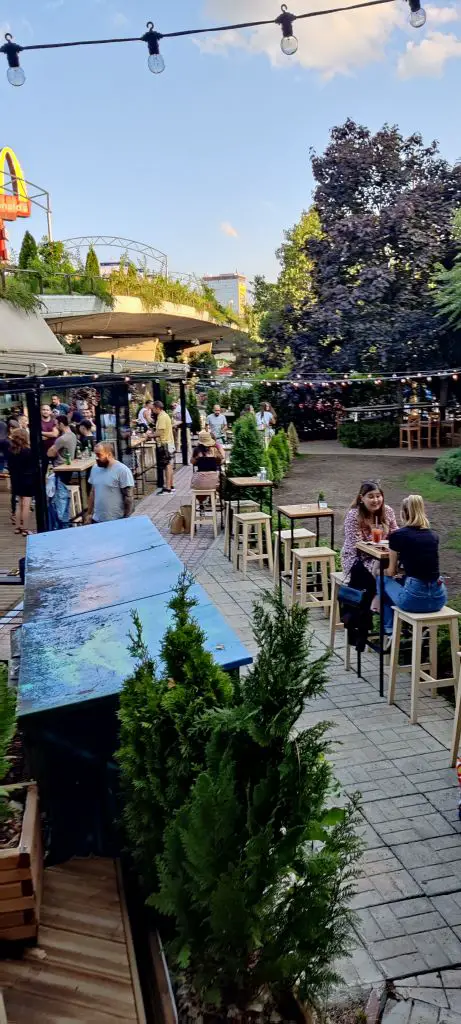
Day 4: Day Trip to Rila Monastery
Rila Monastery, or the Monastery of Saint Ivan of Rila, to give it its full name, is an Eastern Orthodox monastery founded in the 10th century. A fire destroyed the monastery at the beginning of the 19th century, and the complex was rebuilt soon after. The Bulgarian Renaissance style stripes are its most distinctive feature. UNESCO inscribed Rila Monastery as a UNESCO World Heritage Site in 1983.
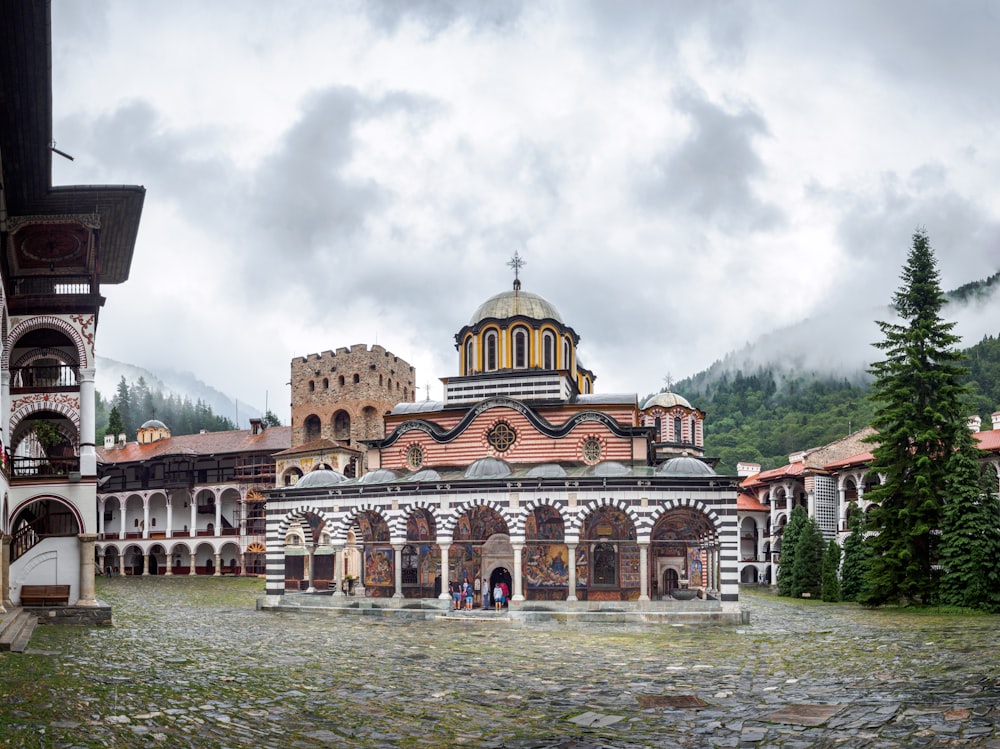
There is a dress code for visiting Rila monastery, so make sure you are appropriately attired: long trousers and skirts (at least below the knee), no sleeveless tops (bring a scarf or shawl to cover your shoulders).
This monastery is one of the most impressive complexes I’ve ever seen. Not only are the churches in fantastic conditions, but the whole complex is the size of a football stadium surrounded by views of the beautiful Balkan mountain range.
Day 5: Koprivshtitsa
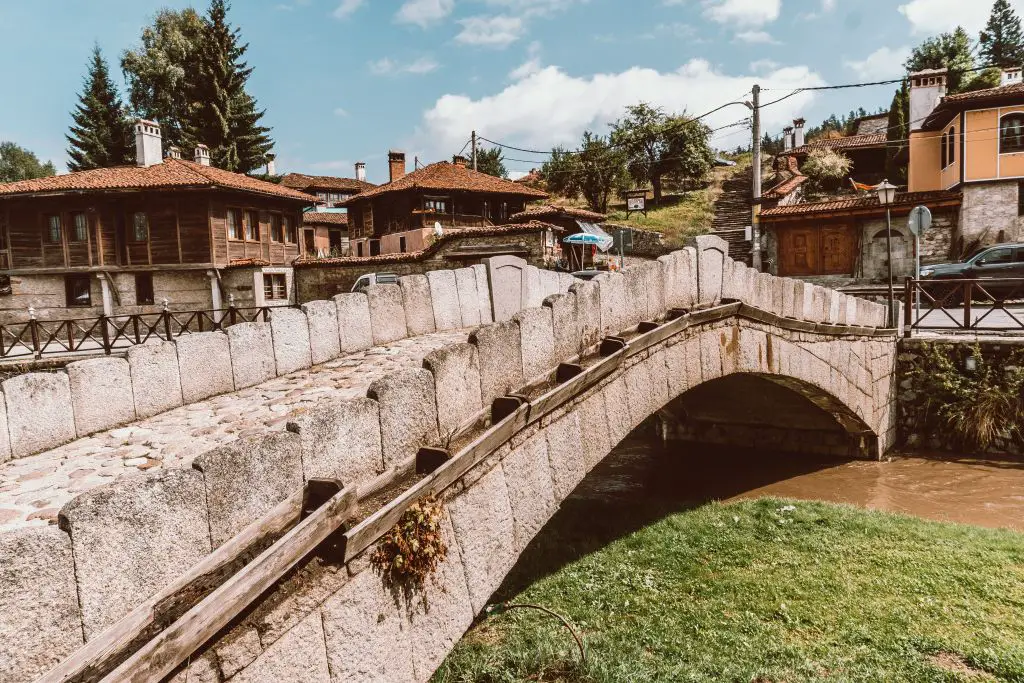
The best view of Koprivshtitsa is from the Georgi Benkovski monument located above the town. Going up there isn’t too difficult and you will be rewarded with some amazing views of Koprivshtitsa and surrounding Sredna Gora mountains.
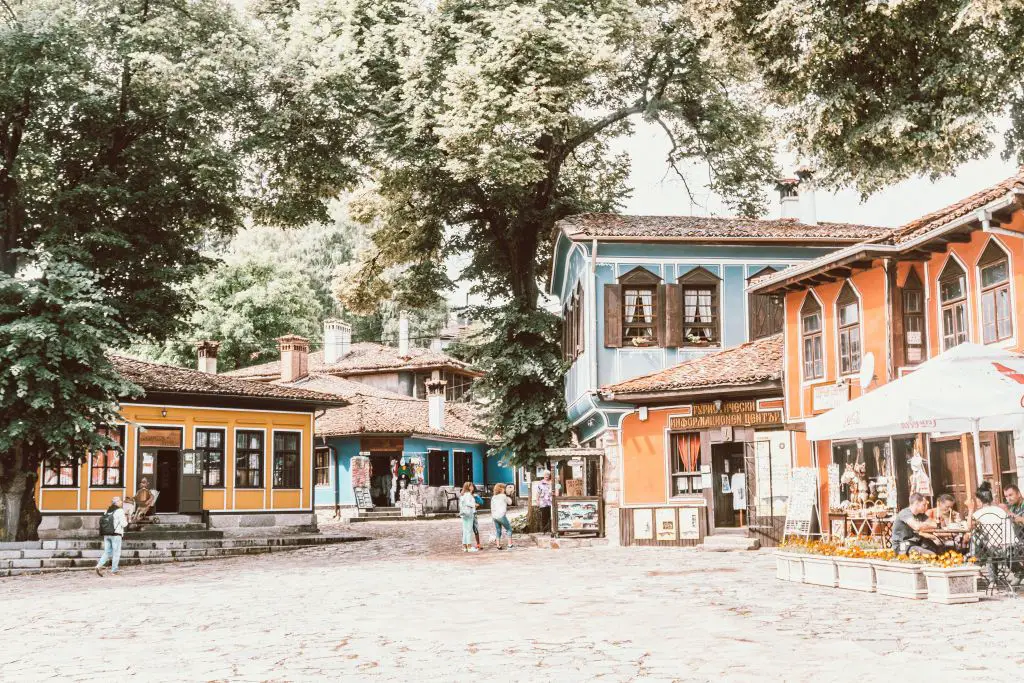
To be honest, there is not that much to do in the city. I stopped here for lunch at a traditional restaurant which was fantastic. I found that the best thing to do in this town is simply walk through the streets and admire the architecture.
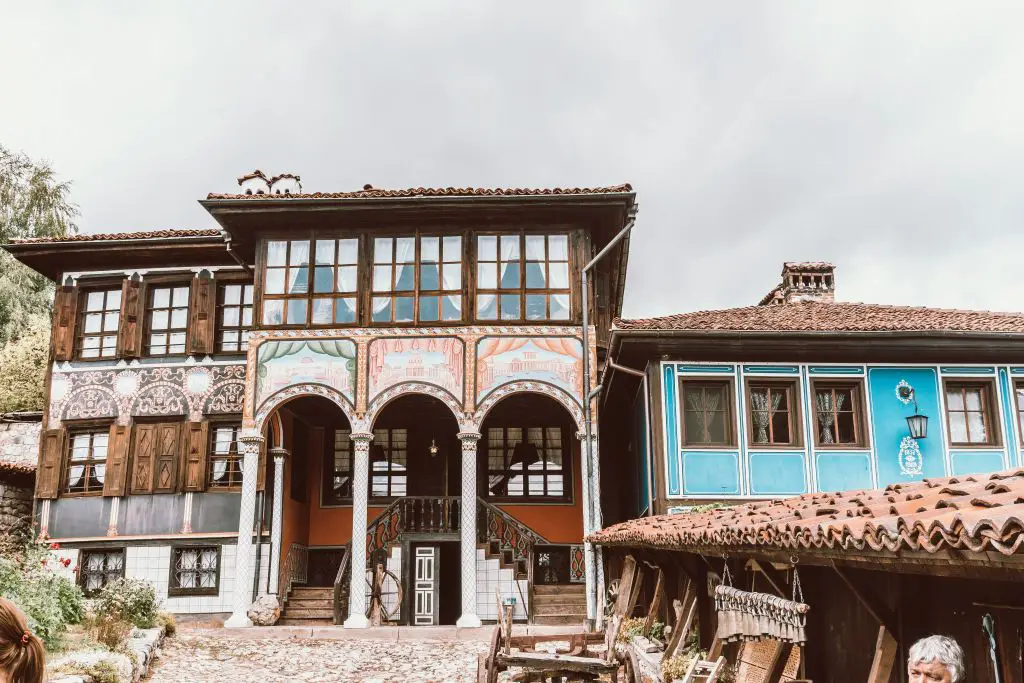
Day 5-7: Plovdiv
After exploring Sofia, the next step on the Bulgaria itinerary is the historical city of Plovdiv. As one of the European Capitals of Culture in 2019, Plovdiv is probably the most tourist-friendly city in Bulgaria and it has a lot to offer visitors. What Sofia lacks as far as old European charm, Plovdiv offers it and more.
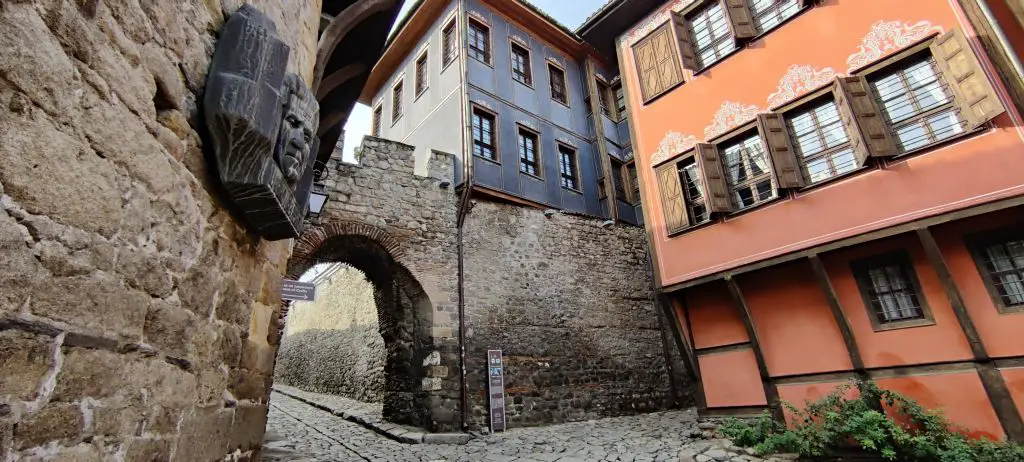
Plovdiv is thought to be the oldest continuously inhabited city in Europe, with a history dating back over 6,000 years. It was sacked, controlled, and sacked again by almost all of the major historical empires of the region. From the Greeks, to the Romans, to the Huns, Mongols, Turks and more, everyone has come through Plovdiv and fallen in love with the city.
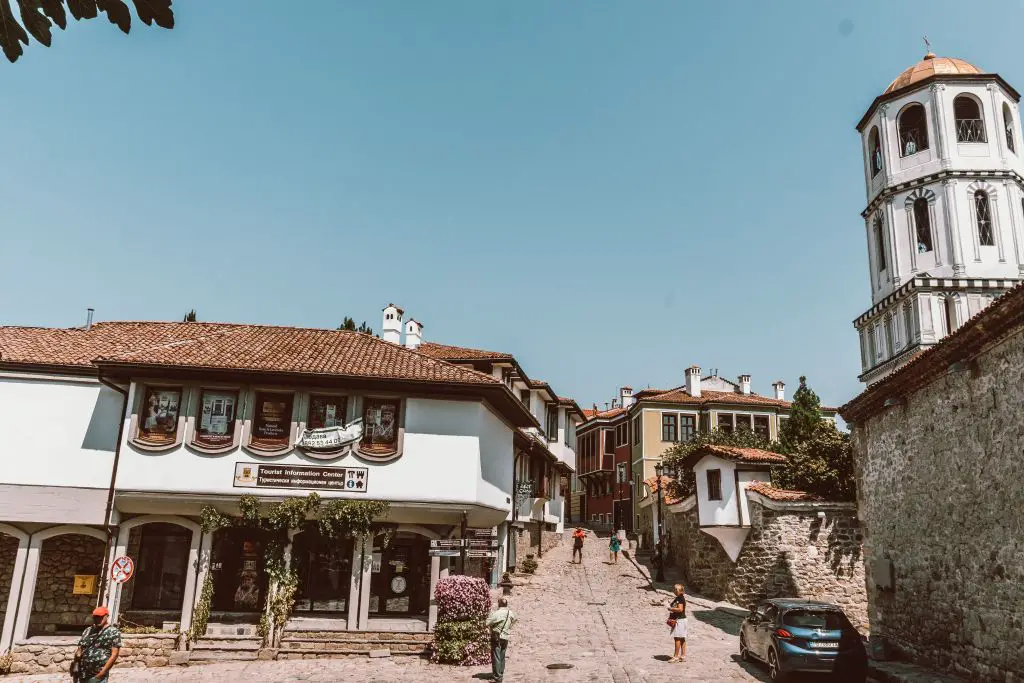
Practice Aylak
Aylak, is one of the guiding principals of Plovdiv. I learned this on my walking tour that the word and concept originated in Plovdiv. What does it mean you ask?
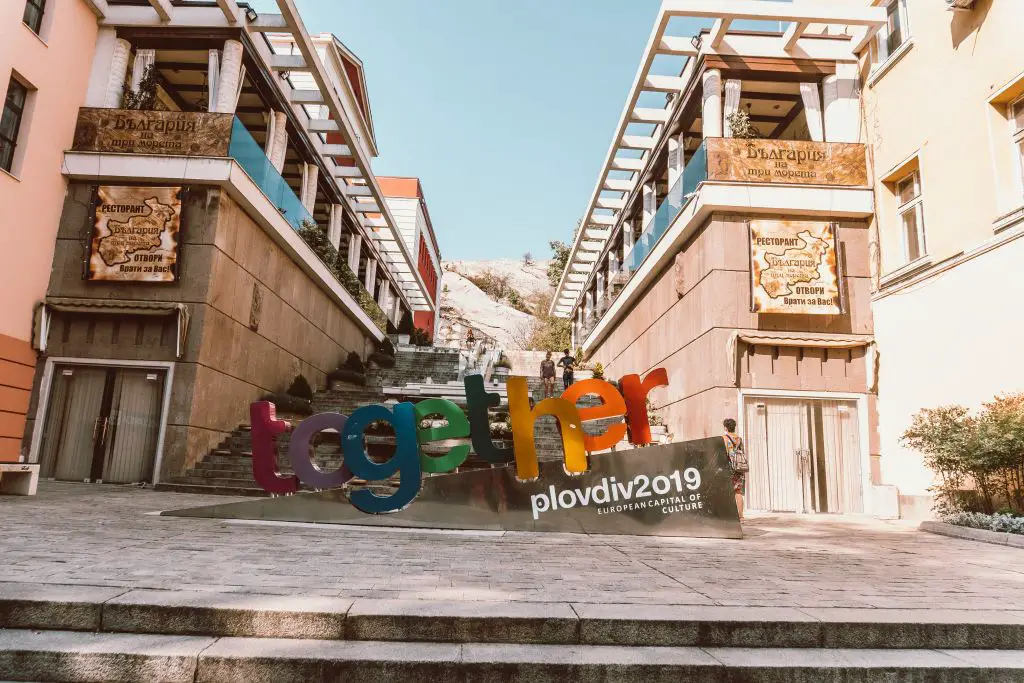
What to do in Plovdiv
Spend your first day in the city exploring its ancient monuments like the aforementioned amphitheatre and the ancient stadium. Wander through the picturesque old town and enjoy the view of the city from the ruined fortress on Nebet Tepe.
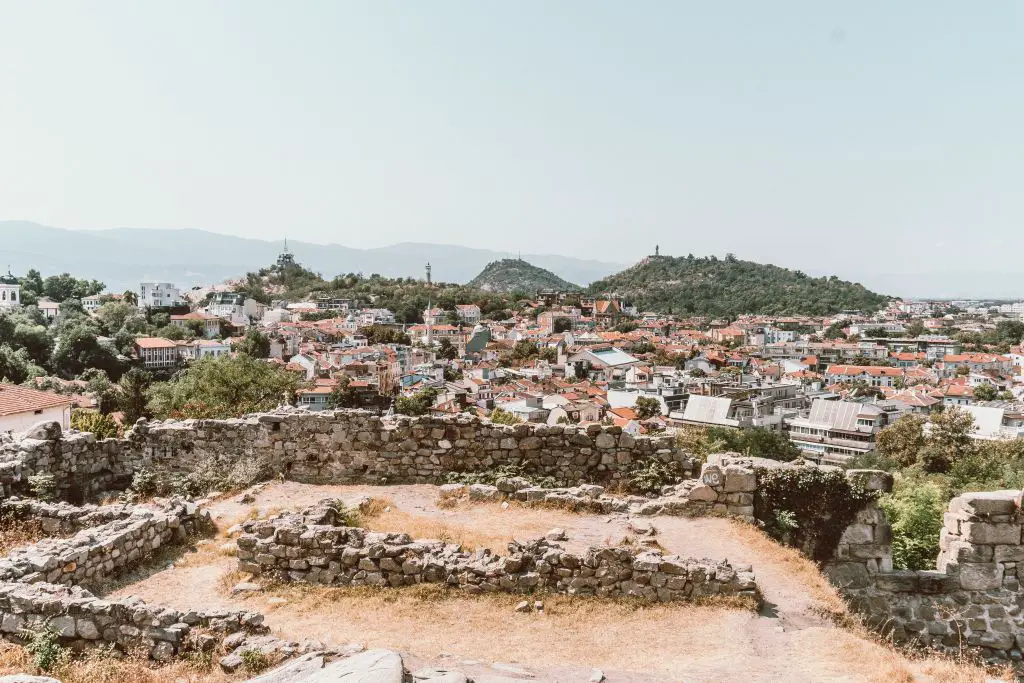
The town center is quite small and you can walk the cobblestone streets from one end to the other in 15 minutes. There are plenty of shops and restaurants along the way to keep you occupied.
You can also head into the trendy neighborhood known as Kapana, which means “The Trap” in Bulgarian. This neighborhood is located within the old town and is made clear by the narrower more windy pedestrian streets. This pedestrian only area is packed full with great restaurants, cafes, and bars. It’s likely that you’ll be spending at least some of your time in this area. I pretty much spent all my time here.
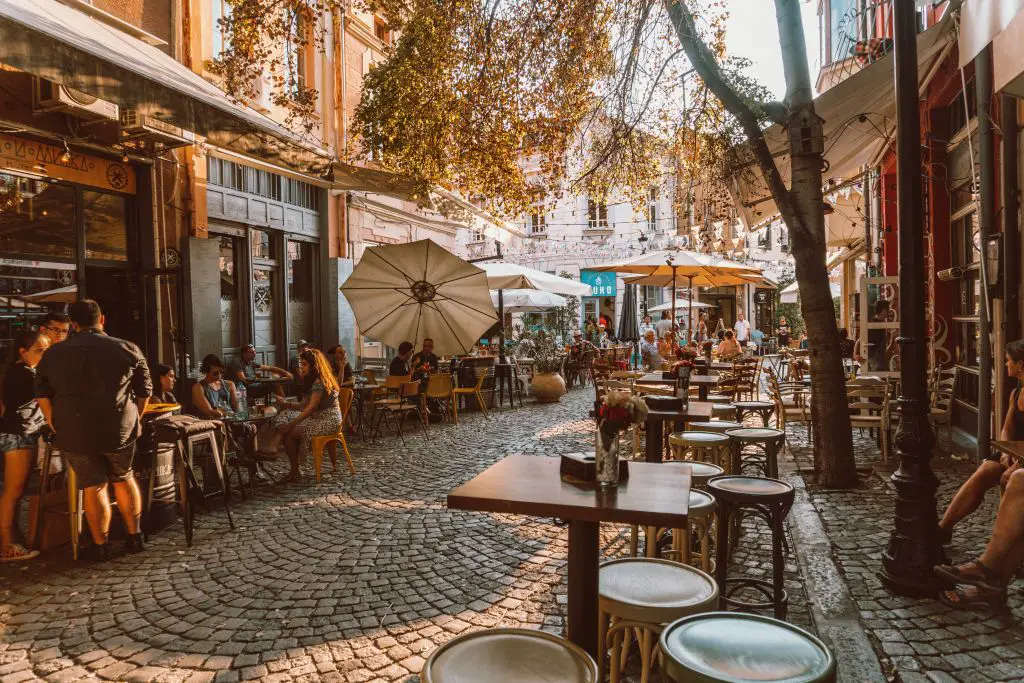
Plovdiv is known as the city of hills – sometimes seven hills after the number of hills in and around the city, and sometimes three hills after the ones Old Plovdiv was founded on. Don’t expect towering peaks – Dzhendem tepe is the tallest at just over 300 metres. If you are interested in Bulgaria’s communist-era monuments Alyosha, the Unknown Soviet Soldier Memorial sits atop Bunarzhik, known as Liberators Hill and the second-highest hill in Plovdiv (at just 108 metres).
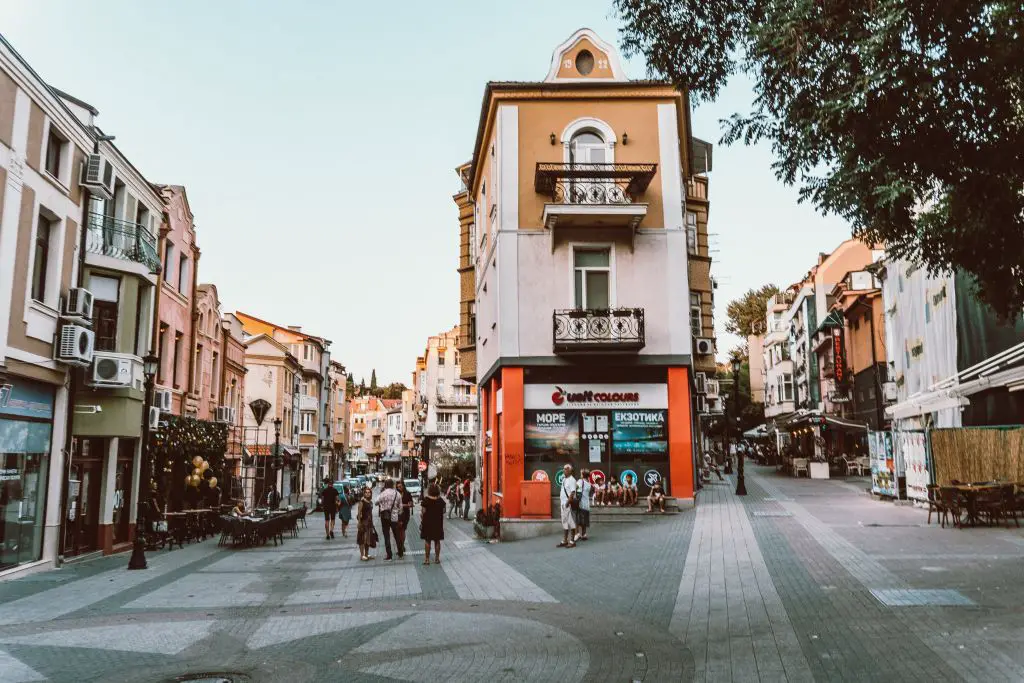
Go on the free walking tour of Plovdiv
Like the free walking tour of Sofia, the Plovdiv tour is definitely a must do for all visitors. I learned a lot about the history of this city which I never would have otherwise. It meets every day at 11am and lasts about 3 hours.
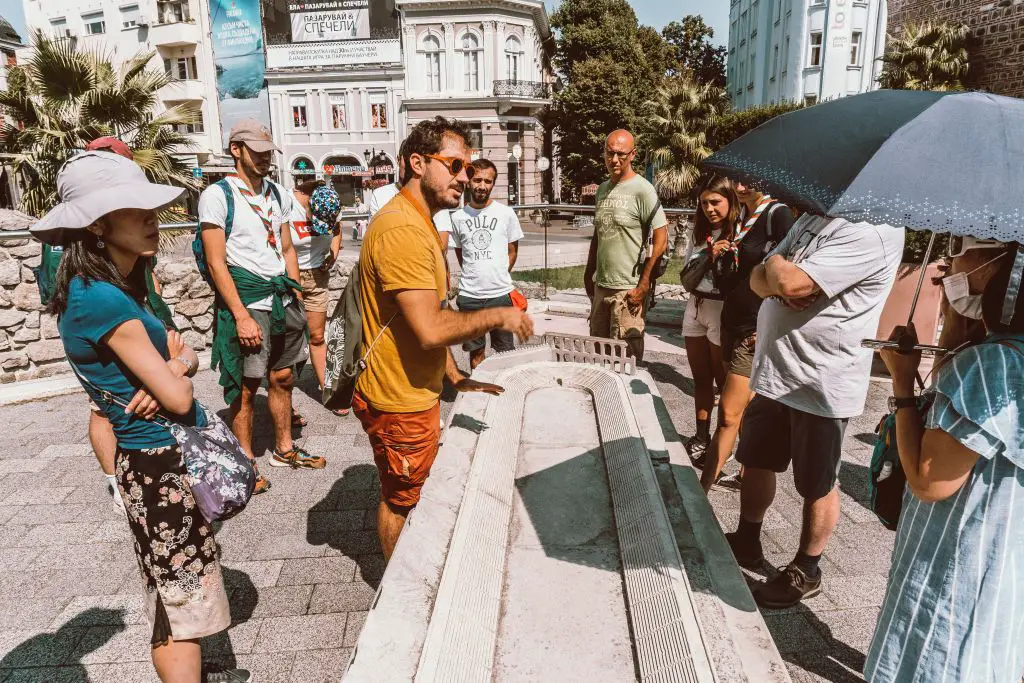
Where to drink in Plovdiv
There are no shortage of places to have a good drink in Plovdiv. Bulgarians love to drink and have a good party so you’re in the right place. For the best bars, you will go to Kapana as there is literally a bar every few meters.
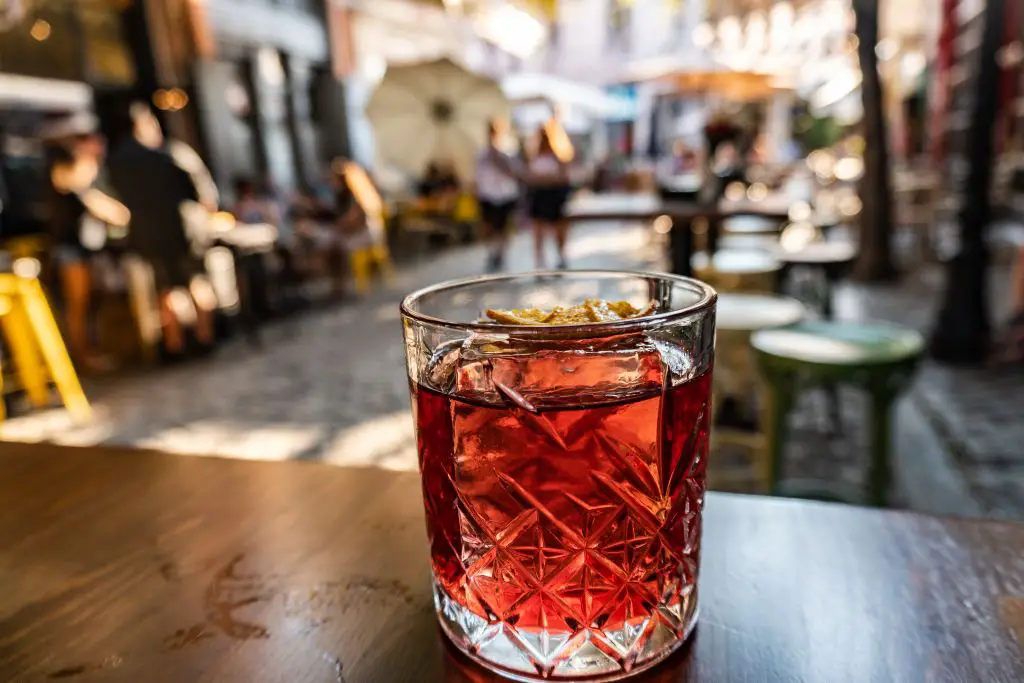
For the best cocktails, go to Anyway Social Bar or The Barber & Cat (only open on weekends). Across the street from Anyway Social Bar is the Cat and Mouse Beer Bar as well as Friends Cafe.
Day 8: Day trip to Buzludzha Monument
Bulgarians will probably be dismayed to hear that the Buzluzdha communist monument is perhaps the coolest thing I saw during my visit. Located at Buzludzha peak in the Balkan mountains, this Soviet era monument looks more like a spaceship or UFO than it does an Earthly structure.
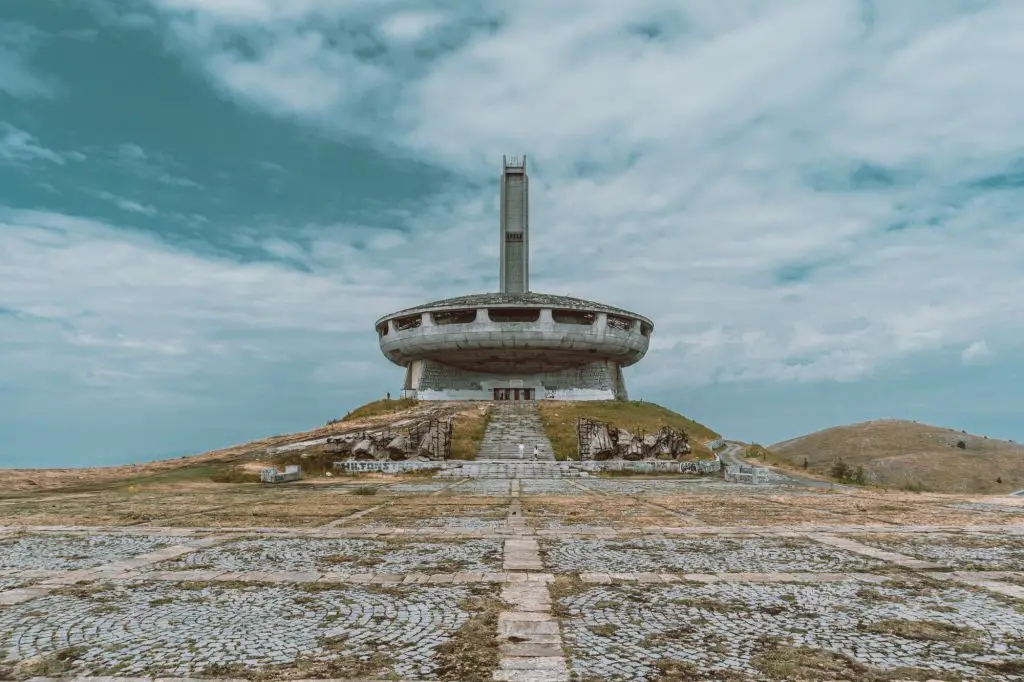
It’s also located in the middle of absolutely nowhere and the nearest towns look more like medieval villages compared to this futuristic building.
What is the Buzludzha monument?
I first saw pictures of the Buzludzha building on my Instagram feed years ago. I thought it was fake at first but after research, found that it very much existed in the countryside of Bulgaria near to the town of Stara Zagora.
The Buzludzha monument was a Soviet monument constructed in the early 1980s. It was built with the futuristic architecture of the time that exemplified all things Soviet. The interior space of the monument featured walls covered in richly detailed mosaics, which illustrated an allegorical history of the Bulgarian Communist Party. Notable scenes depicted space travel, warfare, and communist workers driving their pitchforks into a serpent symbolic of foreign capitalism.
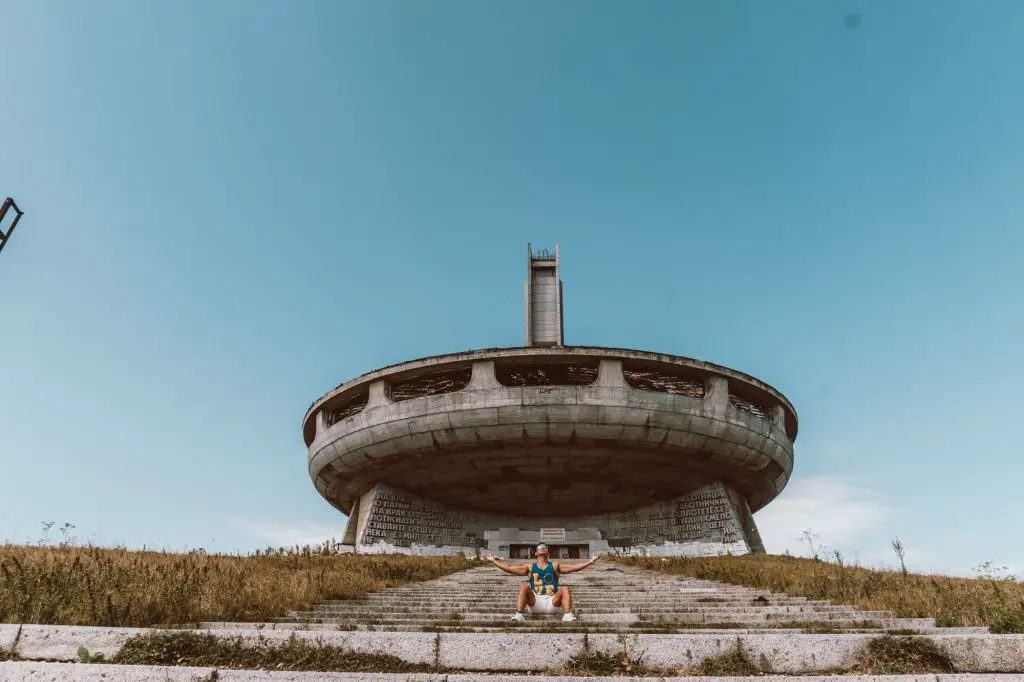
The monument was used for the entire 1980s as a museum dedicated to Communism and an event center for high level gatherings. After the collapse of the Soviet Union in 1989, the monument was abandoned almost overnight. The monument was shut from the public and has been in a state of deterioration ever since. Nevertheless, the facade is still well in place and this is easily the most amazing communist monument of all time.
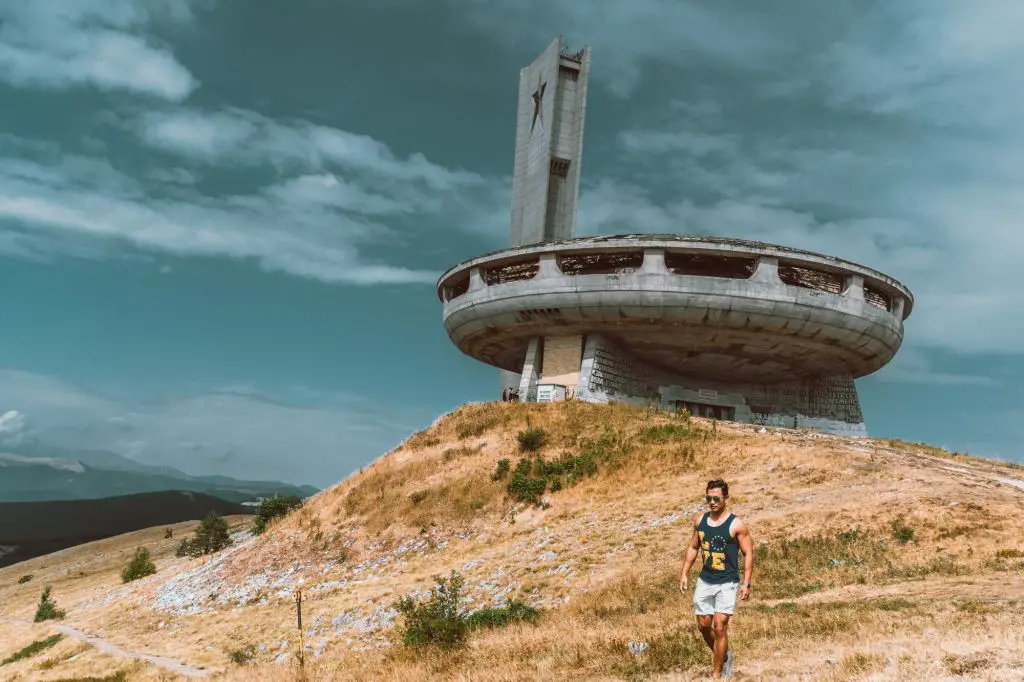
Getting to Buzluzdha
From Plovdiv, it is about 2 hours by car to the Buzluzdha monument. It is located high up in the mountains and a 20 minute drive from the main road up windy mountain roads. There is no way to get here really by public transportation as again, it is located in the middle of nowhere.
However, you can arrange day trips to visit Buzluzdha from Plovdiv but these aren’t as popular as I thought.
Can you go inside Buzludzha?
The pictures of the inside of Buzluzdha are just as impressive as the outside. Filled with beautiful and decaying mosaics from Soviet times, the inside looks like a fantasy movie. It reminded me of the decrepit structures I saw at Chernobyl .

Sadly, as of 2019, it is impossible to enter the Buzluzdha building. It has been completely sealed off and there are no ways to enter unless you have a jetpack or really sophisticated climbing equipment.
Sad I know. You will just have to settle for (amazing) photos from the outside of the building!
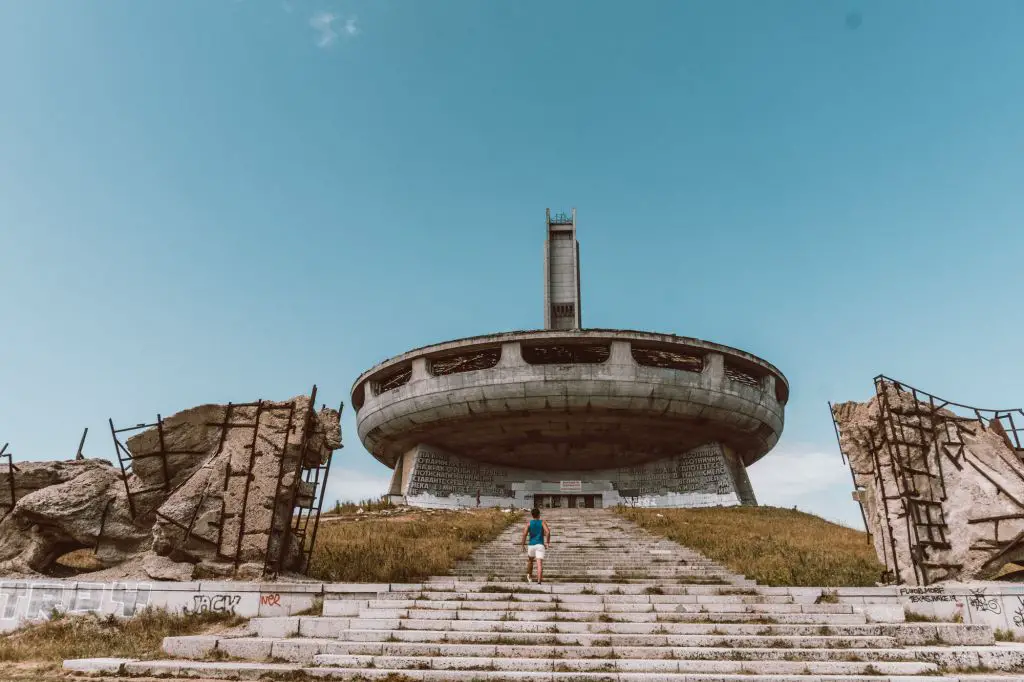
Day 9-12: Black Sea
If you have more than one week for travel through Bulgaria, the next logical step is to head to the coastal towns of the Black Sea!
Bulgaria’s Black Sea towns are beautiful and a great getaway in the summer for the locals. However, let’s be clear that the black sea is not the Mediterranean. It’s not as beautiful and the water is nowhere near as clear as the waters on the Greek islands . If you want the best beaches, drive west to the Ionian islands of Greece .
However, as you’re already in Bulgaria, it only makes sense to keep going and see what else the country has to offer!
Varna is Bulgaria’s main Black Sea seaside resort and port city. I prefer Varna over Burgas as well. Varna’s conventional sights include Varna Cathedral, the ruins of the Roman city of Odessus and the Sea Garden, a park that stretches along the coast. The Sea Garden is also where you can find the Pantheon of the Fallen in the Fight Against Fascism, an impressive monument close to a statue of Yuri Gagarin in the Alley of Cosmonauts. A little further from the town centre is the Park-Monument of the Bulgarian-Soviet Friendship, another must-see for monument-seekers. Varna is a popular holiday spot and although the city has a wide fine sand beach, we’ve never spent much time on it.
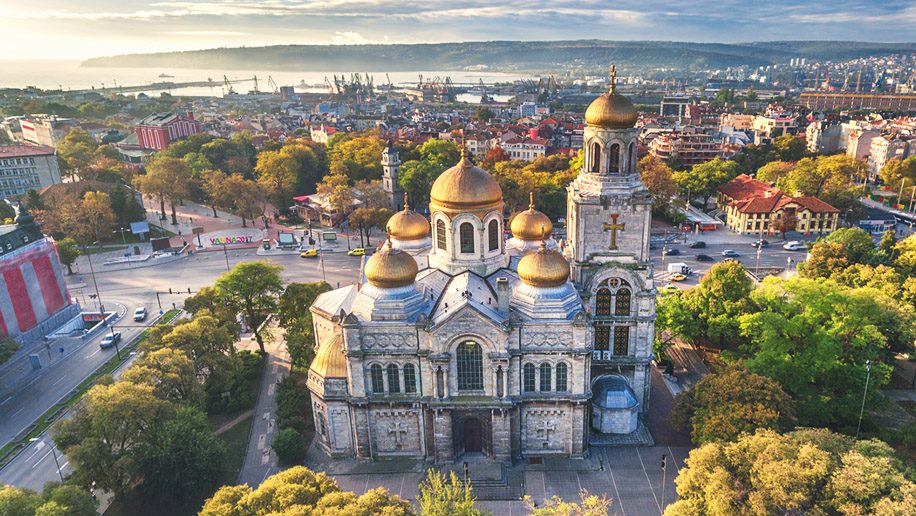
Varna has a few museums but our favourite is the Retro Museum a real blast from Bulgaria’s socialist past. There are all sorts of memorabilia on display including a collection of over fifty cars from the era including Trabant, Moskvich and Volga models. The museum is at the Grand Mall of Varna which is close to the main bus station – it’s a good place to visit if you have time to kill before your bus.
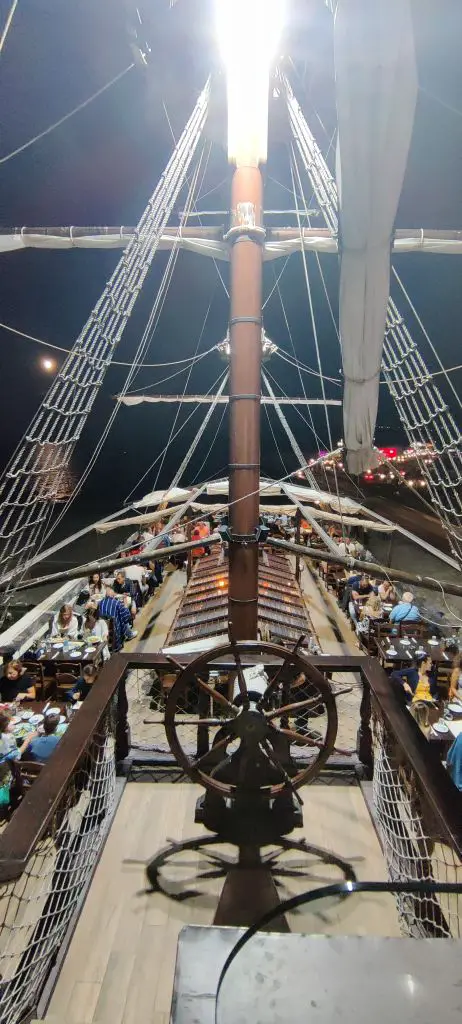
Explore the Black Sea Coast
If you want a smaller, more sleepy seaside town, then head to lovely Sozopol. This town boasts a couple of fine sand beaches, beautiful cobbled streets, and a laid-back atmosphere.
If you want some more western amenities, a party scene, or a high-end beach resort, the head to Sunny Beach or Nessebar which are significantly more touristy and developed than Sozopol.
Bulgaria Itinerary Day By Day
Here is a breakdown of my itinerary on a day by day basis. I’ve created a few examples depending on how much time you have so hopefully this will help you plan your trip to Bulgaria!
One week in Bulgaria
Day 1: Land in Sofia, Sofia for the day Day 2: Full day Sofia Day 3: Day trip to Rila Monastery Day 4: Sofia to Plovdiv Day 5: Plovdiv Full day Day 6: Plovdiv Full day Day 7: Back to Sofia to fly home
Ten days in Bulgaria
Day 1: Land in Sofia, Sofia for the day Day 2: Full day Sofia Day 3: Day trip to Rila Monastery Day 4: Sofia to Plovdiv Day 5: Plovdiv Full day Day 6: Plovdiv Full day Day 7: Plovdiv to Varna Day 8: Black Sea Day 9: Black Sea Day 10: Back to Sofia for a flight out
Continue Reading:
- The Perfect Travel Itinerary For Slovenia: Ljubljana, Lake Bled and More
- Best Places In Europe For Digital Nomads In 2024
- The Ultimate Two Week Travel Itinerary For Turkey
- The Perfect Two Week Itinerary For The Balkan Countries
- The Perfect Moldova Travel Itinerary: Chisinau, Transinistria, And Cricova
- The Perfect Romania Travel Itinerary: Timisoara, Cluj-Napoca, Sibiu, Brasov, Bucharest
- Guide to Visiting Cape Town
- The Ultimate One To Two Week Travel Itinerary For Guatemala
- The Ultimate Piedmont Travel Itinerary And Guide: Italy’s Most Underrated Wine Region
- The Perfect Day Trip Itinerary For The Rheinland Pfalz, Germany
- The Perfect Lebanon Travel Itinerary
- Exploring the Douro Valley: An Epic Day Trip From Porto
- The Perfect Georgia Travel Itinerary: One Week, Two Weeks, Three Weeks Ideas
- The Perfect One Day And Two Day Itinerary for Zurich, Switzerland
Related Posts

The Perfect Sri Lanka Travel Itinerary: One Week, 10 days, and Two Weeks
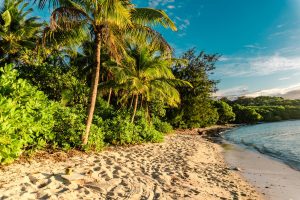
The Perfect Fiji Honeymoon Itinerary: One To Two Weeks

The Perfect Fiji Travel Itinerary: Beaches, Diving, and Island Paradise

The Perfect Vietnam Travel Itinerary: One Week, Two Weeks, and Three Weeks
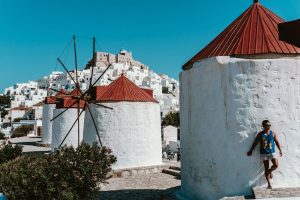
The Perfect Two Week Travel Itinerary For Greece

The Perfect One Week Itinerary For Greece
Leave a reply cancel reply.
Your email address will not be published. Required fields are marked *
Yes, add me to your mailing list
Add Comment *
Save my name, email, and website in this browser for the next time I comment.
Notify me of followup comments via e-mail. You can also subscribe without commenting.
Post Comment
It’s so nice that you visited Bulgaria and made such a great review.Buzludha monument is near to town Kazanlak which is very popular as the Valley of roses and Thracian kings(it’s not big and maybe not beautiful but the history and culture are impressive for tourists).There are lavender fields too. Also you should have visited the Russian Church of Shipka and the Monument Shipka. And in Bulgaria there are many many historical and natural places you can visit. I hope you can come back and really discover more of this country.
Hi Kristiana, I just googled the Shipka monument and it looks amazing! Sad I didn’t know about it when i was there. Definiteyl will be back. Quite easy for me to get to sofia/Plovdiv!
Awesome review! Thanks a lot. One of the last countries in Europe I haven’t explored yet. Such a shame indeed Buzluzdha building can’t be visited from the inside anymore.
Thanks Chris! Hope you enjoy Bulgaria whenever you go. Buzluzdha still amazing however when from the outside!

Navigate forward to interact with the calendar and select a date. Press the question mark key to get the keyboard shortcuts for changing dates.
Navigate backward to interact with the calendar and select a date. Press the question mark key to get the keyboard shortcuts for changing dates.
Bulgaria Trip Planner
Top destinations in bulgaria.

Top attractions in Bulgaria

Other notable attractions

Explore nearby places
- Sapareva Banya
All related maps of Bulgaria
- Map of Bulgaria
- Map of Sofia
- Map of Bankya
- Map of Marchaevo
- Map of Pernik
- Map of Slivnitsa
- Map of Svoge
- Map of Negushevo
- Map of Alino
- Map of Breznik
- Map of Vakarel
- Map of Belchin
- Map of Samokov
- Map of Botevgrad
- Map of Sapareva Banya
- Map of Ihtiman
- Map of Madzhare
- Map of Dupnitsa
- Map of Lyutibrod
- Map of Zemen
- Map of Borovets
- Map of Chelopek
- Map of Pravets
- Map of Tran
- Map of Etropole
- Map of Mezdra
- Map of Vratsa
- Map of Poganovo
- Map of Berkovitsa
- Map of Kostenets
- Map of Slavinja
Bulgaria throughout the year
- Bulgaria in January
- Bulgaria in February
- Bulgaria in March
- Bulgaria in April
- Bulgaria in May
- Bulgaria in June
- Bulgaria in July
- Bulgaria in August
- Bulgaria in September
- Bulgaria in October
- Bulgaria in November
- Bulgaria in December
Q&A about Bulgaria
Add places from guides with 1 click, collaborate with friends in real time, import flight and hotel reservations, expense tracking and splitting, checklists for anything, get personalized suggestions.
4.9 on App Store, 4.7 on Google Play

- Bulgaria Travel Tips
Why Bulgaria? Bulgaria is a country in southeastern Europe. While it may not be as well-known as a tourist destination, there is plenty to do and see.
With its beaches, mountain huts, hearty food, historical monasteries, beautiful cathedrals, and Roman ruins, Bulgaria has a lot to offer.
This Bulgaria travel guide will help you plan your next vacation.
Popular Guides
- Places to Visit in Bulgaria
Our Highlight
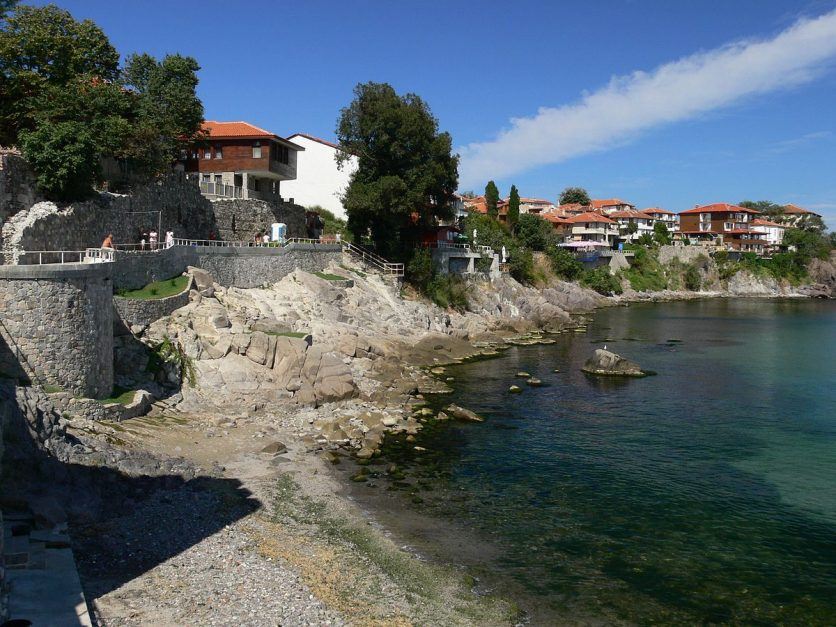
Table of contents
Table of Contents
Fast Facts about Bulgaria
- Power voltage is 230V at 50 Hz.
- The official currency is the Bulgarian lev and 1 lev is equal to 0.57 USD.
- The best way to get around is by car.
- To enter, you will need a U.S. passport valid for three months after entry.
- You do not need a visa if your stay is under 90 days.
- Vivacom, M-Tel, and Telenor are the most popular mobile providers. A prepaid SIM card can be purchased through either of them.
- The sales tax rate is 20%, with a reduced rate of 9% for hotel services.
Things to See and Do in Bulgaria
- Come explore the largest public park in Bulgaria . Located in Varna, the park includes beautiful gardens, a zoo with tigers, kangaroos and bears, and an aquarium.
- National Historical Museum: Come see the largest museum in Bulgaria. Featuring a vast collection of 650,000 historical items, there is plenty to see and learn here about Bulgarian history.
- Alexander Nevsky Cathedral: One of the largest Eastern Orthodox cathedrals in the world, come explore this majestic cathedral in Sofia.Dating back to 1912 and reaching heights of 148 feet, this cathedral holds numerous mosaics, murals, and royal thrones, as well as an Orthodox museum.
- Come see these Roman ruins. Built in the 2nd century AD, these ancient thermal baths were how the Romans once bathed.The third largest Roman ruins complex in Europe, the roman baths are a fascinating glimpse into the past.
Bulgaria Travel Guides
- 10 Places to Visit in Bulgaria This Year
Accommodation
Budget – You can find prices for a hostel for about 18-22 leva. Enjoy dorm-styled or private rooms, free breakfast, storage lockers, and great locations in the city.
Mid Rang e – For mid-range hotels, expect to pay between 60-80 leva per night. Stay in private rooms, workout at the fitness center, dine at the hotel restaurant and bar, and swim in the pool (indoor or outdoor).
High End – Upscale hotels will range from 150-300 leva per night. Take in the best with top-of-the-line service, polished guest rooms with minibars and refrigerators, room service, multiple restaurants and a nightclub, babysitting services, outdoor pools with a pool bar, and more.
Check out our favorite booking platforms Booking.com , Tripadvisor and VRBO for the best deals on accommodation in Australia
Food : The cuisine of Bulgaria favors vegetables, dairy, meat like pork or chicken, seafood, and spices as staples. Shopska salad (tomato and cucumber salad with Bulgarian feta cheese) and tarator (cold yogurt soup) are popular dishes.
If you’re out for breakfast or want a treat, try a banitsa, a pastry with cheese and yogurt. Expect to pay around 10-20 leva per meal for an average restaurant or 30-50 leva for high-quality restaurants.
The Best Ways to Get Around Bulgaria
Getting to bulgaria:.
Getting to Bulgario: The Sofia International Airport is the main airport and is just 6 miles from the center of Sofia, Bulgaria’s capital. Other major cities like Varna and Plovdiv also have their own airport, though only Varna takes flights from the US.
Flights: You can check for the best flights on Skyscanner
Transportation:
Train: Trains, especially overnight trains, are a good way to get a more scenic view of Bulgaria.There are three types of trains express (ekspresen), fast (barz) and slow (patnicheski). Go from the capital Sofia to Varna in 7.5 hours for 25-30 leva.
Buses : Buses are a cheap way to get around and can be found throughout major cities and towns. Fares start at about 1 lev.
Metro: Sofia has its own metro that travels throughout the city, with speeds up to 50 miles per hour. Prices start at 1.60 leva. The metro operates from 5 AM to midnight, with new trains arriving every 7-14 minutes.
Taxis / Uber : Taxis are an alternative way to get around. Most taxis have meters, though rates will vary. You can find taxis with a starting fee of 0.70-0.80 lev and a meter of 0.70 lev per kilometer traveled. Take a taxi from the airport to the city center of Sofia, for example, for about 15 leva.
Car Rental: To rent a car, you need to be at least 21 years old and have a U.S. license as well as an International Driver’s Permit. Prices average around 60 leva per day.
You can also compare prices here
When to go To Bulgaria
The best time to visit is right before or after the summer (April-May or September-October).
In these months, you can find lower prices while still having pleasant weather (about 70-75 degrees Fahrenheit for spring, 65-70 degrees Fahrenheit for autumn) for outdoor activities.
If you are going to Bulgaria to ski, then December-February is the best time, though note that some of the smaller towns will be shut down during this time.
Where to Stay in Bulgaria
Les Fleurs Boutique Hotel : Stay in this trendy four-star hotel in the capital of Sofia. Attractions like the National Palace of Culture and the Alexander Nevsky Cathedral are both just a short trip away. Once you’re done exploring, come back to relaxed rooms with minibars and flat screen TVs, complimentary breakfast, and the hotel’s restaurant.
Ramada Plovdiv Trimontium : Stay in the heart of Plovdiv at this great four-star hotel. Great attractions like the Plovdiv Roman Theater and the ruins of Nebet Tepe are just a 15-minute walk away. The hotel comes with free breakfast and Wi-Fi, an outdoor pool, and a casino.
Grand Hotel Varna : Be right by the Bulgarian Black Sea at this all-inclusive 5-star hotel in Varna. Stay in great rooms with balconies and sea views, head to the gym, swim in the outdoor pool, relax on the private beach, and dine at one of the 3 restaurants. Nearby attractions include the Sea Garden, the Aladzha Monastery, and Evxinograd, the 19 th -century palace.
What to Pack for Bulgaria
- Power Adapter: As the voltage is higher than the US, a power adapter will ensure all of your electronics can be charged properly.
- Walking Shoes: Keep your feet comfortable with a sturdy pair of walking shoes.
- Modest Clothing: If your trip itinerary includes going to monasteries, make sure to bring clothes that cover your knees and elbows
See our packing tips: packing tips
Bulgaria Travel Guide: Best Booking Resources
Whenever we travel to we make sure to start with these companies. We have tried a lot of different ones over the years and all of these have consistently proven to be the best when it comes to offering great prices.
We have used every one of these personally and continue to do so.
- Booking.com : This is our go site to when comparing prices for accommodation. It usually has the cheapest prices, especially in Europe and we love their interface. Not to mention you get free cancellation and you are guaranteed the best price.
- Trip Advisor : What we like about Trip Advisor is that we can look at all the reviews and then book our accommodation. TripAdvisor is where we go when we want to compare prices with multiple accommodation providers.
- VRBO : is the main search engine we use when we are looking for a home or apartment rental. It can sometimes be cheaper than hotels and it is the best way to stay in areas that offer a more local feel.
- Hostelworld : With one of the largest databases of hostels in the world, Hostelworld is the go-to site when you are looking for budget accommodation.
- Skyscanner : This is the first place we check for flights. It consistently comes back with the cheapest and best options. It allows us to compare a lot of airlines to get the best price.
- Rome 2 Rio : If you want to see how to get somewhere by plane, train, bus, ferry or car Rome2Rio lays it all out for you as well as related costs.I love how they show it all to you on a Google Map and it works offline.
- Get Your Guide: For all your day trip and city guide needs, we use Get Your Guide. It has the world’s largest collection of things to do with more than 30,000 activities in 7500 destinations.
- World Nomads Insurance: When traveling to Italy you should always have travel insurance. We have found the best bang for your buck is by far World Nomads.
Bulgaria Travel Guide: Related Articles

Bulgaria Travel Guide: Top Tips for Planning Your Visit
Planning a trip to Bulgaria? Great idea! This Bulgaria Travel Guide will help you do just that.
Bulgaria is a diverse country. Located in the southeast of Europe, between Romania, Serbia, Macedonia, Greece, Turkey, and the Black Sea, it holds beautiful historical cities, the rather grey capital of Sofia, the party coastal town which is also UNESCO World Heritage Nessebar and the Balkan Mountain Range splitting the country in half.
It's a founding member of the Organization for Security and Co-operation in Europe (OSCE) and a member of the European Union, NATO, and the Council of Europe.
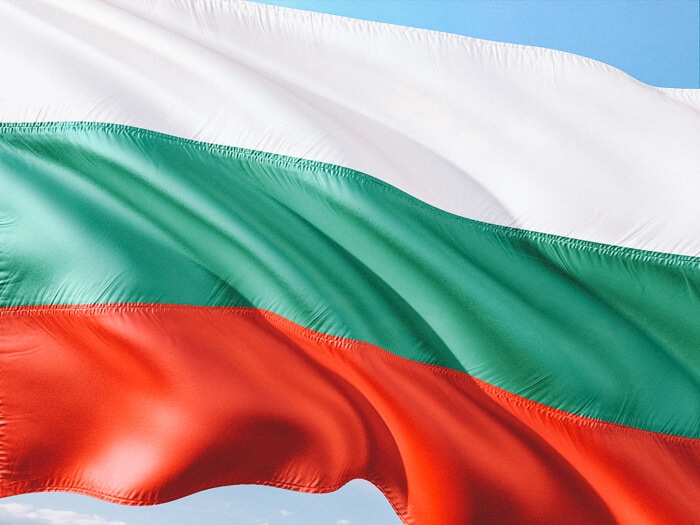
Check out this guide to plan your own Bulgaria holiday.
Bulgaria travel guide: quick facts
1. blagoevgrad, 6. kardzhali, 7. kyustendil, 10. pazardzhik, 13. plovdiv, 14. razgrad, 17. silistra, 19. smolyan, 20. sofia city, 21. sofia (province), 22. stara zagora, 23. targovishte, 25. veliko tarnovo, entry and exit requirements, independent travel around bulgaria, what to pack for bulgaria in summer, what to pack for bulgaria in winter, what to pack for bulgaria in spring and fall, the best time to visit bulgaria, what to eat in bulgaria, 10 events in bulgaria you can't miss, public holidays in bulgaria, cultural customs to be aware of in bulgaria, best places to stay in bulgaria, don't forget travel insurance, basic phrases and their pronunciation, is bulgaria safe to travel to, the use of cash and cards in bulgaria, calling abroad, wifi and data use in bulgaria, tipping in bulgaria, posts about bulgaria.
Size: 110,994 km² or 42,855 sq mi
People living there: more than 7,050,000
Capital: Sofia
Governmental structure: unitary parliamentary republic
National day: March 3
Time zone: Eastern European Time / UTC+2 / GMT+1
Currency: Bulgarian lev
Power voltage and socket type(s): 230V, plug types F and C. If these don't match with your devices, make sure to bring a universal adapter .
Official religion(s)/Freedom of religion: Freedom of religion. 60% of the population is Christian, followed by non-believing citizens, and Muslims.
Official language(s) and general knowledge of English: Bulgarian is the official language. Basic English is widely spoken in urban areas.
Drives on this side: right
International driver's licence accepted? yes
Phone code: +359
Can you drink tap water in Bulgaria? yes
Vaccinations needed? no
Want more quick facts about Bulgaria? This post is a list of cultural, historical, funny and other facts about the country.
Bulgarian provinces
Bulgaria has 27 provinces, or 28 if the capital Sofia is counted separately, of which none have an official name. There’s a lot of diversity between provinces. Those in the south are home to the beautiful Rhodope Mountains, whereas the Black Sea coast is home to the big cities of Varna and Burgas and some exceptional seafood.
Tourists traveling to the northwest of the country should be aware that it’s officially the poorest region in the EU and that they will see abandoned villages and extreme poverty. The provinces are usually referred to mentioning their provincial capitals. These are:
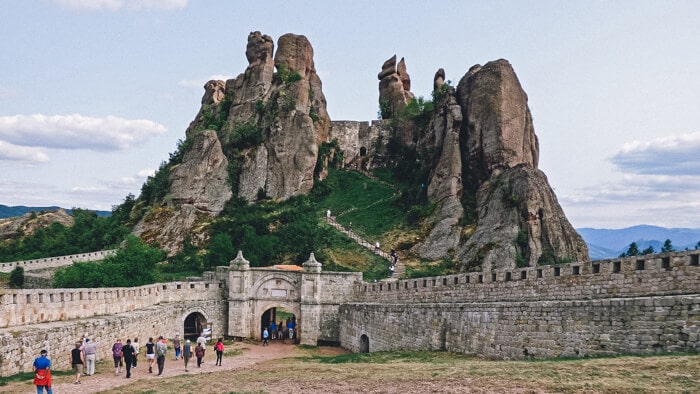
Kardzhali is famous for its Thracian ruins, which can be found throughout the province. There are also a number of unusual rock formations in the province including the Petrified Wedding, the Womb Cave, and the Stone Mushrooms.
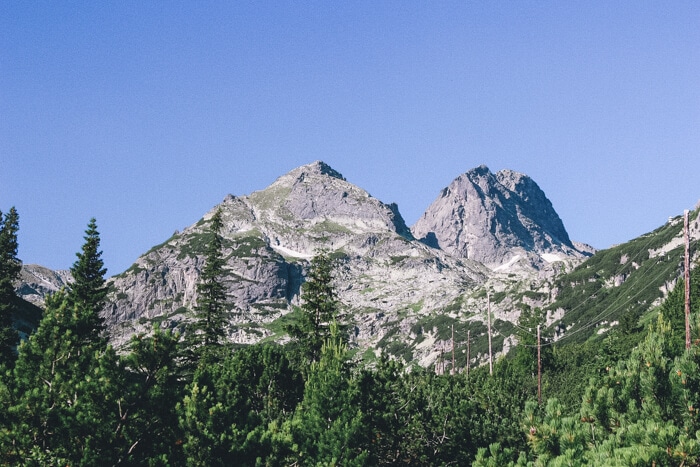
Montana is a region in the northwest of the country. Founded as a fortress on the Ogosta River in Roman times, the Montana Dam is a popular Bulgaria destination which offers sports, fishing, and water tourism.
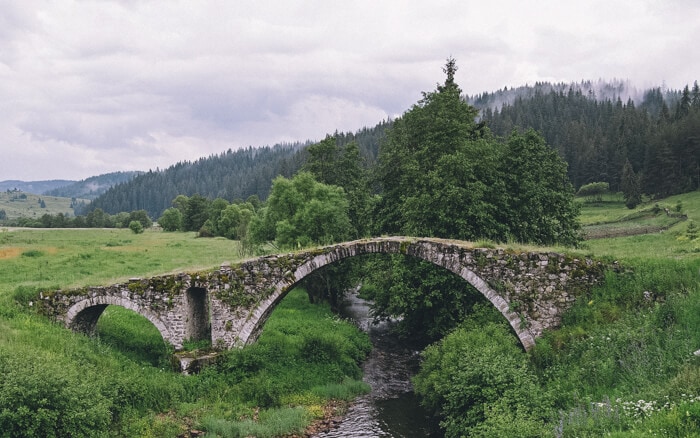
Pernik is a region which is best-known for its mining economy. So much so, that the only mining museum on the whole of the Balkan peninsula is located here. There are also a number of cultural sites including fortresses and Thracian temples.
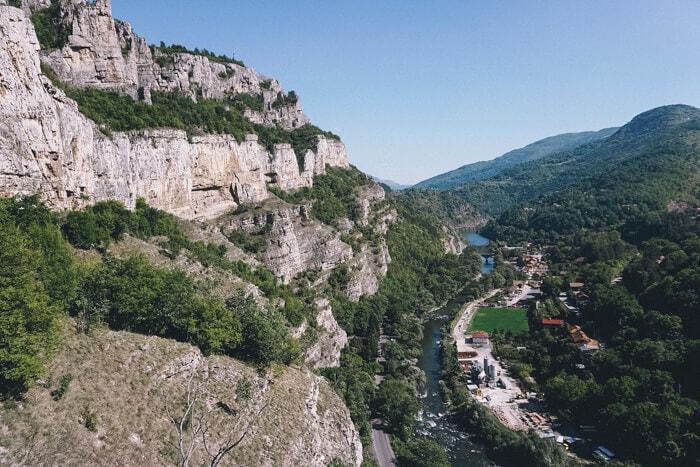
Razgrad sits upon important roads used in ancient times for crossing between Central Europe, the Black Sea, and Asia. Because of this, there’s a mix of architectural influences in the region’s capital, including the Ibrahim Pasha mosque and the city’s clock tower.
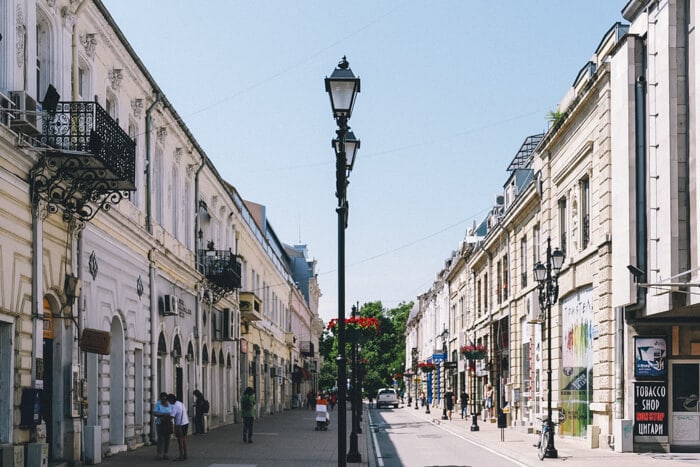
Smolyan is said to be in the most beautiful part of the Rhodope mountains, where the mythological singer Orpheus is said to have tamed the beasts of the mountains with his songs. There are a huge number of natural landmarks including the Wonderful Bridges, the Devil’s Throat, and the Uhlovitsa and Yagodina caves.
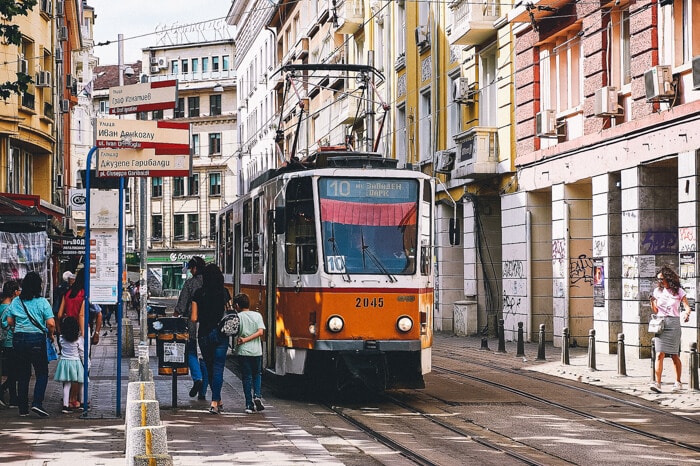
Vidin is the most north-westerly region of Bulgaria. There are a number of famous sights both natural and man-made in this small region, including Chuprene biosphere reserve, the Belogradchik Rocks, and ancient castles in Kula, Chichil, Florentine, and Topolovets.
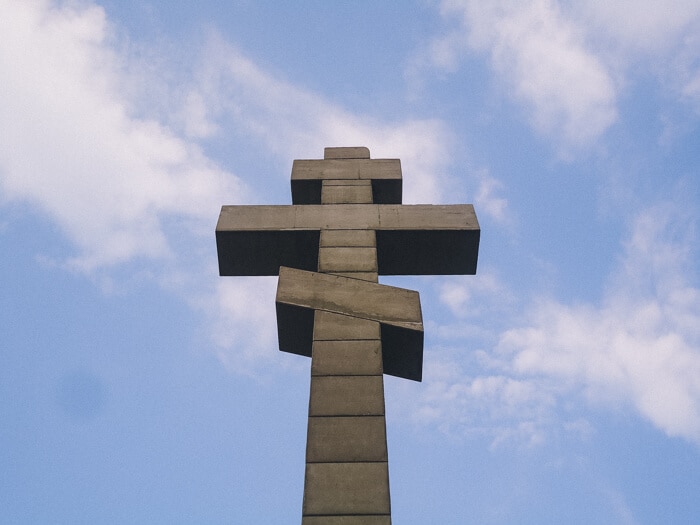
Yambol is a plain and hilly region, which shares a border with Turkey. Due to its proximity to Turkey, there are many sites where you can learn about the whole country’s struggle against the Ottoman Empire. The region is steeped in folklore, and there are regularly singing competitions and folkloric competitions in Yambol.
As you can see, there are plenty of things to do in Bulgaria but first, you need to get there…
How to travel to Bulgaria
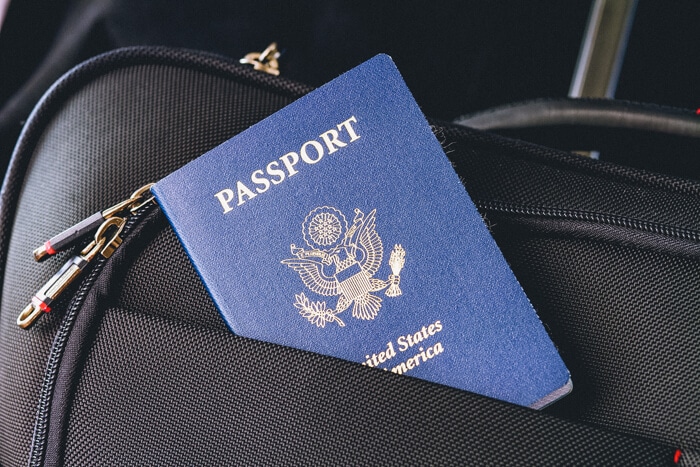
Citizens from the United States and the rest of the world do not need a visa for a stay of up to 3 months, but their passports must have at least 6 months validity remaining.
Transportation
When entering Bulgaria via land, there can often be long delays at border crossings, especially when you use public transport but also when you come by car. The longest delays tend to be at the Turkish border. Driving to Bulgaria can, therefore, be a bit of a hassle.
There are several international bus companies operating in all of the countries which share borders with Bulgaria. Most arrive in Sofia, but some will go directly to Plovdiv. When traveling in or out of Bulgaria, should you need a visa, the cost of this is not included in the bus ticket. There are usually long delays at border crossings, and you’ll have to either get off and present your passport or border officials will board your bus.
Flixbus offers cheap bus travel to Bulgaria.
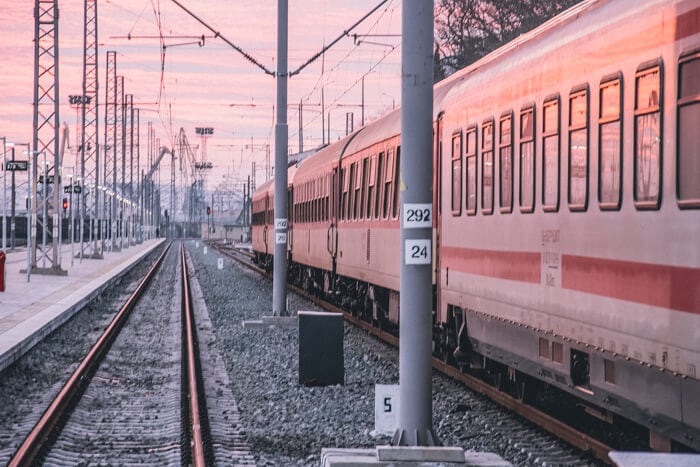
Check here for train routes and prices from within Europe.
There are two ferry services across the Danube for border crossings from Romania: Calarasi – Silistra and Bechet – Oryahovo.
Very few tourists leave or enter Bulgaria via the Black Sea. However, it is possible to travel from Varna to Ukraine/Georgia or vice versa with Navibulgar, who offer a passenger service onboard their cargo ships.
Bulgaria has a small number of international airports, with the most flights to Bulgaria going to the airport of Sofia. The majority of direct flights are to other European cities, although there are some to the middle east too. The other international Bulgaria airports are Varna, Plovdiv, and Burgas.
Check Skyscanner for a clear overview of your flight options and the best prices. Skyscanner lets you set flight alerts and shows you which month the prices are lowest. Very handy!
How to travel around Bulgaria
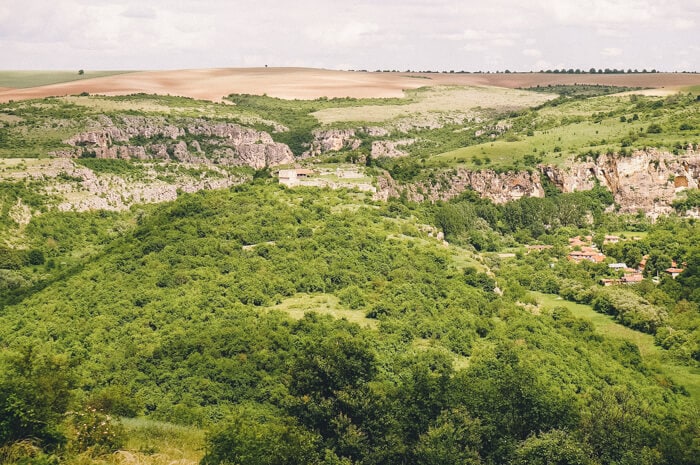
Thanks to more and more tourists going on vacation to Bulgaria in recent years, the infrastructure of the transport system has been updated regularly, and although the standards may not be as high as those in more developed European countries, it’s an easy and relatively inexpensive country to travel around.
Travel in Bulgaria and you'll find that buses are the most reliable mode of public transport to use, as services run between big cities, but also to small towns and villages throughout the country. Sometimes it’s a lottery whether or not you’ll get a comfortable and modern bus!
In the summer, some of the towns on the east coast are connected by ferry.
In terms of private transport, driving in Bulgaria is not for everyone. Bulgarians are known to drive aggressively, but you must keep a cool head, as road rage induced fights are not uncommon. Try to stick to main roads where possible too. Potholes plague Bulgarian roads, and some country backroads are almost impassable.
On the other hand, a rental car does offer you the most flexibility to go where you want to go, when you want to go there. For a good overview of prices, check here .
Lastly, if you’re driving your own car rather than a rental, you must have a vignette sticker to be legally driving here. These are easy to obtain and sold at all border crossings, petrol stations, and post-offices. They cost 15 lev for a week or 30 for a month.
What to pack for Bulgaria
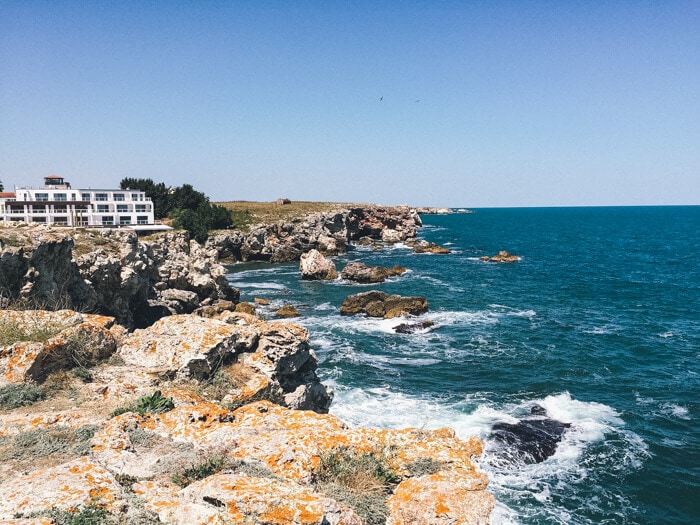
In summer, it can reach up to 40 degrees inland, whereas, in the winter, cold air from Russia can bring heavy snowfall, severe frosts, and strong winds.
- light clothing
- good walking sandals
- a reusable water bottle
- a warm and waterproof coat
- comfortable waterproof shoes
Late fall and early Spring can feel like winter while late Spring and early winter can feel like summer. These are shaky seasons and it's best to come prepared for big weather switches. Layer up and make sure to bring a waterproof coat and comfortable shoes.
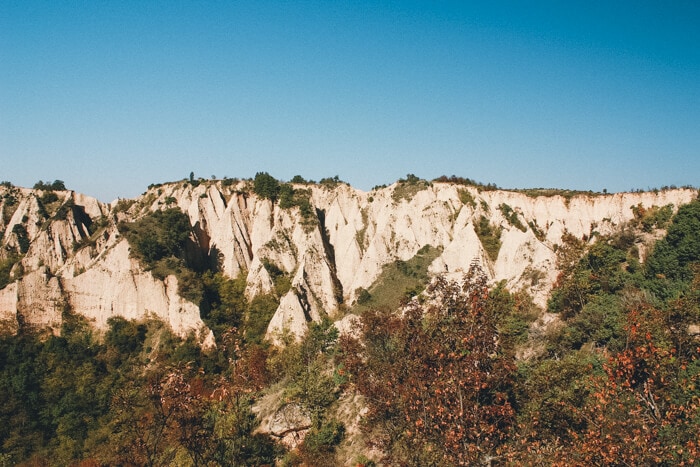
Beach holidays to Bulgaria are best taken between July and August when the high temperatures are tempered by a cool breeze from the Black Sea. However, if you’re traveling inland, it can get extremely hot at this time of year – up to 40 degrees Celsius.
For skiers, the regular season is usually from December to April. However, heavy snowfall means that winter sports are possible until June at some resorts.
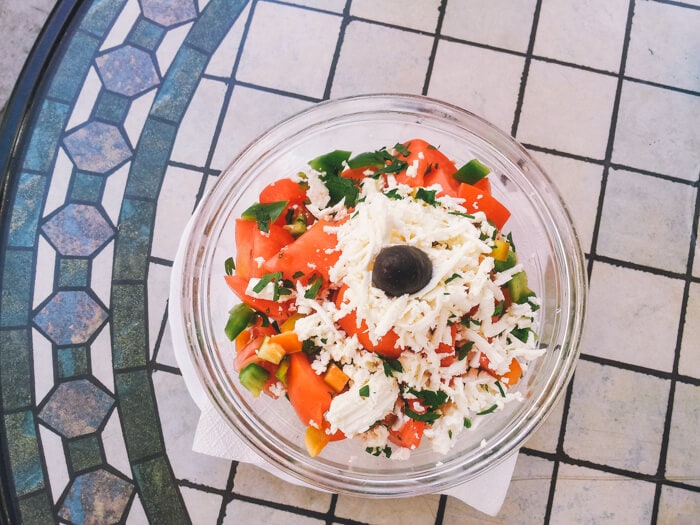
Shopska salad – The shopska salad is like a traditional Greek salad, but with soft Bulgarian cheese sprinkled over the top instead of feta.
Shkembe – A traditional tripe soup that consists of paprika, milk, and oil.
Tarator – A cold cucumber soup topped with yogurt, garlic, oil, walnuts, dill, and water. It’s often eaten in summer.
Lozovi Sarma – Minced meat, herbs, yogurt, and rice, all wrapped up in a vine leaf. Delicious!
Gyuvech – Actually, the name of the pot it’s cooked in, is a hearty stew consisting of beef, mushrooms, peppers, onions, and paprika. It’s often topped with a fried egg and/or cheese.
Moussaka – there are many variations of moussaka across the Balkans. Bulgaria’s moussaka relies on potatoes as a base, rather than aubergines (eggplant).
Kebapche – A variation on the traditional Turkish kebab, the Bulgarian version is set apart as sirene, a white cheese, is grated over it.
Kiselo Mlyako – This thick and sour yogurt is served alongside Bulgarian main courses. It’s good for keeping your gut healthy.
Baklava – Another food that is found across the Balkans and into the Middle East. Bulgarian Baklava is a filo pastry that's a bit less sugary than its Turkish counterpart.
Tikvenik – A tasty pastry dessert filled with pumpkin. There are also walnuts, orange zest, cinnamon, and nutmeg in there. &bsp;
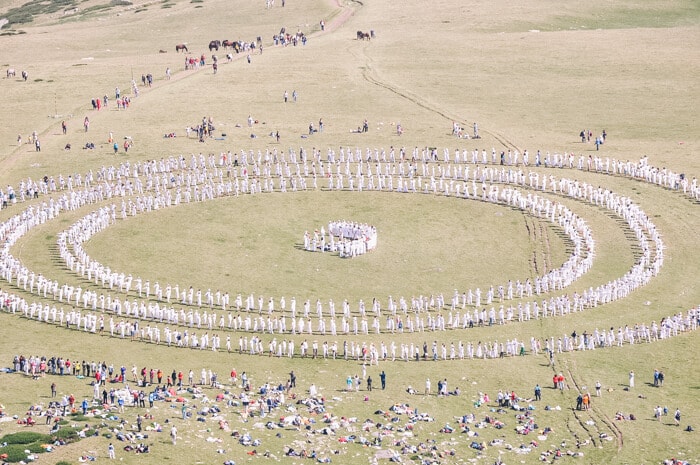
- the Rose Festival in Kazanlak and the Rose Valley
- Kapana Fest in Plovdiv
- Nestinartsvo, the Barefoot Fire Dance, in various villages in the Strandzha Mountains. The most popular one is in Bulgari
- Opera in the Park in Sofia
- Fesitval of Folk Art “The Magic of Rila Mountain” in Borovets
- Bourgas Sand Sculptures Festival
- Hills of Rock in Plovdiv
- the Bagpipe Contest in Gela
- Bansko Jazz Fest in Bansko
- Apollonia Festival of Arts in Sozopol

- New Year's Day
- Liberation Day (March 3)
- Orthodox Good Friday
- Orthodox Holy Saturday
- Orthodox Easter Sunday
- Orthodox Easter Monday
- Labor Day (May 1)
- St George's Day (May 6)
- Culture and Literacy Day (May 24)
- Unification Day (September 6)
- Independence Day (September 22)
- Christmas Eve Day
- Christmas Day
- Second Christmas Day
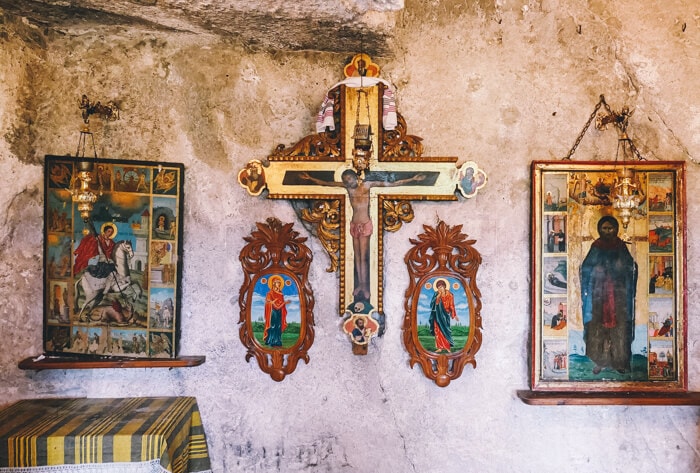
If you’re offered a chocolate from a box for any reason at all, take one, congratulate the person, and smile. Eating the chocolate is a form of congratulations and it’s offensive to say no.
Also, don't be surprised when people barely smile. It's not a sign of unfriendliness, I learned when I was there. Read more about this here .
Booking.com is my go-to site for booking hotels and guesthouses. It has a bunch of filtering options so I can easily get a list of only the hotels that meet my criteria. If you're looking for accommodation in Bulgaria, I highly recommend you check there .
Sometimes I rather stay in an apartment and to find one, I use Airbnb.
Plan for the best, prepare for the worst. Travel insurance has you covered in case (part of) your trip gets canceled, you get sick or hurt abroad, and sometimes even when your electronics break or get stolen. I always make sure I'm covered every trip I go on.
Don't have travel insurance yet? Check out SafetyWing. They offer super flexible plans that you can even sign up for while you're already on your trip. On top of that, they were the first travel insurance to cover COVID, and when I got COVID, they reimbursed all of my expenses without making a fuss. Their customer support team is great and I can personally recommend them.
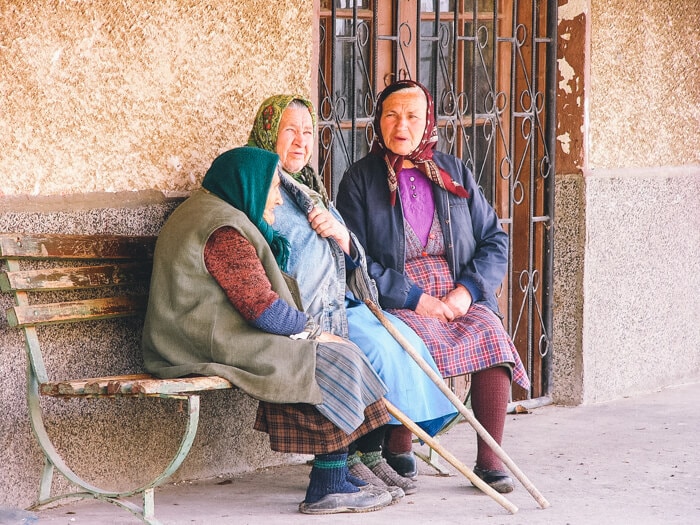
So how safe is Bulgaria? Well, Bulgaria is a very safe country that is peaceful and generally safe for travel. Like most European countries, the most common crimes you’re likely to face are pick pocketing or tourist scams. These are just as you would find in other European cities, so keep alert when you’re out and about, especially in tourist areas.
Unfortunately, a problem that is prevalent across Bulgaria is corruption. Every year, 14 – 22% of the country’s GDP is unaccounted for, meaning that services covered by the taxpayer, such as healthcare and education systems, state administration, and infrastructure, suffer. It’s unlikely to affect you directly as a traveler, but there’s a small possibility that you need to use any of these services during your trip.
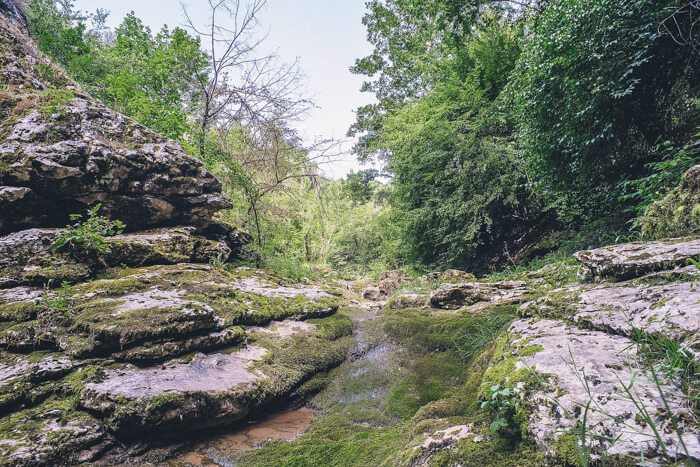
Taxi drivers are known to try and scam tourists, and a police officer might stop you and ask for a bribe if they notice you crossing the speed limits.
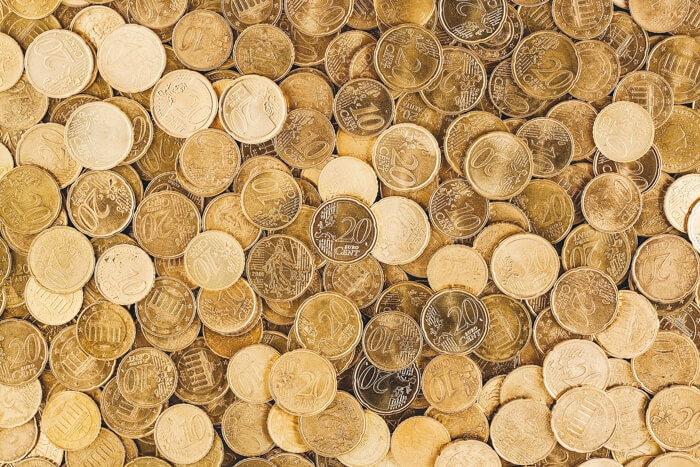
In major cities and tourist areas, you will have no problem finding an ATM. However, if you’re heading off the beaten track during your Bulgaria travels, be prepared and have money before you arrive, as not all small villages have an ATM.
When changing currency, do a bit of research to find out if you’ll get a better rate at home. In Bulgaria, only use an official exchange company to change money. Some unofficial exchange offices offer sketchy, and sometimes illegal, practices.
Those with a SIM card from an EU country shouldn't have to pay roaming charges when calling, texting, or using data in Bulgaria. The same goes for some global phone plans.
If you want to budget your phone use in advance of your trip and be sure of a connection, check out Solis Wifi .
Skyroam offers both day passes and monthly subscriptions providing you with 4G on your trips. I've been using their daily passes not just when I travel outside the EU (no roaming charges for me in the EU) but also as a backup for when I think I'll go over my phone's data plan.
Tipping has become quite custom and expected in Bulgaria. Salaries are low and staff at restaurants, for example, highly depend on tips to make a living wage. Check out this informative Bulgarian blog post to find more specific information on who to tip what in Bulgaria here .
A brief history of Bulgaria
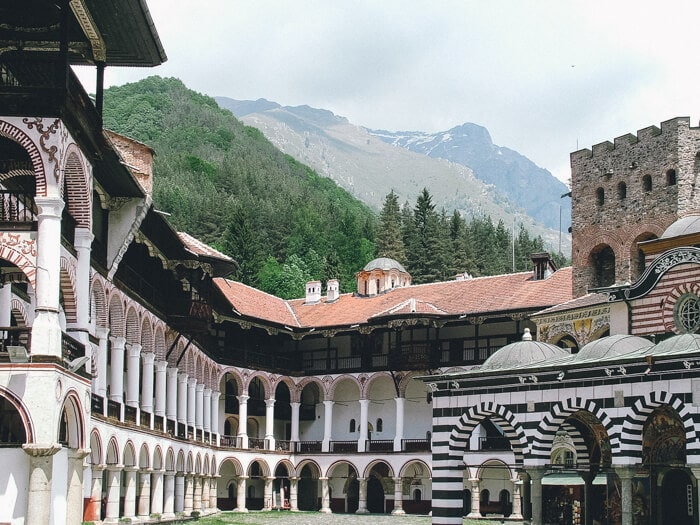
As the Roman Empire spread out over Europe, the Thracians were wiped out by 50AD. The Romans became a dominant force as the Slavs and moved south and east.
However, the Bulgars, a war-like tribe came from Central Asia and expanded their empire. The Bulgars and the Slavs cultures began to merge, and around the 6thcentury they became the first Bulgarians.
Bulgaria then became the largest and one of the most prosperous Kingdoms in Europe. Its area covered Greece, the Adriatic, as far north as Ukraine, and the Black Sea. It remained this way until around 1400, when the Ottomans arrived from the south.
During Bulgaria’s first 50 years under Ottoman rule, almost half of the population were killed or left to starve. Things improved over the subsequent 450 years in their power, and Bulgaria managed to keep maintain its culture, language, and traditions.
In the late 19thcentury, Bulgaria became liberated from the Ottoman Empire. It had help from Russia in defeating the Turks and became a large country which was subsequently split up.
The whole of the Balkans was in a period of unrest in the first half of the 20thcentury, with wars between countries as well as the First and Second World Wars. Although Bulgaria declared itself as neutral, the Germans infiltrated and occupied it. However, Bulgaria did not turn over its Jewish population.
After the Second World War, Bulgaria was ruled by a communist government. Under their rule, many enterprises were nationalized, and Bulgaria became an industrial power. However, under the Communist leader Todor Zhivkov, the economy started to fail, and the public was completely controlled. The fearsome social security police dealt with anyone who spoke out.
In the final years of communism, nationalism was fierce and Bulgarian minorities were denied education, work, and homes. When the Berlin Wall fell in 1989, Zhivkov was arrested for inciting racial hatred.
In 1991, Bulgaria adopted the governmental model it still has today. The current president is the 5thto be democratically elected, and he has pledged to maintain Bulgaria’s EU and NATO status.
And that's it! I hope this Bulgaria travel guide has given you some idea of what to see in Bulgaria and will be of help when you plan your Bulgaria vacation.
Find below our best travel guides about Bulgaria.

17 Superb Things to Do in Veliko Tarnovo, Bulgaria

20 Amazing Places to Visit in Bulgaria all year round!

18 Marvelous things to do in Plovdiv, Bulgaria

30 Best things to do in Sofia, Bulgaria

24 Impressive things to do in Varna, Bulgaria

10 typical Bulgarian food: The world needs to know how amazing Bulgarian cuisine is!

59 Fun Facts about Bulgaria (#22 is cool!)

The people of Bulgaria. Impressions of a first-time visitor
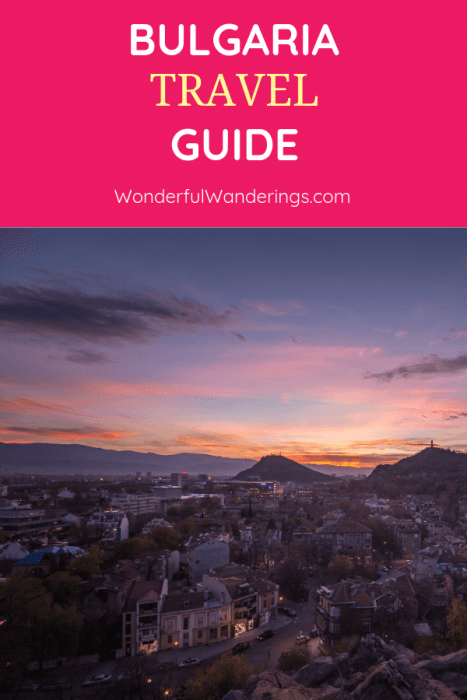
Join 58,000+ other Wonderful Wanderers!
As an Amazon Associate I earn from qualifying purchases.
10-Day Bulgaria Itinerary
Bulgaria is a relatively off-the-beaten-path and inexpensive European destination. The country boasts incredible landscapes, stunning monasteries, a beautiful coastline along the Black Sea, and ancient Roman ruins.
Bulgaria is one of my Top Budget Destinations Around The World !
Here is the ultimate 10-day bulgaria itinerary.

I can plan your trip!
Let me take care of the research and bookings so you can be stress-free.
My travel advisor service is FREE
I work with any budget
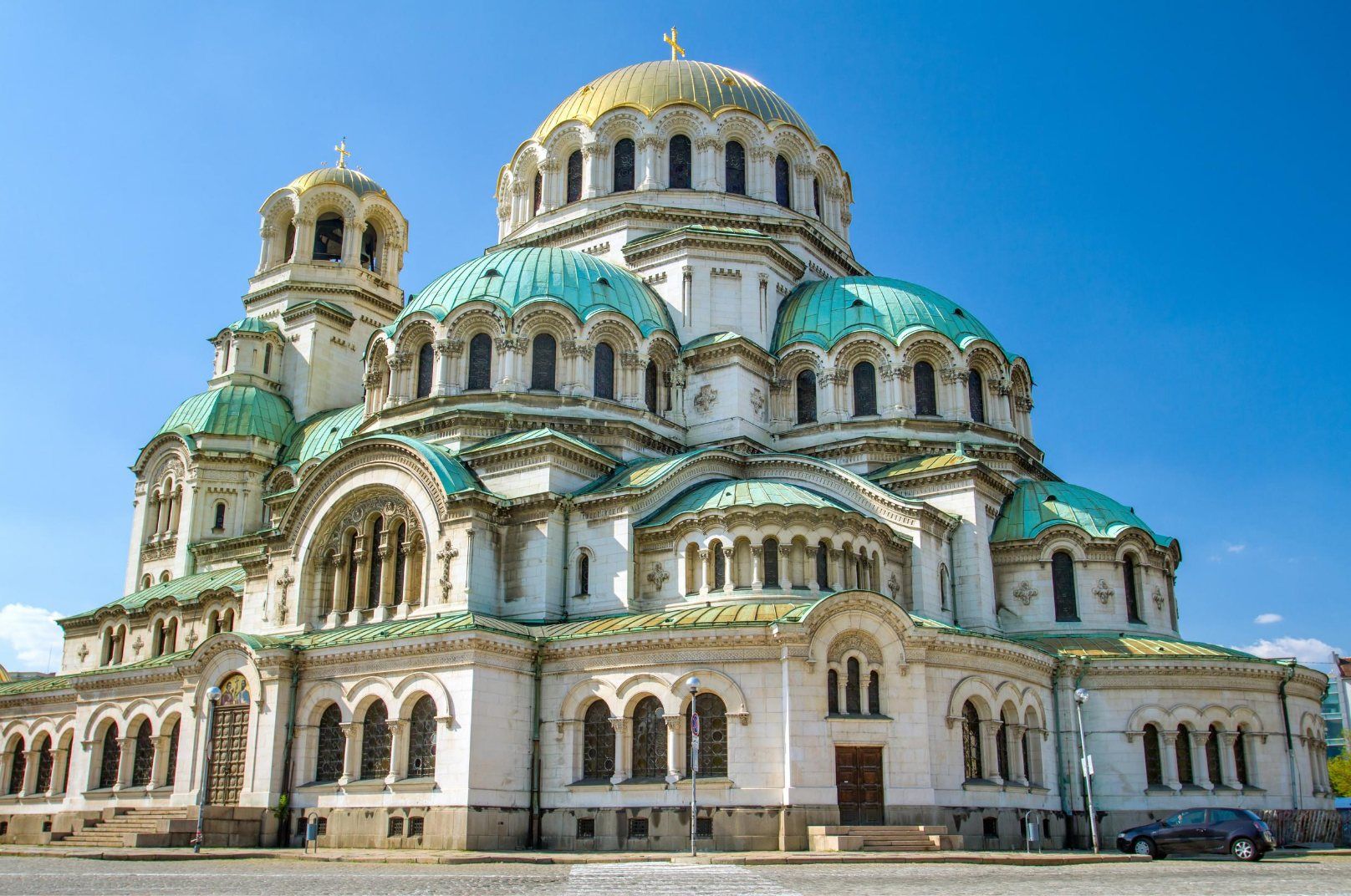
3 Nights in Sofia
Sofia is the capital of Bulgaria, and its food, architecture, and culture are a fascinating blend of Western European, Soviet, and Middle Eastern influences.
Spend your first two days exploring the city. I recommend starting with the Free Sofia Walking Tour to get oriented. Other must-do activities are touring the St. Alexander Nevski Cathedral (pictured above), stroll through the Borisova Gradina, a mineral bath in a hot spring spa, a pub crawl , and a Communist Tour .
Then spend your third day in Sofia on one of these day trips:
The 7 Rila Lakes : To get here, you’ll drive about an hour and a half from Sofia and take the Panichishte Resort cable car up to the start of the hiking routes. The hike to the viewpoint to see all 7 of the lakes will take about 5 hours round trip, but you can walk along and between the individual lakes at lower altitudes on shorter and less strenuous hikes.
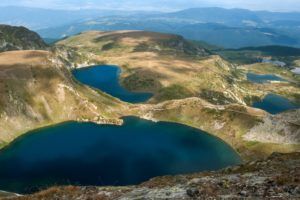
Vitosha Mountain : This is the majestic mountain you’ll see at every turn in Sofia. It’s home to some of the best panoramic views of the area. It’s also where you’ll find the Golden Bridges, which are actually stone rivers with a unique golden hue.
Prohodna Cave : Also known as “The Eyes of God,” this is one of the most famous and accessible caves in the country. You can hike or rappel into the cave, depending on your adventure level.
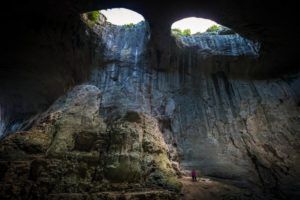
1 Night in Belogradchik
When you depart Sofia on your fourth day, I recommend renting a car for the rest of this itinerary. A car will save you a lot of time. Trains only serve the larger cities, and buses can take up to three times longer than a car. Plus, the road and driving conditions in Bulgaria are good, and with a car, you can stop anytime you see something amazing!
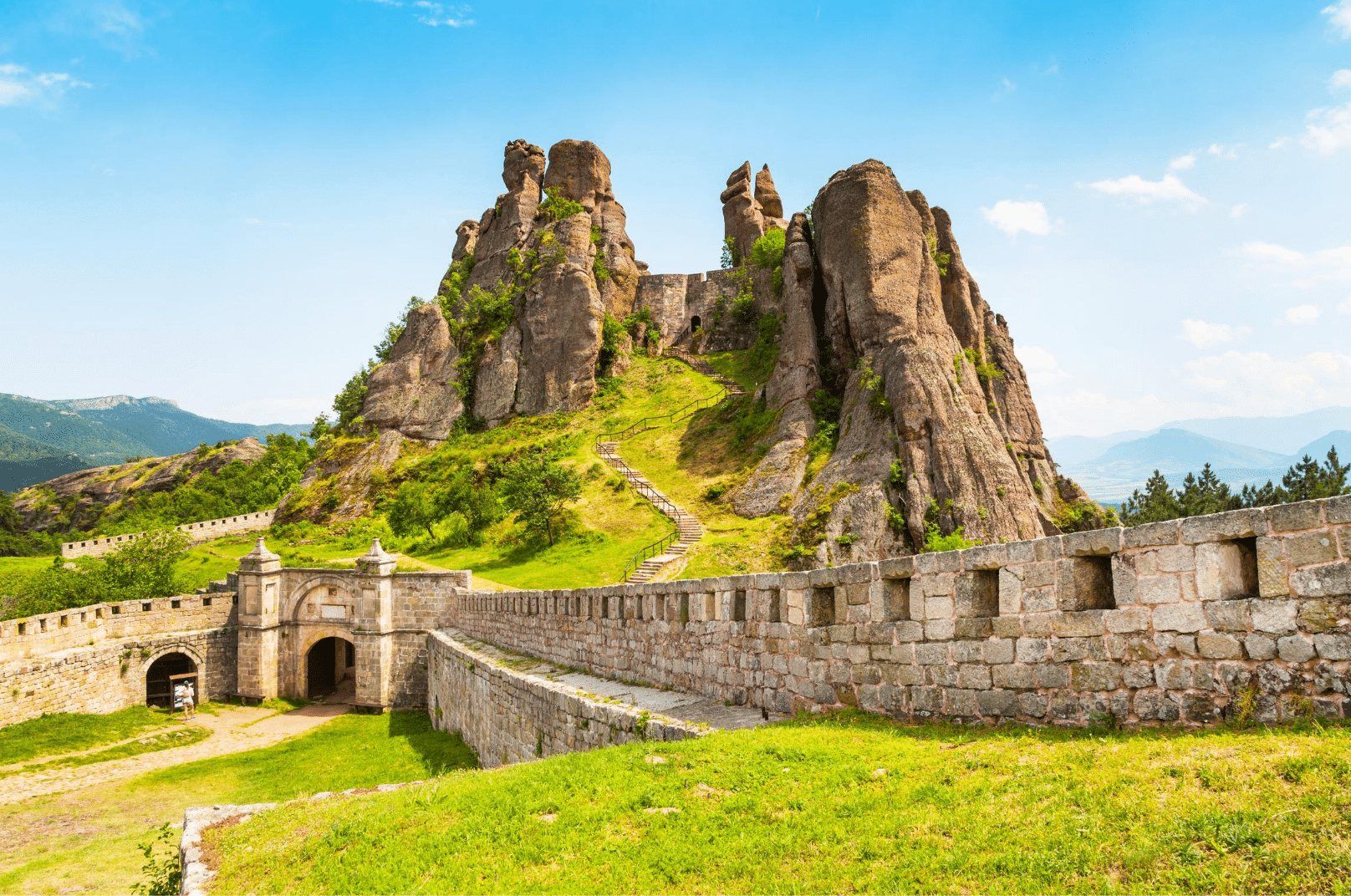
Belogradchik is home to the Belogradchik Rocks and the Belogradchik Fortress. If I could only recommend one thing to do in Bulgaria, it would be to visit the Belogradchik Fortress – one of the most beautiful and unique places I’ve ever visited.
Join the Newsletter
These rocks created a natural fortification, so the ancient Romans built the Belogradchik Fortress in the 1st – 3rd century AD. The fortress extends from the base of the Belogradchik Rocks up to The Citadel (pictured in the top image on this page) on top of the rocks.
The Belogradchik Fortress is open from sunrise to sunset, so you should leave Sofia by mid-morning at the latest for the roughly three-hour drive. I would plan to spend 3-4 hours at the fortress climbing up the stairs and trails to the peaks of the rock formations for some of the most stellar views you’ll ever see.
You should eat lunch before you arrive at the fortress and bring snacks and full water bottles. After you’ve explored the fortress and rocks to your liking, head to the quaint mountain town of Belogradchik for the night.
You could do the Belogradchik Fortress as a day trip from Sofia, but it will be a long day trip, and the town of Belogradchik is lovely.
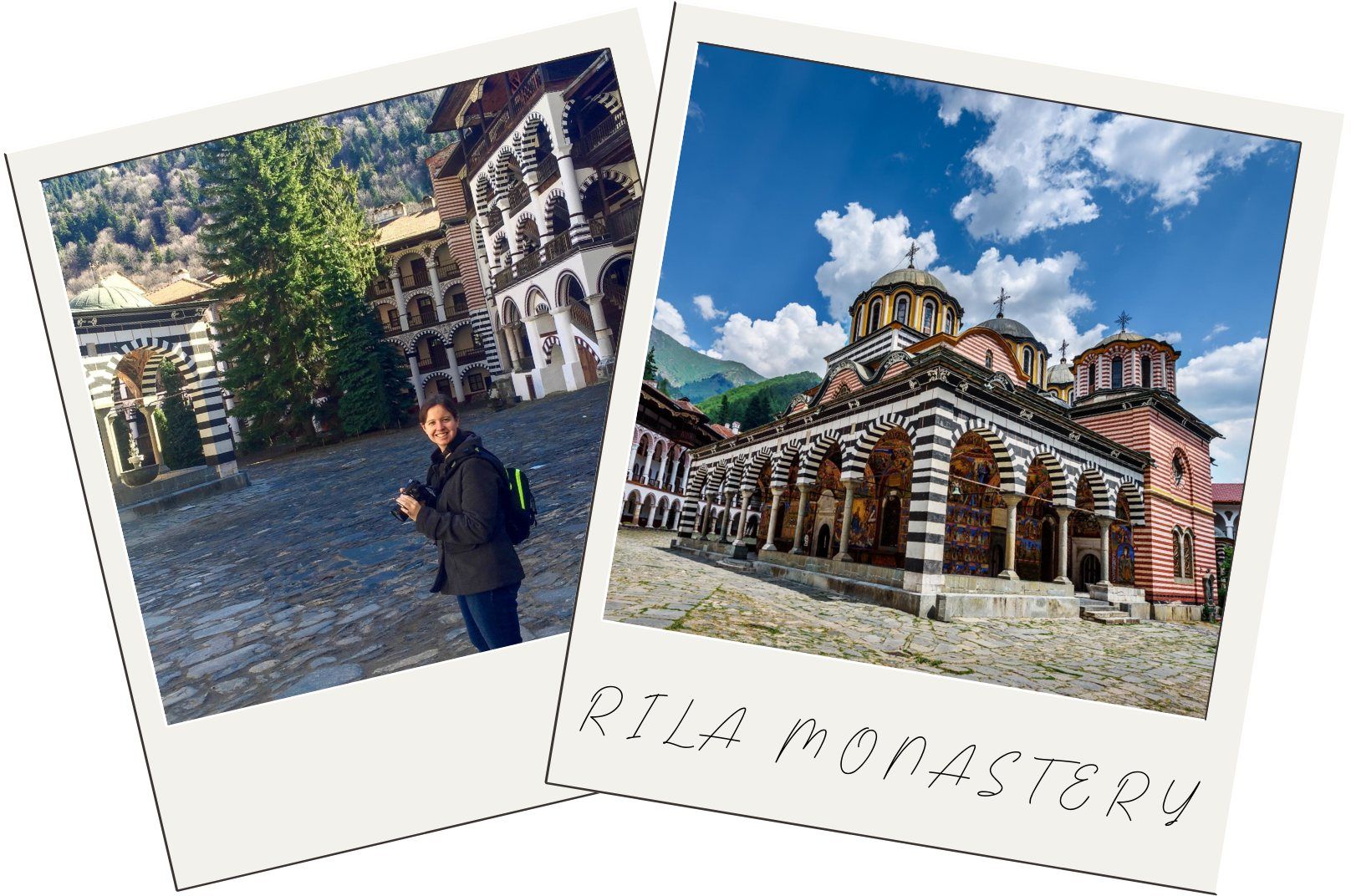
2 Nights in Melnik + a Sidetrip to the Rila Monastery
Depart Belogradchik this morning and head south to the Rila Monastery, which is on your way to Melnik. The Rila Monastery is the largest and most famous Eastern Orthodox monastery in Bulgaria.
Melnik is a premier wine destination in Eastern Europe. The town is also at the base of the famous Melnik Earth Pyramids – sandstone rock formations in the shapes of pyramids, giant mushrooms, ancient towers, and obelisks.
When you arrive in Melnik, I recommend walking the length of the picturesque town and having a sit-down dinner. Here’s my guide to the Best Local Foods to Try in Bulgaria .
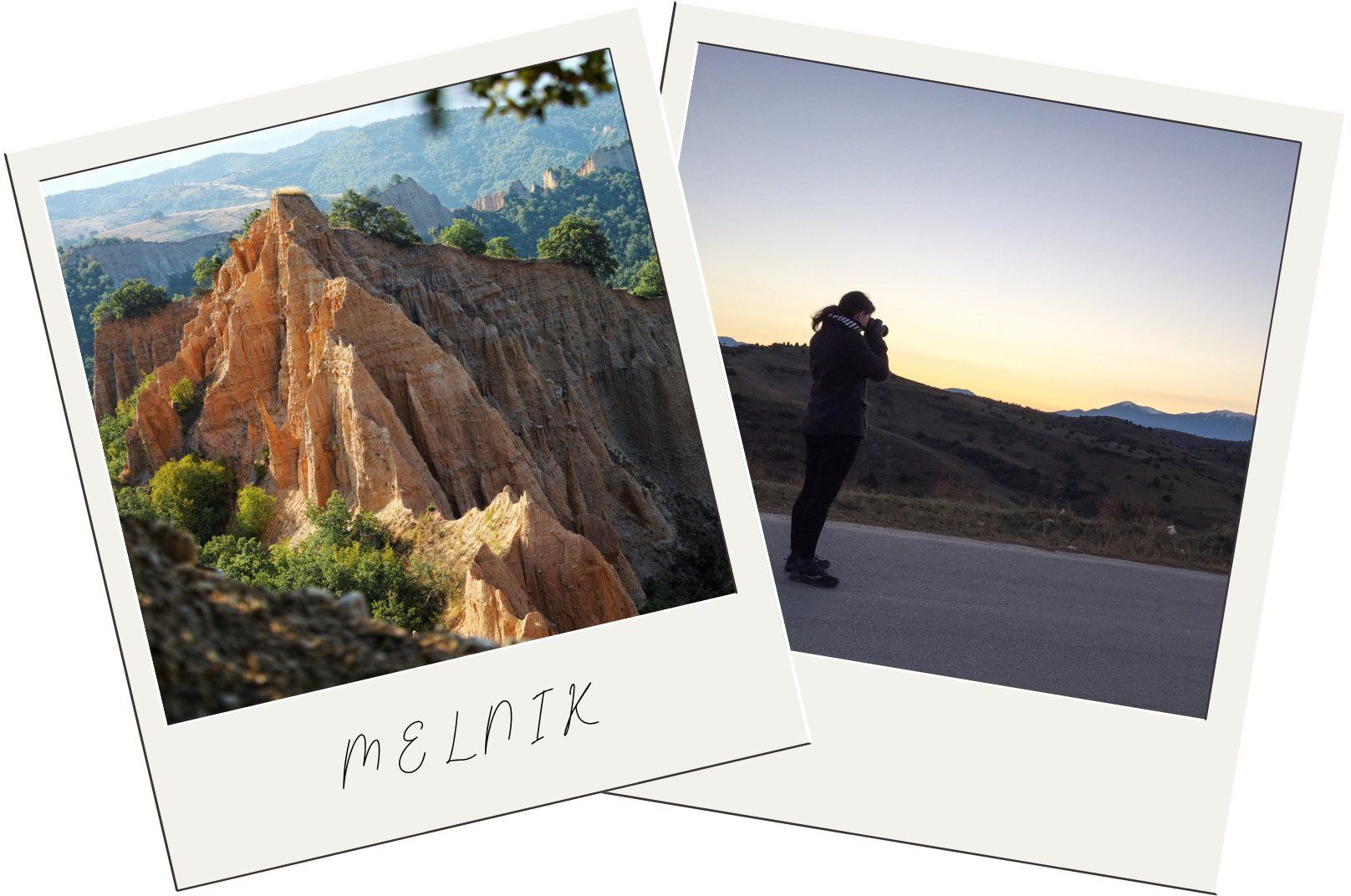
On day 6, you should hike to the Rozhen Monastery, which will take you past some of the most popular and interesting rock formations of the Melnik Earth Pyramids. Later in the day, you should do a tour and tasting at a vineyard.
This area is good for growing international grape varieties, such as Cabernet Sauvignon, Merlot, or Syrah. But there are two local grape varieties you need to try. The first is Shiroka Melnishka (also called Broad-leaved Melnik), and the second is Ranna Melnishka (or Early Melnik).
I recommend Villa Melnik because its tasting room has extraordinary views of the countryside and mountains. Villa Melnik is one of the Best Wineries in Bulgaria .
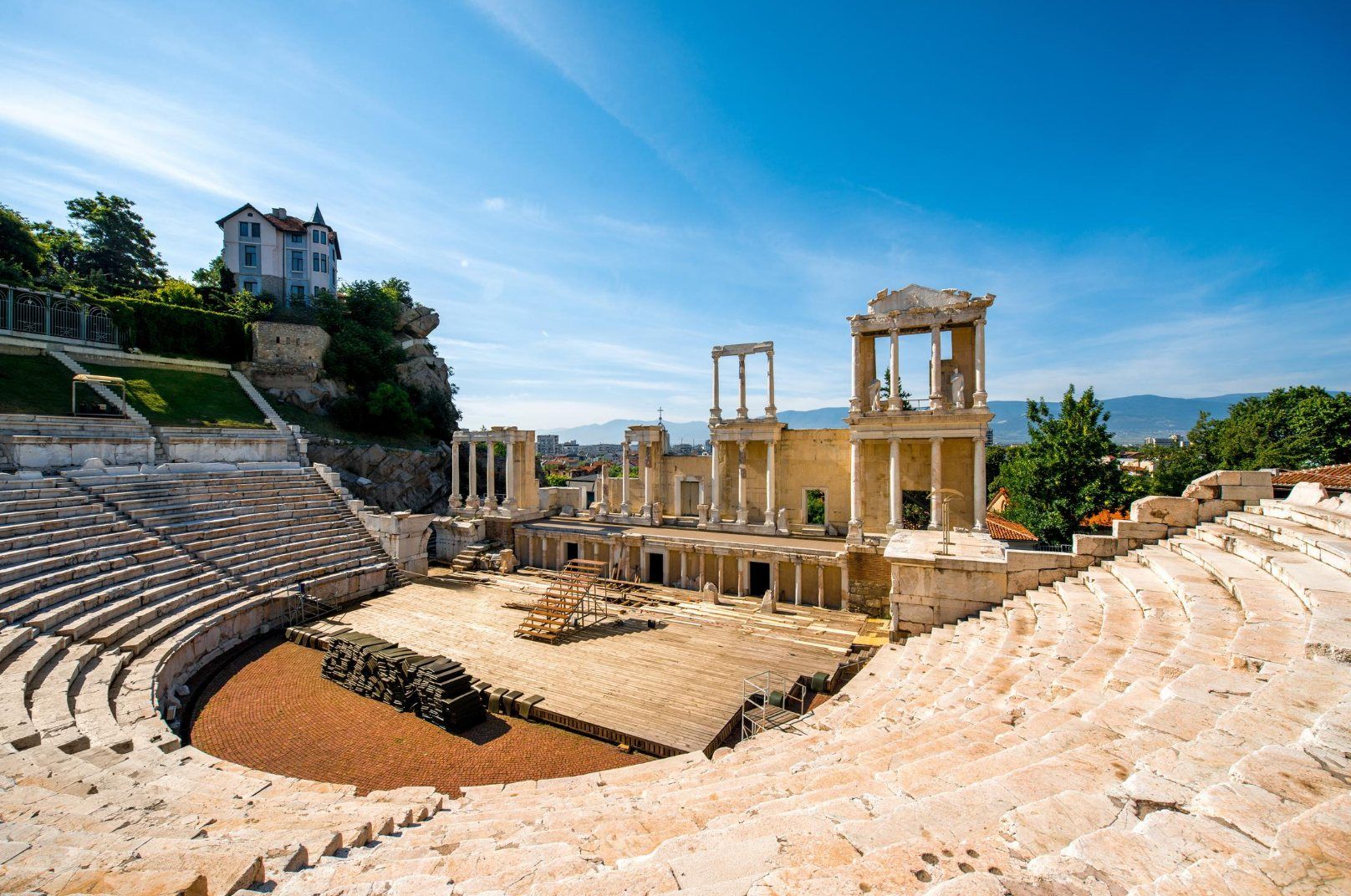
1 Night in Plovdiv
On your seventh day, make the four-hour drive to Plovdiv. Plovdiv is one of the oldest cities in the country, and it’s built on and around seven hills. This, combined with its size, abundance of ancient Roman ruins, and cosmopolitan “feel,” is why the city is often considered a less-expensive and less-touristy Rome.
Highlights for your time here are: visiting the Theater of Philippopolis (pictured above), exploring the Old Town, trying the local Mavrud wine and Rakia with dinner, and watching the sunset from Nebet Tepe, also known as “The Guard Hill.”
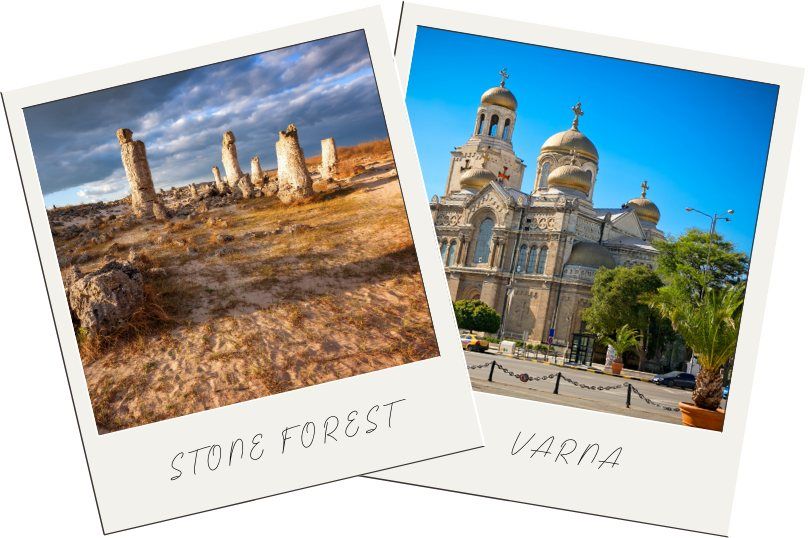
2 Nights in Varna
You don’t need to rush to leave Plovdiv on your eighth day if there’s something you didn’t get to do the day before. On your way out of the city, take a 30-minute drive to Asen’s Fortress. Then head to Varna on the coast.
Varna is a resort city on the Black Sea. The oldest gold treasure in the world was discovered at a necropolis in Varna. And the collection is now on display at the Archaeological Museum.
Must-do activities when you’re here are: have a beach day, stroll through the Sea Garden, visit the Aladzha Monastery cave complex, tour the Varna Cathedral (pictured above), and see the Stone Forest.
The Stone Forest, also known as Pobiti Kamani, looks like ancient columns, but they’re actually naturally-formed stone pillars.
Varna has a large airport and train station. So from here, you should be able to make your way home or to your next destination.
Alternative Coastal Town: Varna is one of the larger and more popular coastal towns. So, if you want a more intimate resort town, I’d recommend Sozopol. It’s more off-the-beaten-path, but it’s also more expensive. But if you’re visiting in the low season from November to March, then you should stick with Varna. Because nothing in this town will be open.
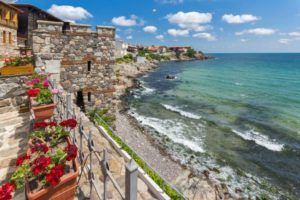
Shop My Bulgaria Essentials

What would be on your Bulgaria itinerary? Share below so we can work together on providing even more options for a Bulgaria trip!
Plan the rest of your trip.
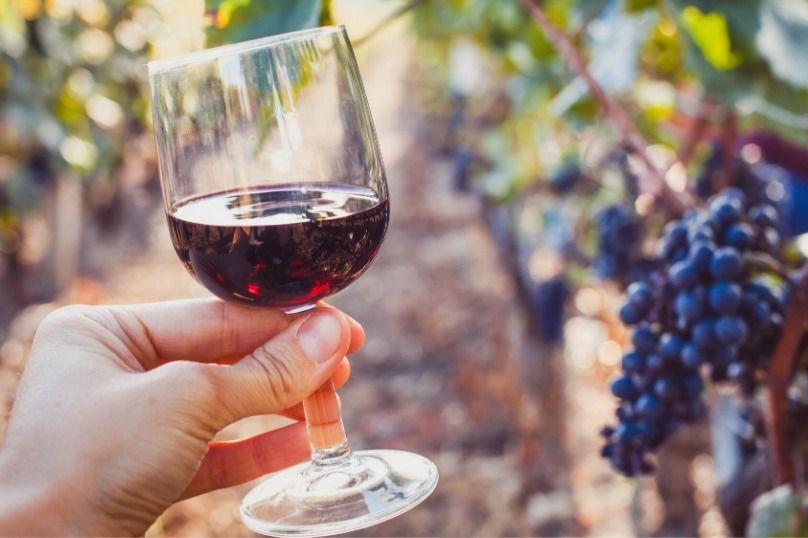
The Best Wineries in Bulgaria

The Best Foods in Bulgaria
Recommended tours in bulgaria, your travel checklist, book your flight, get travel insurance, book your accommodation, make sure you're traveling with the best credit card to earn travel points and avoid international fees, find out if you need a visa and get one here, pin this itinerary.
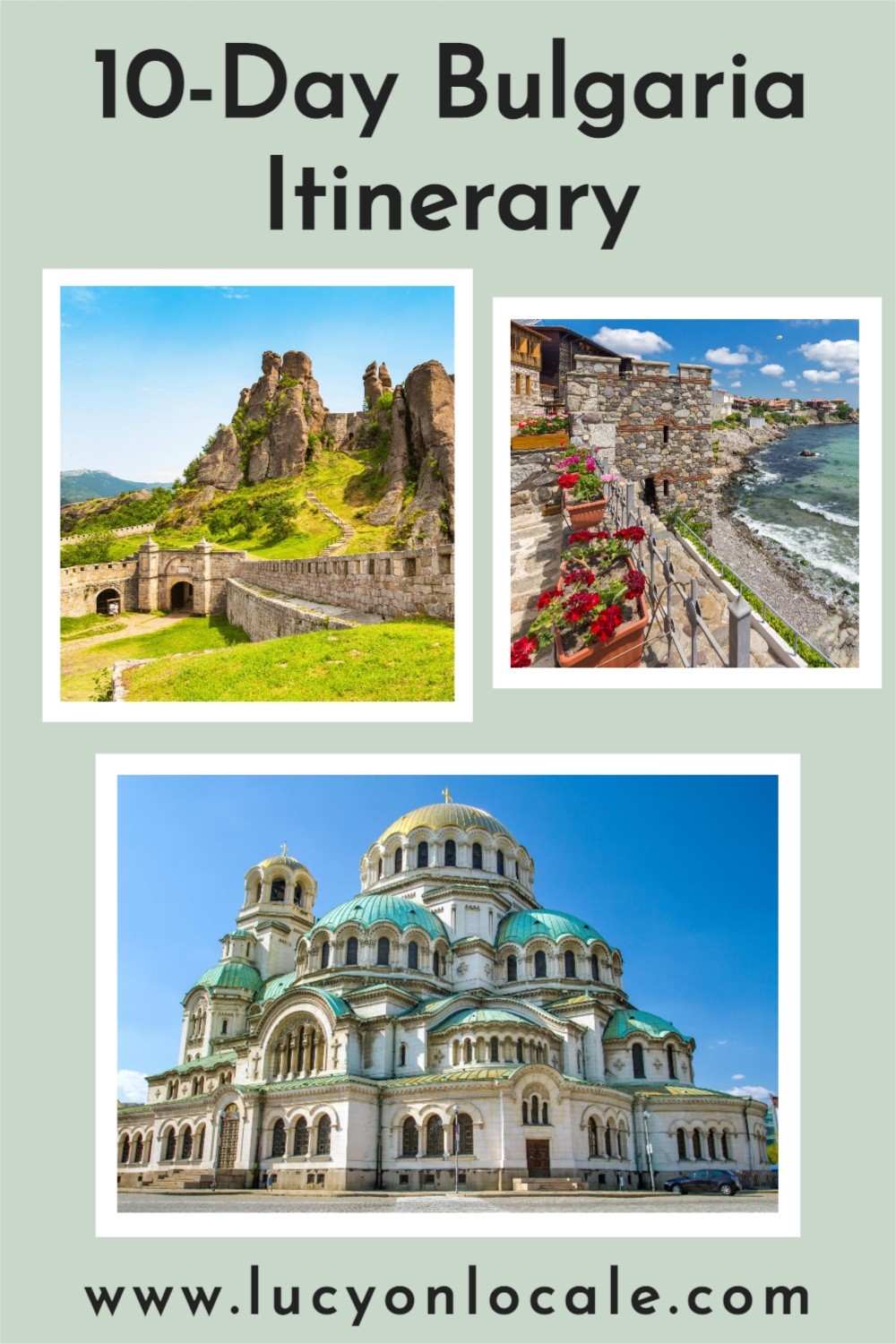
This Bulgaria itinerary is not a sponsored post. And, as always, the thoughts and opinions expressed here are entirely my own. Some of the links in this Bulgaria itinerary are affiliate links. And, at no cost to you, I may earn a small commission.
I would definitely include the medieval capital of Bulgaria – Veliko Turnovo. Also, while at Asen’s fortress, one should make it to the amazing Bachkovo monastery next door. And then, not far from Varna is the palace of Balchik and Cape Kaliakra with the Kaliakra fortress on top of the cliffs. From the coastal towns, I wouldn’t miss Nesebar with its ancient churches and medieval fortifications.
Lucy On Locale
These are great additions! Thanks for sharing!
Hello! Great post – some really useful tips in here 🙂 I was just wondering how you found driving over there, please? I’m going to Sofia, Plovdiv and Veliko Tarnovo and have booked buses, but I’m now considering hiring a car. I’ve heard the roads can be quite old and the drivers quite aggressive, but I’d be interested to hear your first hand experience, please.
Thank you 🙂
The rules of the road are the same as in the U.S., but the driving is very aggressive, and blinkers aren’t generally used as much as I was used to, but it didn’t make me too nervous, and I was able to adapt quickly. The hardest part of driving was that all road names are in Cyrillic, so I couldn’t read or pronounce any directions. I had to strictly use my GPS as a visual aid (the audio directions were no help to me). Overall, I’m glad I opted for a rental car but always plan more time into your drives than you think you’ll need.
post a comment cancel reply
Save my name, email, and website in this browser for the next time I comment.

lucyonlocale
1,180 12,210

Wander-Lush
Easy Bulgaria Road Trip Itinerary for 10 Days of Travel
With stunning national parks, historic cities and sweet villages, and an incredibly diverse landscape of mountains, lakes and rock formations, Bulgaria is a crowd-pleaser when it comes to Balkans travel .
This country has something for everyone – and because it’s so compact and easy to get around, it’s also one of the best places in the region for a road trip .
Whether you’re travelling in peak summer season for hiking or you’re planning to visit Bulgaria in winter to take advantage of the country’s skiing opportunities, there are an infinite number of ways you can design a Bulgaria road trip.
The following itinerary, suitable for summer or winter travel, is tailored to 10 days in Bulgaria but can easily be edited to be shorter or longer. It covers all the highlights, including several national parks, the Black Sea coast and several UNESCO World Heritage Sites.
Please note: This post contains affiliate links, meaning I may earn a commission if you make a purchase by clicking a link (at no extra cost to you). Learn more.
Renting a car in Bulgaria
Sofia is the logical place to pick up your car in Bulgaria. But don’t book it until you’re done with sightseeing – you don’t need a car for the city centre as metro and bus services are more than adequate.
I recommend using Local Rent to source a budget-friendly hire car from a local agent. Prices average 21 Euros per day, and there are plenty of perks you don’t get with the bigger brands including no deposit, comprehensive insurance included, and delivery to your address in Sofia.
If you’re driving in winter, tyre chains and ski/snowboard racks are optional extras and cost an additional 4-10 Euros (for the duration of the trip, not per day) depending on the vehicle.
→ Check prices and availability here on the Local Rent website .
Where to start your Bulgaria road trip
I recommend starting your itinerary in Sofia, Bulgaria’s capital city. Flights from Western and Eastern Europe service the city’s international airport, and rail and bus connections from neighbouring countries are plentiful.
You should budget at least 1-2 full days for Sofia in order to see the highlights. If you’re short on time, I highly recommend joining a walking tour of the city centre – this small group tour covers the main tourist spots while this alternative itinerary focuses on Sofia’s communist past.
Check out this list of 101 things to do in Sofia for more inspiration.
Bulgaria road trip map

Click here to open the map via Google Drive .
Bulgaria road trip itinerary for 10 days of travel
Day 1: depart sofia to start your bulgaria road trip itinerary in the mountains of rila & pirin.
The highest mountain range in Bulgaria, the Rila Mountains are an experience you don’t want to miss. If you visit in winter, you can play winter sports and ski the slopes. In warmer weather, you’ll want to take advantage of the many hiking trails.
Having your own car will allow you to access more remote mountain huts which are truly some of the country’s loveliest accommodations. Samovilla in Govedartsi is one of many darling chalets on the fringe of Rila National Park.
Rila Monastery
Leaving Sofia, Rila Monastery should be your first stop. A UNESCO World Heritage Site, it was founded in the 10th century and is by far Bulgaria’s most iconic Eastern Orthodox monastery.
Rila sits at a high elevation and takes several hours to reach by car. The way the roads wind up the mountain, you’ll feel like you’re entering another world – especially in winter when the hills are snow capped and sparkling.

Spend a good hour or so wandering the grounds of the monastery and the interior, admiring the stunning frescoes, architectural flourishes and well-kept grounds. There’s a dress code, so make sure you have your knees and shoulders covered to show respect before you enter.
If you can adjust your timeline, consider spending a night inside the monastery. Monks still live there and the gates close early, but it’s definitely a unique experience.
Rila National Park & the Seven Rila Lakes
The most popular hiking trail in these mountains is the Seven Rila Lakes. You’ll see, of course, seven lakes: The Tear, The Eye, The Kidney, The Gemini, The Triplets, The Fish Lake, and The Lower Lake.
Each lake is different, with the Tear being the highest, the Lower Lake being the lowest, the Eye being the deepest, and the Fish Lake being the shallowest. Bring a picnic to enjoy at the Kidney for beautiful views.
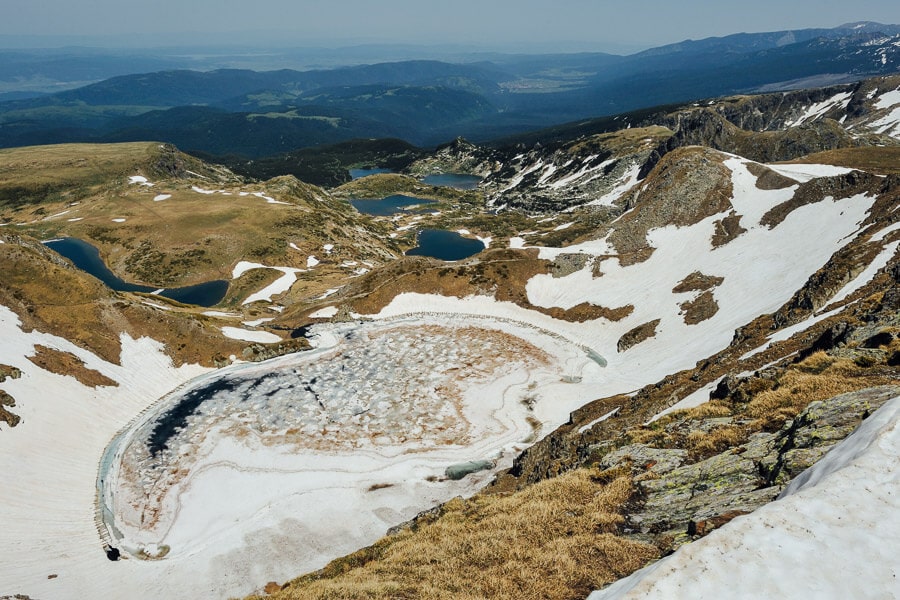
The cable car up to the lakes still runs in winter , but you might find that the whole landscape is white-washed with snow, making it difficult to discern the different lakes. Consider spending a day at Bansko or Borovets for skiing and snowboarding instead.
Day 2: Continue to historic Melnik
A few hours’ drive further south towards the border with Greece , Melnik enjoys a prime location in the heart of Bulgaria’s wine region . There’s a wine museum where you can learn about the practice of winemaking and try the local drop. You can also stop by wine stores and vineyards for walk-in tastings.

In addition to sipping local wines, take time to visit the Melnik Earth Pyramids, huge sandstone rocks that have been shaped over the centuries by rain and erosion.
If the weather is suitable, a short day hike up to Rozhen Monastery is a must-do. Built in the 15th century, it was ravaged by fire in the 1600s but has since been restored to its original glory.
Historic Chavkova House , with its sprawling gardens, is the ideal place to stay in Melnik if you want to explore the centre by foot and get some R&R ahead of a busy day 3.
Day 3: Follow the Rhodope Mountains to Trigrad Gorge & Smolyan
The Rhodope Mountains stretch across southern Bulgaria and into Greece. For more amazing day hikes, follow the popular trails since they’re well-marked. If you’re a more experienced hiker, you’ll love the freedom of getting out on the mountains away from the beaten path.
For an unforgettable experience, treat yourself to a night at Petko Takov’s House in Smolyan, a traditional country house with decadent rooms and a taverna.
Trigrad Gorge
East of Melnik, Trigrad Gorge is the third largest gorge in Bulgaria, with walls ranging from 100 to 300 metres high. The ravine was formed by the Trigrad River, which courses through the rocks.
While exploring Trigrad Gorge, make sure you venture to the bottom of the highest cliffs to experience Devil’s Throat Cave – it contains an underground waterfall that merges with the Trigrad River.
After spending time in the rugged Rhodope Mountains, you’ll be glad to see Smolyan, a resort town close to the Greek border. It sits in the valley of the Cherna and Byala Rivers.
The perfect winter escape, it has plenty of indoor activities on offer including museums, art galleries and restaurants that serve national food and regional specialties.
Days 4 & 5: Relax in Plovdiv, Bulgaria’s most charming city
Heading north back into central Bulgaria, Plovdiv is the second-largest city in the country and one of the oldest in the world. There are Roman ruins to explore, including the Roman Forum of Philippopolis and the Ancient Stadium.

While you’re in the Old Town area, visit Dzhumaya Mosque, one of the oldest and largest mosques around. Most modern mosques have one dome, but Dzhumaya Mosque has nine.
Plovdiv is a delightful mix of old and new. As well as gorgeous examples of Bulgarian Revival Architecture you’ll find many hidden treasures, including the Kapana district, with its enticing assortment of street art, craft beer bars and restaurants. Spend an afternoon walking the pedestrian streets and browsing the many independent shops and cafes.

Time your visit just right so you can be atop one of Plovdiv’s seven hills at sunset. You won’t believe the astonishing views. Plovdiv City Center Hotel is a great base for your stay and just a short walk from some of the best sunset spots. Spending two days in Plovdiv gives you a chance to really explore the history – I spent a full week here and never ran out of things to do.
Days 6 & 7: Soak up Black Sea coast vibes in Varna & Nesebar
Bulgaria’s Black Sea offers a different experience depending on the time of year you go. Outside of summer peak season you can experience the historic cities without the crowds. Nesebar and Varna are both must-sees.
Often called the ‘Pearl of the Black Sea’, Nesebar is a historical fishing town that was once part of the Ottoman Empire. You can easily spend a couple of days here seeing the ancient fortress and ruins.
History is well-balanced with modern conveniences, so you can enjoy the touristy side of town as well. Nestled within the old town but still walking distance from the sea, Kirios Hotel offers guests the best of both worlds.

Further north along the coast, Varna is Bulgaria’s third-largest city. Make time for sights of historical interest including the Archaeological Museum, which has ancient gold artefacts that date back 6,500 years. The Battle of Varna Park Museum has tombs from 4,000 BC with a unique Stone Forest just beyond the battlefield.
If you’d rather stay close to nature, you can enjoy the University Botanical Garden. It spans 360 hectares and is a great place to have a picnic. When you’re ready to relax by the Black Sea, the Sea Garden is a landscaped park that runs along the waterfront.
Guest Rooms Boutique Varna offers simple but comfortable rooms within walking distance of the Roman baths, the port, and other major attractions.
Day 8: Head inland to Veliko Tarnovo, Arbanasi & Nicopolis ad Istrum
After a few days by the sea it’s back to the mountains of Bulgaria’s interior. Veliko Tarnovo is a walkable city with a charming old town and the most impressive fortress in the country, Tsarevets, at its highest point. This city used to be Bulgaria’s capital but is now known for its amazing views and history.

It’s also home to one of the largest universities outside of Sofia. Because the population skews young, you’ll find a lively bar scene and lots of events in Veliko Tarnovo. Hostel Mostel , one of Bulgaria’s best hostels, is a great place to meet people. If you prefer your privacy, Guest House Diabora is set inside a stunning heritage home.
After exploring the fortress grounds, walk or take a taxi up the hill to the nearby village of Arbanasi for magical views looking down onto Tsarevets. The Roman-Byzantine ruins at Nicopolis ad Istrum, 20 kilometres north of Veliko Tarnovo, are also worth a look-in if you’re a fan of archaeology.
Day 9: Drive to Koprivshtitsa via Kazanlak, Shipka & the Buzludzha
By now you should be ready to start winding up your Bulgaria road trip and heading back towards Sofia. But first, there’s still ample time for a mini road trip within a road trip to Koprivshtitsa, making several incredible stops along the way.
The Kazanlak area has a wealth of natural and historical sights, all worthy of a stopover. Consider visiting:
- The Tomb of Seuthes III
- The Megalith Rock Sanctuary
- The Museum of Roses
- The Museum of Photography
In Shipka, don’t miss the Buzludzha , the famous UFO-shaped Memorial House built by the Bulgarian Communist Party. The drive up Buzludzha Peak is rough and winding, but it’s worth it for the views. The monument is currently closed off for some much-needed restorations, but you can still admire its otherworldly form from afar.

Finally, the last leg of your road trip will take you to delightful Koprivshtitsa, a historical village where you can see landmarks from the Bulgarian uprising against the Turks.
Many of the houses have been preserved with their unique architecture on full display. Some have been transformed into cultural museums while others have been reborn as guest lodgings.

For a chance to sleep inside one of these stunning heritage monuments, stay at Family Hotel Panorama .
Day 10: Return to Sofia
Spend the morning in Koprivshtitsa before returning to Sofia.
Quick tips for driving in Bulgaria
- In Bulgaria you drive on the right-hand side of the road.
- Seat belts are mandatory for both front and back-seat passengers.
- Bulgaria has a zero-tolerance policy when it comes to drink driving – keep this in mind if you plan on visiting the country’s wineries.
- Bring a hands-free mount with you as it’s illegal to use your mobile phone when driving.
- During the winter months (November-March) you must have your headlights on at all times.
- Winter tyres with 4mm of tread are required in winter (enforceable by law). Snow chains are compulsory in some areas when conditions are harsh – be sure to research your route well in advance and add on chains if you need them.
→ Find more great tips for driving in Bulgaria here .
Bulgaria essentials
Here are my favourite resources to help you organise your trip to Bulgaria.
FLIGHTS: Find affordable flights to Bulgaria on Skyscanner .
TRAVEL INSURANCE: Insure your trip with HeyMondo , my preferred provider for single-trip and annual travel insurance.
VISAS: Use iVisa to check if you need a tourist visa for Bulgaria and apply for an expedited visa online.
SIM CARD: Buy an eSIM and data package for Bulgaria online before you go. My top choice is the Eurolink eSIM from Airalo (10 GB for 30 days).
AIRPORT TRANSFER: Pre-book a private transfer to your hotel in Sofia (prices start from $25 per car ).
ACCOMMODATION: Find the best hotel deals in Bulgaria on Booking.com .
CAR HIRE: Use Local Rent to hire a budget-friendly car from a local agent or Discover Cars to hire through an international rentals company.
DAY TRIPS & CITY TOURS: Find the best city tours and day excursions in Bulgaria using Get Your Guide or Viator .
Leave a Reply Cancel reply
Your email address will not be published. Required fields are marked *
- Subscribe to future posts

Planning a Trip to Bulgaria: Your Travel Checklist
Bulgaria , What to Do

If you’re planning a trip to Bulgaria, you probably have a lot of questions. Well, rest easy – we’re here to help. This guide was written by two Americans who have made Bulgaria their home away from home, and we’ve brainstormed all the things you’d want to check off your travel checklist before arriving in Bulgaria so that you can have an organized, stress-free trip.
This guide will cover everything you need to know when planning a trip to Bulgaria, from visas to vaccinations to trip planning and beyond, in 11 easy steps!
Step 1: Check to see if you need a visa

EU, American, Australian, British, Canadian, Australian, and many more citizens don’t need a visa to visit Sofia for 90 days or less
Before you arrive in Bulgaria, you should probably see whether or not you need a visa! Note: While we will do our best to ensure this page is updated, you should always check the MFA’s website to confirm any visa information.
At present, this is the list of countries who do not need a visa to stay for 90 days or less in a 6-month period, but again, please double check at things may change!
Andorra, Australia, Austria, Belgium, Brazil, Brunei, Canada, Chile, Costa Rica, Croatia, Cyprus, Czech Republic, Denmark, El Salvador, Estonia, Finland, France, Germany, Greece, Guatemala, Honduras, Hungary, Iceland, Ireland, Israel, Italy, Japan, Latvia, Liechtenstein, Malta, Malaysia, Mexico, Monaco, Lithuania, Luxembourg, Netherlands, New Zealand, Nicaragua, Norway, Panama, Paraguay, Poland, Portugal, Republic of Korea, Romania, San Marino, SAR – China (Hong Kong, Macao), Singapore, Slovakia, Slovenia, Spain, Sweden, Switzerland, UK, USA, Uruguay, the Vatican, Venezuela. Also, Serbians, Macedonians, and Montenegrins can visit Bulgaria for 30 days in a 6-month period.
If your country is not on the list, you may be in luck if you have a valid Schengen visa, which would grant you the same 90 days in 3 months rule. However, keep in mind that if you have a single-entry Schengen visa , and you leave the Schengen zone to visit Bulgaria, you will not be allowed back into the Schengen zone as you will have used your entry.
Similarly, if you have a valid visa for Romania, Cyprus, or Croatia, that would be fine as well. If you don’t have any of the above valid visas at the time you want to visit Bulgaria, you will have to visit your nearest Bulgarian embassy to apply for a visa.
Step 2: Book your tickets

Budget airlines aren’t comfortable, but they are a great way to get to Sofia on a budget!
Unless you are coming by bus from a neighboring country, you will likely want to fly to Bulgaria. While Bulgaria Air serves several destinations in Europe, they are usually not the cheapest option.
You will be better off booking with one of the three budget airlines that serve Bulgaria – Wizz Air, Ryanair, and easyJet. They have routes all over Europe, so you’re likely to find a cheap flight from virtually everywhere in Western and Central Europe (unfortunately, Eastern Europe has fewer options).
We usually use a combination of Skyscanner and Google Flights when we are searching for flights. I like Skyscanner’s “Everywhere” feature, which is helpful for determining which cities fly to your destination. Meanwhile, Google Flights has a nicer interface and updates with the correct prices faster, so there’s no disappointments when you click through unlike Skyscanner sometimes has.
Step 3: Plan your itinerary

We recommend visiting Plovdiv if you have 3 days or more in Bulgaria; if not, stick to Sofia!
For the purpose of this article, we’re going to assume that you are only visiting Bulgaria. If you are planning a multi-country Balkan trip, we have a whole post all about Balkan itineraries for you to read!
If you have only a short amount of time, say, a weekend, we recommend sticking to Sofia, and making an optional day trip to Plovdiv. Sofia is a vibrant capital with so much to see and do that it would really be a shame if you skipped it!
If you have 4 or more days, you can start planning a multi-city trip. If you have 4 days, I would recommend picking two cities, and spending either 2 days in Sofia and 2 days in either Veliko Tarnovo or Plovdiv. If you have 5 days, add an extra day in Sofia. If you have a week, I’d spend 3 days in Sofia, 2 in Plovdiv, and 2 in Veliko Tarnovo. On any of those Sofia days, you could make a day trip to either Rila Monastery or the 7 Rila Lakes for a beautiful hike (or hike Mount Vitosha to the Cherni Vrah peak if you want a 2200-meter-high hike without leaving the city).
If you have more than a week in Bulgaria, I’d recommend trying to also add in the Black Sea coast. Varna is a wonderful coastal city and has a great vibe; Burgas is smaller and quieter but has a gorgeous pink lake and mud baths right in the city. There are also countless smaller beach towns all up and down the coast: Sinemorets, Sozopol, Byala, Chernomorets, Nessebar, and many more. And there’s also the love-it-or-hate-it Sunny Beach (spoiler: we actually kind of love it!), a resort town and party hotspot on the Black Sea coast.
If you can drive, renting a car may be a great idea to see some other Bulgarian highlights that are not quite so easy to get to, like Krushuna Waterfalls, Saeva Dupka Cave, Belogradchik Fortress, and Buzludzha.
Step 4: Plan your activities

We think a trip to Rila Monastery is a must on any Bulgaria trip!
Once you’ve determined what cities are on your itinerary, it’s time to plan your activities! We have guides on things to do in Sofia , what to do in Plovdiv , and what to do in Veliko Tarnovo . Those resources are a great start for planning your trip!
If you want to do any city tours or day trips, we recommend booking in advance, as sometimes tours book out especially in the peak season (May to September). We personally use and recommend GetYourGuide when searching for tours in Bulgaria and the Balkans in general. We like that they have a best-price guarantee and that they tell you the name of the tour companies they partner with (unlike Viator), so you can research it and be sure it’s worth your money!
Step 5: Budget your trip

One great thing for your Sofia budget? A taxi around town will rarely cost more than 5 leva (less than $3 USD)
Once you’ve planned how long you want to spend and where, it’s time to budget your trip!
If you want to stay as a backpacker, staying in hostels, cooking for yourself and indulging in cheaper eats like sandwiches and pastries, you will find it easy to travel on a $30 USD a day budget. Of that, about $10 will go towards your hostel; the other $20 can be spent on food, drink, activities, and transportation, within reason.
We personally feel that Bulgaria offers the best value to mid-range travelers. This means staying in a cheap but cheerful private room, eating out at a mix of local restaurants and higher-end restaurants, going out for drinks at the local bars, taking taxis, and indulging in a few guided tours. On this budget, you can have a fantastic time in Sofia for $50-70 USD per day, and that range largely has to do with whether you are traveling solo or with a travel partner (solo will be more expensive) and just how much exactly your accommodation costs.
However, it is possible to do Bulgaria in absolute luxury and not spend too much money! This means the nicest hotel in town, no-holds-barred when you order, nice drinks, taxis galore, and guided tours. Even on a blow-out budget, you will spend between $100-200 USD per day tops.
Step 6: Book your accommodations

Sense Hotel has the best views in Sofia!
Once you’ve sorted out what you want to spend per night on accommodations, it’s time to get booking! We use Booking.com because we like that they have free cancellation if you end up changing your plans and they have the widest selection and best prices.
We’re in the process of creating comprehensive guides on where to stay in each Bulgarian city, but for now, here are our top recommendations.
Budget: Hostel Mostel / Mid-Range: R34 Boutique Hotel / Luxury: Sense Hotel
Budget: Best Rest Guest House / Mid-Range: Villa Antica or 8 1/2 Art Guesthouse / Luxury: Hotel Residence Hebros
Veliko Tarnovo
Budget: Hostel Mostel / Mid-Range: Base Camp Guesthouse / Luxury: General Gurko House
Step 7: Research any vaccinations you may need

Bulgaria has a lot of friendly strays, but approach with caution if you don’t want to deal with rabies vaccinations! This little guy jumped on my lap at a random bus station near the Macedonian border.
TL;DR – if you’re a frequent traveler who is usually up-to-date on their vaccines, you’ll be fine in Bulgaria.
There’s really nothing that special that you need for Bulgaria. The CDC recommends being up-to-date on all your standard vaccines, which you should be anyway. This includes MMR, tetanus, chickenpox, polio – the usual. You may want to consider getting vaccinated for hepatitis A, if you’re not already vaccinated against it, as it can be spread by contaminated food or water. This is unlikely to happen as Bulgaria’s water is clean and safe to drink in nearly all cities, but being vaccinated against hepatitis A is a good idea anyway for future travel.
The CDC also suggests possibly being vaccinated against hepatitis B if you, for example, want to get a medical procedure done or get a tattoo, and also possibly getting vaccinated against rabies. I think most travelers can safely skip both. I got bit by a cat in Ukraine earlier this year and had to get post-exposure shots. While it was a pain in the ass (not literally, anymore – the shots are now done in the arm, luckily!), it is 100% effective if the protocol is followed. And since you have to get post-exposure shots regardless of being vaccinated, it is not that much more of a burden in the extremely unlikely chance of an animal attack.
Step 8: Learn a few common Bulgarian words, and possibly the Cyrillic alphabet

Knowing Cyrillic helped us read this Bulgarian-only sign (paid parking, 1 leva per hour)
We think it’s a nice idea to learn some basic words in the country you’re traveling to! Luckily, while Bulgarian is a hard language to master, the basics are easy enough! Here are a few, hear the pronunciations here :
Hi = Zdrasti Good day (more formal) = Dobar den Please = Molya Thank you = Merci (or blagodarya, if you really want to impress a Bulgarian – this is hard to master!) Goodbye = Chao Excuse me = Izvinite OK, Good = Dobre Yes = Da No = Ne I don’t understand = Ne razbiram Do you speak English? = Govorite angliiski?
Fun fact: Bulgarians often nod their head when saying “ne” and shaking their head from side to side when saying “da” – it’s quite confusing, but a fun cultural quirk!
If you have an interest in languages, you may want to consider learning the Cyrillic alphabet ! It’s easy to learn the basics and it will help you immensely, such as being able to find familiar words on a menu (many Bulgarian words are Cyrillicized versions of English/Latin words), finding the right bus at the bus station, or spotting a fake taxi !
Step 9: Pack your bags

We recommend packing beforehand to avoid last-minute stress!
What you should pack depends greatly on the time of year. We have some packing lists that we’ll add soon to help you plan for your trip to Bulgaria, but for now, here are five things we don’t recommend you visit without!
- A Lonely Planet guidebook, to help you plan when on the ground
- A raincoat and/or umbrella, since Bulgaria’s weather can be unpredictable
- An unlocked smartphone, so you can buy a cheap Bulgarian SIM card and use taxi apps How to Get a Bulgarian Sim Card & Stay Connected on Your Trip
- Wet wipes and hand sanitizer, in case of a poorly stocked bathroom
- Comfortable walking and/or hiking shoes, so you can make the most of Bulgaria’s cities and mountains
Step 10: Prepare for your arrival

Hint: Terminal 1 is nowhere near Terminal 2. The shuttle between them only runs every 30 min. Be certain which terminal you are flying into if you are planning on taking public transit!
You’re nearly done planning your trip to Bulgaria, but don’t miss this last crucial step – planning what you do when you arrive!
Firstly, money – you’ll either want to withdraw cash from the ATM at the airport or exchange your money. We recommend withdrawing cash instead, as you will get a better exchange rate at money-changers in the city. However, if you plan to use the ATM, you should probably call your bank to advise them of your travel. The last thing you want to happen is for your bank to deny your card when you arrive! I always advise carrying at least $50 USD/euros as a backup in case of any card problems.
Next, transportation. We have this guide to Sofia airport that may be helpful for you to read, and we consider this Sofia taxi guide essential reading for any visitor to the city, especially the part of how to get a taxi at the airport. While Sofia is safe and the taxi system at the airport is highly regulated, there are occasionally scammers who will try to prey on unsuspecting tourists. Don’t let this be you! A taxi should only cost around 15 leva maximum during the day and 20 leva maximum at night, and it could well be less (about 7.50-10 euros). Ignore anyone who wants to do a flat rate and insist on the meter with a registered cab (read how on the taxi guide above) to avoid any problems.
If you don’t want to take a taxi and you land during the day, you can easily take the Metro to the city center. If you fly into Terminal 2, the metro is walking distance from the terminal and costs 1.60 leva (about 80 euro cents). It takes about 45 minutes to reach the center. You will need cash, so take some out at the ATM or exchange it. If the ATM gives you big bills, like 50 leva notes, you may want to try to break it into something smaller at the airport if you can.
Finally, be sure you have your hotel or Airbnb information (address and phone number) easily accessible so that you or your taxi driver can contact them if you have any trouble reaching them. We also recommend pre-downloading the Sofia city map on your phone so that you can know your location if you get lost, even if you don’t have wifi or data. Once you arrive, you can pick up a Bulgarian sim card , but they don’t sell them at the Sofia airport.
Step 11: Don’t forget travel insurance!
We put this last so it’s fresh on your mind: travel insurance is essential for Bulgaria and for travel in general! Stephanie and I have both been paying customers of World Nomads for the last two years. We love the peace of mind it gives us in case of emergencies, accidents, illnesses, theft, or trip cancellation or disruption.
While Bulgaria is perfectly safe to travel around, there’s always risk inherent in everyday travel, so it’s better to play it safe. The saying goes “if you can’t afford travel insurance, you can’t afford to travel” is true!
Get a travel insurance quote for your trip here.

Originally from California, Allison has been living in Bulgaria for the last two years and is obsessed with traveling around the Balkans. She has been published in National Geographic, CNN Arabic, Matador Network, and the Huffington Post. She loves befriending dogs, drinking coffee, geeking out about wine, and cooking food from around the world.
Related posts
Good afternoon. Thanks for this info! Love your blog!. Myanh Hoang
Thank you! Have fun on your trip to Bulgaria!
I am looking into Blog about Bulgaria and I came across yours. Very informative and I am making them as my references for my plan visit to my gf at Plovdiv. I hope I can do it and surprise her.
That would be a lovely surprise!
How much should a taxi from Sofia airport to the centre cost. Please
We cover this in our taxi guide, but it should be about 12 leva during the daytime to the center, and about 18 leva at night (past 10 PM).
Submit a Comment Cancel reply
Your email address will not be published. Required fields are marked *

New on Sofia Adventures:
- How to Spend a Magical One Day in Istanbul: Mini Itinerary
- 30 Insanely Delicious Greek Street Foods You Need to Try
- 13 Things That EXIT Music Festival Visitors Should Know

- Living In Croatia
- Croatian Recipes
- Balkan Recipes

Home > 5 Days In Bulgaria Itinerary: Places To Go, What To See & More
5 Days In Bulgaria Itinerary: Places To Go, What To See & More

Written by our local expert Guru
Written by a local specialist we know and trust to bring you the most up-to-date travel information.
Here’s how to make the most of five days in Bulgaria with this Bulgaria itinerary. Start your journey in the capital, spending your days in the capital soaking up its rich history and vibrant culture.
Sofia and Plovdiv are must-visits, each city boasting a lot to offer, from historic sites to buzzing nightlife. Rila Monastery is one of the best places to visit and a spiritual jewel of the country.
With international airports facilitating your arrival, embarking on this adventure through Bulgaria’s most captivating sights is a breeze.

Bulgaria has so much to offer . The country is a natural bridge between East and West, providing natural beauty and cultural origins from both regions. This becomes evident when you arrive and find yourself in the nation’s capital , Sofia.
Suppose you only have five days to spend in Bulgaria. In that case, the following suggestions are truly worthwhile highlights from my own time in Bulgaria (also, check out these relaxed, small-town itineraries ).
Experience a taste of Sofia’s rich architecture and cultural history, and enjoy traveling the open roads for short drive day trips exploring further afield to find yourself in awe and experience Bulgaria’s rich history, wonders, and beauty. What will you decide?
Skip Ahead To My Advice Here!
5 Days In Bulgaria – Start In Sofia
Your Bulgaria itinerary will most likely start in Sofia if you arrive by plane. Hiring a car or taxi from the airport is only a 20-minute drive to Sofia city center . Alternatively, a train service takes just under half an hour. For others, traveling by bus is an option, as many bus service providers have connections from other Eastern European cities that travel to Sofia.
There’s a lot to see and appreciate in and around the city center, and it is best experienced on foot. However, traveling the subway is also an option and an exciting experience in itself. The metro and train services run frequently; however, there is a lack of signage in the metro/train stations to guide you to the right platform.
Where To Stay In Sofia – The Largest City In Bulgaria
Here is a full post on all types of accommodation options in sofia., planning a 5 bulgaria travel itinerary, day 1 of your 5 day bulgaria itinerary: sofia.
So, you are now in Bulgaria spend your first day exploring Sofia, the capital city of sofia.
Here are a few highlights in the heart of sofia.
Alexander Nevsky Cathedral
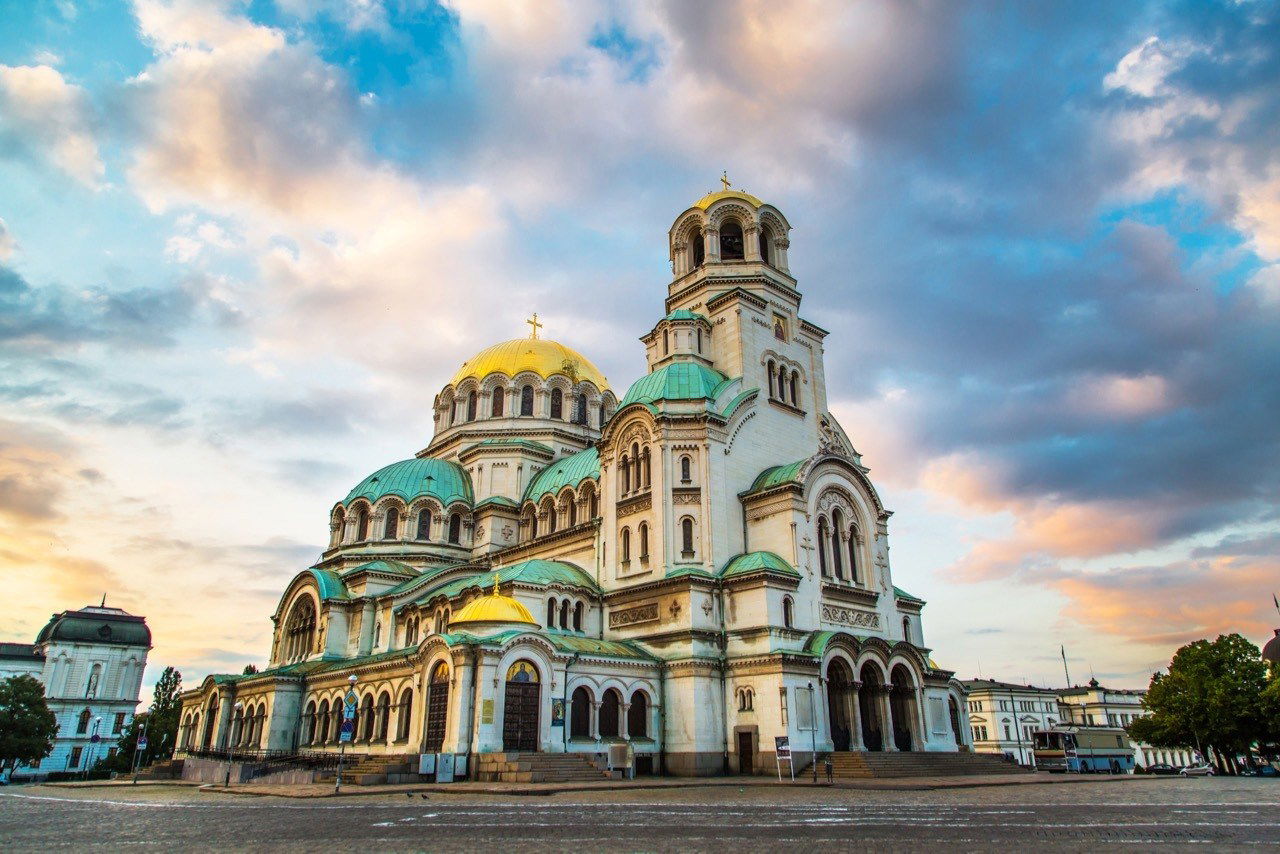
The prominent domed Alexander Nevsky Cathedral stands as a noteworthy religious landmark in Bulgaria and is one of Europe’s most significant Orthodox Christian Cathedrals. The prominent domed Alexander Nevsky Cathedral stands in the heart of the city center. Construction of the Cathedral commenced in 1904, with completion in 1916 in honor and memory of the thousands of lives lost throughout the rebellion against the Ottoman Empire from 1877 – 1878.
The Byzantine religious architecture from the 11 th century is adorned with ornate gold leaf domes and provides sanctuary for 5000 worshippers. It’s worth stepping inside the dimly lit interior to admire the decorative work of high columns and detailed frescoes.
Church of St Nicholas, the Miracle Maker – ‘Russian Church’
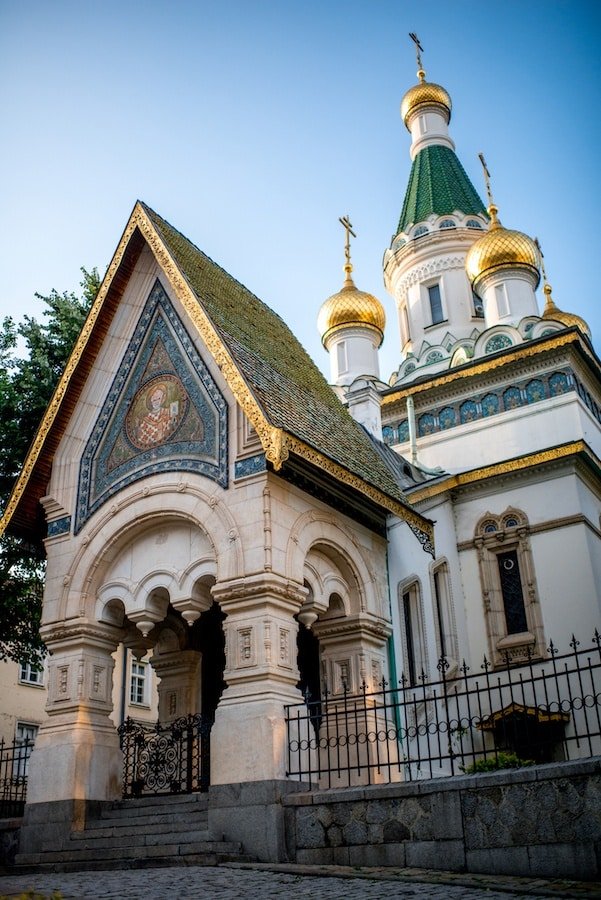
This sweet and ornately designed and colored church, aptly named the ‘Russian Church,’ was built following Bulgaria’s liberation and the end of Ottoman rule.
The 17-century Moscow architecture-designed church has five golden domes and symbolizes light in itself. At the onset of WWII and seeing the Bulgarian Monarchy being overthrown by the Russian Communist Party, leading to nearly 50 years of Communist rule in Bulgaria. During this time , Bulgarian people were unable to attend any church services.
However, the foresight of the then-presiding Bishop, Vladyka Seraphim, worked hard and formed a committee that gained him support for those in need. During his sermons, he appealed to parishioners to donate to support others who required food, health services, and housing, thus becoming known for his gift of being a ‘miracle maker.’
Ivan Vazov National Theatre
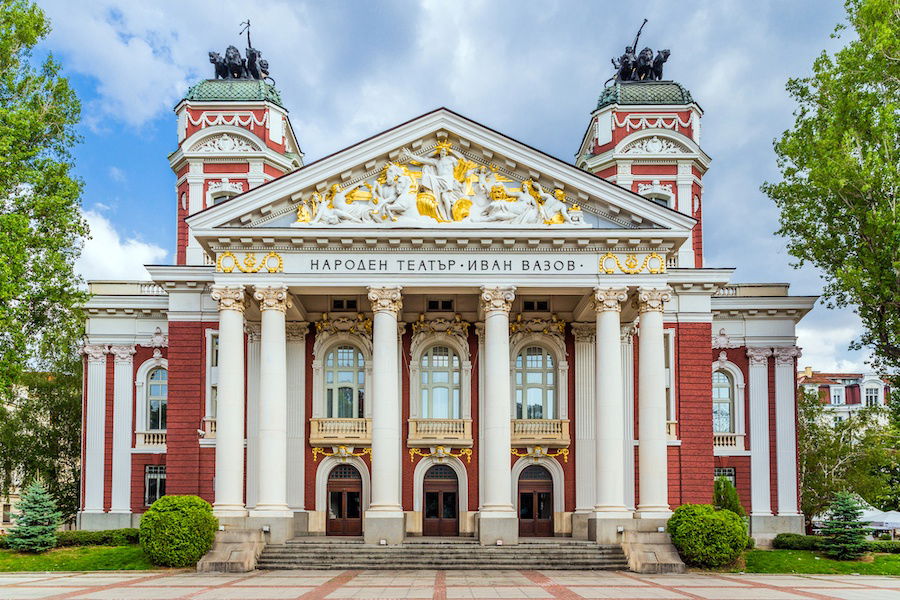
Amongst the many beautiful architecturally designed buildings in Sofia, one that is striking is the Ivan Vazov National Theatre. Bulgaria’s national theatre.
You’ll find the Ivan Vazov National Theatre, located and adjourning the large leafy treed City Gardens. The theatre’s neoclassical design is the oldest in the country. There is a choice of cafes; however, why not grab yourself a takeaway option and relax in the gardens listening to the sounds of the dancing ballerina water fountain?
As you roam the inner city center that is outlined by yellow-painted cobbled stone pavements and the wider city center, take note of the many other beautiful architecturally designed buildings, like the Sofia University, Sofia City Art Gallery, Central Military Club, National Gallery of Theatre and Film that was formerly a Palace and too many more to list.
Also, note the many varied statues, monuments, and art structures dotting the city center. You’ll also find several open green spaces and public parks throughout the city center – a very inviting place to be.
More things to see and do in Sofia can be found here.
Where to eat in sofia.
For a tasty breakfast, look no further than a local bakery. Many sell freshly baked traditional Bulgarian pastry, Banitza, a traditional breakfast snack .
Made In Blue
For a seasonal taste sensation, make your way to ‘Made In Blue’ on Yuri Venelin 6, in the heart of the city. The unique retro and artsy style décor brings new life to restoring an old traditional abandoned home, with the buildings, a namesake blue exterior, and a delightful terrace garden.
The cafés quirky and quaint, and the welcoming atmosphere feels like home. Yet, you won’t find traditional Bulgarian , Italian, French, or Turkish food. The menu offers a mouth-watering selection of tasty homemade dishes from the Middle East and other in-season salads.
Diwan Iraqi Restaurant
The aroma of Arabic spices fills the air as you make your way through Sofia’s largest, busiest, and 140-year-old market, Zenski Pazar (Ladies Market), in Sofia’s Arabic neighborhood –Car Simeon.
After roaming the local markets and experiencing all the market has to offer, you’ll no doubt feel a little hungry. Located on a corner close to the market’s main thoroughfare, you’ll find a more traditional Middle Eastern restaurant, Diwan Iraqi restaurant, just off a small lane.
It’s a simple menu in a simple setting and good value delicious food .
Confetti Gelataria
And to satisfy your sweet tooth, make a stop at Confetti, a fabulous traditional homemade Italian Gelataria, and restaurant. The restaurant offers a wide choice of healthy meals in a relaxed atmosphere. They offer an extensive selection of traditional Italian gelato flavors to seriously decadent ice-cream creations that are more like a work of art.
Strawberry-topped salted caramel gelato with amaretto biscuits and a swirl of amaretto liquor. Hmmm, mmm, treat your taste buds.
Now it’s time to explore further afield, and a great way to travel in Bulgaria is by car. You can get to these sights with a vehicle – all of them are very easy day trips from Sofia.
Here are some other cafes and restaurants to check out.
2nd day in bulgaria: rila monastery – rupite hot springs- rupite village – st petka of bulgaria memorial temple.
These locations are approx. 1 hour apart. You have time to spend a few hours at each location.

Rila Monastery
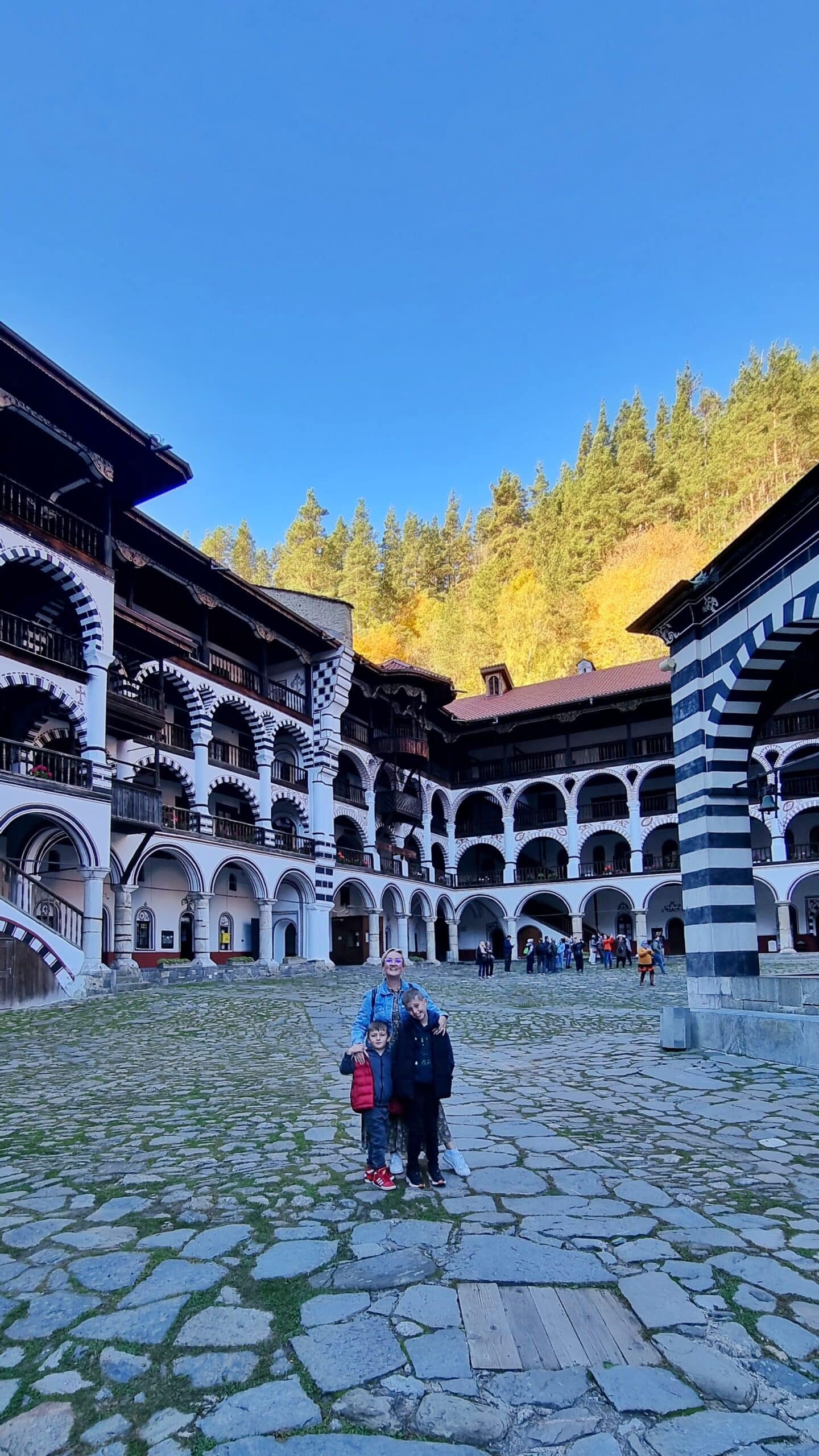
Staying in Sofia as a base provides an excellent opportunity to experience several other different and diverse regions within Bulgaria. Bus services are available (with much longer travel times) and guided day tours are also available. On my Bulgaria itinerary, I made all of these day trips noted below in a hire car from Sofia.
Take a 1 ½ hour drive south towards the Bulgarian/Greek border along the A3, then exit towards and through the lush green Rila Mountains to visit Rila Monastery . The largest Orthodox Monastery in Bulgaria .
Initially, the monastery was built as an education center for students following the religious teaching by the hermit St. John of Rila. Today it is an important cultural and spiritual center of the Balkans and is pictured on Bulgaria’s 1 lev banknote.
Rupite Natural Hot Springs
A car is the only accessible means to visit these lesser-known natural open-air hot springs (aside from local knowledge). Around a 1 ½ hour drive south towards the Bulgarian/Greek border along the A3 and following signs to Petrich.
Then note signs to the Ancient City of Heraclea Sintica. The natural springs are located approximately 2 km from the village of Rupite at the foot of Kozhuh Mountain, an extinct volcano .
RupiteVillage – St Petka of Bulgaria, Memorial Temple
In the area, take a 5 min drive from the natural hot springs and visit the Memorial Temple, St Petka of Bulgaria.
The non-traditional designed church was built within the grounds now known as the “Vanga Complex” in 1994 from money provided by the prophet Vanga, born as Vangeliya Gushterova. During the prophet’s childhood years, local legend claims that she lost her sight in a storm and subsequently had her first vision, unlocking what is said to be her remarkable prophecies. Originally from the small village of Rupite, it is also claimed that the prophet found the area around the natural hot springs provided a healing energy source that enhanced her intuitive insights.
The prophet Vanga is well known by the Bulgarian people, and the St Petka Memorial Temple attracts thousands of worshipers seeking solace. Together with many tourists from other countries worldwide, visit the small museum showing photos of the prophet’s life and her modest home where she lived her last years and meet with people seeking her help. As you walk the grounds, enjoy the outdoor garden areas, relax in one of the garden’s gazebos, or picnic on the manicured grass lawns.
The prophet’s grave can be seen at the foot of the bell tower adjacent to the church.
Place To Visit On Day 3: Plovdiv
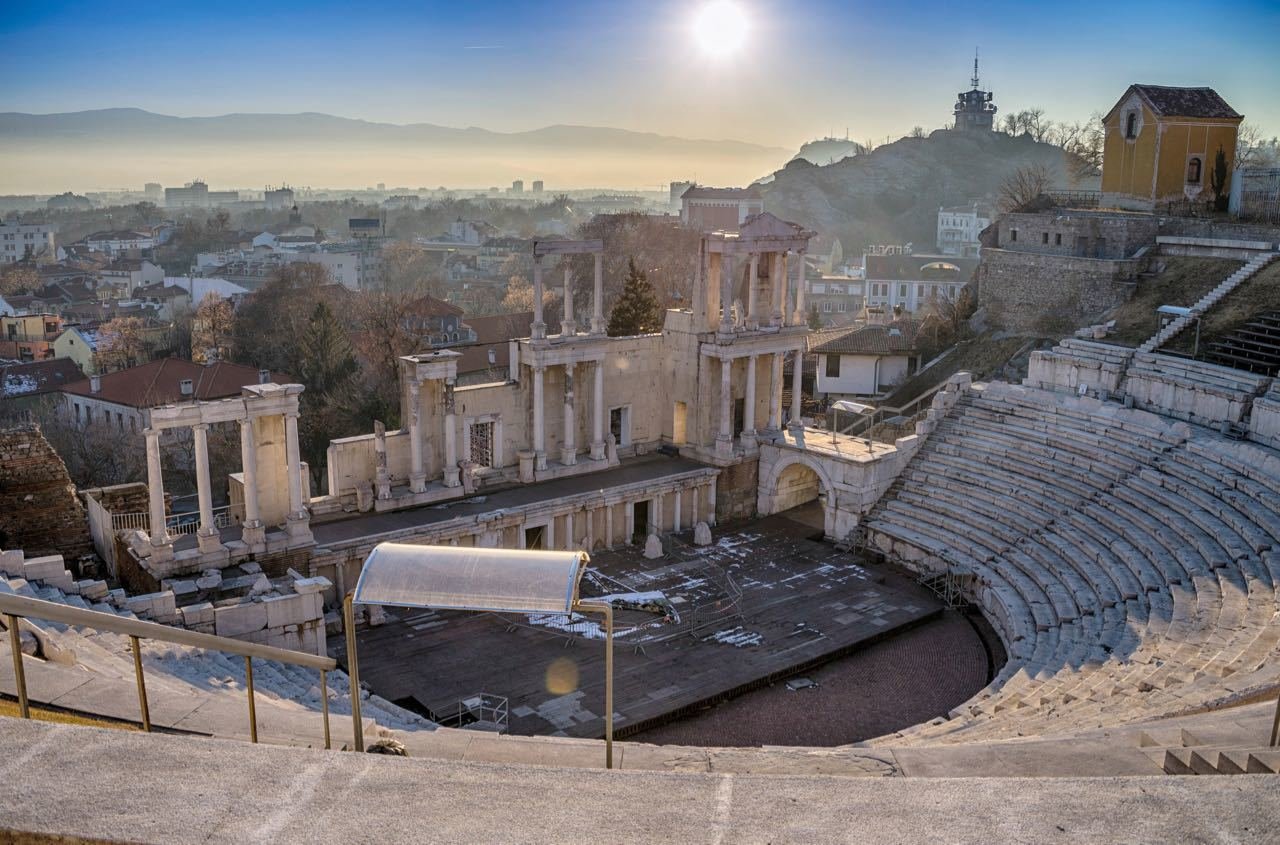
Well worth taking a scenic drive to experience Plovdiv’s beauty and spend a whole day here (this is the longest day of the three days).
1 ½ hour from Sofia, in the western region of the Upper Thracian Valley, you’ll find one of the oldest cities in Europe and Bulgaria’s second-largest city – Plovdiv .
Plovdiv’s old center is rich in history and was titled the European Capital of Culture in 2019. Evidence shows that early habitation dated back to the Stone Age and was found in the Bronze and Iron Ages. Around 400BC, the people known as Thracians founded the land of modern Plovdiv under the name Eumolpius.
The proceeding centuries show tumultuous change, change, and more change with Greek state rule, Roman rule, Slavic settlement, Byzantine rulering Greek Constantinople, various rebellious uprisings, and defeats of Ottoman rule. Change continued with Bulgaria coming under Russian communism following WWII and the preceding 45 years until the collapse in 1989. In 2004 Bulgaria joined NATO and later joined the EU; however, it retained its national currency – the Bulgarian Lev.
With the many changes between friends and foes, Plovdiv is now home to a cultural mix left by the various ruling occupations. Today, the city’s charm, open public parklands, and a blend of Empire-ruled architecture throughout its historic past contribute to the city’s prosperity.
With its unique mix of cobbled stoned streets, Plovdiv Old Town, lined with 150-year-old beautifully restored, painted residences, and its well-preserved Roman Ancient Stadium, together with Dzhumaya Mosque, oozes a charming, charismatic, and calming feel.
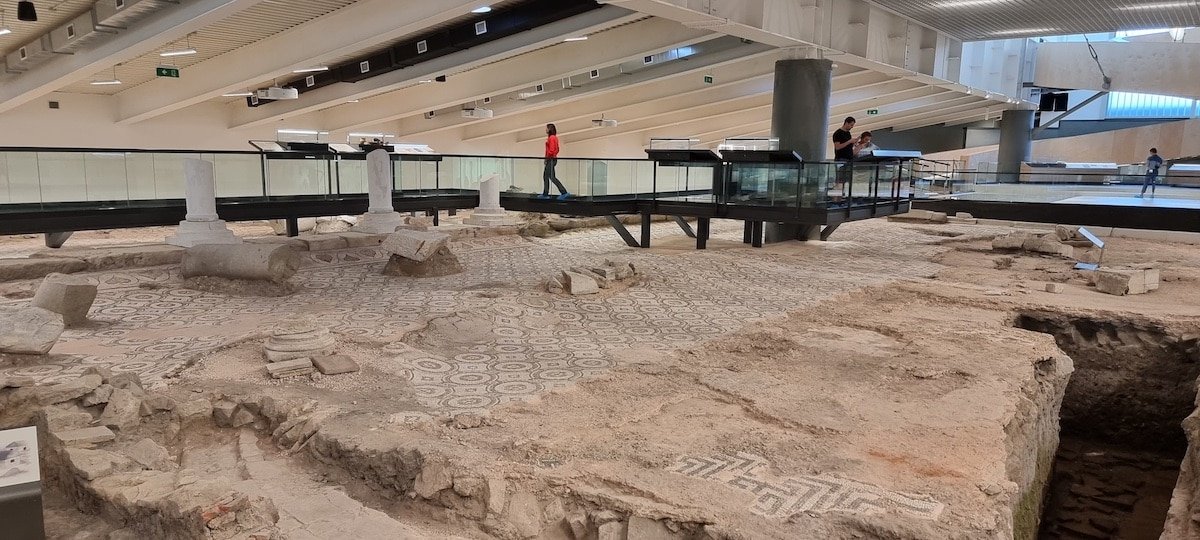
The Ancient Roman Stadium runs under the main shopping street of the Old Town. Built with fourteen tiers of marble blocks to provide seating for up to 30,000 spectators during the 2 nd century, it is one of the most notable landmarks in the city center.
Across from the ancient stadium in the heart of the pedestrian zone stands Dzhumaya (translated as Friday) Mosque, one of the oldest and most prominent in the Balkans. The Mosques’ pink painted minaret stands at a towering 23 meters, and the dusky pink brickwork indicates the Mosque was built during the 14 th century.
The Roman Stadium, the Dzhumaya Mosque, and other ornate architecturally designed buildings nearby make for a very contrasting 360°view.
Plovdiv’s Old Town Center has an array of places to eat, and like other cities and larger townships across the country, it has lovely outdoor public parklands. Sit a while and watch the locals playing board games, or enjoy the surroundings of the lush green lawns and shady trees.
Read more about what to see and do in Plovdiv here!
Day 4 around bulgaria: bansko (old town & ski resort) – blagoevgrad province day trip.
Next in your Bulgaria itinerary is to take in the sights of the Old Town, experience lunch in a local/traditional mehana, and perhaps take an opportunity to treat oneself to a day spa treatment.
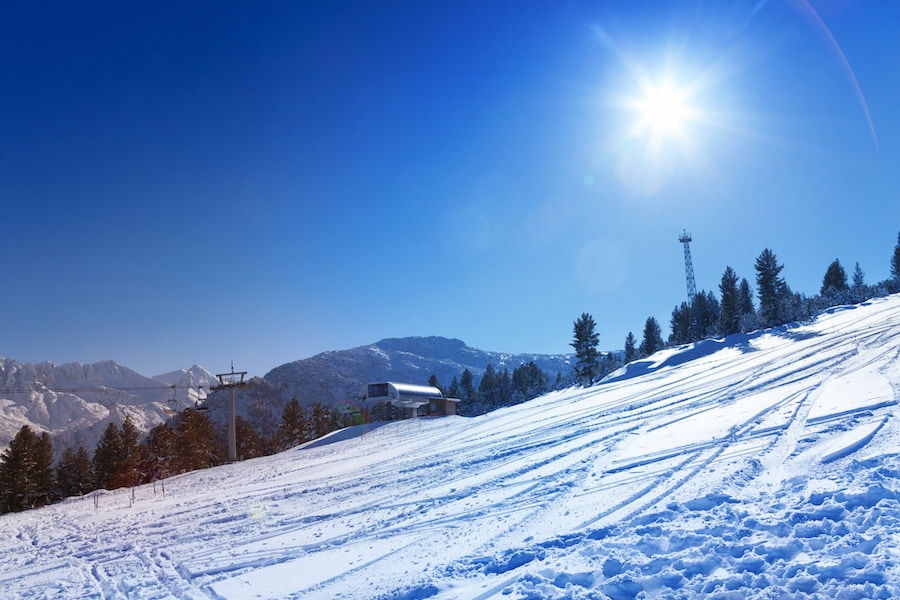
A 1 ½ hour drive south towards the Bulgarian/Greek border along the A3 and following signs to Bansko, located at the foothills of the Pirin mountains.
In recent years, the township of Bansko has become home to one of Bulgaria’s top tourist destinations for snow skiing and snowboarding. It’s also fast becoming one of Eastern Europe’s more popular ski resort locations.
As a ski resort location, Bansko is ideal during the winter; however, it is also a natural haven for outdoor hiking enthusiasts during the warmer months in the Pirin National Park.
Bansko’s location, nestled in the Razlog Valley, also provides an abundant supply of water reserves flowing from the many tributaries of the Mesta River and the pristine glacial lakes. You can also find plentiful options to enjoy the many hot springs and day spas in Bansko and the surrounding area.
For the history enthusiast, Bansko’s old town will not disappoint. The area’s rich and historical past has archaeological evidence showing that the Bansko and the Razlog Valley inhabitants date back to 100BC and periods of the Roman Empire.
Find yourself walking down the main pedestrian-only thoroughfare of Bansko Old Town and admire the unique architecture dotted between many stores and a very modern monument located in Vazrajdane square. The monument was built in honor of the Bulgarian philosopher Paisiy Hilendarski in 1976 and commemorated his ideas for national self-awareness and liberation from the Ottoman occupation.
As you continue past Vazrajdane square, you’ll notice a high enclosed wall surrounding a simple and well-maintained garden surrounding the church of “Sveta Troitsa” – Saint Trinity, a Bulgarian Orthodox Christian church.
The humble exterior can appear deceptive; however, step inside from the side entrance and feast your eyes on the ornate, colorful, and exquisite interior. Chandeliers light the interior and shine a golden glow on the gold-gilded frames housing icon images.
This humble church was built during Ottoman rule, taking nearly 45 years to complete both the church and the free-standing clock tower in the garden. The local church founders paid heavy taxes to the Ottoman rulers during this period, extending the church’s construction beyond normal.
There are many choices of traditional restaurants, known as mehana, in the old town. You’ll also find bars, cafés, many creperies, boutique clothing, and of course, many ski wear stores and traditional ceramic wares and souvenirs .
More info on Bansko can be found here.
Exploring sofia – the capital of bulgaria on day 5.

There is just no way you can see all of Sofia in one day – so be sure to use day 5 to explore the parts you missed on your first day in the city.
Brands We Use And Trust
Extra bulgarian idea.
We’ve covered five days in Bulgaria, but if you have time and are in Bulgaria in June, check out the Rose Valley .
Rose Valley
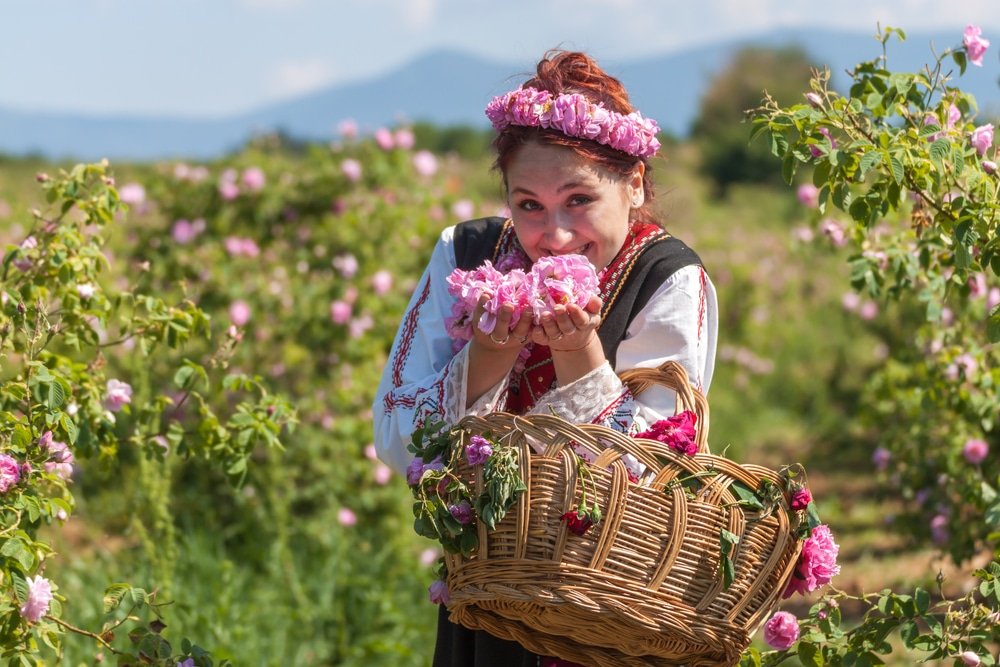
During the first weekend of June, the Central Bulgaria township of Kazanlak is blossoming with roses and the annual rose festival and harvest time are underway. The festival boasts a tradition of gathering roses early in the morning by people dressed in traditional clothing, with folk dancers, singers, and musicians performing in the rose fields.
Driving from Sofia to Kazanlak is approx. 2 ½ hours; however, be sure to visit the Damascena Ethnographic complex of Kazanlak, a short drive on the outer regions of the town center. Enjoy learning more about the production of pure organic rose essential oil. Experience the rose distillation process and the sweet scent of delicate Damascenaroses. Stop by the gift shop and buy yourself a gift to take home.
I trust you will enjoy your short 5-day stay experiencing Bulgaria’s capital – Sofia. Soaking up and admiring the city’s beauty , history, and blend of uniquely beautifully designed architecture. Along with sampling some of the regional highlights and treasures.
For top hotels around Bulgaria, check out our guide here!
Move this adventure to your inbox & get an instant freebie.

No spam. Unsubscribe at any time.
Best Time to Visit Bulgaria

The perfect Bulgaria trip depends a lot on timing. To catch Bulgaria at its best, aim for late spring (May to June) or early autumn (September to October). These months offer pleasant weather, fewer crowds, and the natural beauty of Bulgaria in full bloom or the golden hues of fall.
Summer is fantastic along the Black Sea coast if beach time is what you’re after.
But, if you’re keen on skiing in Bansko or exploring the cities without the chill, winter can be magical too. Each season has its charm, so think about what you want to see in Bulgaria and plan accordingly.
How to Get Around Bulgaria
Navigating Bulgaria can be part of the adventure. Hiring a car gives you the freedom to explore at your pace, perfect for those wanting to visit the best places scattered across the country.
For city hops, like from Sofia to Plovdiv, consider the well-connected buses – they’re affordable and offer a glimpse into everyday Bulgarian life. Within cities, public transport systems are usually reliable and easy to use, making it straightforward to see the best of what each city in Bulgaria has to offer.
Don’t shy away from using taxis for shorter distances; just make sure they’re metered.
Other Places to Visit in Bulgaria Worth Visiting
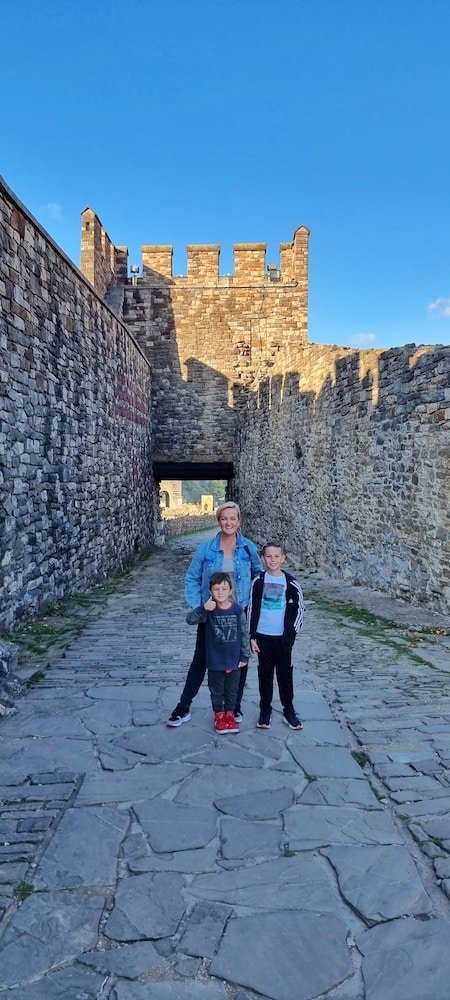
If your trip to Bulgaria extends beyond 5 days, you’re in for a treat. Beyond Sofia, Plovdiv, Rila Monastery, and Bansko, Bulgaria is teeming with hidden gems.
The Black Sea coast is lined with beautiful beaches and historical towns like Nesebar, while the interior boasts natural wonders like the Belogradchik Rocks. Veliko Tarnovo, the medieval capital of Bulgaria, offers a journey back in time with its fortress and panoramic views.
Each part of Bulgaria has something unique to offer, from ancient history to natural beauty, making it easy to fill your days by enjoying everything the country has to offer.
Whether you go on a day trip or decide to spend more time in one of these locations, you’ll find that Bulgaria is located perfectly for those who love a mix of cultural and natural attractions.
Find The Right Place To Stay In Bulgaria
- Things To Do In Sofia
- Things To Do In Varna On The Black Sea
- Best Day Trips If You Have Three Days In Sofia
- When Is The Best Time To Visit Bulgaria
- Why You Should Visit Shumen
- Rent A Car Bulgaria
- Where To Stay In Sofia
- Best All-Inclusive Hotels In Bulgaria
- Best Campsites In Bulgaria
- Where To Stay In Veliko Tarnovo
great overview, including where to eat. Thank u so much.
Leave a Reply Cancel reply
Your email address will not be published. Required fields are marked *
Save my name, email, and website in this browser for the next time I comment.
This site uses Akismet to reduce spam. Learn how your comment data is processed .
Subscribe To Unlock Your FREE Customizable Travel Packing List & All Our Best Tips!
Unlock Your FREE Customizable Travel Packing List!
Subscribe Now For Instant Access To Stress-Free Packing
Travel Guide Bulgaria
Book your individual trip , stress-free with local travel experts
- roughguides.com
- Travel guide
- Local Experts
- Travel Advice
- Accommodation
Plan your tailor-made trip with a local expert
Book securely with money-back guarantee
Travel stress-free with local assistance and 24/7 support
With several dramatic mountain ranges, superb beaches, numerous historic towns and a web of working villages with traditions straight out of the nineteenth century, Bulgaria has a wealth of attractions crammed into a relatively compact country. More than anything else, this is a land of adventures: once you step off the beaten track, road signs and bus timetables often disappear (or are only in Cyrillic), and few people speak a foreign language, but almost everyone you meet will be determined to help you on your way.
Where to go in Bulgaria
Tailor-made travel itineraries for bulgaria, created by local experts.

7 days / from 1926 USD
Relaxing beach fun - the Black Sea Coast in Bulgaria and Romania
The perfect trip for those that are looking for sun, sea and sand while also getting to know the culture and history of both Bulgaria and Romania. Start and end in Bucharest and discover Constanta, Sunny Beach, Nessebar, Burgas and Madara Rider.

8 days / from 1926 USD
The legend of Dracula
Transylvania is known to be the land of Dracula. Are you curious to visit the places mentioned in the book and the castles that hosted the major life events of Vlad the Impaler, the cruel ruler known as Dracula? Explore mysterious places and breathtaking landscapes all over Romania.

15 days / from 3852 USD
World Heritage in Romania and Bulgaria
Discover the most important UNESCO heritage sites in Romania and Bulgaria as well as some lesser-known attractions. From the capital Sofia to Plovdiv and Nessebar, as well as Veliko Tarnovo in Bulgaria to Romania's capital Bucharest to Sibiu, Cluj and Dracula's castle in Brasov.
Bulgaria's image has altered dramatically in recent years, thanks largely to the modernization of the country's tourist infrastructure coupled with soaring foreign interest in inexpensive rural and coastal properties. Independent travel is common: costs are relatively low, and for the committed there is much to take in. Romantic National Revival era architecture is a particular draw, with Koprivshtitsa, Bansko and Plovdiv foremost amongst examples of the genre. The monasteries are stunning too – the finest, Rila, should be on every itinerary, while for city life aim for Sofia, Plovdiv, and the cosmopolitan coastal resorts of Varna and Burgas.

Top image: Orthodox Rila Monastery © Dennis van de Water/Shutterstock
Discover more places in Bulgaria

Population 7.3 million
Area 110,910 sq km
Language Bulgarian
Currency Lev (Lv)
Capital Sofia (population: 1.35 million)
International phone code t 359
Travel advice for Bulgaria
From travel safety to visa requirements, discover the best tips for traveling to Bulgaria
- Culture and Etiquette in Bulgaria
- How to get to Bulgaria
- Eating and drinking in Bulgaria
- Getting around Bulgaria: Transportation Tips
- Sports and Outdoor activities in Bulgaria
- Travel Tips Bulgaria for planning and on the go
- Best time to visit Bulgaria
The Rough Guides to Bulgaria and related travel guides
In-depth, easy-to-use travel guides filled with expert advice.

Find even more inspiration here

Planning your own trip? Prepare for your trip
Use Rough Guides' trusted partners for great rates
written by Rough Guides Editors
updated 26.04.2021
Ready to travel and discover Bulgaria?
Get support from our local experts for stress-free planning & worry-free travels.
- Where to stay
- Travel advice
- Statiuni Bulgaria
- Nisipurile de Aur (68)
- Sunny Beach (81)
- Albena (35)
- Nessebar (10)
- Balchik (17)
- Constantin si Elena (10)
- Kavarna (3)
- Kranevo (7)
- Sveti Vlas (13)
- Sozopol (8)
- Pomorie (4)
- Arkutino (2)
- Elenite (6)
- Statiuni Turcia
- Marea Egee (125)
- Kusadasi (40)
- Bodrum (46)
- Marmaris (25)
- Fethiye (8)
- Antalya (82)
- Statiuni Grecia
- Halkidiki (119)
- Sithonia (30)
- Kassandra (79)
- Insule Grecia (138)
- Thassos (71)
- Lefkada (39)
- Ammouliani (3)
- Riviera Olimpului (41)
- Ski Bansko (60)
- Ski Borovets (24)
- Ski Pamporovo (21)
- Oferte cazare Bulgaria (288)
- All inclusive Bulgaria (224)
- Ultra All inclusive Bulgaria (27)
Recomandari Bulgaria (81)
Hoteluri aqua park bulgaria (40).
- Last minute Bulgaria (14)
- Hoteluri family club Bulgaria (19)
- Hoteluri 5 stele Bulgaria (38)
- Hoteluri de lant Bulgaria (47)
- Premium selection Bulgaria (46)
- Hoteluri adults only Bulgaria (7)
- Oferte animale de companie Bulgaria (92)
- Relaxare si odihna Bulgaria (100)
- Hoteluri pe plaja Bulgaria (105)
- Hoteluri aproape de Romania (61)
- Weekend Bulgaria
- Promotii Bulgaria (5)
Hoteluri superior (32)
- Hoteluri premium
Hoteluri confort (99)
Hoteluri standard (71), hoteluri low cost (86).
- Last minute Grecia (8)
- Hoteluri 5 stele Grecia (59)
- Recomandari Grecia (100)
- All inclusive Grecia (125)
- Hoteluri family club Grecia (38)
- Hoteluri pe plaja Grecia (154)
- Hoteluri all inclusive Thassos (25)
- Hoteluri mic dejun Grecia (208)
- Hoteluri animale de companie Grecia (56)
- Hoteluri relaxare Grecia (271)
- Hoteluri spa Grecia (61)
- Oferte rusalii Grecia
- Last minute Turcia (2)
- Recomandari Marea Egee (2)
- Family club Marea Egee (72)
- Hoteluri aqua park Marea Egee (27)
- Hoteluri all inclusive Turcia (145)
- Hoteluri de lux Marea Egee (37)
- Hoteluri de lux Turcia (57)
- Hoteluri 5 stele Marea Egee (76)
- Hoteluri 5 stele Turcia (166)
- Blog - sfaturi de vacanta
Cele mai bune oferte de vacanta litoral Bulgaria 2024
- TravelPlanner.ro
Vacanta litoral Bulgaria 2024
In 2024, va invitam la relaxare in vacanta la Marea Neagra in Bulgaria, spre bucuria intregii familii. Cantecul valurilor, nisipuri fine, plaje generoase si curate,obiective turistice interesante, mancare gustoasa si cazare la preturi imbatabile. Acesta este litoralul din Bulgaria. Pachetele ultra-all inclusive la preturi avantajoase, plajele bine amenajate, ospitalitatea bulgareasca si optiunile de distractie pentru tineri si seniori sunt argumentele pentru care turistii romani aleg anual statiunile de pe litoralul bulgaresc.
Oferte Paste si 1 Mai (47)
Vacante mai - iunie (70), oferte rusalii bulgaria (59), super hoteluri cu demi pensiune (17), outlet de vacante - 1 mai si paste (20), ultra all inclusive bulgaria (27), top 15 oferte pentru o vacanta pe litoralul bulgariei in 2024.
In functie de perioada in care alegeti sa va petreceti vacanta in Bulgaria alegeti din ofertele promotionale pentru vacanta dumneavoastra pe litoralul Bulgariei. Ofertele de mai jos sunt cu un raport calitate pret foarte bun si totodata sunt propuse de noi pentru un sejur reusit in 2024.
Hotel Topola Skies Resort Aquapark
Hotel grifid noa, hotel grifid sentido marea, hotel white lagoon resort, hotel astera, hotel berlin golden beach, hotel royal palace helena park, hotel grifid vistamar, hotel grifid encanto beach medispa, hotel melia grand hermitage, hotel alua helios bay (ex riu), ensana aquahouse health spa hotel, hotel astor garden, hotel atlas, sunshine hotels dolce vita, hotel sunrise blue magic resort, hotel odessos park, hotel dreams resort and spa (ex riu helios paradise), hotel sol nessebar palace, hotel berlin green park, te-ar mai putea interesa in bulgaria, cele mai populare categorii de hoteluri pentru vacante in bulgaria, all inclusive bulgaria, ultra all inclusive bulgaria, hoteluri aproape de romania, relaxare bulgaria, accepta animale de companie, hoteluri doar pentru adulti, hoteluri 5 stele bulgaria, oferte la hoteluri cu all inclusive in bulgaria, all inclusive nisipurile de aur, all inclusive pomorie, all inclusive sozopol, all inclusive kranevo, all inclusive duni, all inclusive sveti vlas, all inclusive elenite, all inclusive nessebar, all inclusive constantin si elena, all inclusive obzor, all inclusive albena, all inclusive sunny beach, all inclusive sunny day, cele mai bune oferte in bulgaria, oferte 1 iunie bulgaria, oferte weekend bulgaria, oferte last minute bulgaria, oferte 1 mai bulgaria, oferte rusalii bulgaria, oferte paste bulgaria, hoteluri in bulgaria dupa categoria de confort, oferte pentru vacante in cele mai populare statiuni de pe litoralul bulgariei in 2024, nisipurile de aur, sunny beach, impresiile turistilor care au fost in vacanta in bulgaria., vacanta de familie reusita, o vacanta de vis, vacanta bulgaria, sunny day-locul unde iti incarci bateriile, o sarbatoare frumoasa pentru 1 mai si pastele ortodox, holiday village nu este un hotel, este un complex de casuta, impresionant, cum sa nu vrei sa mergi in bulgaria, boryana - o surpriza placuta de 3 stele, cea mai frumoasa vacanta la mare, ma intorc cu placere la slavey, departe de plaja, o minivacanta reusita, foarte ok peste asteptari.., o vacanta excelenta , o vacanta superba , un concediu linistit, un sejur excelent, vara iulie nisipurile de aur hotel luna, super distractie , vacanta aproape perfecta, recomand, economie la maxim, vacanta placuta, un sejur relaxant, super vacanta de 1 mai la nessebar mare, o experienta frumoasa, un vis care s-a terminat prea repede , o vacanta foarte reusita., vacanta in bulgaria in statiunea sf,constanti &elena, vacantă la resort sol nessebar, vacanta la mare in nessebar, hotel majestic recomandat pentru familiile cu copii, cel mai bun raport calitate pret, vacantica de nota 10, vacanta minunata, vacanta linistita la mare mergem si anul urmator, foarte multumit, vacanta dosebit de odihnitoare la evrika, o vacanta linistita cu multe bune si putine rele, o vacanta scurta dar reusita, o vacanta placuta si relaxanta, profesionalism, o vacanta totusi reusita la riu evrika, o vacanta superba, hotel excelent, calitate germana..., cu siguranta ne vom intoarce, pret bun, oferta peste asteptari la acest pret, totul peste aè™teptäƒri, o alegere buna, sol nessebar bay - bulgaria, multumit, multumim, impresie buna, cu mici exceptii, sa iesim din conservatorism, sejur reusit, sejur kavarna royal bay, obzor beach resort - un alt fel de hotel, albena.....revenim, travel planner firma serioasa, ceva frumos trece atat de repede..., am ramas impresionati, neasteptat de placut va recomand, sincer primasol ralitsa superior, m-au convins, grifid arabella-vacanta de distractie dar si relaxare, o vacanta de neuitat, un concediu resusit , vacanță minunată, a treia oara la duni, si ca de fiecare data extrem de bine., un sejur reusit, a fost bine, fotografii primite de la turistii care au vizitat bulgaria.
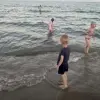
Articole despre vacantele in statiunile de pe litoralul Bulgariei
Despre sunny beach, cea mai animată stațiune de pe coasta mării negre din bulgaria, despre vacantele in nisipurile de aur bulgaria. ce trebuie sa stii, aproape totul despre vacantele in statiunea albena bulgaria, despre statiunea obzor bulgaria. tot ce trebuie sa stii pentru viitoarea ta vacanta, despre statiunea balcic bulgaria, ideala pentru o mini-vacanta aproape de casa, totul despre vacanta in statiunea constantin si elena, bulgaria. de ce sa-ti petreci concediul aici, despre nessebar bulgaria - una din cele mai importante atractii ale litoralului, despre sozopol bulgaria, orasul artistilor de la marea neagra, statiunea duni bulgaria, perfecta pentru vacantele all inclusive familiilor cu copii, despre statiunea sveti vlas din bulgaria si avantajele unei vacante linistite, despre obiective, plaje si alte articole interesante despre vacantele in bulgaria, 7 statiuni mai putin cunoscute pe litoralul bulgaresc. ce trebuie sa stii despre ele, ghid top plaje bulgaria. cele mai frumoase si mai bune plaje, cele mai importante atractii din bulgaria si alte obiective care merita vazute, litoral romania vs litoral bulgaria. comparatie intre cele doua destinatii de vacanta, conditii de calatorie si sfaturi practice pentru o vacanta in bulgaria. ce e bine de stiut, ghid pentru turistii care merg pentru prima data in turcia, in zona marii egee, 5 motive pentru vacante in bulgaria.
1.Marea si plaja sunt curate, bine intretinute de catre autoritatile statiunilor si creaza o atmosfera placuta pentru vacanta pe litoral.
2.Avand in vedere tarifele, in special la hotelurile de 4 si 5 stele, veti beneficia de conditii si servicii cu un raport calitate / pret foarte bun.
3.Majoritatea hotelurilor, in 2024, ofera cazare all inclusive Bulgaria - un PLUS in ceea ce priveste bugetul de calatorie.
4.Copiii beneficiaza de reduceri si de spatii special amenajate pentru joaca in majoritatea statiunilor
5.Este aproape si o alternativa foarte buna pentru litoralul romanesc.
Intrebari frecvente despre vacantele pe litoralul Bulgariei
Care sunt cele mai bune oferte ale momentului pe litoralul bulgariei.
Monitorizam si analizam zilnic ofertele hotelurilor de pe litoralul Bulgariei. Gasesti pe site-ul nostru oferte speciale de pana la 30% - 35% pentru rezervari pana la 31.12.2020. Printre hotelurile cu cel mai bun raport calitate pret in momentul de fata mentionam Hotelurile Riu, Hotel Reina del Mar, Hotel Grifid Marea, Hotel Sol Nessebar, Hotel Evrika Beach, Hotel Melia Grand Hermitage
Vacantele in Bulgaria sunt potrivite familiilor cu copii?
Daca iti doresti o vacanta in care sa te simti bine alaturi de copii, litoralul bulgaresc este o destinatie la indemana, foarte aproape si foarte potrivita pentru familiile cu copii. Aici vei gasi variante de cazare all inclusive foarte avantajoase din punct de vedere calitate pret, dar si pentru facilitatile pe care le ofera: aqua park, servicii incluse pe plaja, animatie samd. Turistii apreciaza in proportie de 89% vacantele all inclusive in Bulgaria (peste 18000 de impresii).
Care sunt conditiile de rezervare pentru vacante in Bulgaria, in contextul COVID-19?
Indiferent de contextul covid, oferim conditii superflexibile de rezervare, cu posibilitatea de a achita in rate cu avansuri incepand de la 5% si fara penalizare in caz de anulare. In context covid, oferim: anulare gratuita, reprogramare, acordare voucher sau rambursare in caz de carantina la destinatie sau la intoarcerea in tara, test covid pozitiv, inchiderea granitelor, solicitare test PCR negativ de la destinatie. Consulta ofertele noastre si contacteaza-ne pentru mai multe informatii despre rezervari.
De ce sa rezerv prin Travel Planner o vacanta in Bulgaria?
Ajutam in special familiile cu copii care doresc sa calatoreasca in Bulgaria, sa planifice eficient vacante reusite la un pret covenabil. Ne recomanda cei 13 ani de experienta si recomandari de 98% din partea a peste 18.000 de turisti care ne-au trimis parerile lor despre vacantele in Bulgaira. Te invitam sa consulti ofertele noastre.
Cat costa o vacanta pe litoralul Bulgariei?
Pretul vacantelor pe litoralul bulgaresc variaza in functie de perioada si confortul oferit de hoteluri. In varf de sezon (iulie - august), pentru 5 stele cca 700 euro, 4 stele 500 euro, 3 stele 300 euro. In extra sezon (mai - iunie / septembrie) pentru 5 stele cca 300, pentru 4 stele 200 euro, pentru 3 stele 150 euro. Tarifele sunt orientative si au fost calculate pentru 5 nopti, 2 adulti, all inclusive
Care sunt cele mai importante statiuni de pe litoralul bulgaresc?
Regiunea Varna este cea mai apreciata pentru vacantele in Bulgaria si aici gasim statiunile Albena si Nisipurile de Aur. Desi putin mai departe, spre sud, Sunny Beach este cea mai mare statiune de pe litoralul Bulgariei, asadar inevitabil este una din cele mai preferate statiuni de pe litoralul bulgaresc.
Pot sa calatoresc in Bulgaria in acest moment?
Momentan se poate calatori cu acceptarea carantinei timp de 14 zile sau cu efectuarea testului la 8 zile dupa intoarcere, iar in a noua zi 9 daca rezultatul e negativ e totul in regula. Lista tarilor galbene pentru care se impune carantina la intoarcere se actualizeaza saptamanal, asadar situatia se poate modifica oricand.


5 Day Bulgaria Itinerary: Best Places to Visit (2024)
Are you planning a 5 day Bulgaria itinerary? With only a short time in the country, a route and travel guide are exactly what you need to plan the best trip. Bulgaria is an incredible country, home to beautiful cities, roman history and breathtaking nature.
We’re excited to show you how to spend 5 days in Bulgaria only using public transport!
Bulgaria is located in the southeastern part of Europe, also known as the Balkans . It borders countries such as Greece, Turkey, Romania, North Macedonia and Serbia. Whether you’re on a road trip, a backpacking trip or just want to explore Bulgaria in 5 days, this itinerary will work for you.
There is so much beauty in the country – the cities are filled with historical architecture, the beaches on the west coast are wonderful and the scenery will blow you away!
After spending 5 days in Bulgaria we realised how underrated the country is compared to other places in Europe and we can’t wait to visit again. In this Bulgaria itinerary, we’re only going to scratch the surface of what Bulgaria has to offer.
We created this itinerary when travelling from Istanbul to Bucharest and wanted to dip our toes into the Bulgarian culture. 5 days is not enough time to see the whole country, but it’s a great first visit to two beautiful historic cities! They’re both some of the oldest cities in Europe !
This Bulgaria itinerary is very budget-friendly and uses public transport! If you have a car on this trip, you can still follow this route and possibly even more hidden gems in Bulgaria!

This post may contain affiliate links. We will receive a small commission if you make a purchase using these links, at no additional cost to you .
Quick Tips for a 5 day in Bulgaria Itinerary
Table of Contents (Skip to a section!)
- Currency – Bulgarian Lev (compare your own currency here )
- Language – Bulgarian (bǎlgarski)
- Cuisine – Bulgarian & Balkans (meats, grains, potatoes & pastries)
- Apps – GoogleTranslate, GoogleMaps, Booking.com , Hostelworld , Airbnb
- Power Voltage – Plugs C & F (230 V)
Here’s a list of things you can check before your trip to Bulgaria!
- Check for any public holidays in Bulgaria !
- Book your flights ( check prices here! )
- Book your accommodation ( book here for hotels & here for hostels )!
- Visiting more of Bulgaria? Here’s our 2 Day Plovdiv Itinerary & 2 Day Sofia Itinerary !
Travel Insurance – SafetyWing is a monthly-rolling travel insurance to help you stay covered during your 5 day Bulgaria itinerary or anywhere you’re travelling! – Find out more here!
Best time to visit Bulgaria
The best time to visit Bulgaria is from April to June ( Spring ) and September to November ( Fall )! However, it’s possible to visit all year round as Bulgaria experiences all four seasons!
In the winter you can head to the mountains for a ski session and when there’s no snow for the rest of the year the mountains turn into a hiking paradise. Summer does get very hot, so it may be best to head to the coast and beaches!
How to get around Bulgaria
- Buses – Travelling by bus is the best way to get between major cities in Bulgaria, you can even check times and prices online – check for tickets online ! ( We used Karat S )
- Trains – Another way to get around Bulgaria is by train, although they’re usually slower than the bus.
- Car Rental – It’s also possible to travel by car – check for prices online .
- Flying – Fly from Sofia to the beautiful beaches near Varna – check on Skyscanner !

In this itinerary, we’ll show you how to travel around Bulgaria in 5 days focusing on two cities. The route can be switched around if you’re not arriving in Sofia first, however, most people usually do! Here’s our 5 day Bulgaria itinerary!
Day 1 – Arrive in Sofia & Free Walking Tour
On the first day of your Bulgaria itinerary, try to arrive in the morning to make the most out of your trip! The city centre is easy to reach by public transport from both the airport and the bus station.
We recommend stopping by Satsanga Vegetarian Restaurant for a speedy lunch before you start to explore historic Sofia!
Sofia is located in the west of Bulgaria and is also the capital city!fr It’s one of the best places to visit in Bulgaria and deserves a spot on this itinerary. We recommend spending around 2 or 3 days in Sofia and we’ll show you the best things to do in the city.
Visit the St Alexander Nevsky Cathedral
When you type in Bulgaria on Google, you’ll be greeted with beautiful photos of St Alexander Nevsky Cathedral – it’s iconic and worth a visit during your 5 day Bulgaria itinerary.
It’s one of the main symbols of Sofia and is one of the largest Eastern Orthodox churches in the world ( top 10 ), holding up to 5,000 people. It took 30 years to build and was damaged ( and fixed ) during the war. It’s also free to visit the inside of the Cathedral.

Join a Free Sofia Tour
A free walking tour is one of the best ways to learn about Sofia’s past and to see all the highlights in the city centre. Join the 11 am or 2 pm Free Walking Tour and spend 2 hours learning about the ancient wonders of Sofia.
Our guide answered so many of our questions and shared information with us that we wouldn’t have learnt by ourselves. Free Sofia Tour offer both English & Spanish tours. There will be a guide with a sign a the Palace of Justice meeting point.
Although we recommend a walking tour, it’s possible to explore the city by yourself. In this Bulgaria 5 day itinerary, we’ll show you the highlights and famous landmarks of Sofia with a great route to follow.
There’s also a Communist Tour , Jewish Tour and a Pub Crawl introducing you to Sofia’s incredible nightlife.
Find the Statue of Sofia
St Sofia is a tall monument with a lady on the top. It’s known to be the symbol of Sofia and the Goddess of Wisdom as Sofia means Wisdom . It’s a recent addition to the city, only being built in the year 2000.
On your way to the next stop, you’ll pass by one of the oldest Orthodox churches in Sofia named Church of St Petka. Inside there are 15th-century murals and the entrance is free.
Visit the Ancient Serdica Archaeological Complex
This is a must-visit during your 5 days in Bulgaria! The Serdica Ruins were discovered recently in 2004 when the construction for the metro started. When digging into the ground the workers uncovered 2000-year-old ruins which show the main streets of a Roman city!
The area stretches both outside and inside leading to the metro and they’re easy to find in the heart of the city. It will take around 20 – 30 minutes to wander around the archaeological site of Serdica.

Admire Banya Bashi Mosque
Right around the corner from the Serdica Ruins is Sofia’s only operating mosque . It opened in 1556 during the Ottoman empire and it’s still a place of worship. The exterior of the building is beautiful and it’s next to Sofia’s Central Market Hall.
Learn about history at the Sofia Synagogue
Whilst on the Free Sofia Walking Tour we learnt that Bulgaria is the only country in Europe to keep the population of its Jewish community during the Holocaust in World War II. The country continued to delay the process of sending over anyone until the war was over.
Discover the St George Rotunda Church
Another place to visit on your Bulgaria 5 day itinerary is one of the country’s oldest and most well-preserved churches. It’s hidden by modern buildings and the President’s Palace ( which is also worth a look ), but not too hard to find.
St George Rotunda Church was created as a Roman bath about 1300 years ago – it’s also the oldest building in Europe to still have its original roof.

See the Former Royal Palace
The former Royal Palace is now Sofia’s National Art Gallery and the building is absolutely beautiful! It’s right next to City Garden and Ivan Vazov National Theatre, which are both included in the free walking tour if you want to learn more!
Admire Ivan Vazov National Theatre
The National Theatre is another lovely building and also the oldest and largest in Bulgaria. This is becoming a theme – Sofia has many old buildings! Classical shows are still performed in the theatre today.

Find dinner at the Vitosha Boulevard
After a busy first day exploring the ancient sites of Sofia on your 5 day Bulgaria itinerary, make your way to Vitosha Boulevard to browse the many shops and restaurants along the main street. The boulevard is vehicle free and has impressive views of Vitosha Mountain!
We recommend eating at Edgy Veggy , which is just around the corner from the main street. If you’re looking for any evening plans, Sofia has great nightlife. Jump on Sofia’s Hidden Bars: 4-Hour Pub Crawl or chill in one of the nearby bars before getting some good rest for the next day on your Bulgaria itinerary!

Day 2 – Head into Bulgaria’s Nature
The second day of your Bulgarian adventure is all about nature. If you want to feel like a local for the day, head to Vitosha Mountain for a beautiful hike and once back in the city, relax at one of the best parks in Sofia.
How to get to Vitosha Mountain from Sofia City Centre
The best way to get to Vitosha Mountain is by public transport. There are trams, metros and buses all over the city and it’ll be more affordable than a taxi or renting a car. Here’s how to use public transport to get to the mountain during your 5 days in Bulgaria:
- Head to Serdika Station and travel by metro to Vitosha Station .
- Outside of Vitosha Station , hop on Bus 64 and wait for the Boyansko Hanche Stop (it’s 2 minute’s walk away from Boyana Church)
The journey takes around 1 hour and 15 minutes . You can also get the number 7 tram to Gotse Delchev Stop and change to bus 64.
Money Saving Tip – At the beginning of your day, buy a transport day pass for 4 lv – you can buy them at metro stations! Tickets on the bus and metro cost 1.6 lv a journey and you’ll need to take at least 4 to get to Vitosha Mountain.

Start your day at Boyana Church
Just as you get off the bus stop, you’ll pass by Boyana Church on your way to the hike. It’s a medieval Orthodox Church with many frescoes inside dating back to 1259 AD. This church is very important in Bulgaria and the frescoes are beautifully well-preserved.
There is a 10 lv entrance fee and you can’t take photos inside, but the exterior of the church and the gardens are free to visit!
Hike to Boyana Waterfall
There are multiple trails to do in Vitosha National Park, but on this Bulgaria 5 day itinerary we highly recommend hiking to Boyana Waterfall and & Momina Skala . The park is also free to enter!
Head to the starting point of the hike and follow the green trail up to the waterfall. The trail is well-marked with white and red flags. If you’re up for more of a challenge you can take the red trail! It only takes 45 minutes to get to the waterfall and it’s a great place to stop for a rest! Don’t forget to bring a reusable water bottle !
The waterfall is around 25 meters high and the base is filled with pebbles and stones! Sadly there’s no area to swim in but you can dip your toes in the stream if it’s a warm day!

Hike further to Momina Skala
After relaxing at Boyana Waterfall, continue hiking until you reach a cute cabin up in the forest. On the way, you’ll pass through a meadow which has an impressive view of Sofia! We also recommend chilling here for a while to appreciate the surroundings.
Momina Skala Hut is the perfect place to have lunch during the hike and it’s also the end of the uphill hike! The hut offers soups, fries, and drinks and there are also toilets.
Right around the corner is a large field with sunloungers (if it’s summer) and you can chill in the sun for a while before hiking back down to the bus stop. It’s also possible to visit Boyana Lake on your return!

Once you reach the bottom of the hike, return to Sofia via bus and metro and rest for a while!
Relax in the National Palace of Culture Park
In the late afternoon or evening head to the National Palace of Culture Park – one of the best parks in Sofia! It’s home to the National Palace of Culture which holds large events all year round such as concerts and art exhibits.
The park is full of locals which gives off the best atmosphere! There are loads of benches and you can spend all evening chilling here as it feels pretty safe.
Where to stay in Sofia
We recommend staying within a 25-minute walk of Sofia City Centre for this 5 day Bulgaria itinerary. Accommodation will be more expensive the closer to the city centre you go, however, hostels in Sofia are always a great price!
- Hostel Mostel € – The best way to meet other travellers in Sofia! – Find here on Hostelworld !
- Courthouse Apartments Slavi €€ – Make yourself at home in the heart of Sofia! – Find here on Booking.com !
- Villa Pontica € ( Vitosha ) – If you love hiking, head to the mountains for accommodation in Sofia – Find here on Booking.com !

Best Restaurants in Sofia
Sofia is filled with great restaurants and cafes. If you’re vegan or vegetarian, you won’t have to worry about food here! Here’s our recommendations:
- Edgy Veggy €-€€ – Delicious burgers, wraps and pastries in Sofia – Here’s their website !
- Zoya Cafe & Shop €-€€ – Both a cafe and a health food shop, Zoya offers great coffee, bakery products and home goods to cook with.
- Satsanga Vegetarian Restaurant €-€€ – Satsanga is a ‘choose what you want’ style restaurant with amazing healthy food! The menu changes daily, but you can find it on Facebook .
- Loving Hut € – Healthy wraps, soups & salads! Check out their menu here !

Day 3 – Sofia to Plovdiv & Plovdiv City Centre
On day 3 of your Bulgaria itinerary, it’s time to leave Sofia and explore another Bulgarian city! We’ll show you how to spend almost 2 days in Plovidv – the oldest city in Europe!
How to get to Plovdiv from Sofia
The best way to get to Plovdiv from Sofia is by bus! We booked our tickets online and used Karat S. The journey takes around 2 hours.
Use public transport (1.6 lv) to get to Central Bus Station in Sofia and you’ll arrive at Plovdiv Bus Station . The bus station in Plovdiv is a little out of the city centre, it’s a short bus ride only costing 1 lv.

Head to Plovdiv City Centre
Once you arrive in Plovdiv, drop your bags off at your accommodation and head into Plovdiv city centre. There are so many historic things to see in Plovdiv, but one day is enough to visit the Old Town ( so we’re saving that for day 4 )!
The Plovdiv city centre is very atmospheric with ancient ruins dotted around and a lovely park to spend your afternoon. There’s food vendors, cafes and supermarkets along the street if you’re hungry! We highly recommend Veggic for all of your meals in Plovdiv – the food here is so good. Also, find The Statue of Milyo !
Explore the Ancient Stadium of Philipopolis
In the heart of the city, the Ancient Stadium of Philipopolis is one of the first old sites you’ll see! You can only see part of the ruins as Plovdiv was built on top of the stadium without realising. The stadium was built in the 2nd century AD and could once hold 30,000 people!
There’s also a 3D movie inside the building next to the ruins, this is where you can see what the Ancient Stadium of Philipopolis used to look like. The ruins are free to visit, but the movie has a small entrance fee.

Explore the Roman Forum of Philippopolis
If you follow the main street in the city centre during your Bulgaria 5 day itinerary, you’ll come across the Roman Forum of Philippopolis. This is another historical landmark in Plovdiv that just blends into the city. Similar to other ancient sites in Plovdiv, only half of the forum has been uncovered and it feels amazing to walk through the middle!

Wander through Tsar Simeon Garden
Right around the corner is Tsar Simeon Garden! The park is home to the Singing Fountains which perform a show in the evening with lights and music! In the daytime, it’s a lovely area to walk around before heading up to the last stop of the day.
Finish at Alyosha Monument
Now it’s time for your first sunset spot on this 5 day Bulgaria itinerary. Make your way to one of Plovdiv’s hills in Bunardzhika park and hike to the top to reach Aloysha Monument.
The monument is a Soviet soldier statue built in the 1950s. The walk doesn’t take too long, but leave enough time to see the sunset from the top. Find the location here !
Day 4 – Discover Old Town Plovdiv
As Plovdiv is the oldest city in Europe, it comes with a lot of ancient history . The Old Town is one of the most beautiful places to visit in Plovdiv and it’s where you’ll explore on day 4! Visit our 2 Day Plovdiv Itinerary for more in-depth details!
Take a look at Church Bogoroditsa
Right on the edge of Plovdiv Old Town is a lovely Eastern Orthodox Church named Church Bogoroditsa. Even if you don’t want to visit inside the church, the architecture of the exterior is still worth appreciating!
Climb the steps of the Ancient Theatre of Philippopolis
Make your way up the hill, further into the Old Town and look for the signs to the Ancient Theatre of Philippopolis. This is one of the biggest ancient ruins in Plovdiv and feels so impressive to walk through.
The ruins are now used to host concerts and opera, which is a great way to create an atmosphere in Plovdiv and make use of the old history. It’s been well preserved by the city, but as the stairs are so old, they have become quite slippery.
There’s a 5 lv entrance fee, or you can get a multi-pass for various other attractions around the city.

Walk through the Old Town
After the Ancient Theatre of Philippopolis, you can wander through to Old Town to the main area ( location here ). It’s crazy to think that this is the oldest city! The buildings are very unique and colourful and some of the houses have been made into museums.
- Ethnographic Museum – featuring Bulgarian clothing, tools, jewels, carpets and more!
- Balabanov House – Ottoman-style reconstructed building
Within the Old Town, you’ll find Hispar Kapia Gate , another landmark in Plovdiv. It used to be the main entrance for the city fortress and it’s made out of brick, stone and mortar. Find the location here !

Visit St. Konstantin and Elena Church
Another Eastern Orthodox church to visit in Plodiv is St. Konstantin and Elena Church. It’s one of the oldest in the city and nestled into the Old Town.
Enjoy the sunset at Nebet Tepe
Next on your 5 days in Bulgaria itinerary is another beautiful sunset spot in Plovdiv. The hill is attached to the Old Town which means you don’t have to climb any higher! The views are a beautiful 360 of the city with mosques, other hills and the buildings of the city. Nebet Tepe was our favourite place in Bulgaria!

Have dinner in the Kapana Neighbourhood
Head back to Plovdiv city centre for a last evening meal in Plovdiv. There’s many restaurants to discover, but we love Veggic ! The neighbourhood also features some funky artwork.
Where to stay in Plovdiv
For this Bulgaria 5 day itinerary we recommend staying within a 20-minute walk of the Old Town and City Centre . The Old Town is a beautiful area to stay!
Hostel Old Plovdiv $ – Located in the heart of Old Town, this unique hostel is the best place to stay if you want to feel the culture of Bulgaria! – Find the Hostelworld link here !
Plovdiv City Center Hotel – If you’re after a private room, check out these lovely rooms in the centre of the city – Find on Booking.com
Best Restaurants in Plovdiv
Although smaller than the capital city Sofia, Plovdiv also has some delicious options for food. Head to Zlatarska street for the best atmosphere! It’s also popular to eat outside in the summer!
- Veggic $ – One of the best places to eat in Plovdiv, located in the centre strip. They serve wraps, cakes and delicious vegan pizza. ( location here )!
- Mayriges Lebanese Cuisine $-$$ – Healthy Lebanese food in the centre of Plovdiv ( location here )!

Day 5 – Head back to Sofia & Explore
As this 5 day Bulgaria itinerary comes to an end, you will soon be leaving the country. If you’ve booked a return flight from Sofia, hop on a bus back to Sofia to make your flight in time.
It’s also possible to catch a night bus to Istanbul or if you have more than 5 days, then head to the Bulgarian coast!
The buses to Sofia run multiple times a day, so if you have some time to spare, there’s a few more things to do in Plovdiv and Sofia!
Plovdiv Free Walking Tour
Although days 3 and 4 in Plovdiv were pretty busy with history, you can take a Free Walking Tour to learn more about the city. They run every day at 11 am and take around 2 hours to explore the city. A donation of at least 10 lv is recommended as the guides are usually volunteers!
If you have more time in Plovdiv, check out one of the many museums in the city before getting the bus back to Sofia.

Other things to see in Sofia
- The Palace of Justice
- The Central Mineral Baths ( which is now the Regional History Museum )
- Find the Church of St Petka
More places to visit in Bulgaria
- Bansko – the best spot to go skiing!
- Varna – head to the Bulgarian coast for beaches and more nature!
- Day trip to 7 Rila Lakes – An incredible trip in the Bulgarian nature – Find out more here !
- Take a trip to Rila Monastery – The largest Eastern Orthodox Monastery in Bulgaria! Find out more here !
- Visit Asen’s Fortress and Bachkovo Monastery – An impressive fortress on top of the Bulgarian mountains! It’s only a 40-minute drive away from Plovdiv.
- Sofia’s Hidden Bars: 4-Hour Pub Crawl – The best way to meet other travellers if you’re not staying in a hostel.
- Take a day trip to Skopje (North Macedonia)
Where to stay in Bulgaria
We’ve recommended the best places to stay in each city after Day 2 and Day 4 .
Sofia – Hostel Mostel € & Courthouse Apartments Slavi €€ Plovdiv – Hostel Old Plovdiv €
Best Restaurants in Bulgaria
There are loads of restaurants and cafes in Bulgaria, however, these are the ones we highly recommend!
Sofia – Edgy Veggy €-€€ & Satsanga Vegetarian Restaurant €-€€ Plovdiv – Veggic €
5 Day Bulgaria Itinerary Breakdown
Day 1 – Sofia / Day 2 – Sofia / Day 3 – Sofia to Plovdiv / Day 4 – Plovdiv / Day 5 – Plovdiv

How to get to Bulgaria
Depending on where you’re coming from, usually, the best way to arrive in Bulgaria is by flying into the capital city, Sofia. However, if you’re already visiting neighbouring countries, then a bus could be a good option!
- Flying – Airlines such as Wizz, Ryanair and EasyJet all fly into Sofia, making it an easy destination to reach within Europe. Check prices here!
- Bus – We booked our bus tickets online when we came on a night bus from Istanbul.
- Train – Another way to get to Sofia is to arrive by train at Sofia Central Railway Station .
- Car – Check for rental prices online . If you’re doing a Bulgarian road trip, find a place to stay with a parking space!
How do I plan a 5 Day Bulgaria itinerary?
Now that you’ve read our Bulgaria 5 day itinerary, it’s time to really start planning your trip! Here’s a few planning essentials you can do before your trip.
- Quick check if places of interest are open ( sometimes things are closed on Mondays! )
How much to budget for 5 days in Bulgaria
Bulgaria is a budget-friendly country with prices being affordable compared to western Europe or the US! We recommend budgeting at least £40 per day if most of your activities are low-cost or free.
- Accommodation : Hostels – £10 / Airbnb Apartment – £25 / Hotels – £30
- Restaurants – around £5 per meal
- Transportation – less than £1 for the bus or metro / £5 for a bus between cities

What to pack for 5 days in Bulgaria?
Depending on the time of year, you’ll need to pack clothes for the season and always bring a good pair of walking shoes! Here’s a few travel essentials we always pack:
- Stainless Steel Water Bottle – Save plastic and bring your own water bottle!
- Worldwide Travel Adaptor – Bring a plug with multiple adaptors and USB slots!
- Anker Power Bank – Charge your phone on the go!
- Rain Mac in a Bag – We also have a backpack cover to protect our backpacks!
- Joby GorillaPod 3K Pro Kit – A lightweight tripod that fits in your bag for a day out in Bulgaria. We pair our Joby GorillaPod with our Sony A600 . There’s also a version for a phone – Joby Phone Tripod .
Is Bulgaria worth visiting?
Yes! Bulgaria is an incredibly beautiful country with history around every corner. The food is delicious, everything is affordable and you can experience all four seasons! Bulgaria has mountains, beaches and lovely old cities. There’s something for everyone!
Where to go after Bulgaria?
If you have a few more days on your trip but want to visit another country, here’s a few of our suggestions!
- Istanbul – From Plovdiv, hop on a night bus and head straight to Istanbul! This busy city is filled with beautiful mosques and tasty food and it’s the gateway to more Turkish adventures.
- Thessaloniki – Head to Greece by public transport and explore more ancient ruins!
- Bucharest – Start your castle-filled trip in Romania with a visit to Bucharest via night bus.
- Skopje – North Macedonia is another lovely country in the Balkans and is only a 4-hour bus ride from Sofia.
Don’t forget about Travel Insurance – SafetyWing Nomad Insurance
SafetyWing is a monthly-rolling flexible travel insurance to help you stay safe on your trip anywhere in the world, including Bulgaria. Find out more here!
Check out more of Bulgaria and Europe Travel Guides :
- 2 Day Plovdiv Itinerary: Best Things To Do in Plovdiv
- 2 Day Sofia Itinerary: Best Things To Do
- Top 8 Best Things to Do in Zakopane, Poland
- Ultimate 1 Week Romania Itinerary: 2024 (Using Public Transport)
- 2 day Brasov Itinerary: Best things to do in Brasov, Romania
- 3 Day Krakow Itinerary: Best Places To Visit
- Or browse our travel blog for more inspiration!
That’s the end of our 5 Day Bulgaria Itinerary: Best Places to Visit (2024)! Have the best trip to Bulgaria and if you need any more help planning – send us a message on Instagram (@thesunrisedreamers) or leave a comment below!
LIKE THIS POST? PIN IT FOR LATER & SHARE IT WITH OTHERS!

Amy & Dan are the founders of The Sunrise Dreamers. They are travellers from the UK who have been on the road since 2017 whilst living in places like England, Canada, Thailand and the Canary Islands. They share their knowledge of travelling the world with detailed travel guides and tips. They're experts in vegan travel and show their audience how to travel on a budget.
Similar Posts

The Best 1 Day York Itinerary: Things To Do (2024)
In this travel guide, we’ll show you how to plan the best 1 day York itinerary including all the best…

Top 10 Best Viewpoints in Athens: Places to See Sunset
Athens is known for its ancient history, lively culture, and breathtaking views. In this travel guide, we’ll show you the…

3 Week Philippines Route & Itinerary: Where to visit in 2024
Planning a 3 week Philippines route and itinerary in 2024? This is our detailed travel guide on how you can…

Ultimate 1 Week Romania Itinerary: Using Public Transport
Planning a 1 week Romania itinerary using public transport? Here’s our guide on how to get around Romania using trains,…

The Best 7 Day Montenegro and Bosnia & Herzegovina Itinerary (2024)
If you’re looking for a 7 day itinerary for Montenegro and Bosnia & Herzegovina, you’re in the right place! In…

12 Best Things To Do in Brixton, London (2024)
Wondering what to do in Brixton? Whether you’re a local Londoner or far from home – Brixton has a little…
Leave a Reply Cancel reply
Your email address will not be published. Required fields are marked *
Save my name, email, and website in this browser for the next time I comment.
Plan An Itinerary For Your Upcoming Trip To Bulgaria
Bulgaria Trip Planner Are you planning a trip to Bulgaria? Start planning your itinerary on GAFFL. Here’s how:
- Trip Planner
- Bulgaria Trip Planner
Pick A Trip Type
Choose your destination, input your trip details, start your trip.
Looks like we don't currently have any trips here.

Why is GAFFL the best website/app for planning a trip to Bulgaria ?
How do i plan a trip to explore different cities on gaffl, how can i plan a road trip to bulgaria on gaffl, how do i plan a backpacking or hiking trip on gaffl.
- Travel tips
Bulgaria Itinerary: 5 and 10-Day Itinerary for Solo Travellers
Before my solo trip to Bulgaria, I knew little about the country. As I researched more about Bulgaria, it wasn’t long until I decided that Bulgaria is a place I want to visit.
And after spending two months in Bulgaria, I can honestly say that Bulgaria is worth visiting even if you travel alone. The country has many ancient cities with a lot of history, quaint seaside towns with awesome beaches, and so much more. It is the perfect destination for any solo travellers who want to go off the beaten path.
If this is your first time in Bulgaria, and you’re wondering what to do and how long you should stay, then keep reading. I’ll show you exactly what to see in Bulgaria through my 5-day and 10-day Bulgaria itinerary.
Disclosure: This post may contain affiliate links. If you buy something through them, I will receive a small commission at no additional cost. Thank you for supporting this website. For more information, please read the disclosure for more info.
What you need to know before starting your Bulgaria itinerary
Before starting your Bulgaria travel itinerary, take a look at some of my travel tips for your first time in this Balkan country:
- You can follow this Bulgaria itinerary throughout the year . However, restaurants, shops and local bed and breakfasts are only open during summer in the small towns along the Black Sea Coast. The best time to follow this Bulgaria itinerary is between June and September .
- This Bulgaria itinerary is relatively fast-paced. Pack minimally so you can move around easier . Following my minimalist packing list template and pack a carry-on bag weighing less than 7kg .
- Bulgaria is a safe country for solo female travellers . I spent almost two months in Bulgaria in all the cities mentioned in this post and had no issues.
- Bulgarian lev (plural: leva) is the currency of Bulgarian. BGN is the three-letter code. 1 euro = 1.96 lev (fixed rate) . In 2024, Bulgaria will change to the Euro.
- The best prepaid SIM card is A1 . A 15GB SIM card for 30 days costs 15 lev. It is available at the Relay convenience store at Sofia airport or any A1 retail store throughout Bulgaria.
5 and 10 days in Bulgaria: How to Get Around
There are two ways to get around Bulgaria: long-distance bus and train . Both options have similar schedules and costs . And both are affordable and “reliable” for solo independent travellers.
No matter which transportation option you choose, I suggest buying your ticket in person for your next leg of the journey once you arrive in a new city. i.e. when you arrive in Plovdiv, buy a bus or train ticket for Burgas.
Long-distance Bus
Many long-distance bus companies have bus routes between Sofia, Plovdiv, Burgas, Varna and other major cities and small towns across the country.
Bulgarian State Railways has train routes connecting all the cities mentioned above. Check the website for train schedules and costs.
But here is what you need to know about Bulgarian State Railways:
- No significant difference between first-class and second-class seats
- It can be hot in summer (not enough or no air conditioning)
- It can be warm in the winter (too much heat)
- Even though the Bulgarian State Railway can be “reliable,” expect delays
How many days in Bulgaria for first-time visitors
If you have no limit to how long you can stay in Bulgaria, I would suggest as long as you can!
If I did it all over again as a first-time traveller to Bulgaria and had limited time, I would stay five days or ten days .
For a five-day Bulgaria trip, I would include Sofia as the capital city has much to do. Plus, I would include seeing Rila Monastery in the Bulgarian countryside and Plovdiv, one of the oldest cities in Europe.
For a ten-day Bulgaria trip, I would include the original 5-day itinerary and add many places along the Black Sea including Burgas , Sozopol , Nessebar and Varna .
5-day and 10-day Bulgaria Itinerary
Here is a quick summary of my 5-day Bulgaria itinerary:
- Day 1-2: Sofia
- Day 3: Day trip to Rila Monastery or Seven Rila Lakes
- Day 4-5: Plovdiv
For 10 days in Bulgaria, follow Day 1 to 5 itinerary and add these destinations:
- Day 6: Burgas
- Day 7: Sozopol
Day 8: Nessebar
- Day 9-10: Varna
Bulgaria Itinerary 5 Days
Bulgaria itinerary day 1-3: sofia and day trip (3 days).
Sofia, the capital city of Bulgaria, is known for its ancient Roman ruins, mineral springs and the biggest Orthodox Church in the Balkans. The history of the city goes back to the Roman Empire when the city was called Serdica. Moreover, Bulgaria was once a socialist republic from 1944 to 1989.
To kick off your Bulgaria trip, explore the capital city for two days and go on a day trip on the third day to the Bulgarian countryside.
Sofia Accommodation: Sense Hotel Sofia
Book your first three nights in Sofia at Sense Hotel Sofia . This modern contemporary hotel has a nice rooftop bar with a view of St. Alexander Nevsky Cathedral. Plus, it is only 4-minute walk from Sofia University St Kliment Ohridski Metro Station.

Day 1-2: Sofia
There are plenty of things to do in Sofia for your two days in the capital city. The majority of the attractions in the city are within walking distance.
I highlight recommend joining a free walking tour and/or a free food tour . They are both excellent introductions to Sofia and all the best Sofia food .
Plus, walk around Sofia and look for these highlights:
- Visit the largest Orthodox cathedral in the Balkans: Alexander Nevsky Cathedral
- Stroll along Vitosha Boulevard , the main pedestrian street in Sofia
- See the Ancient Serdika Complex and other ruins around the city centre of Sofia
- Try traditional food in a mehana , a traditional Bulgarian tavern decorated in folklore decor.
- Visit one of 30 museums in Sofia
- Learn about Sofia’s communist past through museums and tours

Day 3: Day trip from Sofia
On day three, see the Bulgarian countryside by joining one of two tours:
Rila Monastery and Boyana Church
Rila Monastery is one of Bulgaria’s nine UNESCO World Heritage Sites. It is Bulgaria’s largest Eastern Orthodox monastery, and it has some of the best colourful frescoes, iconic architectural monuments, and natural scenery .
The organized day tour includes a stop at another UNESCO site, Boyana Church , a medieval Bulgarian Orthodox Church .
Seven Rila Lakes and Rila Monastery
If you like the outdoors, spend the day hiking in Rila National Park and see the Seven Rila Lakes . You will have 5 hours to hike during the self-guided day hike where you can see glacial lakes in northwestern Rila Mountain between 2,100 and 2,500 meters above sea level.
This tour also includes a 1.5-hour self-tour of Rila Monastery before returning to Sofia.

Bulgaria itinerary day 4-5: Plovdiv and return to Sofia (2 days)
Depart early from Sofia on day four to maximize your time in Plovdiv.
And depending on when you leave Bulgaria, take an evening bus or train back to Sofia on day five to catch your flight.
Travel from Sofia to Plovdiv
Bus: Many long-distance buses travel from Sofia Central Bus Station to Plovdiv South (Yug) Bus Station , including Karat S , Vitosha Express and Arda Tur . The bus journey takes about 2 hours.
Train: There are 11 direct trains daily from Sofia Central Station to Plovdiv Central Station . Take one of the morning trains (6:20-8:50am).
Plovdiv Accommodation: Hill House Plovdiv
Stay one night at Hill House Plovdiv . The hotel is located in the center of the city and is perfect for walking to all the attractions in the city.
Note: Plovdiv city center is about 3km north of both train and bus stations. When you arrive in Plovdiv, take bus 7, 20 or 26 in front of the Plovdiv train station instead of walking for 28 minutes.
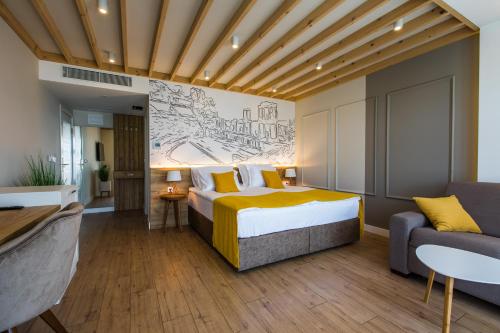
Day 4-5: Plovdiv
As the second largest city in Bulgaria, there are plenty of things to do in Plovdiv. Known for its cultural, historical and natural landmarks, Plovdiv is one of the oldest cities in Europe. There are over 6,000 years of history in this small compact city.
Similar to Sofia, there are excellent free walking tours in Plovdiv. Join one so you can get to know the ancient city quickly.
Besides the tour, here are some other interesting highlights to look for:
- Wander around the cobbled streets of Old Town in Plovdiv
- Visit Plovdiv Roman Theatre and the Ancient Stadium of Philippopolis
- Hike up one of six hills around Plovdiv, including Rebet Tepe and Bunardzhik Tepe
- Roam around Knyaz Alexander I , the Main Street in Plovdiv
- See colourful art murals and enjoy the nightlife in the Kapana District

Bulgaria Itinerary 10 Days
Bulgaria itinerary day 1-5: sofia, sofia day trip, plovdiv (5 days).
Follow the previous itinerary for Days one to five.
On day five, stay the night in Plovdiv instead of returning to Sofia. Book two nights of hotel in Plovdiv if you are continuing the itinerary.
Bulgaria itinerary day 6-8: Burgas, Sozopol and Nessebar (3 days)
The second half of the Bulgaria itinerary is all about the Black Sea.
It starts with a seaside town called Burgas, an excellent city as a home base for visiting other towns along the Bulgarian Black Sea coast. And then, the trip continues up the coast to Varna, the third largest city in Bulgaria.
Travel from Plovdiv to Burgas
Bus: Union Ivkoni travels from Plovdiv South (Yug) Bus Station to Burgas Station South Terminal . The bus journey takes about 4.5 hours.
Train: There are 4 direct trains from Plovdiv Central Station to Burgas Train Station daily . Take the fast train in the morning (9:05am-1:07pm).
Burgas Accommodation: Marina Burgas Hotel
Book three nights at Marina Burgas Hotel , a 3-star hotel that is conveniently located next to Burgas Beach. And the hotel is within walking distance to Burgas Station South Terminal, where you can take suburban buses to Sozopol and Nessebar and continue on the itinerary to Varna.
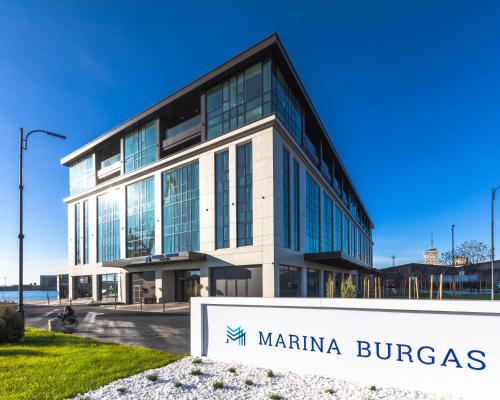
Day 6: Burgas
Burgas is Bulgaria’s fourth largest city and gateway to the Black Sea. The city is very compact and much smaller than Plovdiv, so you can see most attractions in one day.
Here are some things to do in Burgas on day six:
- Sunbathe at Burgas Beach and swim in the Black Sea
- Wander around the Sea Garden
- Take a dip in the pink salty water at Lake Atanasovsko
- Wander around Burgas Old Town
- Try Bulgarian Black Sea Coast cuisine , which includes Black Sea mussels, grilled and fried fish and calamari

Day 7: Sozopol
Sozopol is a small town 35km south of the port city of Burgas. It has over 7,000 years of history, and it is one of the oldest towns along the Black Sea Coast.
When you take a day trip to Sozopol from Burgas , there are some things you must do:
- See narrow medieval cobblestone streets and Bulgarian Revival houses
- Visit Sozopol Archaeological Museum and Ethnographic Museum
- See churches and monasteries in Old Town Sozopol
- Walk from Southern Fortress Wall and Tower to Cape Skamni
- Relax on Sozopol Central Beach or Harmonite Beach
How to get to Sozopol from Burgas: take the Burgas Bus at Burgas Station South Terminal. Look for bus stop #5 at the back of the terminal and wait for the next bus to Sozopol. The bus ride costs 5 lev.

Nessebar is another seaside town on the Bulgarian Black Sea Coast. The ancient town is 35km north of Burgas and has been a UNESCO World Heritage Site.
Here are some suggestions on things to see during your day trip to Nessebar :
- Wander around the Western Fortress Wall
- See frescos, decorative motifs and mosaics at some of the preserved churches and monasteries .
- See the remaining parts of early Byzantine Baths
- Admire three naves, an atrium and arched windows of the Church of Saint Sophia
- Finish the day in Sunny Beach
How to get to Nessebar from Burgas: take the M-Bus or DS Bus at Burgas Station South Terminal. Look for bus stop #3 at the back of the terminal and wait for the next bus to Nessebar. Alight at the Old Town Nessebar bus stop. At the end of the day, take the M-Bus or DS Bus from Sunny Beach bus station back to Burgas. A single ride costs 8 lev.

Bulgaria itinerary day 9-10: Varna and depart from Varna (2 days)
Varna is the last destination on your Bulgaria 10-day itinerary. I chose this as the last stop of the itinerary because many flights fly in and out of Varna Airport.
So for Day Nine, visit Golden Sands Beach and wander around Varna. And depending on when you depart on Day ten, you might still have some time to see more of Varna.
Travel from Burgas to Varna
Bus: Several buses travel from Burgas Station South Terminal to Central Bus Station Varna , including Deily, M-Bus, Travel Express and Varnabus 2000 .
Note: Central Bus Station Varna is northwest of the city centre. Several local buses, including Bus 409 (which can take you to and from Varna Airport), can take you to the city centre.
Train: There are 4 trains from Burgas Train Station to Varna Central Train Station daily . You’ll have to change trains at Karnobat, and the entire journey takes 3.5 hours. Take the 9:25am-12:51pm if you choose the train option.
Varna Accommodation: mOdus Hotel
Book two nights at mOdus Hotel , a modern boutique hotel next to the Varna Sea Garden and in the city’s centre. Moreover, the hotel is only a few minutes from the bus stop to Golden Sands, Central Bus Station Varna and Varna Airport.

Day 9-10: Varna
Varna is a port city located in the northeast corner of Bulgaria. The seaside resort town is famous for its golden beaches, thermal springs and ancient artifacts discovered in the city.
For your last two days in Bulgaria, here are some Varna attractions to consider seeing:
- Visit the beaches of Varna and Varna Sea Garden
- See ancient ruins at Varna Roman Baths
- Stroll around the main pedestrian street in Varna Old Town
- See the famous “Gold of Varna” in the Archaeological Museum of Varna
- Spend the afternoon suntanning on Golden Sands Beach

Which Bulgaria travel itinerary are you going to follow?
If time isn’t an issue, stay in Bulgaria for as long as possible. It is one of the most underrated countries I’ve ever visited.
But if you have limited time, 5 days in Bulgaria is sufficient to see all the highlights around Sofia and Plovdiv. But if you can spend 10 days in Bulgaria, add all the cities and towns along the Black Sea Coast.
And if you are still wondering if Bulgaria is worth visiting, perhaps take a look at my individual blog posts about all the cities mentioned in this itinerary. I put a lot of information on what to see, how to get around and also included hotel recommendations and food options.
I hope you found this post useful for planning your Bulgaria travel itinerary. Let me know which itinerary you will follow or if you have any questions about travelling solo in Bulgaria.
Thank you for reading my Bulgaria itinerary
You might also like these other posts on solo travel in Bulgaria:
Bulgaria posts:
- Sofia Solo Travel: 20 best things to do in Sofia
- Where and what to eat in Sofia: 21 must-try food
- Burgas Travel Guide: Things to do + Getting there + Day trips
- Burgas to Sozopol day trip: 1-day itinerary
- Day trip to Nessebar and Sunny Beach in Bulgaria
- Varna Travel Guide: 9 Things to do
Like this post? Pin it on your Pinterest board!

queenie mak
Hi, my name is Queenie, and I've been a solo traveller for 20+ years and currently based in Hong Kong. Follow me on my adventures through Instagram and my blog!
Further Reading...

21 Best Sofia Food & Best Restaurants in Sofia Bulgaria

Sofia Solo Travel: 20 Best Things to Do in Sofia Bulgaria

Burgas Travel Guide: Things to Do in Burgas + Getting There + Day Trips
No comments, leave a reply cancel reply.
Save my name, email, and website in this browser for the next time I comment.
Notify me of follow-up comments by email.
Notify me of new posts by email.
This site uses Akismet to reduce spam. Learn how your comment data is processed .
Taipei Accommodation: Where to stay in Taipei Taiwan as a Solo Traveller
Osaka 2 day itinerary for first-time solo travellers, ms travel solo.


Bulgaria Road Trip Itinerary
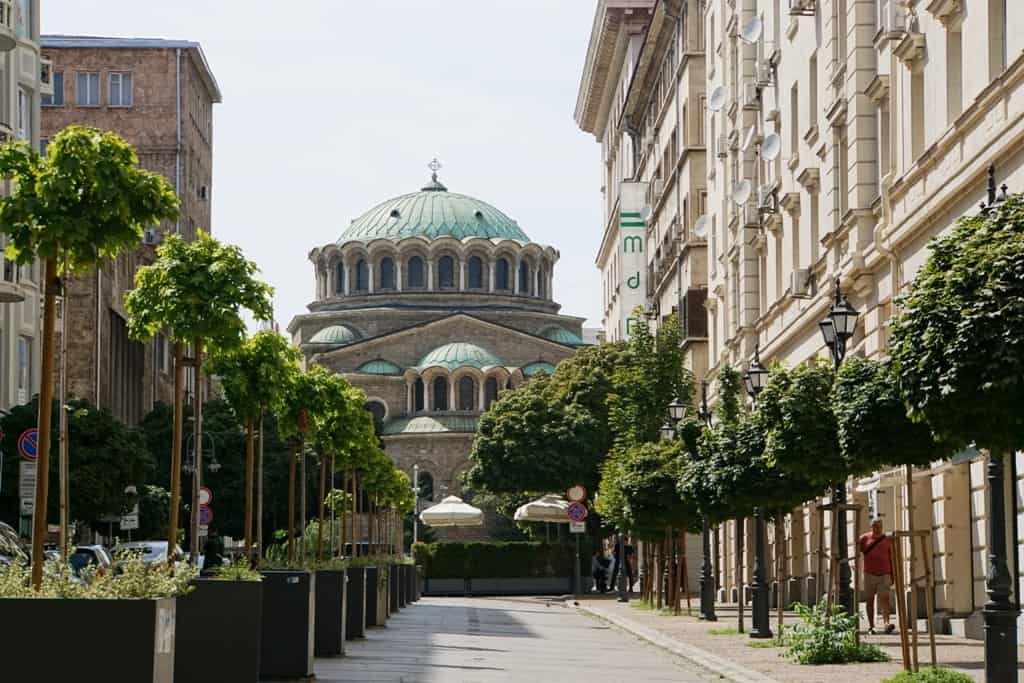
Everyone who goes to Bulgaria falls in love with its breathtaking mountains, its lush forests, its beautiful sandy beaches, and its rich and vibrant history. There is great food and wine, hospitality, and folklore to make for an unforgettable experience without being overwhelmed with big, teeming masses of tourists.
It is no easy thing to discover Bulgaria, however! There is so much to see and do that it can be hard to get a true taste of all that Bulgaria has to offer. The best way is to have a bit of everything and enjoy this beautiful country’s multiple facets in one exciting vacation: a road trip through Bulgaria.
Table of Contents
The perfect Bulgaria road trip
A road trip in Bulgaria can offer you a bit of everything if you know where to go, and with the itinerary that follows you will get to do just that! This itinerary needs at least three days but the more days you afford in each place on it the better. Consider that rushing from place to place can be tiring and even stressful, so make sure you have allocated enough time to relax and rest as you enjoy Bulgaria’s good food and lovely hospitality.
The itinerary is designed to be suitable for winter or summer, so depending on what type of vacation you prefer, you can drive through verdant forests and enjoy the coolness of summer or you can drive through a winter wonderland that should probably exist in a storybook rather than reality.
You’ll start from Sofia, one of Europe’s oldest cities and Bulgaria’s vibrant capital and end up in Plovdiv Bulgaria’s cultural capital with the iconic atmosphere of Roman, Greek, Ottoman, and Persian influences.
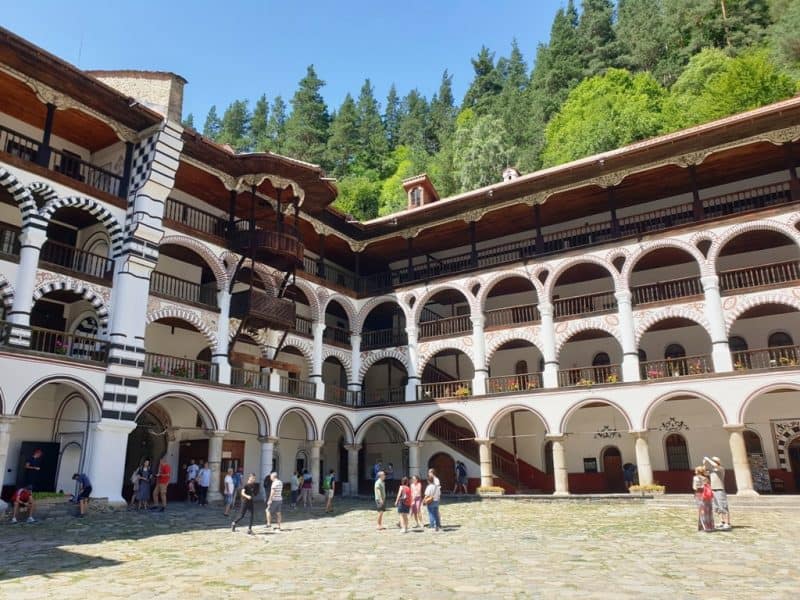
In your travel, you will go through gorgeous landscapes with breathtaking views of rolling hills and tall, green mountains. You will see monasteries and historical places that will make Bulgaria’s long history of nearly 1,300 years. Combining lush, virgin nature with beautifully historical cities of iconic architecture, your road trip will be full of adventure, history, cosmopolitan flair, and the essence of all that makes Bulgaria unique.
Where is Bulgaria?
Bulgaria is in southeastern Europe. It is in the heart of the Balkans, with its eastern side being part of the Black Sea coastline.
Bulgaria shares its borders with five other countries: Romania at its north, Serbia and North Macedonia at its west, and Greece and Turkey at its south.
There are many ways to get to Bulgaria and its capital, Sofia. You can go by plane, car, bus, train, and ferry.
If you opt to go by plane, you will land at Sofia’s international airport. There are many direct flights to Sofia Airport from all over the world by many airlines, including Bulgaria’s own, Bulgaria Airlines. The flight to Bulgaria varies depending on where you take off. For example, a flight from Athens to Sofia takes just over an hour, while from New York it takes around 11 hours.
If you opt to go by bus, you can find several itineraries from all of Bulgaria’s bordering countries that will get you to Sofia. You can even find coaches from London to Bulgaria which will take you through all of Europe before you get to Sofia. Just keep in mind that you will be changing coaches from city to city in your travel so make sure to have everything preplanned and prepaid. This trip takes roughly two days.
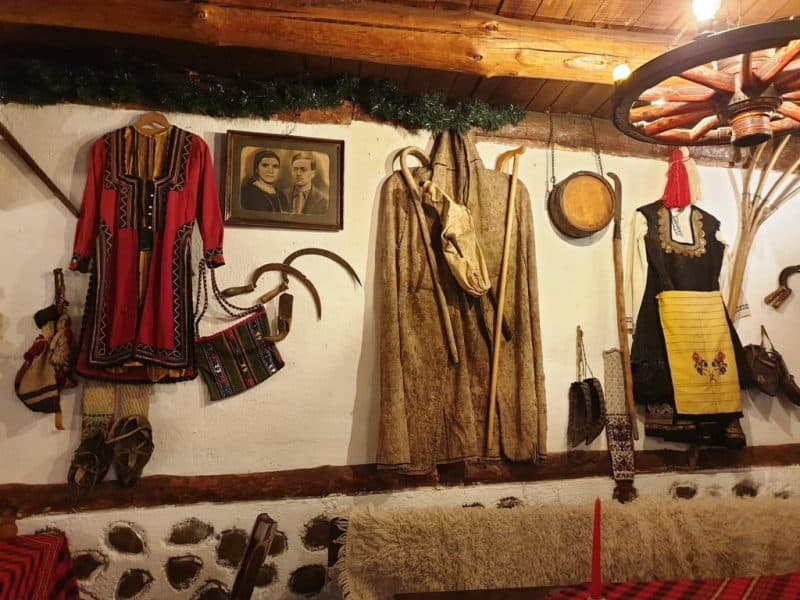
Getting to Bulgaria by car is also possible through one of the many highways of Europe leading there. Just make sure to be prepared to pay a vignette (which is a road tax) once you enter Bulgaria’s borders. The trip time varies depending on where you start from. If you are in one of Bulgaria’s bordering countries it could take anything from 10 hours to just 3 or 4 hours.
There are also international train lines into Bulgaria and Sofia. There are several going from all the Balkan countries but you can also find other ones from further away in Europe, including traveling to Bulgaria from the UK. The trip from London to Sofia takes 48 hours.
Finally, if you are in any of the countries with a Black Sea coast, namely Georgia, Ukraine, Romania, Russia, and Turkey, you can take the ferry to Bulgaria. Travel times vary from a few hours to three days, depending on whether you get to cross the Black Sea or not!
Road Trip in Bulgaria a Perfect Itinerary
Sofia (1 -2 nights).
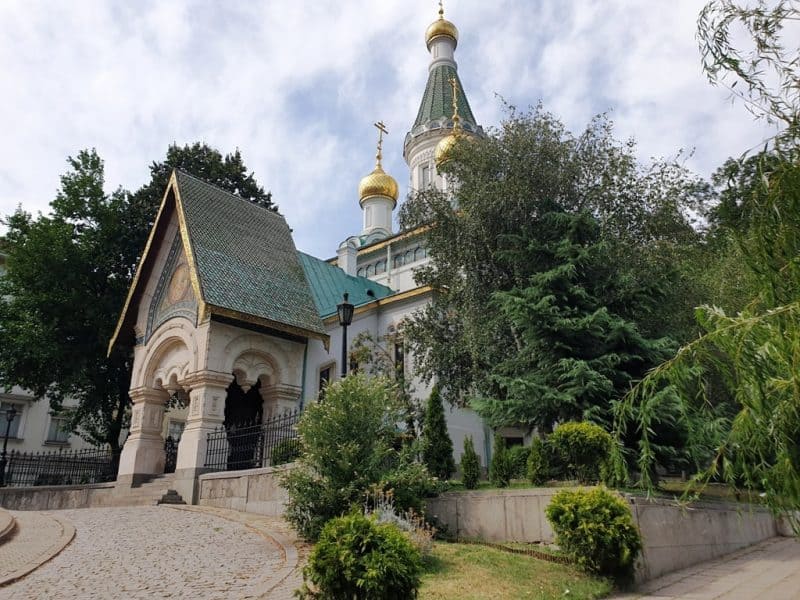
Sofia is one of the oldest cities in Europe, with a staggering 6,000-year-old history of continuous habitation. It has always been a strategic and geopolitical hub, from Roman times to Byzantine times. Since it was captured by the Bulgarians in the 9 th century AD, it has remained part of the Bulgarian influence even through the harsh Ottoman times.
Sofia’s architecture is an iconic amalgam of Austrian, French, and German architecture from its parliamentary monarchy era, austere soviet styles from its time behind the Iron Curtain until the fall of the Berlin Wall in 1989, and modern and post-modern styles as Sofia became part of the EU family.
To best savor this unique blend of history that is etched into Sofia’s neighborhoods, you can take one of its many walking tours which will take you to all its famous landmarks and places to visit, from churches and synagogues of stunning beauty to iconic parks and museums. But even if you don’t opt for that, the must-see places are:
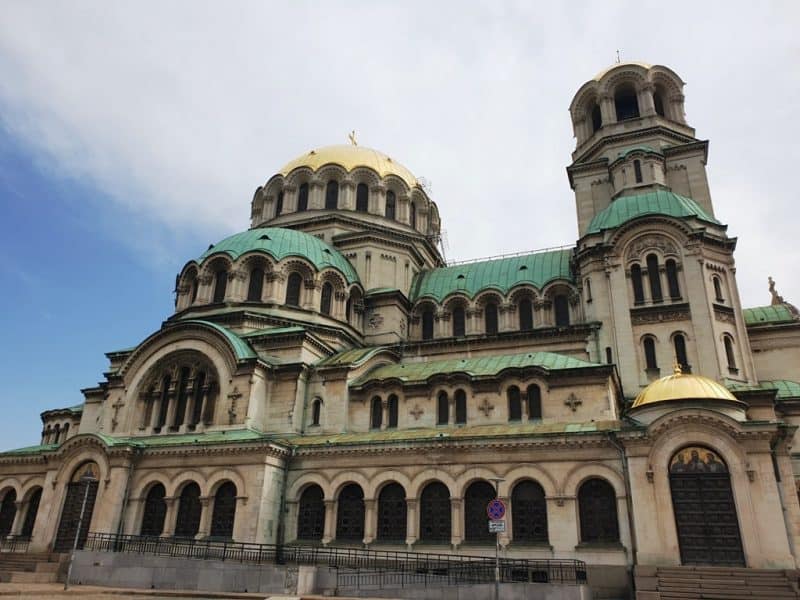
St. George Rotunda and St. Alexander Nevsky Cathedral : Travel through time from the earliest of Sofia to its modern times by visiting these two churches. St. George Rotunda is the oldest building in Sofia, built in the 300s AD, with gorgeous frescoes from early medieval times, while St. Alexander Nevsky is one of its most resplendent and modern places of worship built in the late 19 th century after Bulgaria gained its independence from Ottoman Turkey.
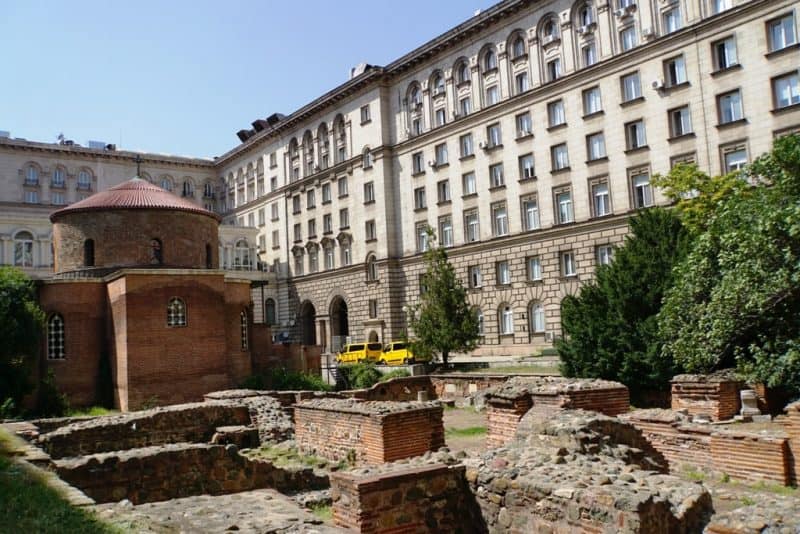
While St. George Rotunda is a small Late Antique church, St. Alexander Nevsky is a gigantic Neo-Byzantine cathedral with a 10,000 people capacity and stunning interiors, including its crypt.
Vitosha Boulevard and Borisova Gradina : This is Sofia’s fanciest, most cosmopolitan street. It is lined with high-end shops and houses, as well as great places to have your coffee, great views of Vitosha mountain, and elegant Art Nouveau tones. Borisova Gradina is Sofia’s oldest and most beautiful park. It is an excellent specimen of the Bulgarian Revival architectural and artistic movement.
Sofia’s Museums : There are several important museums to visit in Sofia, including the National Institute of Archaeology and the National Historical Museum.
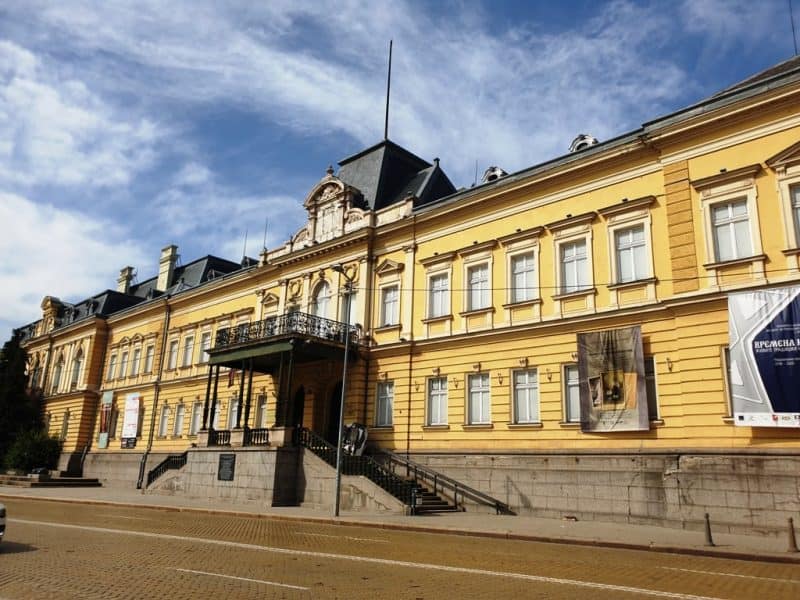
There are several great neighborhoods to choose accommodation in Sofia, from its downtown area (Centrum) to Vitosha and NDK (National Palace of Culture) to Studentski Grad. Depending on your budget and style of vacation, you may opt for a low-budget, versatile hostel at Studentski Grad or a high-end hotel in Vitosha or Lozenets.
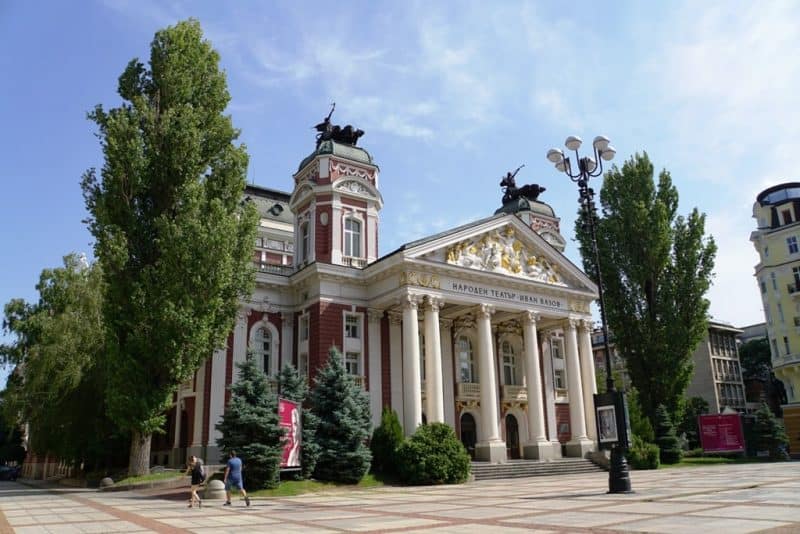
Since you will be staying only a night or two, you might want to pamper yourself with great service and an even greater view by staying at the Hyatt Regency Sofia hote l . It is located in the heart of the city at Vasil Levsky square, within walking distance of all the important sights. The view of the city from its various lounges is astounding, and it’s very well priced considering its 5-star ranking.
Bulgaria is also famous for its excellent cuisine, and Sofia is the best place to sample it. Visit Shtastliveca Vitosha Sofia for timeless classic dishes from Bulgaria and Europe and a time-capsule, turn-of-the-century feel once you step into the restaurant.
To sample Bulgarian cuisine with more local color, Moma Restaurant is where you want to go. Authentic dishes and folklore merge seamlessly with modernity, with an interior that is faithful to traditional Bulgarian imagery and ornaments.
Sofia to Bansko (1-2 nights)
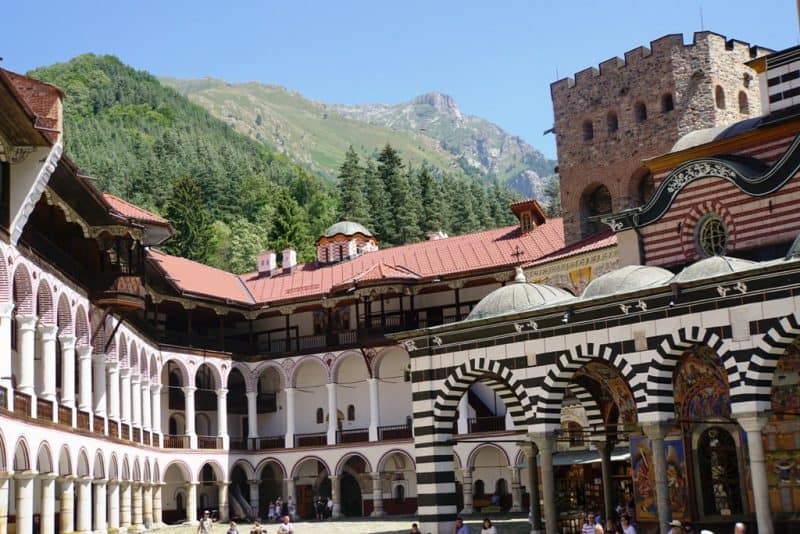
Leaving Sofia, you will drive to Bansko with a stop at Rila Monastery. In this part of your road trip, you will experience Bulgarian history and cosmopolitan flair in one beautiful mix.
Rila Monastery is a UNESCO World Heritage site and one of the most important specimens of the Bulgarian Revival. Its full name is Monastery of St. Ivan of Rila, and it was founded in the 10 th century AD but additions were made as recently as the 19 th century. Bulgarians consider it one of Bulgaria’s most sacred jewels and it truly is stunningly beautiful.
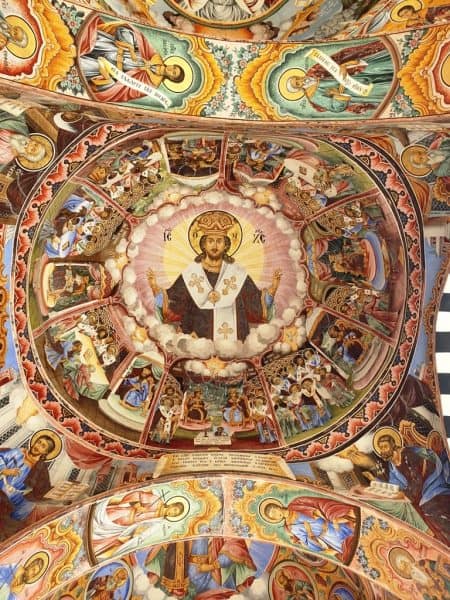
Rila Monastery is a cultural, historical, and architectural monument. Its complex consists of the church, the residential wards, and the monastery’s museum. Rila boasts gorgeous frescoes from various centuries and stunning decorated domes. You can climb the tower and take in the sweeping views of the mountains all around.
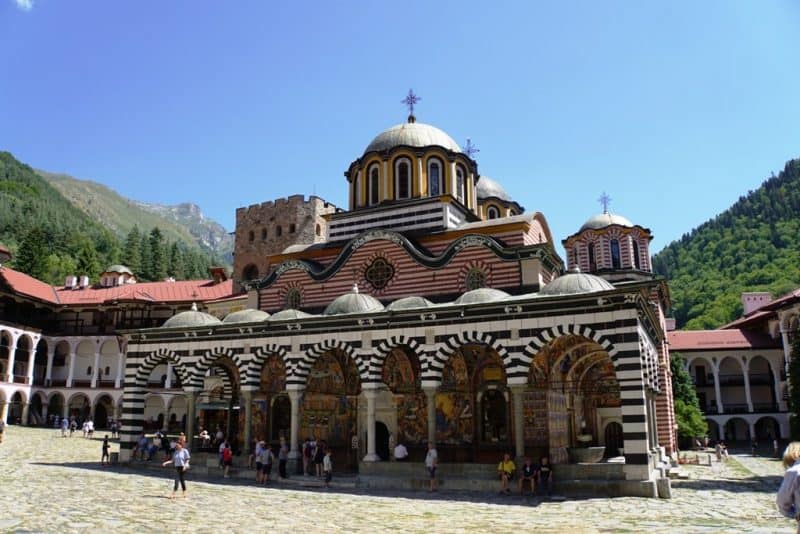
Rila is a place of pilgrimage for many, so you can stay there if you intend to have a spiritual experience and stay for longer than a day. Facilities in Rila Monastery are sufficient but basic and are not intended to be hotel-level since they are there to serve pilgrims only.
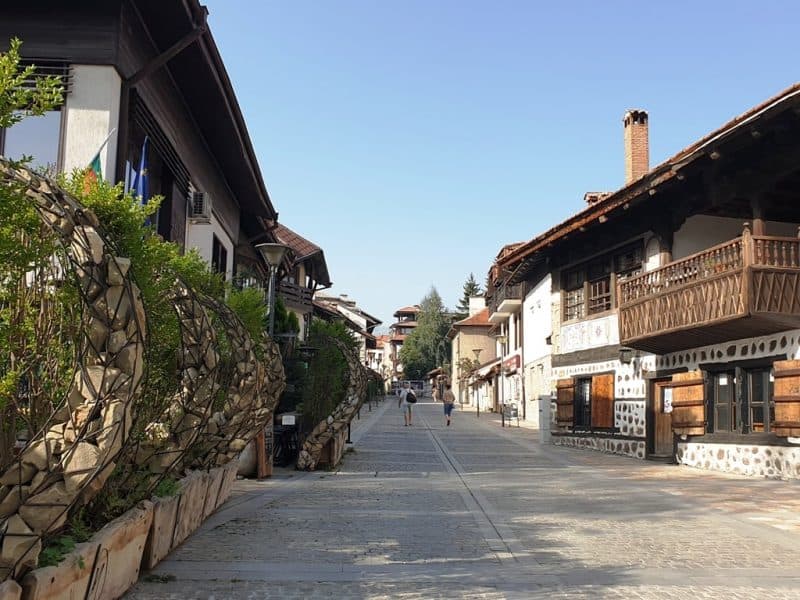
After Rila Monastery you will drive on to Bansko town with the beautiful Pirin mountains looming over it, offering shade and a challenge to visitors. Whether you choose to come in winter or summer, Bansko has adventure packed for you- or if you are not the adventurous type, beauty and folklore for you to bask in.
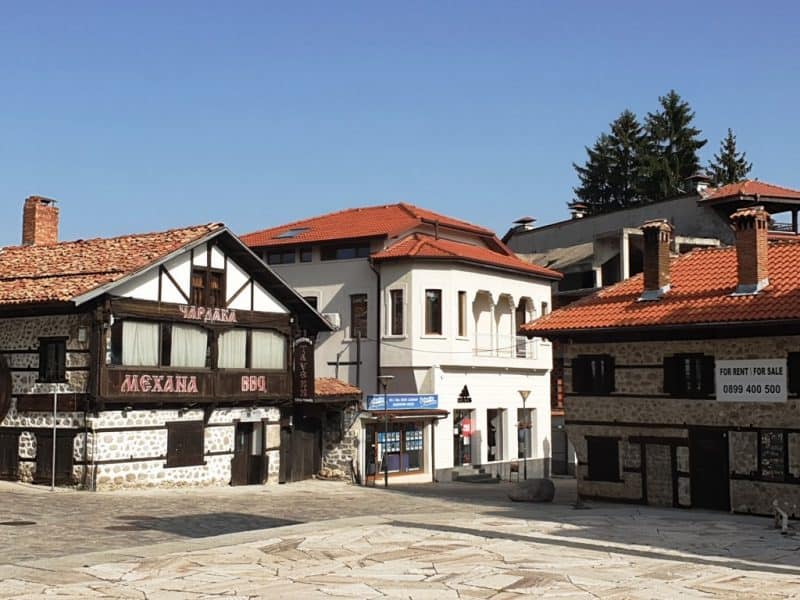
Bansko is one of Bulgaria’s top ski resorts with 16 ski runs of various difficulty levels. There is an affordable ski school if you are a beginner or have children that want to start, and a great network of ski lifts that will take you to the slopes. The ski station is fully equipped with gear and has several restaurants to choose from.
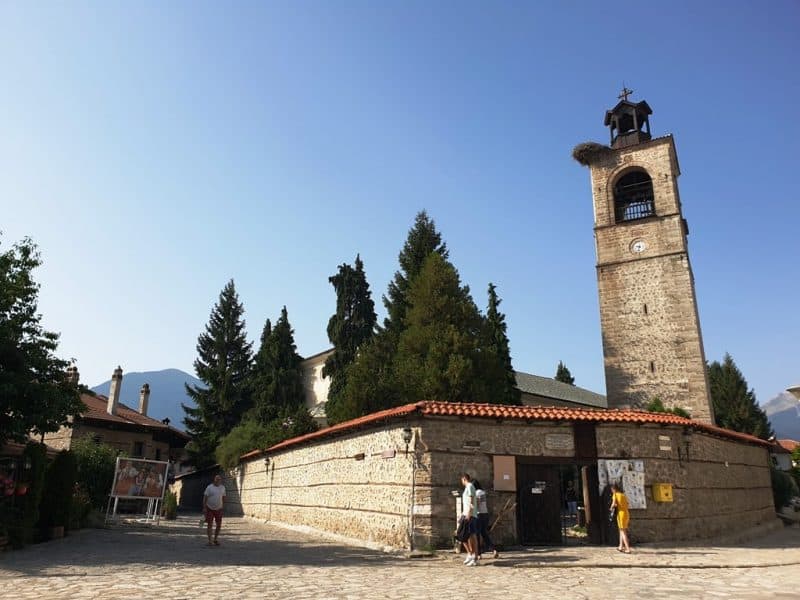
During the summer, Bansko is great for mountain biking and summer hikes, with breathtaking views and gorgeous nature surrounding you. There is also a great variety of rock climbing walls if you are into that.
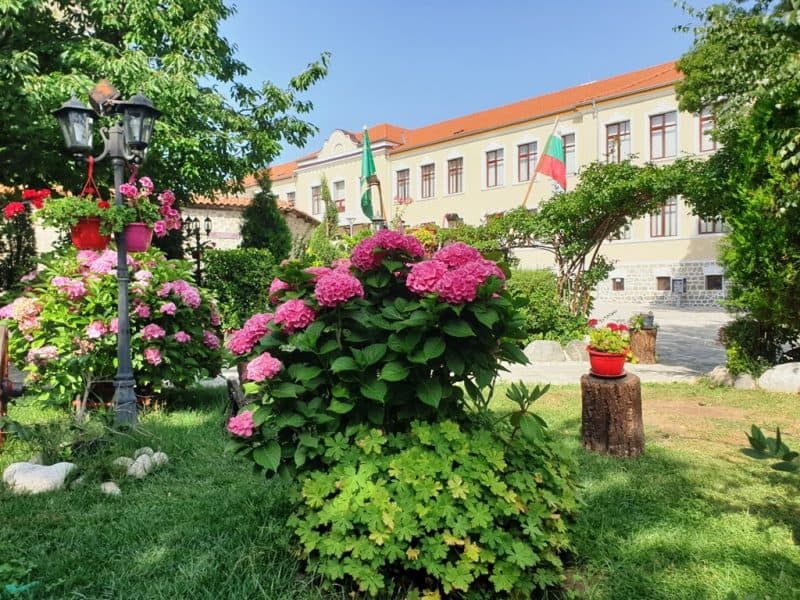
If you are not as adventurous, Bansko has you covered: visit Velyanova House and its murals as well as the Neofit Rilski Museum for a time travel back to the Bulgarian Revival era. After you explore the town and its beautiful church, hit Pirin street for great food and coffee as you admire the mountains or a Bansko traditional Mehana for traditional Bulgarian food with dancing and live music.
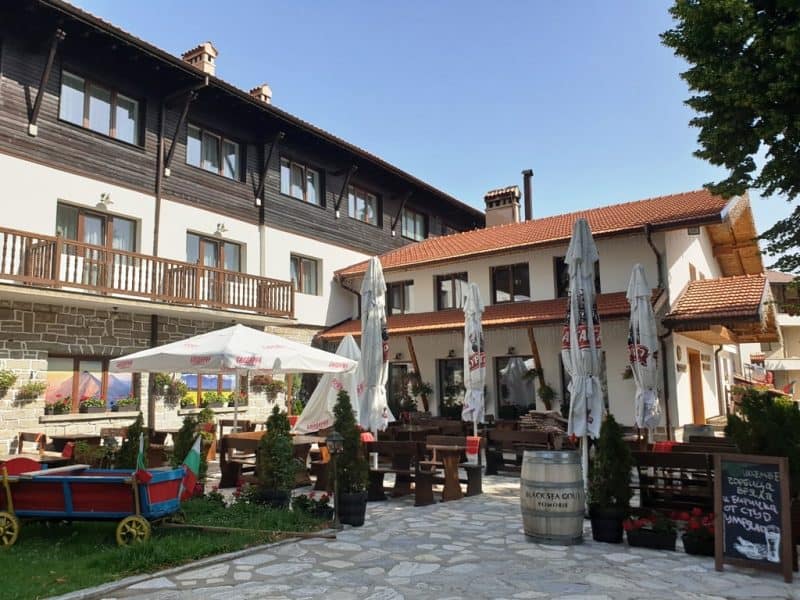
A great Mehana to visit would be Mehana Vodenicata at the center of Bansko, with its beautiful garden, live music, and traditional Bansko cuisine. Its interior is plush with wood and stone, in a warm and welcoming atmosphere you won’t forget!
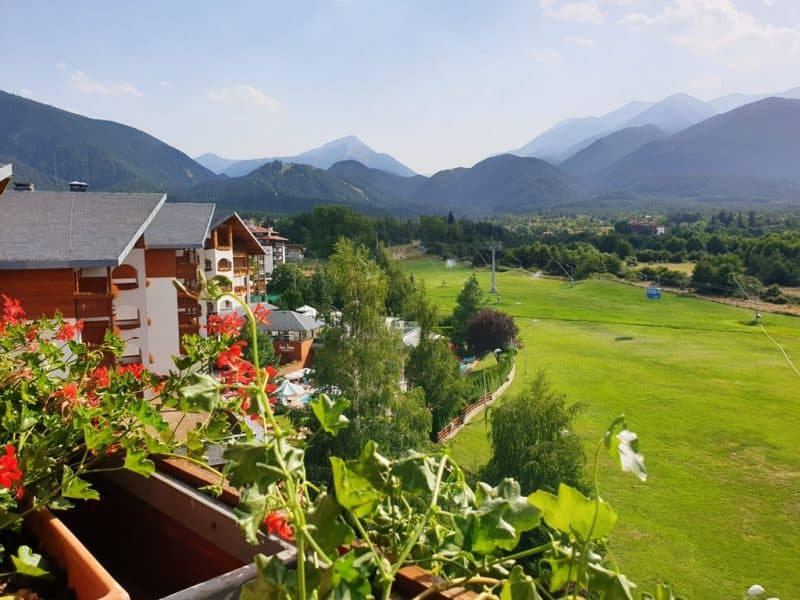
A great place to stay in Bansko is Kempinski Grand Arena Hote l at Pirin Street . As in Sofia, for its 5-star ranking , it is remarkably affordable! You will be treated to gorgeous views of the mountains while having quick access to the ski gondola that will take you to the ski station. Its Alpen style architecture and thematic food buffets, its extensive spa resort facilities, and great international corners will make you reluctant to continue on!
Bansko to Melnik (1-2 nights)
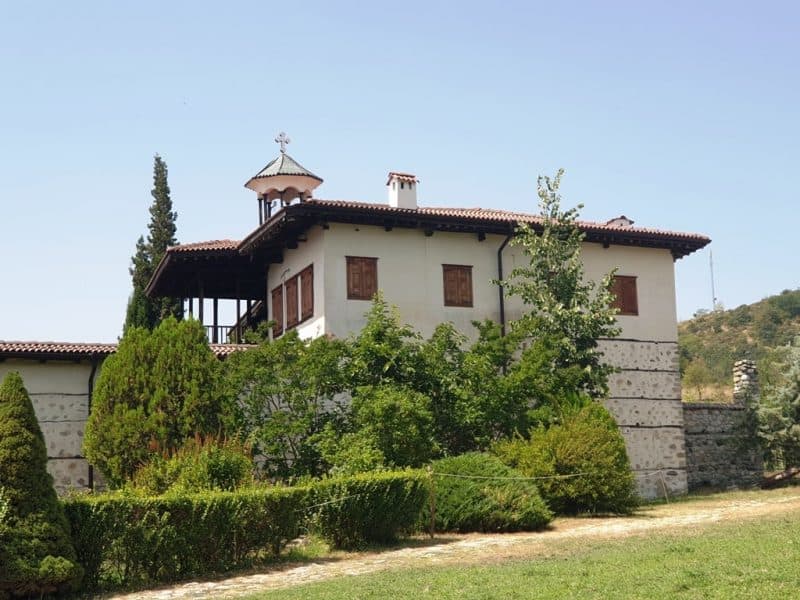
From Bansko, you will drive on to Melnik with a stop at Rozhen Monastery.
Rozhen Monastery is the biggest monastery in the Pirin Mountains. Its full name is St. Nativity of Mother of God and it was founded in the 13 th century AD at the latest. Rozhen monastery has been destroyed a few times but always restored, so what you will be visiting is restoration work dating from the 16 th century AD.
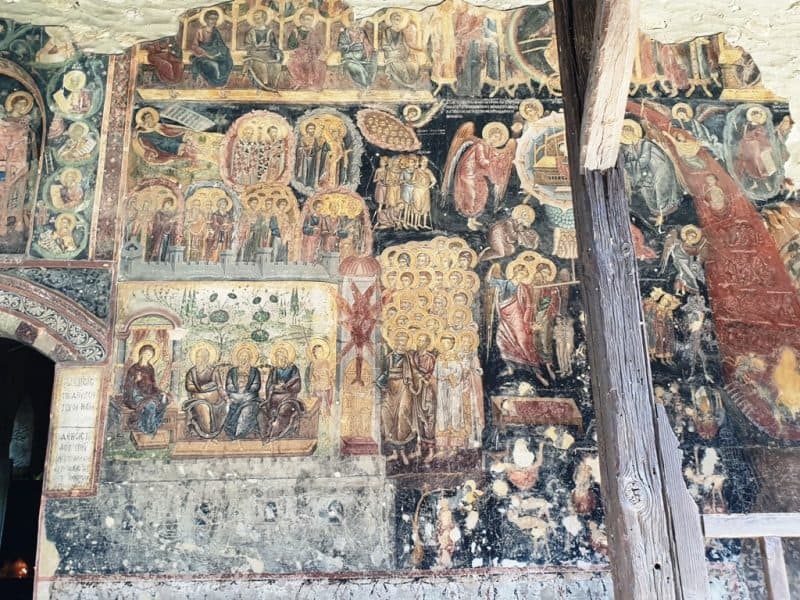
Rozhen is very near Melnik, and originally had no roads leading to it, so one had to climb up slopes to get there. Rozhen is said to house an icon of the Virgin Mary that is said to miraculously cure the sick, so annually there are waves of pilgrims going to the monastery to pray before it.
Rozhen itself is beautiful, with stunning frescoes, buildings representing different centuries’ of the monastery’s life scattered across the complex, and a yard of lush vegetation with iconic medieval stone and woodwork.
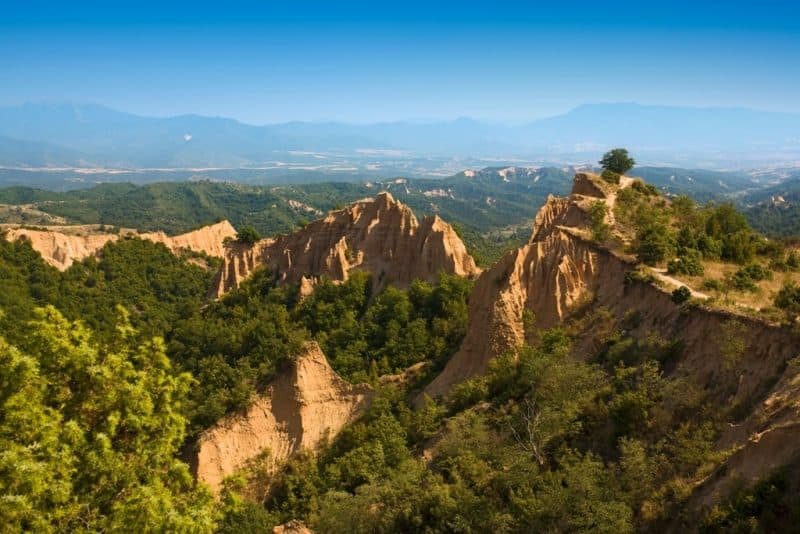
Melnik is called the smallest town in Bulgaria, with only 25 people registered as residents there. However, it is renowned for its gorgeous natural landscapes and unique geological formations: the Melnik Pyramids.
The Melnik Pyramids are sand pyramids that were created by erosion, and which are still changing. They can be up to 100 meters high and something you can’t see anywhere else as they jut out harshly through the green of Melnik’s lush vegetation.
If you can handle the trek, it’s an experience you must have if only for the sweeping view and the gorgeous sunset.
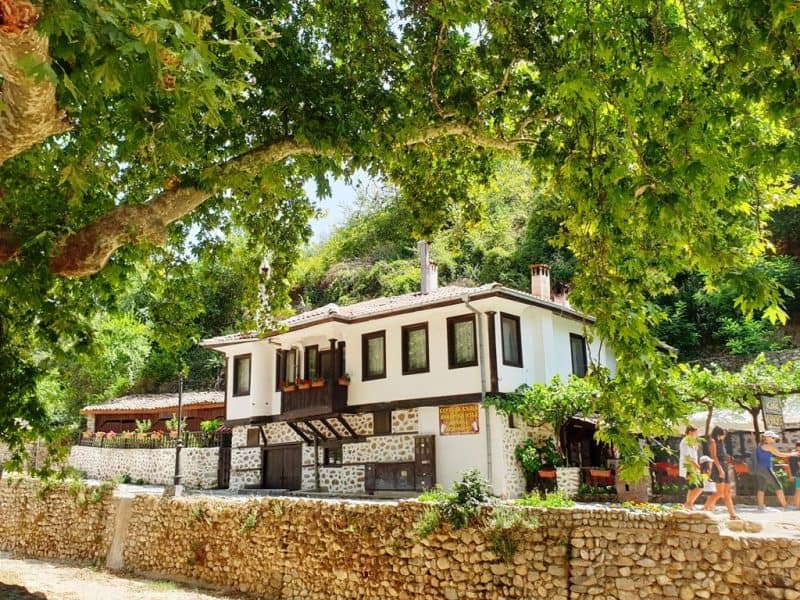
While you are in Melnik, make sure to visit its wine museum as Melnik is famed to have Bulgaria’s best wine. You can taste and buy wine there while seeing displays of how the process is done. Visit the 18th-century Kordopulov house, which is preserved as it was in its heyday in the 1700s.
This house museum originally belonged to an affluent Greek merchant named Kordopoulos. Its architectural style is a mix of Bulgarian Revival and Ottoman and it features a big underground wine cellar.
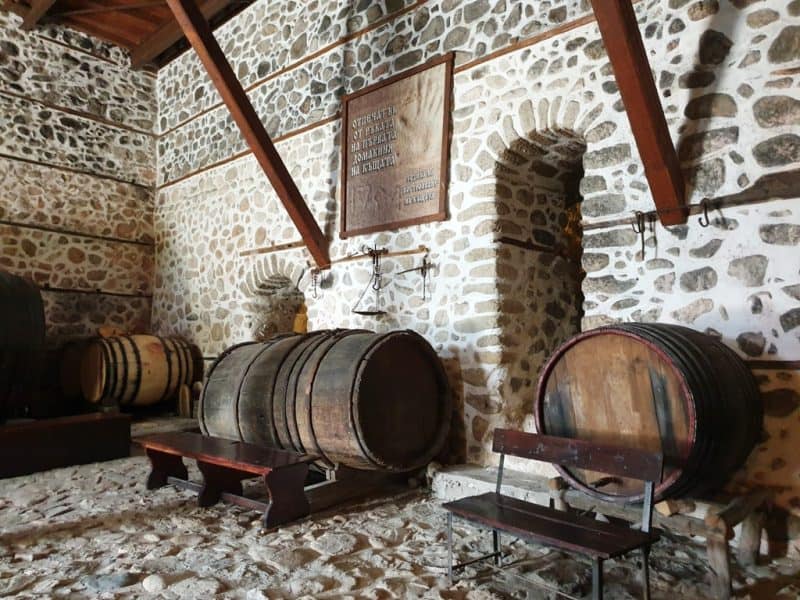
Stay at Zornitsa Family Estate Relais and Chateaux for a great experience of Bulgarian traditions and modern facilities. You will be treating yourself to gorgeous views of the mountain and Melnik’s general area as well as to a heated pool and other top-of-the-line amenities.
Melnik to Leshten, to Kovatchevitsa, to Plovdiv (2 nights)
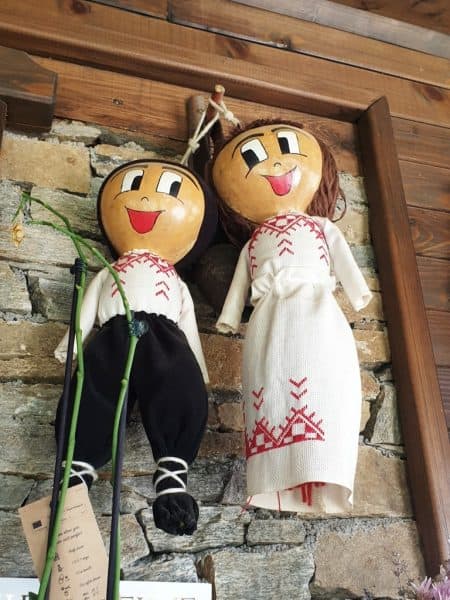
Leaving Melnik, you will then drive on to two of the most culturally important villages in Bulgaria, Leshten and Kovatchevitsa. Bulgarians consider them important heritage sites of historical importance for the Bulgarian national identity.
Both villages are very popular with tourists as they are living museums. Many of their houses are fully restored and turned into museum houses. There are also natural activities you can do, from mushroom and herb picking to hiking and fishing. There is also a balneological resort near Leshten to complete the total relaxation these villages can offer, with pastoral sounds and views of gorgeous nature.
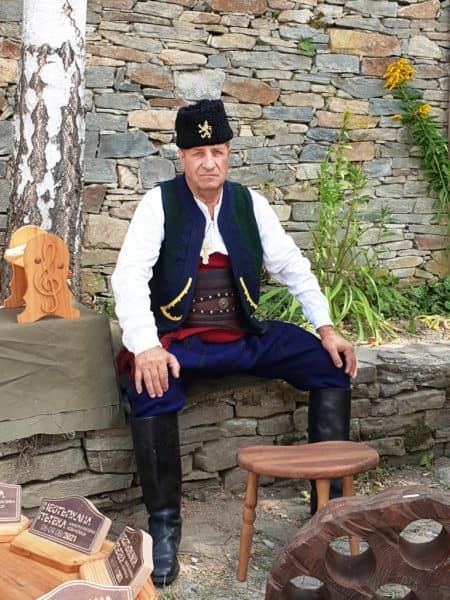
Leaving the villages you will drive to Plovdiv, Bulgaria’s remarkable cultural and artistic hub often considered the cultural capital. Plovdiv is one of the oldest continuously inhabited cities of the world, with nearly 8,000 years of history, from Ancient Thracians to Romans to Byzantines, Ottomans, and Bulgarians.
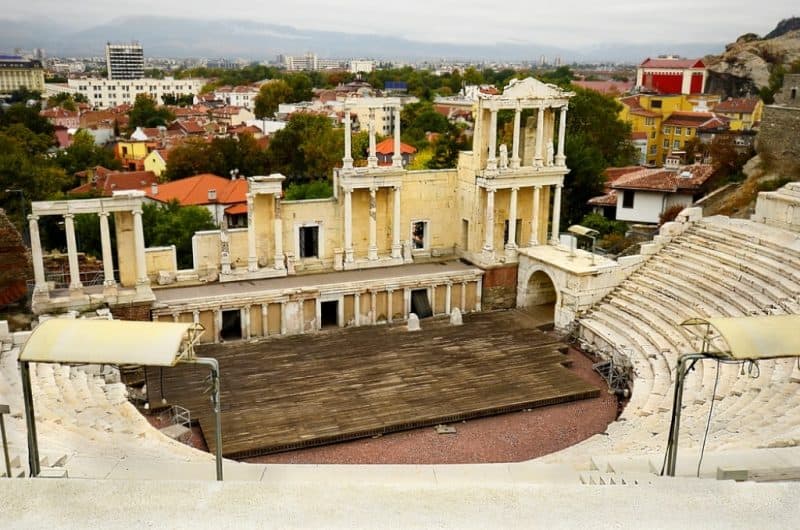
There are many things to see and do in Plovdiv. You can start by visiting the 2,000-year-old Ancient Theater which is still intact and in use today. Then walk the cobbled streets of Plovdiv’s Old Town with the Roman Stadium ruins, the iconic half-timbered, brightly colored houses, and the Stepan Hindliyan house museum with the sgraffito designs at its windows and extravagant murals.
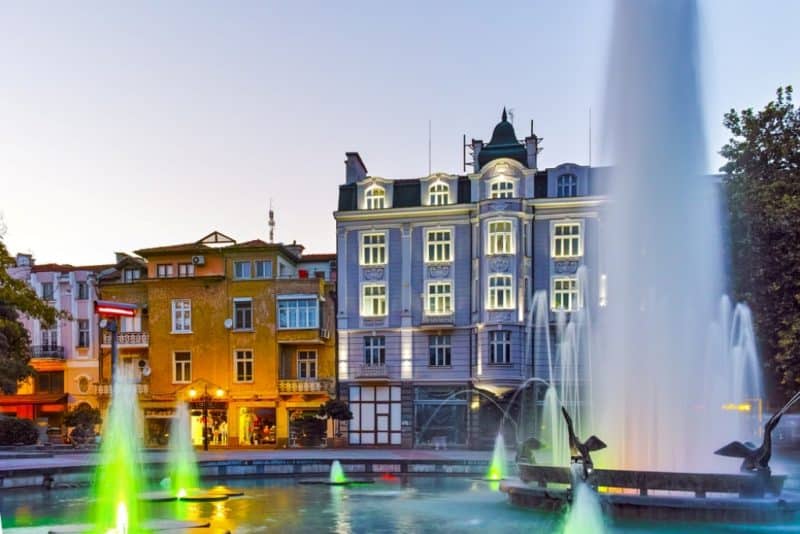
In the Old Town, you will also see the impressive Ethnographical Museum, housed in yet another perfectly preserved, opulent house. Lastly, visit the ancient ruins of Ancient Philippopolis and its stunning complex of forum and odeon.
Plovdiv to Sofia
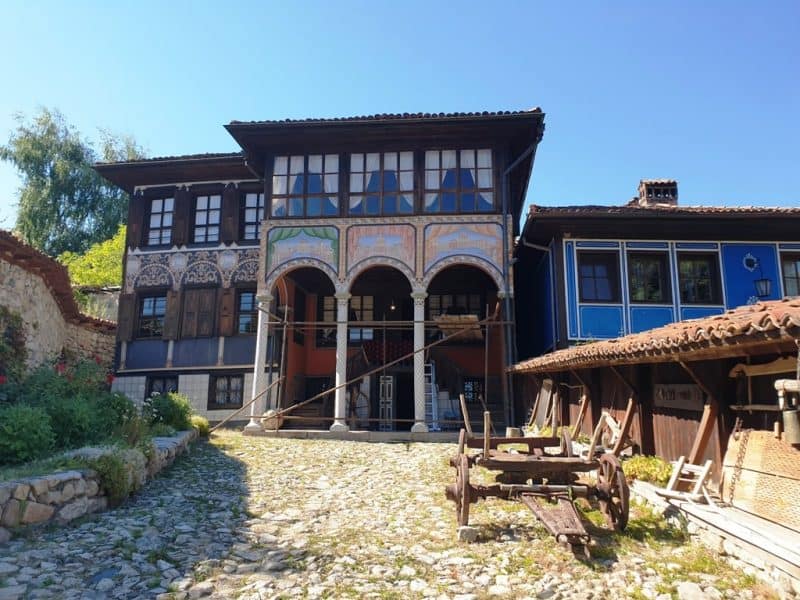
Return to Sofia from Plovdiv with a stop at Koprivshtitsa village . This is yet another village that has been preserved to its authentic look and feel of the 19 th century. The village is surrounded by the Sredna Gora mountains, adding to its beauty.
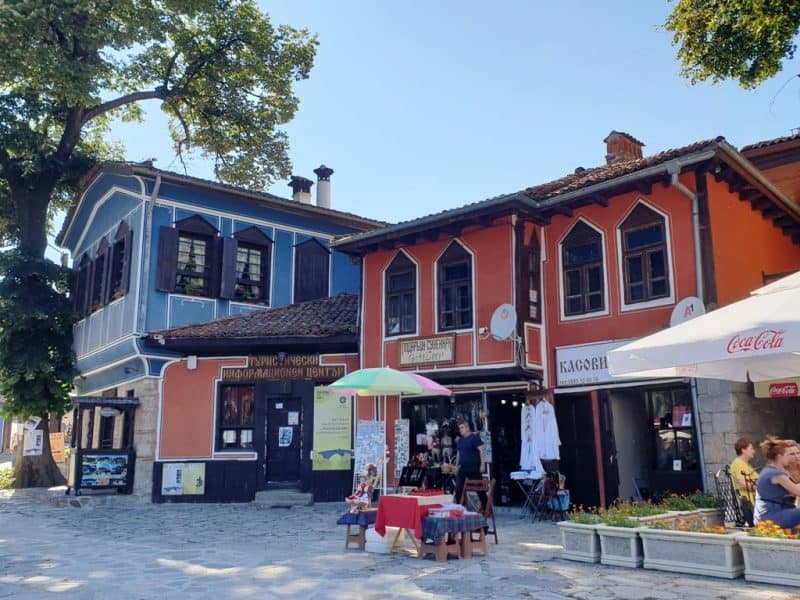
Walkthrough Koprivshtitsa’s cobbled streets and narrow byways to yet again enter the time capsule back to Bulgaria’s important historical moments, such as the houses of important figures of the Bulgarian intelligentsia and revolution against Ottoman rule. Of these, the must-see ones would be the Oslekov House, the Georgi Benkovski Memorial House, the Todor Kableshkov Memorial House, and the Lyutov House. Get the best view of the village from the Georgi Benkovski monument at its top.
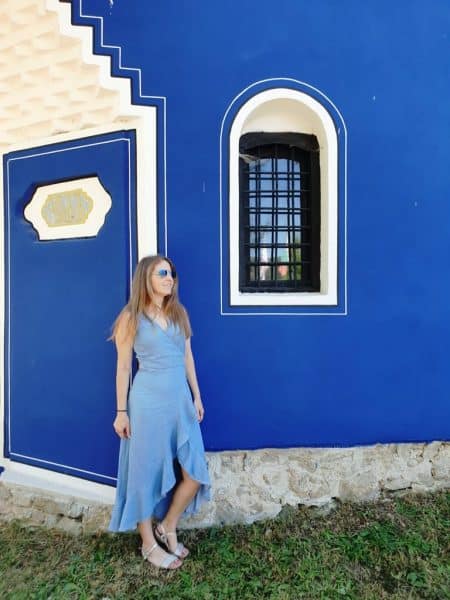
If you have a few more hours to spare, make sure you visit Koprivshtitsa’s St. Virgin Mary church and the Cyril and Methodius school house for even more specimens of that crucial period of Bulgarian history.
You might like: The best villages to visit in Bulgaria.
The drive back to Sofia is a little over two hours, through very scenic routes so time your travel accordingly if you want to enjoy them before night falls!
Sharing is caring!
Leave a Comment Cancel reply
Save my name, email, and website in this browser for the next time I comment.
CUSTOM BULGARIA ITINERARY
Let me plan your trip to bulgaria.
Are you planning a trip to Bulgaria , but you feel a bit overwhelmed with putting together the best travel itinerary? I am here to help you!
Coming up with an itinerary for a new destination can be difficult and time-consuming. Especially if it is a country like Bulgaria, where the cyrillic alphabet looks like an unsolvable mystery and there is not enough information on the internet . Especially not about those off-the-beat-path and hidden gems, we all long to see when going abroad.
Being a Bulgarian-native, Master’s in Tourism and a travel blogger, you might have just found the right person to trust with your Bulgaria travel planning.
I have shown quite a few foreigners around Bulgaria and I have seen first-hand the difficulties tourists come across when visiting my country. It’s very often that you will find information only in Bulgarian, complicated local public transport systems, issues with getting scammed because of lack of awareness and so on.
Trusting an expert with your Bulgaria itinerary planning means you can set back and relax while being sure that you will receive the best local tips, most worthy places to visit and best insider information possible.
By giving 15-30 minutes of your time , I will put together the perfect customised trip , taking all your needs and interests into consideration.
All that’s left for you to do is to book it and enjoy the experience!
REQUEST YOUR CUSTOM ITINERARY
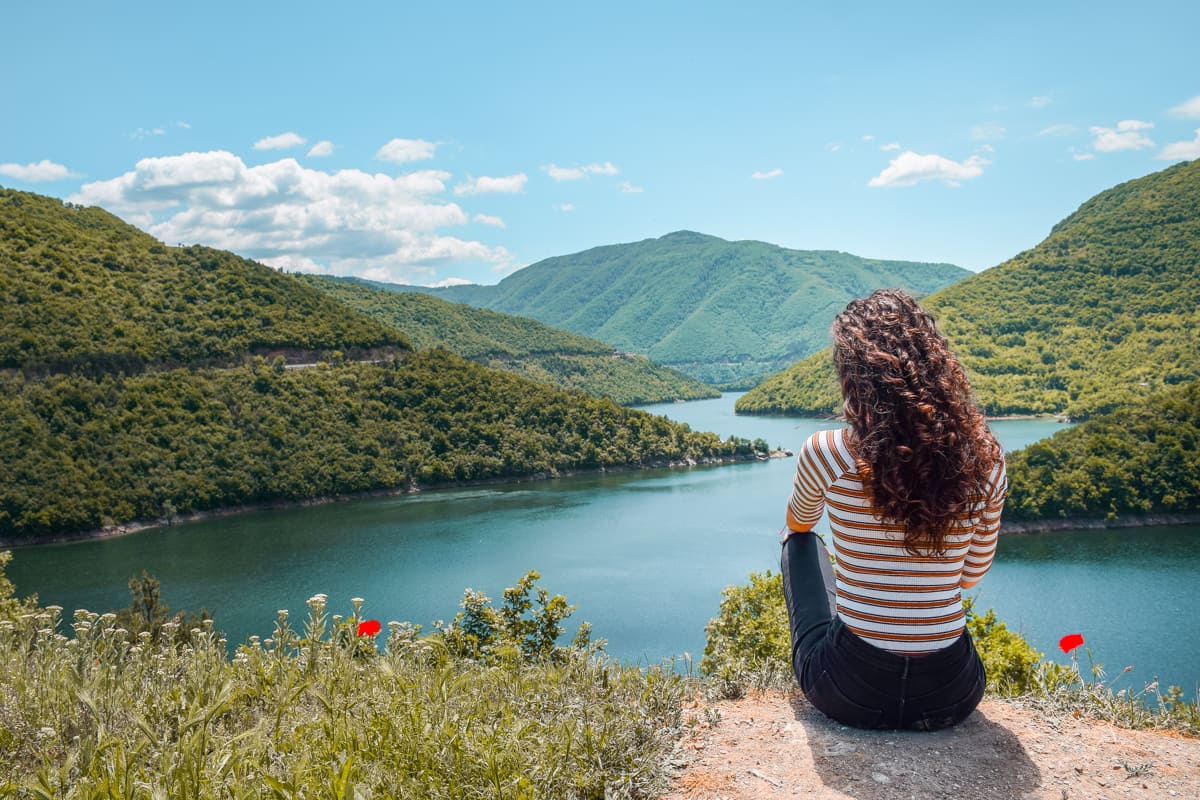
What each package includes:
- 30-minute call to discuss your trip and wishes
- Detailed day-by-day itinerary sent to you per email
- Insider tips from a local, all about how to get around as smooth and easy as possible
- 1 follow-up email with any questions you might have
HOW DOES IT WORK?
Step 1 : We discuss all your wishes and plans in a short online call. Step 2: You get to relax while we work on the perfect bespoke travel itinerary just for you. We’ll aim to have this sent to you within one week of full payment. Step 3 : You’ll read the info we’ve sent you when you get the time to. If you need any major changes, just email us back and we’ll be able to help. Step 4 : Book your trip, chosen accommodation and activities. Just remember that your travel costs may increase the longer you leave it. Step 5 : Go on the trip of your dreams and make magical memories!
GET YOUR CUSTOM BULGARIA ITINERARY
What forms of payment do you accept.
We accept PayPal payments, Revolut and direct bank transfers. We’ll confirm our payment details to you at the same time as sending you a quote.
Can I request changes to the itinerary?
Absolutely! We want this to be the trip of your dreams. Every itinerary comes with the option to make one major set of changes. Maybe one of the days isn’t quite right? Or you need different hotel recommendations? Just let us know what it is you want to change and we’ll work with you to get it right.
What if I already know how I want to spend my time but just need a little extra help?
We have a smaller package available for those of you who already have most of your itinerary figured out and just want ideas on how to fill a few gaps in it or to check that you haven’t missed out anything important. This costs just £20. Send us an email if you want to purchase this package.
Can you book our hotels, flights and tours for us as well?
No. We don’t get involved with the booking of your trip. Although we’ll recommend hotels, tours and other important details, you’re under no obligation to book them. If you do want to go ahead with the itinerary then you’ll need to book flights, hotels, excursions and airport transfers yourself.
Due to the amount of work that goes into our itineraries to ensure we meet your individual requirements, we are unable to offer refunds at this time. Full refunds will only be given if circumstances change on our side preventing us from being able to commit to the one week SLA we work to.
GET YOUR CUSTOM ITINERARY
- South Africa
- El Salvador
- Bosnia and Herzegovina
- North Macedonia
- Czech Republic
- Transnistria
- Liechtenstein
- North Cyprus
- New Zealand
- Map with posts
- Alternative Guides
- Architecture Guides
- Cafe Guides
- Itineraries
- Neighborhood Guides
- Travel Guides
- Travel Tips
- Photo Galleries
- Photo Locations
- Solo female travel
- Train Travels
- Work with me
- Privacy Policy
Bulgaria itinerary – what to see in Bulgaria in 2 weeks
After my recent Bulgaria trip, I’m more and more impressed with this country and I’m hoping to travel to Bulgaria soon again. After all, there are so amazing places to visit in Bulgaria that just need to be discovered!
That’s why I’m more than happy to feature this post with Bulgaria itinerary, written by Krasen from Journey Beyond the Horizon blog. I’m sure you will enjoy it as much as I did.
But be careful, after reading what to see in Bulgaria you might want to plan your own Bulgaria holidays soon!
Bulgaria essentials
Planning a trip to Bulgaria? Here are the services I always use and personally recommend:
- Accommodation : I always book a place to stay on Booking.com
- Tours: when I decide to go on a tour I either use Viator
- Get insured for your trip to Bulgaria with SafetyWing

Bulgaria is one of the least known countries in Europe.
Located in the eastern part of the Balkans, it has a lot of hidden gems, most of them off the beaten path places.
And if someone goes to explore Bulgaria, he or she could be really surprised what actually this country can reveal.
Mountains, forests, sea beaches, ancient ruins, colorful ethnic villages – Bulgaria travel can offer a variety of activities. All this combined with a unique culture makes this country really worth visiting.

Table of Contents
Geography of Bulgaria
Bulgaria is located between Romania , Serbia , North Macedonia , Greece , Turkey, and the Black Sea.
Its northern part is dominated by the southern side of Danube River plain and Balkan Mountain range (Mt. Stara Planina). On the east, it borders the Black Sea.
The southern part of Bulgaria is more mountainous, especially on the west, where you can find the highest peak in the Balkans and the whole Eastern Europe (not including the Caucasus)- Musala Peak in Mt. Rila (2925 m).

History of Bulgaria
This whole land has a really long history, one of the oldest in Europe.
Since thousands of years, it has been a land of the Thracian people, who remained a lot of mysterious ruins. Then it became a part of the Roman Empire, later- the Eastern Roman Empire (Byzantine).
At the end of the 8th century, the old Bulgarian Empire was created in this place, which was in constant competition and war with the Byzantine Empire until the end of the 14th century, when the whole land fell under the Ottoman Empire for 5 centuries.
And finally, at the end of the 19th century, the new Bulgarian state was revived, and after passed through all the events of modern times, it became what is now modern Bulgaria.
All this made the country a really interesting land with a lot of places to visit in Bulgaria – historical, ethnic, natural and modern.
Bulgaria is not very large, but just an average European country, with the area like many other neighboring countries. But its terrain, its richness of destinations require a quite long trip to be explored deeply in details, maybe more than a month.
But since not everybody has this ability to travel for such long time , I would propose a shorter, two weeks Bulgaria itinerary, which can cover at least some of the most important and essential Bulgaria attractions, which can give you not only a good impression of this country, but also a great and unforgettable experience.

Where to go in Bulgaria
There are a lot of essential things to see in Bulgaria, but here I will choose only some of them, connected by a convenient route, which passes through the country’s picturesque landscapes.
This route runs mainly in the central and southern part of the country. And here are the main attractions in Bulgaria.
This is the capital of Bulgaria and its largest city.
Sofia has a lot to present- emblematic buildings, parks, modern Bulgarian culture, nightlife, and entertainment. Here you can also see some old historical remnants, mysteriously combined with the modern public buildings. There are just so many things to do in Sofia .
You can enjoy Sofia’s famous landmarks, as well as its hidden gems. And all this under the shadow of a high mountain, called Vitosha, rising stunningly south of the city.

Rila Monastery
Rila Monastery is the largest Christian Orthodox monastery in the Balkans, a perfect Sofia day trip and one of the best places to visit in Bulgaria.
It is located in a deep gorge within the highest mountain in Eastern Europe- Mt. Rila. And it has 1000 years of history.
You can dive into its mysteries in the silence of the high mountain, learning some of the secrets of Medieval Bulgaria.
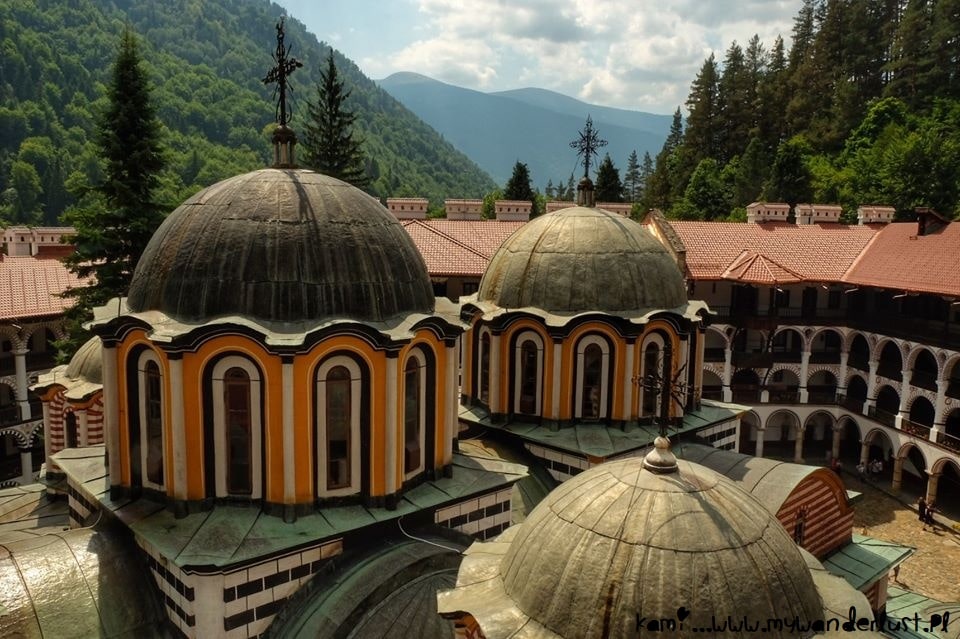
Bansko and Mount Pirin
It is the most famous mountain resort in Bulgaria. But it is not just a resort.
Bansko is an old town, located on the north foot of Mt. Pirin- a mighty mountain range, rising up to 2914 m, with its Vihren Peak, which is the third highest peak in the Balkans.
Bansko presents a traditional architecture of the 19th century and a lot of the culture of that era. And Pirin offers great opportunities, not only for winter sports but also for hiking, trekking, wildlife researching, and adventures.
Beglika- the southernmost taiga forest in Europe
This area is located deep in Rhodope mountain range.
It is all covered by coniferous forest (mainly spruce, fir, and pines), and its landscape reminds of Siberia or Canadian forests.
The forest is mixed with meadows, mountain streams and dam lakes, which give you excellent opportunities for trekking, camping, fishing, and picnic.
Trigrad Gorge
There is a karst area in the southern part of Rhodope mountains, near the border with Greece. In this area you can see some of the most beautiful gorges in Europe.
There is also a mysterious and fearful cave, called “Devil’s Throat”, where a furious river penetrates into the Earth’s core, and swallows everything fell into its waters.
Plovdiv- the oldest living city in Europe
Plovdiv is a really unique city, with the longest history in Europe. So it is really a must to visit, as a part of your Bulgaria trip.
In Plovdiv you can research not only the remains from thousands of years ago, but also to dive into its beautiful cityscape and rich culture.
There is splendid Old town, a large Roman theater, an underground Roman stadium, a few emblematic hills and many other attractions to see.

Rose Valley
The rose is one of the symbols of Bulgaria. And the products of essential rose oil are recognized as the best in the world.
There is a beautiful valley, south of Balkan (Stara Planina) mountain range, which is the main homeland of the famous Bulgarian rose.
You can visit one of the rose park-museums, where you can see, taste and experience everything about this wonderful flower – this is definitely one of the best things to do in Bulgaria.
Ethno complex Etara
In the north side of the Balkan mountain range, you can find many other picturesque villages. All of them are among Bulgaria tourist attractions but the best one is Etara.
This tranquil ethnographic complex, with old traditional houses in Revival style, is where you can feel the life as it has been some 150 years ago.
Veliko Tarnovo and Tsarevets, the Medieval capital of Bulgaria
Veliko Tarnovo is a glorious city, one of the best Bulgaria destinations. It has been a capital of Bulgaria from the 12th to 14th centuries.
There you can see its old king’s complex, called Tsarevets. It is beautifully situated on a hill over the valley of the curving Yantra River.

Nesebar and Sozopol
The Black Sea coast of Bulgaria is well known as one of the most beautiful sea coasts in Europe. It has not only great beaches and resorts but also some beautiful towns, full of old and modern culture.
Two of these towns are Nesebar and Sozopol – a really excellent combination of Oldtown, resort and sea coast.

Two weeks in Bulgaria itinerary
So, let’s build your two weeks in Bulgaria itinerary, connecting all these places.
The best way of traveling is by car.
There are buses, but in some places not so convenient, especially in certain road sections in Rhodope mountains. So, the best option is to rent a car from Sofia.
There are many rental car companies, which offer good cars for a good price.
Once you get your car, it’s time to go! Let’s see your Bulgaria sightseeing itinerary day by day.
Day 1: Sofia
Your first day in Bulgaria is dedicated to Sofia , the Bulgarian capital.
You can go to the center, park your car and take a walk around the streets and the interesting places to visit.
There you can start from the symbol of Sofia- the Statue of St.Sofia. Then proceed to the government buildings, to the Russian Church and finally to the other famous landmark of Sofia and Bulgaria- the Alexander Nevsky Cathedral.
Then you can proceed walking south, to Slaveykov Square, which is well known as a cultural center of the city.
Finally, you can reach NDK (National Palace of Culture) Square and the areas behind it.
If you like nightlife, back to the center at evening, walk on Vitosha Street and you can see a lot of bars, clubs, and restaurants in the area.
You might also want to join the tour to get to know Sofia better. Click here for the details on the best Sofia sightseeing tour.
Where to stay in Sofia: As Sofia is a capital and a big city, there are really a lot of hotels and hostels that you can find. The best places are near the center, near the metro stations or near the rental car company.
Here are recommended places to stay in Sofia:
- Hostel: Hostel Mostel (8.6/10 on Booking)
- Budget: 5 Vintage Guest House (9.4/10 on Booking)
- Mid-range: Design Hotel 36 (9.3/10 on Booking)
- Luxury: InterContinental Sofia (9.3/10 on Booking)
- or something else
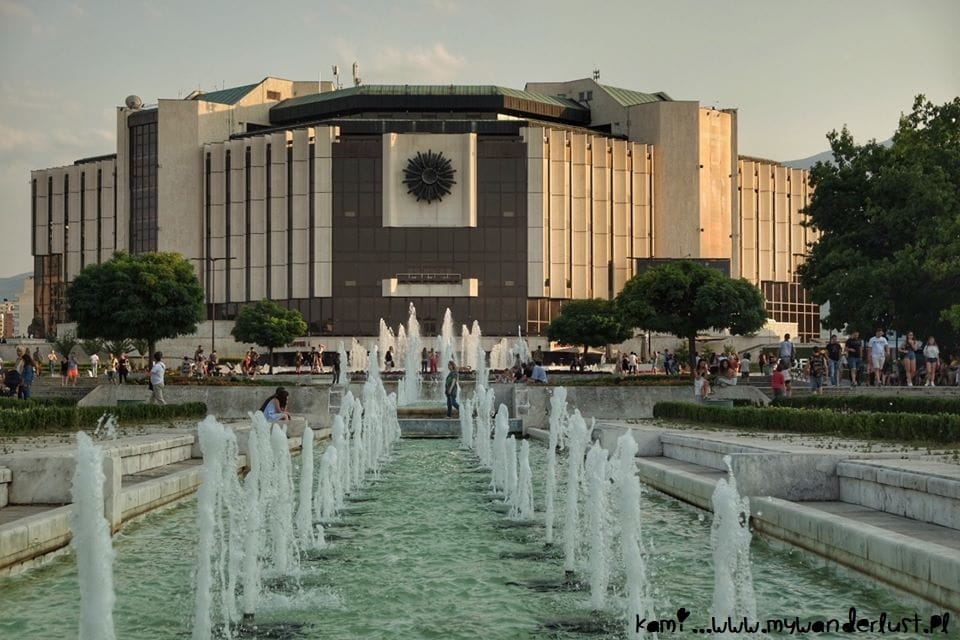
Day 2: Sofia-Rila Monastery
Road distance: 117 km. Estimated travel time: 1h 40min.
Time to leave Sofia.
Leave in the morning. After a little more than an hour, you will arrive at the entrance of the beautiful Rila Valley, from where you will start ascending until you reach the famous Rila Monastery .
Park the car there and explore the monastery- its main church, its Hrelyo Tower, its museum and its yard.
At afternoon you can go further deep in the mountain, to Kirilova Polyana, and make a short mountain hike.
Finally, you can back to the monastery and spend the night in its hotel, enjoying a really mysterious evening in this silent place.
Accommodation: The best option: in Rila Monastery itself. There is a monastery lodge inside and outside of it, giving you an opportunity to experience a unique atmosphere of this place in the night.
Other options: Rilets Hotel .
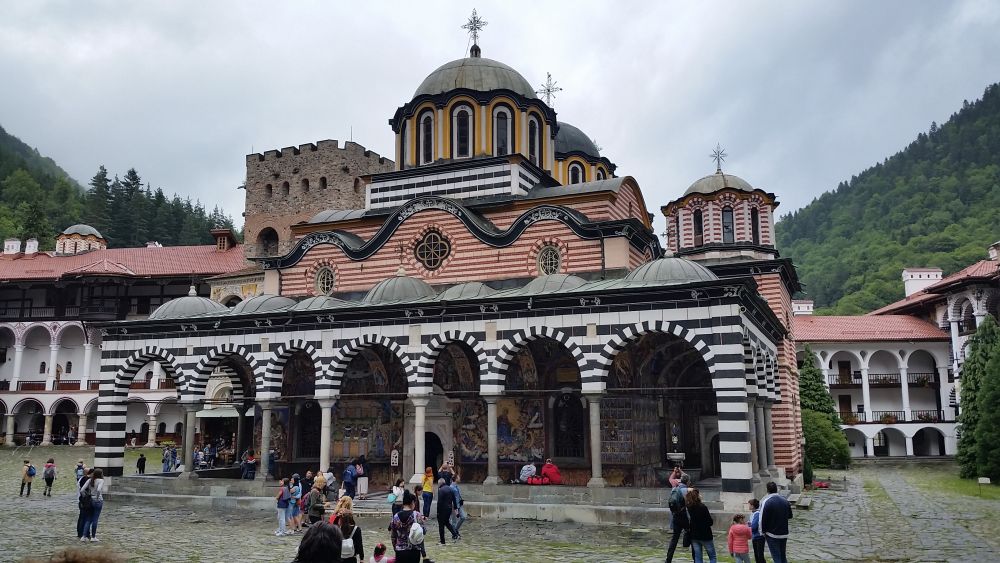
Day 3: Rila Monastery-Bansko
Road distance: 94 km. Estimated travel time: 1h 30min.
This day you move to the other high mountain in Bulgaria- Pirin.
You back down from Rila Valley, proceed southward and then turn to east. Soon you will reach Bansko .
The first thing that you can do there is to explore its Old town and enjoy its picturesque streets. You can also try the local food, it is really delicious.
You can relax in Bansko the whole day, or you can go upward to Mount Pirin and make another hike in its deep forests.
Or you can even reach the higher zone above the forests, in the stunning glacial valleys of the mountain. Then you can back to Bansko and enjoy the night there.
Accommodation: Bansko is a famous mountain resort in Bulgaria, so it offers a lot of accommodation options, varying from splurge to budget. Click here to check them all!
If you are looking for something cheaper, you can choose Korina Sky Hotel or Maraya Hotel . For a splurge: Lucky Bansko Aparthotel SPA & Relax .
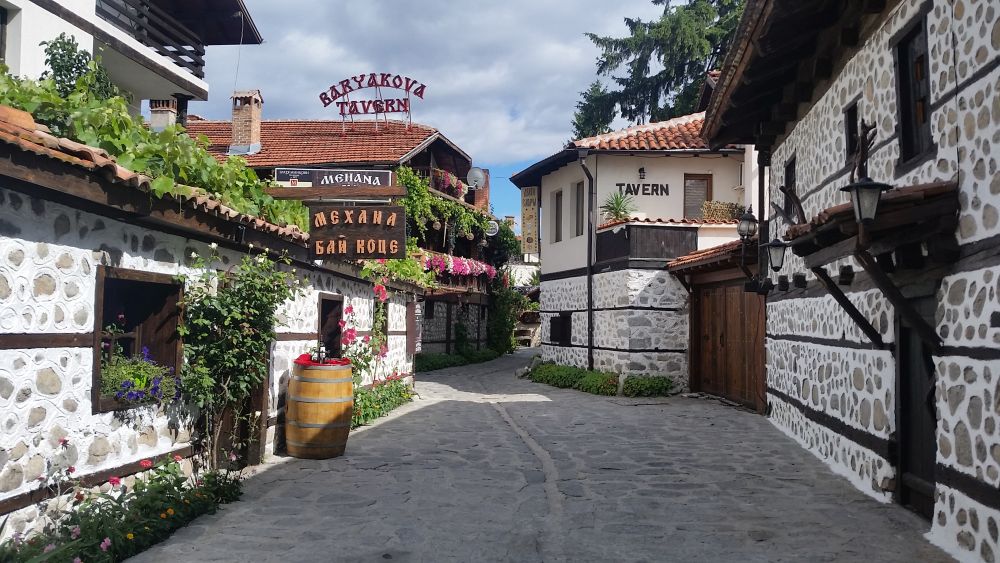
Day 4: Bansko-Beglika
Road distance: 118 km. Estimated travel time: 2h 10min.
On the 4th day of your Bulgaria itinerary, you enter the wildest areas of Bulgaria.
Driving on the road in Mesta River valley, between Rila and Rhodope mountains, you arrive first to Velingrad- a nice city-resort, famous for its mineral hot springs. Here you can buy some food, before approaching the deep forests of the Western Rhodope.
Then you proceed eastward to your next stop- Tsigov Chark resort at Batak Dam Lake- a good place for relax and making photos too.
Finally, just 3 km before Batak town you turn right, ascend to a mountain pass with a few buildings and reach a stunning forest taiga landscape- mix with dark deep taiga forest and picturesque meadows with small curving streams.
12 km further you reach the first dam lake of Beglika .
Go to the second (the larger lake, called Golyam Beglik), turn right of its wall and 2 km further you can find an excellent camping place. However, if you don’t want to sleep in a tent, there are a few small mountain hotels where you can spend the night.
Accommodation: camping or a local mountain hotel/guesthouse.

Day 5: Beglika-Trigrad
Road distance: 64 km. Estimated travel time: 1h 30min.
This day you proceed further deep in Rhodope mountains. You take the same road from Batak to Dospat, heading south.
The road passes by the next dam lake- Shiroka Polyana, then through more forests and meadows until you arrive in Dospat town. From Dospat you head eastward, passing by beautiful mountain villages and wild areas.
After Borino village the road descends into a gorge system and you enter a different landscape. Turn on the road to Trigrad, and soon you will reach the stunning views of Trigrad Gorge.
Explore its Devil’s Throat Cave and go to Trigrad village behind it. There you can enjoy the local Rhodopean atmosphere with its culture, food and wild nature around.
Until the end of the day, you can go hiking, horse riding or just relaxing in the area.
Accommodation: Trigrad is not just a village, but also recently a developing mountain resort. So there are many new hotels and guesthouses.
I would recommend Horlog Palace (in the entrance of the village), Guesthouse Rossy and Guesthouse Jani .
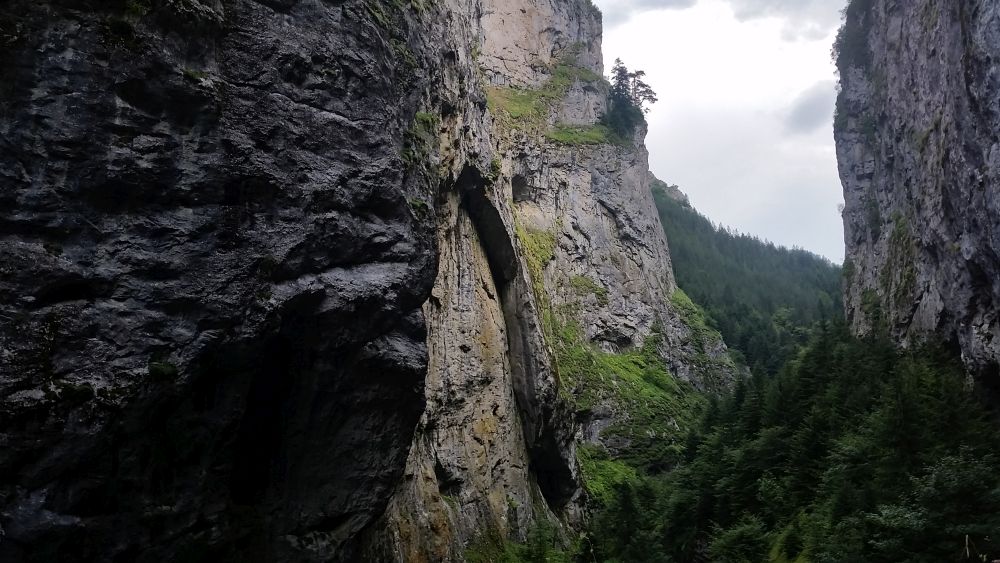
Day 6: Trigrad-Plovdiv
Road distance Trigrad to Chudnite mostove: 93 km. Estimated travel time: 2h 15min.
Road distance Chudnite mostove to Plovdiv: 71 km. Estimated travel time: 1h 40min.
This is your last day in the wild Rhodope mountains. And I recommend you leave earlier because there are many places worth to stop on your way to Plovdiv.
First you back to the main road from Dospat to Smolyan. Then proceed to Smolyan direction. Soon you will see a beautiful ethnic village with old traditional Bulgarian houses.
This is Shiroka Laka- a tranquil settlement, excellent for photos.
Proceed further and you will reach Pamporovo- one of the best winter resorts in Bulgaria. From there take the road to Plovdiv. It gradually descends on the Chepelarska River valley, from the dark taiga forest to the lower and warmer forest of the mountain.
About 30 km north of Pamporovo you will see another road on the left, leading to Chudnite Mostove (Wonderful bridges).
It is a large former cave, turned into one natural bridge and one natural tunnel in prehistoric times, again high in the taiga forest. Really worth to visit.
Then back to the main road to Plovdiv. After another 30 km section of the road you will arrive at the second largest monastery in Bulgaria- Bachkovo Monastery.
Here you can not only visit this religious place but make a short hike to the entrance of Chervenata Stena (Red Wall) natural reserve, revealing stunning views over the valley.
Finally, you go out of the mountain at Asenovgrad City and soon arrive in Plovdiv, ready for the next day, dedicated to this unique city.
Accommodation: There are plenty of options in such a touristy place like Plovdiv. Some of the best budget places, with best locations in the center, are Vel House , Studio M , Hikers Hostel , Flamingo Hotel , Hotel Evmolpia and many others .
Day 7: Plovdiv
Plovdiv, the oldest living city in Europe is a really amazing place. That’s why in such an itinerary it is a must to stay at least two nights there and to have one whole day to explore it.
The good thing is that most of Plovdiv’s places to visit are located close to each other in the center, so you can walk around them on foot.
Go to Central Square at Trimontium hotel and start your route from there.
First walk on Main Street (which is the longest pedestrian street in Europe!). You will pass by a lot of colorful places there- cafes, shops, a nice square with a fountain and some small attractive points for photos.
But the biggest secret of Main Street is what is located under it- a long Roman Stadium, a glimpse of which you can see from glass floors in some of the shops.
Finally, you arrive at Dzhumaya Square, where the northern end of the Roman Stadium is exposed outside.
From here turn right and make a trip around the Old Town.
Dive into the atmosphere of the old traditional Revival houses, visit the museums, went to Nebet Tepe peak for a stunning view over the city, then turn south to the Ancient Roman Theater- one of the Plovdiv’s landmarks.
Then go to the southern side of the Old Town and explore the ancient Basilicas and Trakart Museum.
And for the evening you have two options, which actually you can combine (if it’s summer).
First- go to Central Park and enjoy the Singing Fountains. Then walk again on Main Street and go to Kapana neighborhood, which is the center of art and nightlife.
You might also want to join the guided tour to get to know Plovdiv better. Click here for details.

Day 8: Plovdiv-Rose Valley-Etara-Veliko Tarnovo
Road distance Plovdiv to Rose Valley (Damascena): 91 km. Estimated travel time: 1h 30min.
Road distance Rose Valley (Damascena) to Veliko Tarnovo: 97 km. Estimated travel time: 1h 50min.
This day you will see some of the best places in Bulgaria and will cross to the northern part of the country.
Take the road to the north, to Karlovo town in the foot of Balkan (Stara Planina mountain. Then turn right to Kazanlak. Soon you will arrive in a wide valley, where you can look for Damascena Ethnographic complex.
Here you are in the Rose Valley. When you arrive there, you can enjoy everything about the roses of Bulgaria.
And if your trip is at the beginning of June, you can join the Rose Festival- one of the most attractive festivals in the country.
Then you proceed on the road to Gabrovo and Veliko Tarnovo.
You will cross the Balkan Mountain at Shipka Pass, where you can see the large Shipka Monument, dedicated to the battle between the Russians and Bulgarians against the Ottoman army, which lead to the independence of Bulgaria.
If you have time, you can make a detour to the east and visit Buzludzha, a strange communist construction, now known as the “Flying Saucer” due to its shape.
Proceed on the road. When you descend to the hilly lowland north of the mountain, you will see Etara Ethnographic complex.
Stop there and enjoy the beautiful old houses and a tranquil atmosphere. Then, your next stop is Dryanovo Monastery, one of the largest Orthodox monasteries in Bulgaria.
Finally, you will arrive at Veliko Tarnovo. It would be late afternoon or evening, so first you can enjoy the splendid view of the ancient Tsarevets hill and palace, in its night lights.
Accommodation: There are plenty of options in Veliko Tarnovo. I would recommend Guesthouse Priyateli (Friends) , Akvaya Hotel , Hotel Anhea , Hotel Real and Hostel Mostel .
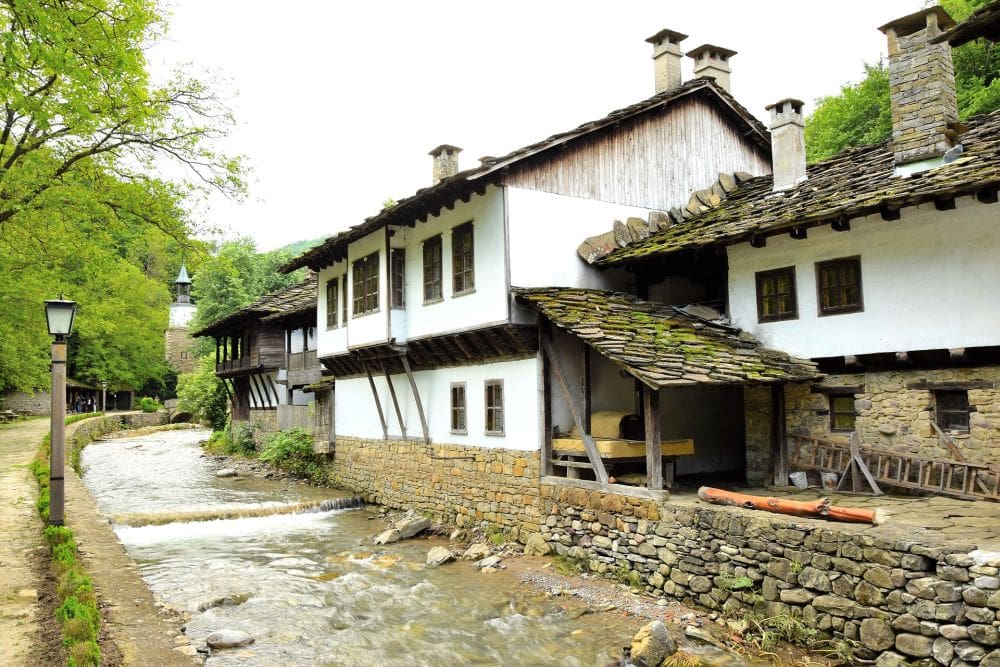
Day 9: Veliko Tarnovo-Kotel
Road distance: 99 km. Estimated travel time: 1h 40min.
In the morning the best you can do is to explore Tsarevets hill and its Medieval complex with the king’s palace. You can also visit the old quarter with some traditional houses, and buy some souvenirs.
Then at noon, you can leave Veliko Tarnovo. Your next destination is Kotel, a small town in the lower eastern branches of the Balkan (Stara Planina) mountain.
There are a few roads leading from Veliko Tarnovo to Kotel. The road passing through Elena town is the most picturesque, offering nice views to local villages and deep forests.
Finally, you will arrive in Kotel and relax in this silent and tranquil town.
Accommodation: Kotel is not a big town and there are some nice hotels for a night. I would recommend Ambrozia , Chukarite and Lefterova Guesthouse .
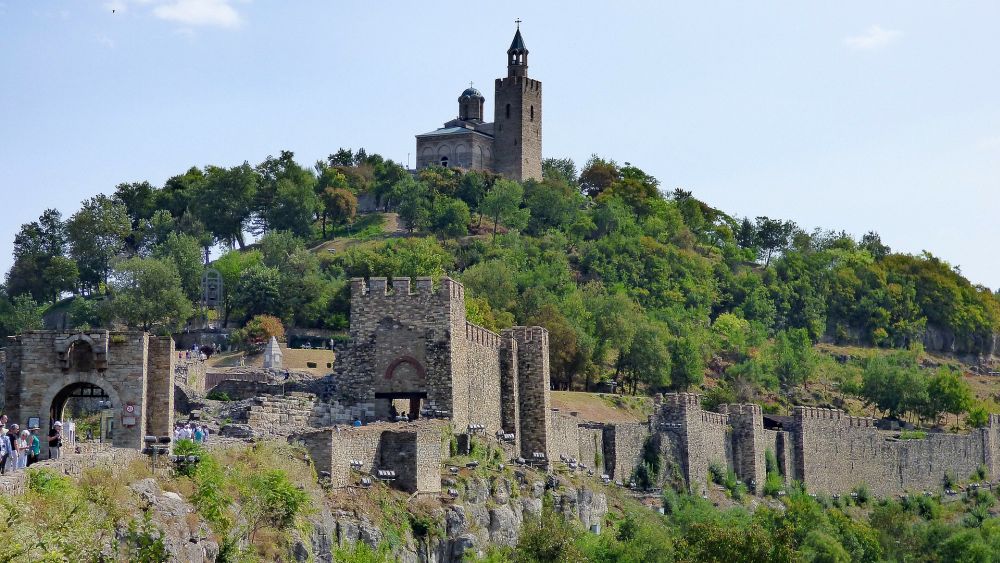
Day 10: Kotel-Nesebar
Road distance: 137 km. Estimated travel time: 2h.
The last few days of your Bulgaria tour are designed for the Black Sea Coast- one of the best seacoasts of Europe. And your first destination there is Nesebar- an old town, built on a peninsula.
It is actually a whole Black Sea resorts area, including the Old Nesebar, the New Nesebar, and Sunny Beach (Slanchev bryag) resort, with some of the best beaches in Bulgaria.
You can leave Kotel in the morning and drive in the southeast direction. On your way, you can stop for a while in the beautiful villages of Zheravna and Medven.
Then you have a few options to Nesebar. If you prefer nice mountain and village views, you can take the road via Ruen, arriving directly to Nesebar, however, this option is longer.
The shortest option is to reach the highway Sofia-Burgas, then drive on the sea coast via Pomorie and Aheloi to reach Nesebar.
Once you arrive in the town, you can use the afternoon hours for beach time (if it is summer) or just to explore the old streets (if it is another season).
And the evening can be a party night or just enjoying the night atmosphere of the town.
Accommodation: Since this is a famous resort place, there are hundreds of accommodation options, from splurge to budget. There are also a lot of rental rooms, both in the old and the new parts of Nesebar. Click here to see all the best options for the accommodation in Nesebar.

Day 11: Nesebar-Sozopol
Road distance: 70 km. Estimated travel time: 1h 10min.
Nesebar and Sozopol are like “two sisters” for Bulgaria vacation- old towns-new resorts, located on the two sides of Burgas Bay.
And this day you can move between them, following the coast line via Burgas City. Driving southward, you will see a lot of beaches, resorts, restaurants, hotels and many other attractions- mainly between Nesebar and Burgas. You can enjoy beach time in Nesebar, or stop somewhere in the middle.
From Chernomorets resort the coastline becomes even more attractive than in the north, now featuring also some hills and forests around the beaches and bays.
Finally, you arrive in Sozopol. The activities that you can do there are quite similar to Nesebar, but since it can be a really great experience, repeating is worth.
Accommodation: Same as Nesebar, Sozopol also offers hundreds of accommodation options, including rental rooms. Click here to browse accommodation in Sozopol.
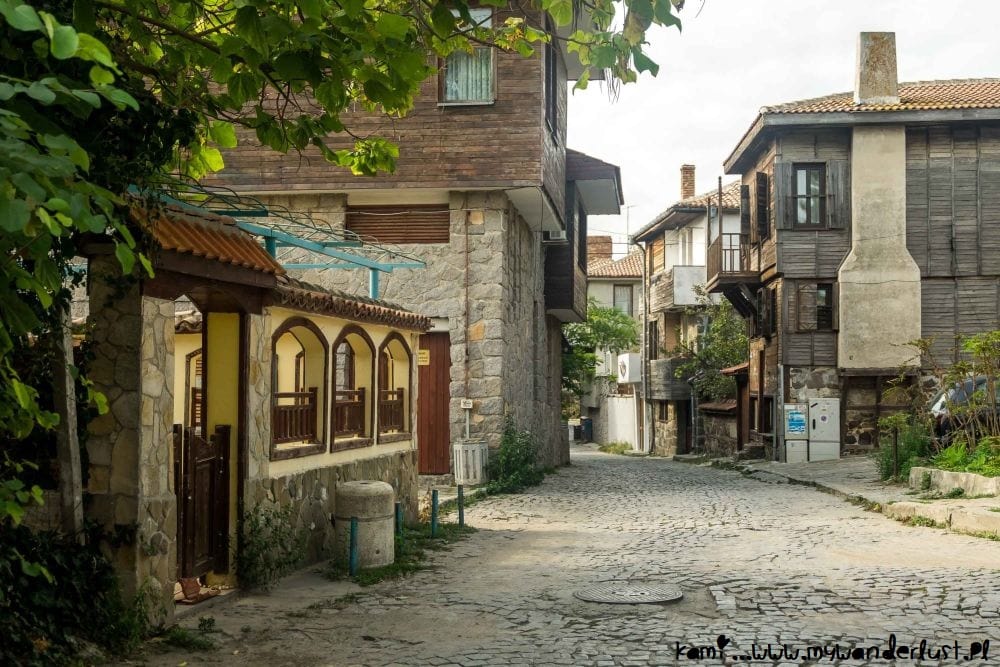
Day 12: Sozopol-Sinemorets
Road distance : 56 km. Estimated travel time: 50min.
Today you can proceed further southeast, following the Black Sea coastline.
The whole route to your final destination for this day- Sinemorets, passes through a long chain of beaches and resorts, but there is something more- the nature.
There are beautiful natural landscapes and places all along the road.
First, the whole coastline is curved in many bays and capes. And also there are two rivers flowing into the sea with beautiful wild forest around them- Ropotamo and Veleka rivers.
You can also choose one of the beaches and resorts on the way: Dyuni, Primorsko, Kiten, Lozenets, Tsarevo and Ahtopol. Some of them are just resorts, but others are also nice towns and villages.
Of course, the best season for the Black Sea Coast is summer, but even during the other colder seasons, although you can’t swim in the sea, it is still beautiful and much tranquil there.
Finally, you arrive in Sinemorets, the southernmost resort village at the Bulgarian Black Sea coast (there is another village called Rezovo, at the border with Turkey, but it is not a resort).
Its exotic beach, combined with the forests of Strandzha mountains and Veleka River offers great seaside experience there.
Option: You can also choose one of the resorts before Sinemorets for your final destination and proceed to Sinemorets on the next day.
Accommodation: There are some nice hotels and guesthouses in Sinemorets, as well as rental rooms. Click here to see all the accommodation options in Sinemorets.
Day 13: Sinemorets
After almost two weeks of driving, it would be good to arrange some time for just relax. And Sinemorets is one of the excellent places for it.
However, if you still want to explore, there are some options nearby.
You can proceed further south to the border with Turkey and stop in Silistar in the middle- a good campsite in a natural landscape.
Or you can back to Ahtopol, then turn left and penetrate deep in Strandzha mountain- one of the wildest areas in Bulgaria.

Day 14: Sinemorets-Sofia
Road distance: 465 km. Estimated travel time: 5h
Now it is time to go back. You have around 5 hours driving back to Sofia.
First back to Burgas, then get on the highway directly to Sofia, where you can return the car.
In this itinerary, I propose Sinemorets for a whole day of relax.
But you can choose another destination for relaxing- somewhere in Rhodope mountain, or somewhere on the Black Sea Coast, or just wherever you want.
And if you don’t want to have a relaxing day, you can always choose one of the destinations on this route as a starting point to explore the area around it.
As I already mentioned, this itinerary can’t cover the whole of Bulgaria.
There are some regions of this country which are also really worth visiting: the Northwest with its Belogradchik Rocks, the Northeast with Varna, Dobrich, Silistra, Shumen and Ruse, the extreme Southwest with Belasitsa and Osogovo, the Eastern Rhodope mountains, Sredna Gora mountain range and many other areas.
But in spite of it, this itinerary still can give you a good impression of Bulgaria, as well as an unforgettable experience of this amazing country.
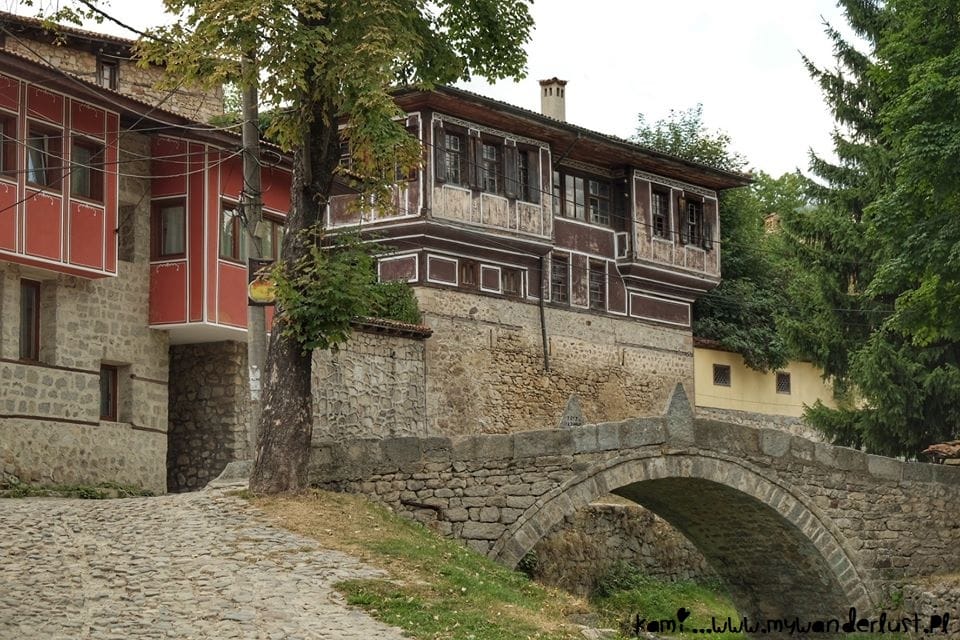
About the author: KRASEN JELYAZKOV is a traveler from Bulgaria. He has visited countries in the Balkans, Middle East, Middle Asia, East and Southeast Asia. Currently he is living in China with his wife and travel mate Ying Ying and his children, and currently working as an English teacher.
He blogs at Journey beyond the Horizon . The main idea of the blog is to share and give valuable information about the geographical and historical side of destinations, lands, and also to provide travel tips.
You can also follow Krasen on Facebook , Twitter , Instagram and Pinterest .
Further reading
I published many articles about Bulgaria that you might find useful when planning your trip there. Here are some of them:
- 23 Amazing Places to Visit in Bulgaria
- 19 Amazing Things to Do in Sofia, Bulgaria
- 11 Wonderful Day Trips from Sofia, Bulgaria
- Koprivshtitsa, Bulgaria – is this the prettiest town in the country?
- 7 Perfect Things to Do in Sozopol, Bulgaria
- 9 Great Things to Do in Burgas, Bulgaria
- Why you should visit Shumen, Bulgaria
If you are looking for articles about a specific destination – check out the map with all the articles I’ve published (and their locations). You can also join my Facebook group about traveling in the Balkans and ask your questions there.
Travel Resources
You can find the best accommodation options at Booking . They have many discounts and excellent customer service. Click here to look for the place to stay in Bulgaria
Never travel without travel insurance , you never know what might happen and better safe than sorry. You can check the insurance policy for Bulgaria here.
I recommend joining organized tours to get to know the place better and to visit more places during your trip. You can find a great selection of tours at Get Your Guide – click here .
For the end I left a few announcements that might interest you:
- Sign up to my newsletter or follow me on Bloglovin to get updates about the new posts
- Join my Facebook group about Eastern Europe, the Balkans and former USSR and connect with fellow travellers and enthusiasts of these regions – just click here!
- I’ve included a few handy links of services and products I personally like and use so you can plan your own trip to Bulgaria too. They are often affiliate links. This means I will get a small commission if you book/purchase anything through my links, at no extra costs for you. Thank you!
LIKED IT? PIN THIS POST FOR LATER!

If you enjoyed that post why don't you share it with your friends? That would mean so much to me! Also be sure to join 30.000+ fellow travelers and follow me on Facebook , Twitter , or Instagram for travel updates and even more pictures! If you don't want to miss new posts sign up to my newsletter or follow on Bloglovin !

Beautiful my dream life
Leave a Reply Cancel Reply
Sign me up for the newsletter!
Let’s become friends!
Join me on Facebook for even more travel updates!
Kami and the rest of the world

IMAGES
COMMENTS
Find the Best Prices on 2024 Bulgaria with TripAdvisor's Reviews.
The Balkan country of Bulgaria has long been overlooked on standard European travel routes, where traditional tourists rarely travel farther east than Hungary or Croatia. However, for those more intrepid visitors keen to see the delights that southeastern Europe has to offer, planning a 5 to 10 days in Bulgaria itinerary is a fantastic idea.
This 460-mile ride along the Danube through Bulgaria is one of Europe's least known long-distance routes. Here's how to tackle it. History. Explore the Balkans on these four epic drives. Skiing. This national park in Eastern Europe combines adventure and sustainability perfectly. Neighborhoods.
Trip Planner - Bulgaria. Create your perfect trip to Sofia, Bulgaria. Easily plan your trip based on your preferences, budget, and style. Plan your trip with RoutePerfect's AI and optimize it by using RoutePerfect's crowdsourced database, based on proven and enjoyable, well-crafted itineraries of thousands of travelers. Plan your trip.
A bus from Sofia to Varna costs around 33 BGN and takes seven hours, while Varna to Plovdiv is 27 BGN and also takes seven hours. A three-hour journey from Sofia to Veliko Tarnovo shouldn't cost more than 30 BGN. Train - Train travel in Bulgaria is often cheaper than taking the bus, but it's a lot slower.
A self-drive Bulgaria itinerary is a great way to see the country. Travelling at your own pace, with highway signs in both English and Bulgarian, driving around this country is easy. To top it off, car rental in Bulgaria is one of the cheapest on the continent; a compact car costs around US$130 for two weeks.
Bulgaria Itinerary Day By Day. Here is a breakdown of my itinerary on a day by day basis. I've created a few examples depending on how much time you have so hopefully this will help you plan your trip to Bulgaria! One week in Bulgaria. Day 1: Land in Sofia, Sofia for the day. Day 2: Full day Sofia.
Plan on the go with our free. With Wanderlog's mobile travel planner on Android and iOS, access and edit your trips wherever you go — even while offline. Keep your places to visit, flight/hotel reservations, and day-by-day itineraries for your trip to Bulgaria in our web and mobile app vacation planner.
Bulgaria is a country in southeastern Europe. While it may not be as well-known as a tourist destination, there is plenty to do and see. With its beaches, mountain huts, hearty food, historical monasteries, beautiful cathedrals, and Roman ruins, Bulgaria has a lot to offer. This Bulgaria travel guide will help you plan your next vacation.
Planning a trip to Bulgaria? Great idea! This Bulgaria Travel Guide will help you do just that. Bulgaria is a diverse country. Located in the southeast of Europe, between Romania, Serbia, Macedonia, Greece, Turkey, and the Black Sea, it holds beautiful historical cities, the rather grey capital of Sofia, the party coastal town which is also UNESCO World Heritage Nessebar and the Balkan ...
2 Nights in Melnik + a Sidetrip to the Rila Monastery. Depart Belogradchik this morning and head south to the Rila Monastery, which is on your way to Melnik. The Rila Monastery is the largest and most famous Eastern Orthodox monastery in Bulgaria. Melnik is a premier wine destination in Eastern Europe. The town is also at the base of the famous ...
Bulgaria road trip map. Bulgaria road trip itinerary for 10 days of travel. Day 1: Depart Sofia to Start your Bulgaria road trip itinerary in the mountains of Rila & Pirin. Day 2: Continue to historic Melnik. Day 3: Follow the Rhodope Mountains to Trigrad Gorge & Smolyan. Days 4 & 5: Relax in Plovdiv, Bulgaria's most charming city.
Step 2: Book your tickets. Budget airlines aren't comfortable, but they are a great way to get to Sofia on a budget! Unless you are coming by bus from a neighboring country, you will likely want to fly to Bulgaria. While Bulgaria Air serves several destinations in Europe, they are usually not the cheapest option.
5 Days In Bulgaria - Start In Sofia. Your Bulgaria itinerary will most likely start in Sofia if you arrive by plane. Hiring a car or taxi from the airport is only a 20-minute drive to Sofia city center. Alternatively, a train service takes just under half an hour. For others, traveling by bus is an option, as many bus service providers have ...
Rough Guides® is a trademark owned by Apa Group with its headquarters at 7 Bell Yard London WC2A 2JR, United Kingdom. Plan your visit to Bulgaria: find out where to go and what to do in Bulgaria with Rough Guides. Read about itineraries, activities, places to stay and travel essentials and get inspiration from the blog in the best guide to ...
Oferte vacanta Bulgaria 2024 Preturi avantajoase Anulare gratuita* Recenzii hoteluri Alege oferta cea mai potrivita pentru tine! ... Am folosit agentia de transport recomandata de Travel Planner, Tabita Tours, 30 eur/pers dus-intors. La dus ne-am pornit de la ora 06.00 dimineata, de la Gara de Nord si am ajuns pe la ora 13.00 in Sunny Beach ...
Plan your next travel and visit Bulgaria. Discover Bulgaria's rich history, stunning landscapes, and vibrant culture. Start your journey today!
Money Saving Tip - At the beginning of your day, buy a transport day pass for 4 lv - you can buy them at metro stations! Tickets on the bus and metro cost 1.6 lv a journey and you'll need to take at least 4 to get to Vitosha Mountain. Boyana Church. Hiking Vitosha Mountain - 5 day Bulgaria Itinerary.
GAFFL is a matchmaker site for travelers to find a travel buddy, travel partner or a travel companion. Connect with travelers & locals, plan your trip, meet up and travel together. Bulgaria Trip Planner: Plan Your Bulgaria Itinerary & Keep it All In One Place
Here is a quick summary of my 5-day Bulgaria itinerary: Day 1-2: Sofia. Day 3: Day trip to Rila Monastery or Seven Rila Lakes. Day 4-5: Plovdiv. For 10 days in Bulgaria, follow Day 1 to 5 itinerary and add these destinations: Day 6: Burgas. Day 7: Sozopol. Day 8: Nessebar.
Bulgaria Road Trip Itinerary. August 22, 2021 by chrysoula. Everyone who goes to Bulgaria falls in love with its breathtaking mountains, its lush forests, its beautiful sandy beaches, and its rich and vibrant history. There is great food and wine, hospitality, and folklore to make for an unforgettable experience without being overwhelmed with ...
Transportation: For this itinerary, you can expect to pay around 10 EUR for train travel between Sofia and Plovdiv and that is it. Activities: Depending on how much you want to do in Bulgaria, you can expect to pay approximately 65 EUR for a day trip to Rila Monastery from Sofia as well as entrance fees to tourist attractions around the country.
Step 1: We discuss all your wishes and plans in a short online call. Step 2: You get to relax while we work on the perfect bespoke travel itinerary just for you. We'll aim to have this sent to you within one week of full payment. Step 3: You'll read the info we've sent you when you get the time to. If you need any major changes, just ...
Road distance Trigrad to Chudnite mostove: 93 km. Estimated travel time: 2h 15min. Road distance Chudnite mostove to Plovdiv: 71 km. Estimated travel time: 1h 40min. This is your last day in the wild Rhodope mountains. And I recommend you leave earlier because there are many places worth to stop on your way to Plovdiv.